Alvarion Technologies VL-53 Wireless Bridge User Manual
Alvarion Ltd. Wireless Bridge
Contents
- 1. User Manual
- 2. User Manual 1
- 3. User Manual 2
- 4. User Manual 3
User Manual

SW Version 2.0
September 2004
P/N 213920
System Manual
BreezeACCESS VL

Error! No text of specified style in document.
BreezeACCESSS VL System Manual
ii

Legal Rights
Manual Revision 1.0
i
Legal Rights
© Copyright 2003 Alvarion Ltd (“Alvarion”). All rights reserved.
The material contained herein is proprietary, privileged, and
confidential. No disclosure thereof shall be made to third parties
without the express written permission of Alvarion.
Alvarion reserves the right to alter the equipment specifications and
descriptions in this publication without prior notice. No part of this
publication shall be deemed to be part of any contract or warranty
unless specifically incorporated by reference into such contract or
warrant.
Trade Names
Alvarion, BreezeCOM, WALKair, WALKnet, BreezeNET, BreezeMANAGE,
BreezeACCESS, BreezeLINK, BreezePHONE, MGW, eMGW and/or other
products and/or services referenced here in are either registered
trademarks, trademarks or service marks of Alvarion.
All other names are or may be the trademarks of their respective
owners.
Statement of Conditions
The information contained in this manual is subject to change without
notice. Alvarion shall not be liable for errors contained herein or for
incidental or consequential damages in connection with the furnishing,
performance, or use of this manual or equipment supplied with it.
Warranties and Disclaimers
All Alvarion products purchased from Alvarion or through any of
Alvarion’s authorized resellers are subject to the following warranty and
product liability terms and conditions.
Exclusive Warranty
Alvarion warrants that the Product hardware it supplies and the
tangible media on which any software is installed, under normal use
and conditions, will be free from significant defects in materials and
workmanship for a period of fourteen (14) months from the date of
shipment of a given Product to Purchaser (the “Warranty Period”).
Alvarion will, at its sole option and as Purchaser’s sole remedy, repair or
replace any defective Product in accordance with Alvarion’ standard
RMA procedure.

Legal Rights
BreezeACCESSS VL System Manual
ii
Disclaimer
(a) UNITS OF PRODUCT (INCLUDING ALL THE SOFTWARE)
DELIVERED TO PURCHASER HEREUNDER ARE NOT
FAULTTOLERANT AND ARE NOT DESIGNED, MANUFACTURED OR
INTENDED FOR USE OR RESALE IN APPLICATIONS WHERE THE
FAILURE, MALFUNCTION OR INACCURACY OF PRODUCTS CARRIES A
RISK OF DEATH OR BODILY INJURY OR SEVERE PHYSICAL OR
ENVIRONMENTAL DAMAGE (“HIGH RISK ACTIVITIES”). HIGH RISK
ACTIVITIES MAY INCLUDE, BUT ARE NOT LIMITED TO, USE AS PART
OF ONLINE CONTROL SYSTEMS IN HAZARDOUS ENVIRONMENTS
REQUIRING FAILSAFE PERFORMANCE, SUCH AS IN THE
OPERATION OF NUCLEAR FACILITIES, AIRCRAFT NAVIGATION OR
COMMUNICATION SYSTEMS, AIR TRAFFIC CONTROL, LIFE SUPPORT
MACHINES, WEAPONS SYSTEMS OR OTHER APPLICATIONS
REPRESENTING A SIMILAR DEGREE OF POTENTIAL HAZARD.
ALVARION SPECIFICALLY DISCLAIMS ANY EXPRESS OR IMPLIED
WARRANTY OF FITNESS FOR HIGH RISK ACTIVITIES.
(b) PURCHASER’S SOLE REMEDY FOR BREACH OF THE EXPRESS
WARRANTIES ABOVE SHALL BE REPLACEMENT OR REFUND OF THE
PURCHASE PRICE AS SPECIFIED ABOVE, AT ALVARION’S OPTION. TO
THE FULLEST EXTENT ALLOWED BY LAW, THE WARRANTIES AND
REMEDIES SET FORTH IN THIS AGREEMENT ARE EXCLUSIVE AND
IN LIEU OF ALL OTHER WARRANTIES OR CONDITIONS, EXPRESS OR
IMPLIED, EITHER IN FACT OR BY OPERATION OF LAW, STATUTORY
OR OTHERWISE, INCLUDING BUT NOT LIMITED TO WARRANTIES,
TERMS OR CONDITIONS OF MERCHANTABILITY, FITNESS FOR A
PARTICULAR PURPOSE, SATISFACTORY QUALITY,
CORRESPONDENCE WITH DESCRIPTION, NONINFRINGEMENT, AND
ACCURACY OF INFORMATION GENERATED. ALL OF WHICH ARE
EXPRESSLY DISCLAIMED. ALVARION’ WARRANTIES HEREIN RUN
ONLY TO PURCHASER, AND ARE NOT EXTENDED TO ANY THIRD
PARTIES. ALVARION NEITHER ASSUMES NOR AUTHORIZES ANY
OTHER PERSON TO ASSUME FOR IT ANY OTHER LIABILITY IN
CONNECTION WITH THE SALE, INSTALLATION, MAINTENANCE OR
USE OF ITS PRODUCTS.

Legal Rights
Manual Revision 1.0
iii
(c) ALVARION SHALL NOT BE LIABLE UNDER THIS WARRANTY IF ITS
TESTING AND EXAMINATION DISCLOSE THAT THE ALLEGED
DEFECT IN THE PRODUCT DOES NOT EXIST OR WAS CAUSED BY
PURCHASER’S OR ANY THIRD PERSON'S MISUSE, NEGLIGENCE,
IMPROPER INSTALLATION OR IMPROPER TESTING, UNAUTHORIZED
ATTEMPTS TO REPAIR, OR ANY OTHER CAUSE BEYOND THE RANGE
OF THE INTENDED USE, OR BY ACCIDENT, FIRE, LIGHTNING OR
OTHER HAZARD.
Limitation of Liability
(a) ALVARION SHALL NOT BE LIABLE TO THE PURCHASER OR TO
ANY THIRD PARTY, FOR ANY LOSS OF PROFITS, LOSS OF USE,
INTERRUPTION OF BUSINESS OR FOR ANY INDIRECT, SPECIAL,
INCIDENTAL, PUNITIVE OR CONSEQUENTIAL DAMAGES OF ANY
KIND, WHETHER ARISING UNDER BREACH OF CONTRACT, TORT
(INCLUDING NEGLIGENCE), STRICT LIABILITY OR OTHERWISE AND
WHETHER BASED ON THIS AGREEMENT OR OTHERWISE, EVEN IF
ADVISED OF THE POSSIBILITY OF SUCH DAMAGES.
(b) TO THE EXTENT PERMITTED BY APPLICABLE LAW, IN NO EVENT
SHALL THE LIABILITY FOR DAMAGES HEREUNDER OF ALVARION OR
ITS EMPLOYEES OR AGENTS EXCEED THE PURCHASE PRICE PAID
FOR THE PRODUCT BY PURCHASER, NOR SHALL THE AGGREGATE
LIABILITY FOR DAMAGES TO ALL PARTIES REGARDING ANY
PRODUCT EXCEED THE PURCHASE PRICE PAID FOR THAT
PRODUCT BY THAT PARTY (EXCEPT IN THE CASE OF A BREACH OF A
PARTY’S CONFIDENTIALITY OBLIGATIONS).
Electronic Emission Notices
This device complies with Part 15 of the FCC rules.
Operation is subject to the following two conditions:
1. This device may not cause harmful interference.
2. This device must accept any interference received, including
interference that may cause undesired operation.

Legal Rights
BreezeACCESSS VL System Manual
i
v
FCC Radio Frequency Interference Statement
The Subscriber Unit equipment has been tested and found to comply
with the limits for a class B digital device, pursuant to part 15 of the
FCC rules and to EN 301 489-1 rules. These limits are designed to
provide reasonable protection against harmful interference when the
equipment is operated in a residential environment notwithstanding use
in commercial, business and industrial environments. This equipment
generates, uses, and can radiate radio frequency energy and, if not
installed and used in accordance with the instruction manual, may
cause harmful interference to radio communications.
The Base Station equipment has been tested and found to comply with
the limits for a class A digital device, pursuant to part 15 of the FCC
rules and to EN 301 489-1 rules. These limits are designed to provide
reasonable protection against harmful interference when the equipment
is operated in commercial, business and industrial environments. This
equipment generates, uses, and can radiate radio frequency energy and,
if not installed and used in accordance with the instruction manual,
may cause harmful interference to radio communications. Operation of
this equipment in a residential area is likely to cause harmful
interference in which case the user will be required to correct the
interference at the user’s own expense.
FCC Radiation Hazard Warning
To comply with FCC RF exposure requirement, the antenna used for
this transmitter must be fixed-mounted on outdoor permanent
structures with a separation distance of at least 2 meter from al persons
and must not be co-located or operating in conjunction with any other
antenna or transmitter.
R&TTE Compliance Statement
This equipment complies with the appropriate essential requirements of
Article 3 of the R&TTE Directive 1999/5/EC.
Safety Considerations
For the following safety considerations, “Instrument” means the
BreezeACCESS VL units’ components and their cables.
Caution
To avoid electrical shock, do not perform any servicing unless you are
qualified to do so.

Legal Rights
Manual Revision 1.0
v
Line Voltage
Before connecting this instrument to the power line, make sure that the
voltage of the power source matches the requirements of the
instrument.
Radio
The instrument transmits radio energy during normal operation. To
avoid possible harmful exposure to this energy, do not stand or work for
extended periods of time in front of its antenna. The long-term
characteristics or the possible physiological effects of Radio Frequency
Electromagnetic fields have not been yet fully investigated.
Outdoor Unit and Antenna Installation and Grounding
Be sure that the outdoor unit, the antenna and the supporting
structure are properly installed to eliminate any physical hazard to
either people or property. Verify that the outdoor unit and the antenna
mast (when using external antenna) are grounded so as to provide
protection against voltage surges and static charges. Make sure that the
installation of the outdoor unit, antenna and cables is performed in
accordance with all relevant national and local building and safety
codes.

Important Notice
BreezeACCESSS VL System Manual
vi
Important Notice
This user manual is delivered subject to the following conditions and
restrictions:
! This manual contains proprietary information belonging to Alvarion.
Such information is supplied solely for the purpose of assisting
properly authorized users of the respective Alvarion products.
! No part of its contents may be used for any other purpose, disclosed
to any person or firm or reproduced by any means, electronic and
mechanical, without the express prior written permission of
Alvarion.
! The text and graphics are for the purpose of illustration and
reference only. The specifications on which they are based are
subject to change without notice.
! The software described in this document is furnished under a
license. The software may be used or copied only in accordance with
the terms of that license.
! Information in this document is subject to change without notice.
Corporate and individual names and data used in examples herein
are fictitious unless otherwise noted.
! Alvarion reserves the right to alter the equipment specifications and
descriptions in this publication without prior notice. No part of this
publication shall be deemed to be part of any contract or warranty
unless specifically incorporated by reference into such contract or
warranty.
! The information contained herein is merely descriptive in nature,
and does not constitute an offer for the sale of the product described
herein.
! Any changes or modifications of equipment, including opening of the
equipment not expressly approved by Alvarion will void equipment
warranty and any repair thereafter shall be charged for. It could also
void the user’s authority to operate the equipment.
Some of the equipment provided by Alvarion and specified in this
manual, is manufactured and warranted by third parties. All such
equipment must be installed and handled in full compliance with the
instructions provided by such manufacturers as attached to this
manual or provided thereafter by Alvarion or the manufacturers. Non-
compliance with such instructions may result in serious damage
and/or bodily harm and/or void the user’s authority to operate the
equipment and/or revoke the warranty provided by such manufacturer.

Important Notice
Manual Revision 1.0
vii

About this Guide
This manual describes the BreezeACCESS VL Broadband Wireless
Access System Release 2.0 and how to install, operate and manage the
system components.
This guide is intended for technicians responsible for installing, setting
up and operating the BreezeACCESS VL system, and for system
administrators responsible for managing the system.
This guide contains the following chapters and appendices:
! Chapter 1 – System description: Describes the BreezeAccess VL
system and its components.
! Chapter 2 – Installation: Describes how to install the system
components.
! Chapter 3 – Commissioning: Describes how to configure basic
parameters, align the Subscriber Unit antenna and validate unit
operation.
! Chapter 4 – Operation and Administration: Describes how to use
the BreezeACCESS VL Monitor application for configuring
parameters, checking system status and monitoring performance.
! Appendix A – Software Version Loading Using TFTP: Describes
how to load a new software version using TFTP.
! Appendix B – File Download and Upload Using TFTP: Describes
how to download and upload configuration files using TFTP. This
procedure is also applicable for uploading country code and feature
license files.
! Appendix C – Using the Restore Link Parameters Utility:
Describes how to use the special Restore Link Parameters utility to
enable management access to units where wrong or unknown
configuration disables regular access to the unit for management
purposes.

About this Guide
BreezeACCESSS VL System Manual
ii
! Appendix D – Preparing the indoor to outdoor cable: Provides
details on preparation of the indoor to outdoor Ethernet cable.
! Appendix E – Supported MIBs and Traps: Provides a brief
description of the parameters contained in the private MIB agent
incorporated into the BreezeACCESS VL devices. In addition, a
description of all traps relevant to the BreezeACCESS VL devices is
provided.
! Appendix F – Parameters Summary: Provides an at a glance
summary of the configuration parameters, value ranges and default
values.
! Appendix G – Using the Feature License Web application:
Describes how to use the Feature License web application for getting
License Keys.

Contents
Chapter 1 - System Description...............................................................1-1
Introducing BreezeACCESS VL ................................................................ 1-2
Subscriber Unit....................................................................................... 1-4
Base Station Equipment.......................................................................... 1-6
Modular Base Station Equipment................................................................. 1-6
Standalone “Micro-cell” Access Unit ............................................................. 1-8
Networking Equipment ........................................................................... 1-9
Management Systems ........................................................................... 1-10
BreezeCONFIG........................................................................................ 1-10
AlvariSTAR.............................................................................................. 1-10
Specifications ....................................................................................... 1-12
Radio specifications.................................................................................... 1-12
Data Communication ................................................................................. 1-14
Configuration and Management ................................................................. 1-14
Standards Compliance, General ................................................................. 1-15
Physical and Electrical ............................................................................... 1-16
Subscriber Unit ....................................................................................... 1-16
Modular Base Station Equipment ............................................................ 1-17
Standalone Access Unit ........................................................................... 1-19
Environmental......................................................................................... 1-21
Chapter 2 - Installation .............................................................................2-1
Installation Requirements....................................................................... 2-2
Packing List ................................................................................................. 2-2
Subscriber Unit ......................................................................................... 2-2
Modular Base Station Equipment .............................................................. 2-2
BS-SH-VL Base Station Chassis ................................................................ 2-2
AU-D/E-BS Access Unit ............................................................................ 2-3
BS-PS-AC-VL Power Supply....................................................................... 2-3

Contents
BreezeACCESSS VL System Manual
ii
BS-PS-DC-VL Power Supply.......................................................................2-3
AU-D/E-SA Standalone Access Unit...........................................................2-3
Additional Installation Requirements .........................................................2-4
Indoor-to-Outdoor Cables .............................................................................2-5
Equipment Location Guidelines............................................................... 2-6
Installing the Outdoor Unit ..................................................................... 2-7
Pole Mounting the Outdoor Unit ...................................................................2-7
Connecting the Ground and Antenna Cables ................................................2-9
Connecting the Indoor-to-Outdoor Cable ............................................... 2-11
Units with an installed waterproof seal .......................................................2-11
Units with a waterproof seal supplied with the Ethernet cable ....................2-12
Installing the Universal IDU Indoor Unit................................................ 2-13
Installing the Modular Base Station Equipment..................................... 2-15
BS-SH-VL Slot Assignments .......................................................................2-15
BS-PS- AC-VL Power Supply Module...........................................................2-16
BS-PS-DC-VL Power Supply Module ...........................................................2-17
BS-AU Network Interface Module ................................................................2-19
Installing the BS-SH-VL Chassis and Modules............................................2-20
Chapter 3 - Commissioning .................................................................... 3-1
Configuring Basic Parameters.................................................................. 3-2
Aligning the Subscriber Unit Antenna...................................................... 3-5
Configuring the Subscriber Unit’s Maximum Modulation Level ................ 3-7
Operation Verification............................................................................. 3-9
Outdoor Unit Verification..............................................................................3-9
Indoor Unit Verification ..............................................................................3-12
Verifying the Ethernet Connection (Modular Base station) ..........................3-13
Verifying the Indoor-to-Outdoor Connection (Modular Base Station) ...........3-14
Verifying Data Connectivity.........................................................................3-14
Chapter 4 - Operation and Administration............................................. 4-1
Working with the Monitor Program ......................................................... 4-2
Accessing the Monitor Program Using Telnet.................................................4-2
Common Operations .....................................................................................4-4
Menus and Parameters ............................................................................ 4-5

Contents
Manual Revision 1.0
iii
Main Menu................................................................................................... 4-5
Info Screens Menu ....................................................................................... 4-5
Show Unit Status ...................................................................................... 4-6
Show Basic Configuration ......................................................................... 4-8
Show Advanced Configuration ................................................................... 4-9
Show Country Dependent Parameters ....................................................... 4-9
Show All Parameters................................................................................ 4-10
Unit Control Menu ..................................................................................... 4-11
Reset Unit ............................................................................................... 4-11
Default Settings....................................................................................... 4-11
Change Unit Name .................................................................................. 4-15
Change Password .................................................................................... 4-15
Flash Memory Control ............................................................................. 4-16
SW Version Download ............................................................................. 4-16
Configuration File Upload/Download....................................................... 4-18
Log Out Timer ......................................................................................... 4-20
Ethernet Port Negotiation Mode ............................................................... 4-20
Change System Location ......................................................................... 4-20
Event Log Menu ...................................................................................... 4-21
Feature Upgrade...................................................................................... 4-23
Basic Configuration Menu .......................................................................... 4-24
Site Survey Menu ....................................................................................... 4-27
Traffic Statistics ...................................................................................... 4-27
Ping Test ................................................................................................. 4-30
Continuous Link Quality Display (SU only).............................................. 4-31
MAC Address Database ........................................................................... 4-31
Per Modulation Level Counters ................................................................ 4-36
Advanced Configuration Menu ................................................................... 4-37
IP Parameters .......................................................................................... 4-38
Air Interface Parameters .......................................................................... 4-40
Network Management Parameters ........................................................... 4-59
Bridge Parameters ................................................................................... 4-62
Performance Parameters.......................................................................... 4-76
Service Parameters .................................................................................. 4-84
Security Parameters ................................................................................ 4-90
Appendix A - Software Version Loading Using TFTP........................... A-1
Appendix B - File Download and Upload Using TFTP .......................... B-1
Appendix C - Using the Set Factory Defaults Utility............................. C-1
Appendix D - Preparing the Indoor to Outdoor SU Cable .................... D-1

Contents
BreezeACCESSS VL System Manual
i
v
Appendix E - Supported MIBs and Traps............................................... E-1
BreezeACCESS VL System Object Identifiers ........................................... E-2
breezAccessVLMib................................................................................... E-3
System Information Parameters ................................................................... E-3
Unit Control Parameters .............................................................................. E-6
Network Management Parameters................................................................ E-9
IP Parameters ............................................................................................ E-11
Bridge Parameters ..................................................................................... E-12
Air Interface Parameters ............................................................................ E-16
Service Parameters .................................................................................... E-24
User Filtering Parameters .......................................................................... E-26
Security Parameters................................................................................... E-27
Performance Parameters ............................................................................ E-28
Site Survey Parameters.............................................................................. E-30
Supported Traps ................................................................................... E-38
Trap Variables ........................................................................................... E-38
Private BreezeACCESS VL Traps ................................................................ E-39
Appendix F - Parameters Summary ....................................................... F-1
Parameters Summary.............................................................................. F-2
Unit Control Parameters ...............................................................................F-2
IP Parameters ...............................................................................................F-3
Air Interface Parameters ...............................................................................F-4
Network Management Parameters.................................................................F-6
Bridge Parameters ........................................................................................F-8
Performance Parameters ...............................................................................F-9
Service Parameters .....................................................................................F-10
Security Parameters....................................................................................F-11
Appendix G - Using the Feature License Web Application ..................G-1
The Feature License Web Application ......................................................G-2
Loading License Strings to Devices .............................................................. G-6

Figures
Figure 2-1: Threaded Holes/Grooves.................................................................. 2-7
Figure 2-2: 3" Pole Installation Using Special Brackets ...................................... 2-8
Figure 2-3: Bottom Panel of the Outdoor Unit (without the seal assembly) ......... 2-9
Figure 2-4: The Waterproof Seal....................................................................... 2-11
Figure 2-5: IDU PS 1036 Front Panel ............................................................... 2-13
Figure 2-6: IDU PS 1073 Front Panel ............................................................... 2-13
Figure 2-7: BS-SH-VL Chassis Slot Assignments.............................................. 2-15
Figure 2-8: BS-PS-AC-VL Front Panel .............................................................. 2-16
Figure 2-9: BS-PS-DC-VL Front Panel .............................................................. 2-17
Figure 2-10: BS-AU Front Panel....................................................................... 2-19
Figure 4-1: Main Menu (Administrator Level) ..................................................... 4-3
Figure D-1: Ethernet Connector Pin Assignments ..............................................D-2

Figures
BreezeACCESSS VL System Manual
ii

Tables
Table 1-1: Frequency Bands .............................................................................. 1-3
Table 1-2: Subscriber Unit ODU Types............................................................... 1-4
Table 1-3: Subscriber Unit Types ....................................................................... 1-4
Table 1-4: AU Detached Antennas...................................................................... 1-7
Table 1-5: Radio Specifications ........................................................................ 1-12
Table 1-7: Data Communication ...................................................................... 1-14
Table 1-8: Configuration and Management....................................................... 1-14
Table 1-9: Standards Compliance, General ...................................................... 1-15
Table 1-10: Mechanical Specifications, Subscriber Unit ................................... 1-16
Table 1-11: Connectors, Subscriber Unit ......................................................... 1-16
Table 1-12: Electrical Specifications, Subscriber Unit ...................................... 1-17
Table 1-13: Mechanical Specifications, Modular Base Station Equipment ........ 1-17
Table 1-14: Connectors, Modular Base Station Equipment .............................. 1-18
Table 1-15: Electrical Specifications, Modular Base Station Equipment ........... 1-18
Table 1-16: Mechanical Specifications, Stand Alone Access Unit ...................... 1-19
Table 1-17: Connectors, Stand Alone Access Unit ............................................ 1-20
Table 1-18: Electrical Specifications, Stand Alone Access Unit ......................... 1-20
Table 1-19: Environmental Specifications ........................................................ 1-21
Table 2-1: Approved Category 5E Cables............................................................ 2-5
Table 2-2: BS-PS LED Functionality................................................................. 2-17
Table 3-1: Basic Parameters............................................................................... 3-2
Table 3-2: Recommended Maximum Modulation Level ....................................... 3-8
Table 3-3: AU-ODU LEDs................................................................................... 3-9

Tables
BreezeACCESSS VL System Manual
ii
Table 3-4: SU-ODU LEDs .................................................................................3-10
Table 3-5: SU-ODU SNR Bar LED Functionality ...............................................3-11
Table 3-6: BS-AU LEDs ....................................................................................3-12
Table 3-7: PS1036 SU IDU / AU-SA IDU LEDs .................................................3-13
Table 3-8: PS1073 SU IDU / AU-SA IDU LEDs .................................................3-13
Table 4-1: Default Passwords .............................................................................4-2
Table 4-2: Parameters not reset after Set Complete Factory/Operator Defaults.4-12
Table 4-3: Parameters that are not reset after Set Partial Factory/Operator
Defaults .....................................................................................................4-13
Table 4-4: Authentication and Association Process ...........................................4-33
Table 4-5: VLAN Management Port Functionality..............................................4-64
Table 4-6: VLAN Data Port Functionality - Access Link.....................................4-65
Table 4-7: VLAN Data Port Functionality - Trunk Link......................................4-66
Table 4-8: VLAN Data Port Functionality - Hybrid Link.....................................4-66
Table 4-9: Recommended Maximum Modulation Level* ....................................4-80
Table 4-10: MIR and CIR Ranges and Defaults .................................................4-87
Table D-1: Cable Color Codes ............................................................................ D-2
Table E-1: BreezeACCESS VL System Object Identifiers..................................... E-2
Table E-2: System Information Parameters........................................................ E-3
Table E-3: Unit Control Parameters ................................................................... E-6
Table E-4: Network Management Parameters..................................................... E-9
Table E-5: IP Parameters ................................................................................. E-11
Table E-6: Bridge Parameters .......................................................................... E-12
Table E-7: Air Interface Parameters ................................................................. E-16
Table E-8: Service Parameters ......................................................................... E-24
Table E-9: User Filtering Parameters ............................................................... E-26
Table E-10: Security Parameters ..................................................................... E-27
Table E-11: Performance Parameters ............................................................... E-28
Table E-12: Site Survey Parameters................................................................. E-30
Table E-13: Trap Variables .............................................................................. E-38

Tables
Manual Revision 1.0
iii
Table E-14: Private BreezeACCESS VL Traps ................................................... E-39
Table F-1: Unit Control Parameters.................................................................... F-2
Table F-2: IP Parameters.................................................................................... F-3
Table F-3: Air Interface Parameters .................................................................... F-4
Table F-4: Network Management Parameters ..................................................... F-6
Table F-5: Bridge Parameters ............................................................................. F-8
Table F-6: Performance Parameters.................................................................... F-9
Table F-7: Service Parameters .......................................................................... F-10
Table F-8: Security Parameters ........................................................................ F-11
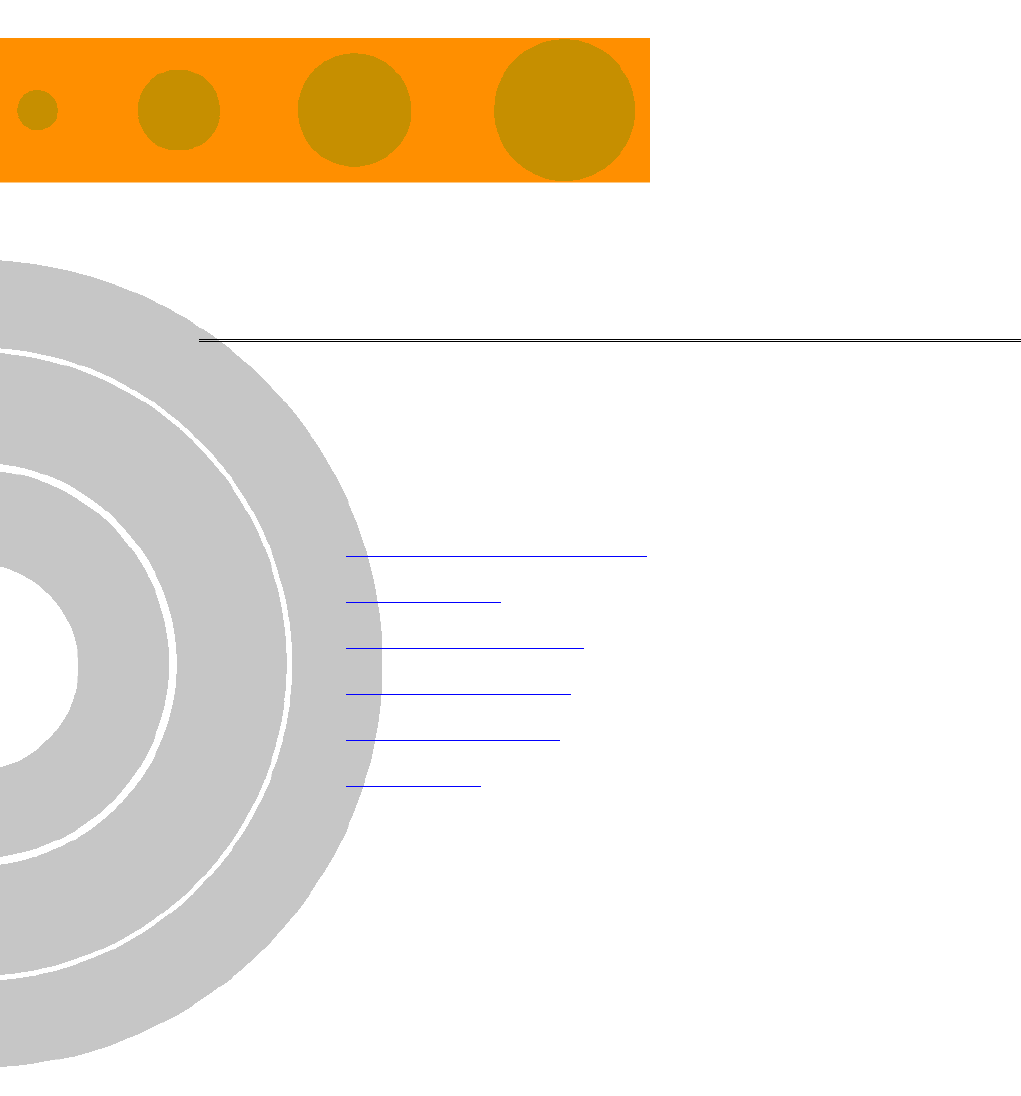
1
1
Chapter 1 - System Description
In this Chapter
! Introducing BreezeACCESS VL, on page 1-2
! Subscriber Unit, on page 1-4
! Base Station Equipment, on page 1-6
! Networking Equipment, on page 1-9
! Management Systems, on page 1-10
! Specifications, on page 1-12

Chapter 1 - System Description
BreezeACCESSS VL System Manual
1-2
Introducing BreezeACCESS VL
BreezeACCESS VL is a high capacity, IP services oriented Broadband
Wireless Access system. The system employs wireless packet switched
data technology to support high-speed IP services including fast
Internet and Virtual Private Networks. BreezeACCESS users are
provided with a network connection that is always on, supporting
immediate access to the Internet and other IP services at high data
rates. The system is designed for cellular-like deployment, enabling the
system architecture to vary in size and structure. A system can include
any number of cells, each containing several Access Units for better
coverage of densely populated areas.
The system supports Virtual LANs based on IEEE 802.1Q, enabling
secure operation and Virtual Private Network (VPN) services and
enabling tele-workers or remote offices to conveniently access their
enterprise network. The system supports layer-2 traffic prioritization
based on IEEE 802.1p and layer-3 traffic prioritization based on IP ToS
(RFC791).
BreezeACCESS VL products operate in unlicensed frequency bands in
Time Division Duplex (TDD) mode, using Orthogonal Frequency Division
Multiplexing (OFDM) modulation with Forward Error Correction (FEC)
coding. Using the enhanced multi-path resistance capabilities of OFDM
modem technology, BreezeACCESS VL enables operation in near and
non-line-of-sight (NLOS) environments. These qualities enable service
providers to reach a previously inaccessible and broader segment of the
subscriber population.
BreezeACCESS VL is designed to enable construction of “mixed” cells,
where it can be used together with other BreezeACCESS products using
GFSK modulation, including BreezeACCESS II, BreezeACCESS MMDS,
BreezeACCESS XL and BreezeACCESS V.
BreezeACCESS VL products are currently available in the following
frequency bands:
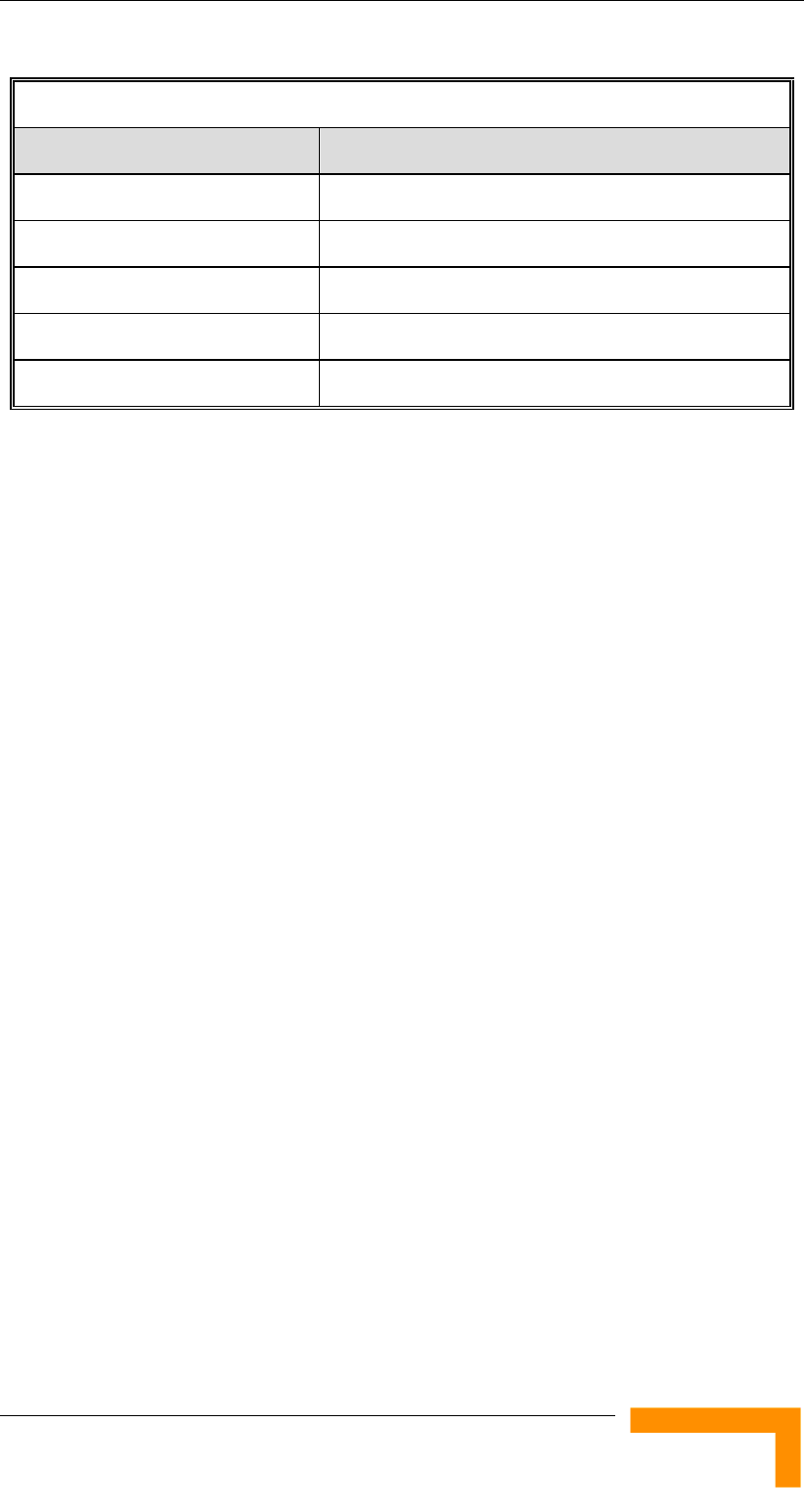
Introducing BreezeACCESS VL
Manual Revision 1.0
1-3
Table 1-1: Frequency Bands
Band Frequencies (GHz)
4.9 5.030 – 5.091
5.2 5.150 – 5.350
5.3 5.250 – 5.350
5.4 5.470 – 5.725
5.8 5.725 – 5.850
The available frequencies, as well as other parameters, depend on
applicable local regulations. The actual operating frequencies used by
the system can be configured according to applicable radio regulations
and specific deployment considerations.
A BreezeACCESS VL system is comprised of the following:
! Customer Premise Equipment (CPE): BreezeACCESS VL
Subscriber Units.
! Base Station Equipment (BS): BreezeACCESS VL Access Units and
supporting equipment.
! Networking Equipment: Standard Switches/Routers supporting
connections to the backbone and/or Internet.
! Management Systems: SNMP-based Management, Billing and
Customer Care, and other Operation Support Systems.
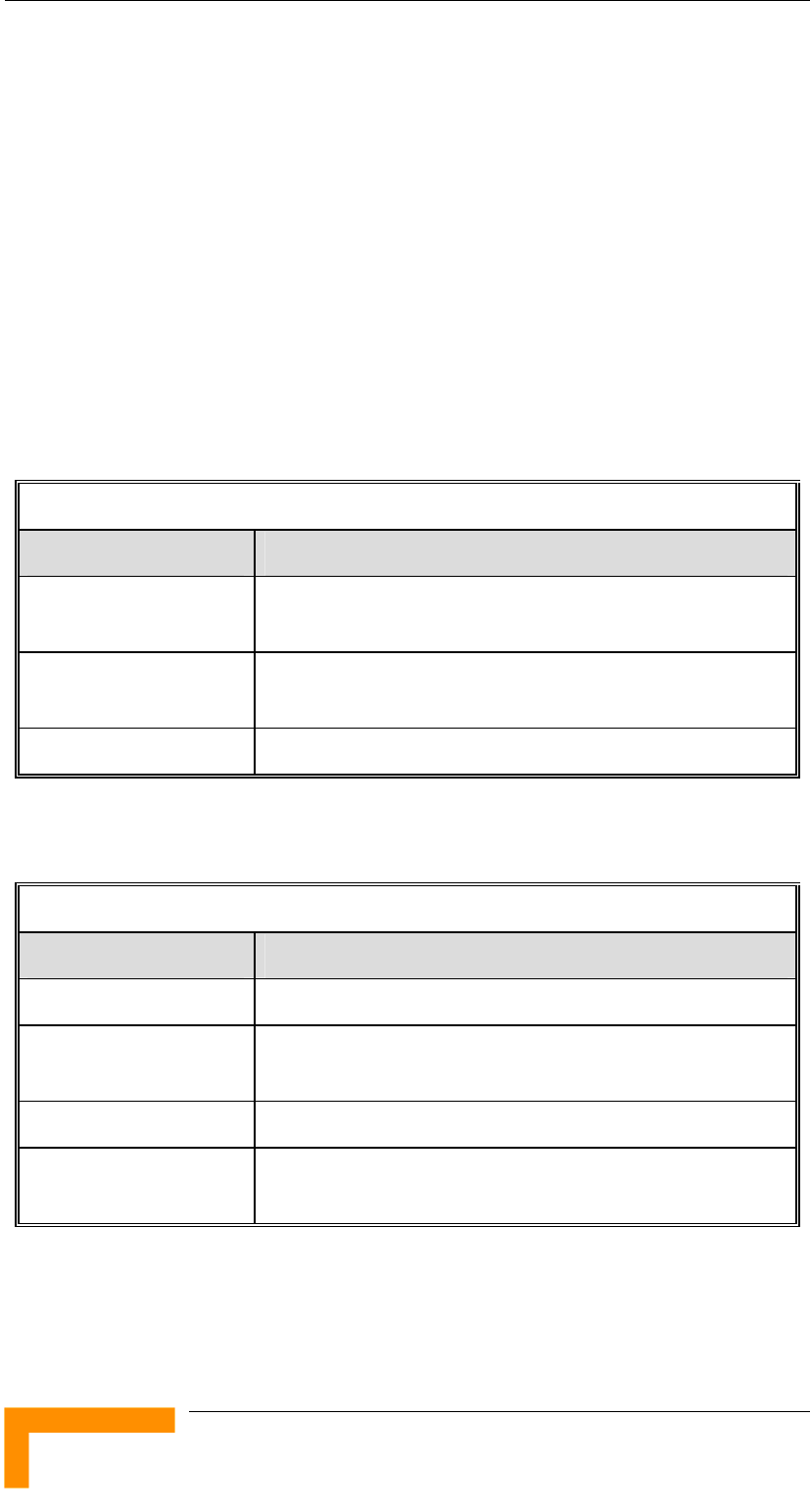
Chapter 1 - System Description
BreezeACCESSS VL System Manual
1-4
Subscriber Unit
The Subscriber Unit (SU) installed at the customer premises enables the
customer data connection to the Access Unit. The Subscriber Unit
provides an efficient platform for high speed Internet and Intranet
services. The use of packet switching technology provides the user with
a connection to the network that is always on, enabling immediate
access to services.
The Subscriber Unit is comprised of a desktop or wall-mountable
Universal Indoor Unit (IDU) and an outdoor unit that contains the
processing and radio modules. Several ODU types are available to
supports a wide range of requirements, as detailed in Table 1-2:
Table 1-2: Subscriber Unit ODU Types
SU Type Antenna Description
SU-A-ODU Vertically polarized high-gain flat antenna integrated on the
front panel
SU-A-H-ODU Horizontally polarized high-gain flat antenna Integrated on
the front panel
SU-E-ODU A connection to an external antenna
For each ODU type, several models are available to support various
end-users needs and applications, as detailed in Table 1-3:
Table 1-3: Subscriber Unit Types
SU Type Description
SU-54-BD Supports a full LAN and a CPE gross rate of up to 54 Mbps
SU-6-1D Supports a single Ethernet device (one MAC address) and
a CPE gross rate of up to 6 Mbps
SU-6-BD Supports a full LAN and a CPE gross rate of up to 6 Mbps
SU-3-1D Supports a single Ethernet device (one MAC address) and
a CPE gross rate of up to 3 Mbps

Subscriber Unit
Manual Revision 1.0
1-5
The IDU provides the interface to the user’s equipment and is powered
from the 110/220 VAC mains. The customer's data equipment is
connected via a standard IEEE 802.3 Ethernet 10/100BaseT (RJ 45)
interface. The indoor unit is connected to the outdoor unit via a
Category 5 Ethernet cable. This cable carries Ethernet traffic between
the indoor and the outdoor units, and also transfers power (54 VDC)
and control from the indoor unit to the outdoor unit.

Chapter 1 - System Description
BreezeACCESSS VL System Manual
1-6
Base Station Equipment
The Access Units, installed at the Base Station site, provide all the
functionality necessary to communicate with the Subscriber Units and
to connect to the backbone of the Service Provider.
There are 2 lines of Access Units with different architectures
! Modular Base Station Equipment
! Standalone “Micro-Cell” Access Unit
Modular Base Station Equipment
The Base Station Equipment is based on the BS-SH-VL 3U chassis,
which is suitable for installation in 19-inch racks. The chassis contains
one or two Power Supply modules and has 8 slots that can
accommodate BS-AU-VL Network Interface modules. These slots can
also accommodate various combinations of other modules, including
Network Interface (BS-AU) modules for Access Units operating in any of
the bands supported by BreezeACCESS equipment using GFSK
modulation, including BreezeACCESS II, BreezeACCESS MMDS,
BreezeACCESS XL and BreezeACCESS V. It can also accommodate a
BS-GU GPS and Alarms module to support GPS-based synchronization
of BreezeACCESS systems using Frequency Hopping radios.
Two different types of power supply modules are available for the
BreezeACCESS VL modules: The BS-PS-DC-VL that is powered from a
-48 VDC power source, and the BS-PS-AC-VL, powered from the
110/220 VAC mains. The optional use of two power supply modules
ensures fail-safe operation through power supply redundancy. When
the same chassis is used also for Access Unit modules belonging to
other BreezeACCESS families using GFSK modulation, then one BS-PS-
VL power supply (AC or DC) should be used to provide power to the
BreezeACCESS VL Access Units, and a different power supply module,
suitable for GFSK equipment, is required for powering the
BreezeACCESS GFSK Access Units.
Each BS-AU module, together with its outdoor AU-D/E-BS-ODU radio
unit and an antenna comprise an AU-D/E-BS Access Unit that serves a
single sector.
The AU-D/E-BS-ODU outdoor unit contains the processing and radio
modules and connects to an external antenna using a short RF cable.
E model units are supplied without an antenna.
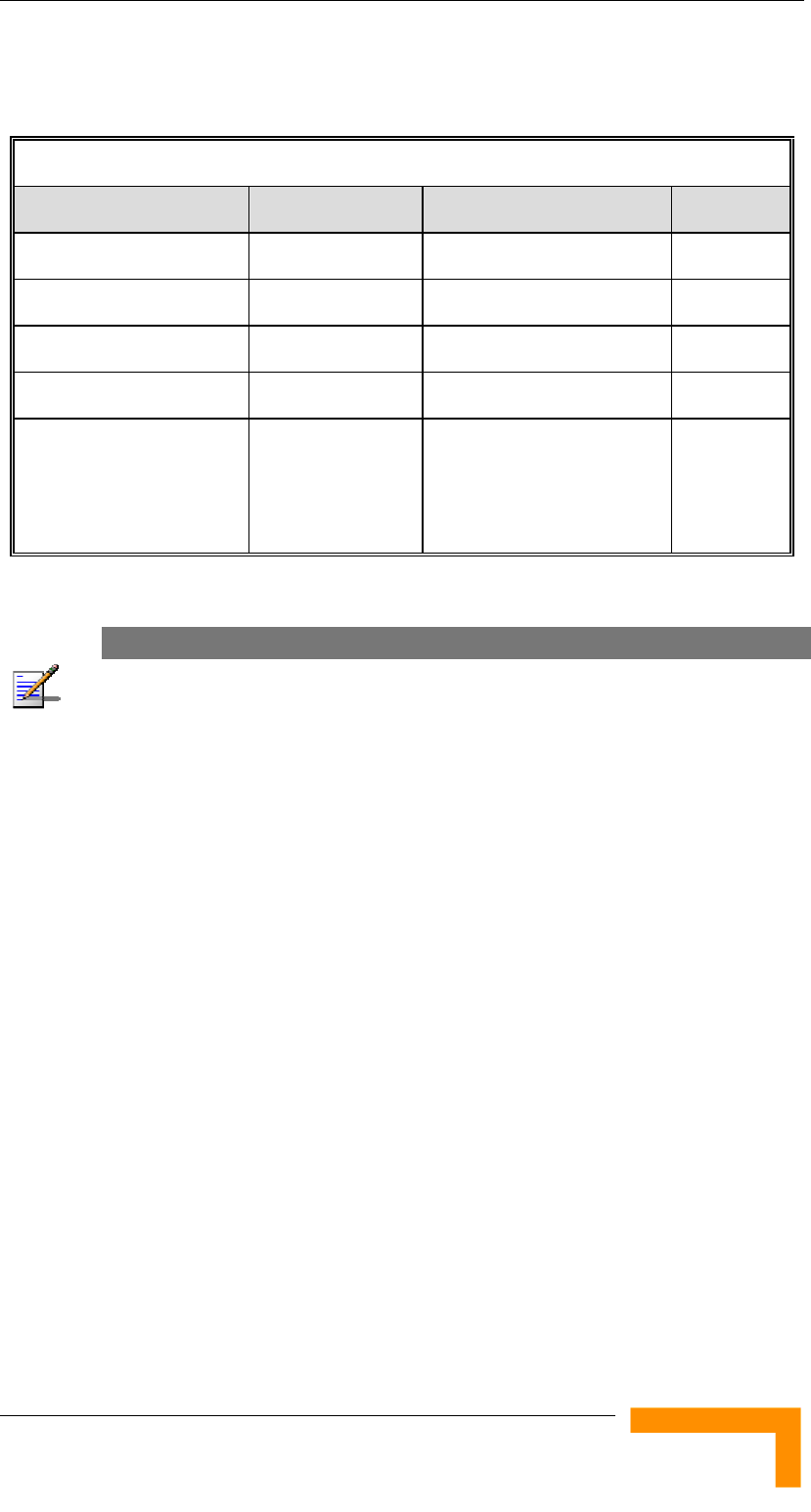
Base Station Equipment
Manual Revision 1.0
1-7
D model units are supplied with a detached antenna, where the
available antennas are listed in Table 1-4:
Table 1-4: AU Detached Antennas
Antenna Band (GHz) Horizontal Beam Width Gain*
AU-Ant-5G-16-60 5.150-5.875 60° 16 dBi
AU-Ant-5G-17-90 5.150-5.875 90° 17 dBi
AU-Ant-5G-15-120 5.150-5.875 120° 15 dBi
AU-Ant-5.8G-8-Omni 5.725-5.875 360° 8 dBi
AU-Ant 5.8G-14-120-UK
(The antenna pattern
complies with Ofcom’s
IR 2007 EIRP profiles)
5.725-5.850 120° 14 dBi
NOTE
For antennas specified for the band 5.150 – 5.875 GHz, the gain in the band
4.9 – 5.15 GHz is lower by 1 dB max. than the gain specified in the table.
The BS-AU indoor module connects to the network through a standard
IEEE 802.3 Ethernet 10/100BaseT (RJ 45) interface. The indoor module
is connected to the outdoor unit via a Category 5 Ethernet cable. This
cable carries Ethernet traffic between the indoor module and the
outdoor unit, and also transfers power (54 VDC) and control from the
indoor module to the outdoor unit.

Chapter 1 - System Description
BreezeACCESSS VL System Manual
1-8
Standalone “Micro-cell” Access Unit
The standalone AU-D/E-SA Access Unit is very similar to the
AU-D/E-BS unit. The AU-D/E-SA-ODU outdoor unit is very similar to
the AU-D/E-BS-ODU outdoor unit (identical functionality, but the units
are not interchangeable). The available antennas for D model units are
the same as those of the AU-D-BS Access Unit. The main difference is in
the structure of the indoor part; in the AU-D/E-SA Access Unit the
indoor unit is a standalone desktop or wall-mountable unit (the same
Universal IDU that is also used in the SU) rather than a 19” module.
The IDU connects to the network through a standard IEEE 802.3
Ethernet 10/100BaseT (RJ 45) interfaces and is powered from the
110/220 VAC mains. The indoor unit is connected to the outdoor unit
via a Category 5 Ethernet cable. This cable carries Ethernet traffic
between the indoor and the outdoor units, and also transfers power
(54 VDC) and control from the indoor unit to the outdoor unit.
NOTE
The AU-D/E-SA-ODU and the AU-D/E-BS-ODU are not interchangeable:
The AU-D/E-SA-ODU cannot be used with the BS-AU; the AU-D/E-BS-ODU cannot be
used with the Universal IDU.

Networking Equipment
Manual Revision 1.0
1-9
Networking Equipment
The Base Station equipment is connected to the backbone through
standard data communication and telecommunication equipment. The
10/100BaseT ports of the AU modules can be connected directly to a
multi-port router or to an Ethernet switch connected to a router.
The point-to-point link from the Base Station to the backbone can be
either wired or wireless. Data to the Internet is routed to the backbone
through standard routers.

Chapter 1 - System Description
BreezeACCESSS VL System Manual
1-10
Management Systems
The end-to-end IP-based architecture of the system enables full
management of all components, from any point in the system.
BreezeACCESS VL components can be managed using standard
management tools through SNMP agents that implement standard and
proprietary MIBs for remote setting of operational modes and
parameters. The same SNMP management tools can also be used to
manage other system components including switches, routers and
transmission equipment. Security features incorporated in
BreezeACCESS VL units restrict access for management purposes to
specific IP addresses and/or directions, which means from the Ethernet
and/or wireless link.
In addition, the Ethernet WAN can be used to connect to other
Operation Support Systems including servers, Customer Care systems
and AAA (Authentication, Authorization and Admission) tools.
BreezeCONFIG
The BreezeCONFIG for BreezeACCESS VL utility is an SNMP-based
application designed to manage BreezeACCESS VL system components
and upgrade unit software versions. The system administrator can use
the BreezeCONFIG utility to control a large number of units from a
single location. In addition, BreezeCONFIG enables you to load an
updated configuration file to multiple units simultaneously, thus
radically reducing the time spent on unit configuration maintenance.
AlvariSTAR
AlvariSTAR is a comprehensive Carrier-Class network management
system for Alvarion’s Broadband Wireless Access products-based
Networks. AlvariSTAR is designed for today’s most advanced Service
Provider network Operation Centers (NOCs), providing the network
OA&M staff and managers with all the network surveillance, monitoring
and configuration capabilities that they require in order to effectively
manage the BWA network while keeping the resources and expenses at
a minimum.
AlvariSTAR is designed to offer the network’s OA&M staff with a unified,
scalable and distributable network management system. AlvariSTAR
system uses a distributed client-server architecture, which provides the
service provider with a robust, scalable and fully redundant network
management system in which all single point of failures can be avoided.

Management Systems
Manual Revision 1.0
1-11
AlvariSTAR provides the following BWA network management
functionality:
! Device Discovery.
! Device Inventory.
! Topology.
! Fault Management.
! Configuration Management.
! Performance Monitoring.
! Device embedded software upgrade.
! Security Management.
! Northbound interface to other Network Management Systems or
OSS.
Embedded with the entire knowledge base of BWA network operations,
AlvariSTAR is a unique state-of-the-art power multiplier in the hands of
the service provider that enables the provisioning of satisfied customers.
AlvariSTAR dramatically extends the abilities of the service provider to
provide a rich portfolio of services and to support rapid customer base
expansion.

Chapter 1 - System Description
BreezeACCESSS VL System Manual
1-12
Specifications
Radio specifications
Table 1-5: Radio Specifications
Item Description
Frequency1 4.9 GHz Family: 5.030 – 5.091 GHz
5.2 GHz Family: 5.150 – 5.350 GHz
5.3 GHz Family: 5.250 – 5.350 GHz
5.4 GHz Family: 5.470 – 5.725 GHz
5.8 GHz Family: 5.725 – 5.850 GHz
Operation Mode Time Division Duplex (TDD)
Channel Bandwidth 20 MHz
Central Frequency Resolution 10 MHz
SU-A-ODU Integral Antenna 21dBi in the 5.150-5.875 GHz band, 20dBi in the 4.9-5.1
GHz band. 10.5o horizontal x 10.5o vertical,
vertical or horizontal polarization, compliant with EN 302
085 V1.1.1 Range 1, Class TS 1, 2, 3, 4, 5
AU-D Detached Antennas ! AU-Ant-5G-16-60: 16dBi, 5.150-5.875 GHz,
60o horizontal x 10o vertical sector antenna, vertical
polarization, compliant with EN 302 085 V1.1.2 CS3
! AU-Ant-5G-17-90: 17dBi, 5.150-5.875 GHz,
90o horizontal x 6o vertical sector antenna,
vertical polarization, compliant with
EN 302 085 V1.1.2 CS3
! AU-Ant-5G-15-120: 15dBi, 5.150-5.875 GHz,
120o horizontal x 6o vertical sector antenna, vertical
polarization, compliant with
EN 302 085 V1.1.2 CS3.
! AU-Ant-5.8G-8-Omni: 8dBi, 5.725-5.875 GHz,
360 o horizontal x 9o vertical, vertical polarization.
! AU-Ant-5.8G-14-120-UK: 14dBi, 5.725-5.850 GHz,
120o horizontal x 6.5o vertical sector antenna, vertical
polarization. The antenna pattern complies with
Ofcom’s IR 2007 EIRP profiles.
Antenna Port
(AU-D-BS/SA-ODU)
N-Type, 50 ohm
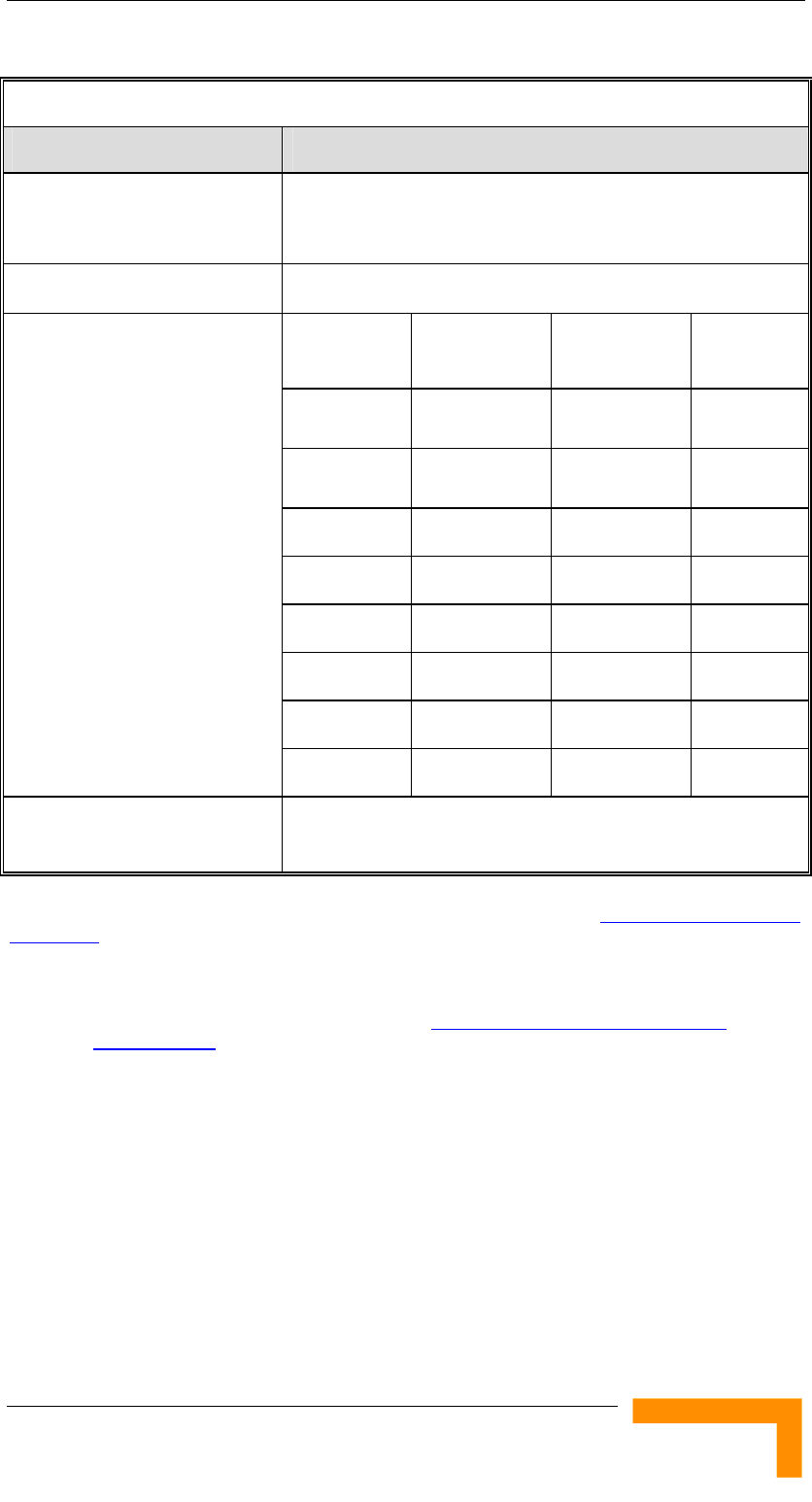
Specifications
Manual Revision 1.0
1-13
Table 1-5: Radio Specifications
Item Description
Max. Input Power
(at antenna port)
HW Rev. A: -48dBm typical
HW Rev. B: -30dBm typical
Maximum Output Power2 21 dBm
Modulation
Level3
Sensitivity
(HW Rev. A)
Sensitivity
(HW Rev. B)
Min. SNR
1 -87 dBm -89 dBm 6 dB
2 -86 dBm -88 dBm 7 dB
3 -85 dBm -86 dBm 9 dB
4 -83 dBm -84 dBm 11 dB
5 -80 dBm -81 dBm 14 dB
6 -76 dBm -77 dBm 18 dB
7 -71 dBm -73 dBm 22 dB
Sensitivity, typical (dBm at
antenna port, PER<10%)
84 -69 dBm -71 dBm 23 dB
Modulation OFDM modulation, 64 FFT points; BPSK, QPSK, QAM16,
QAM64
1 The actually available frequency channels and bandwidth are defined by the selected Sub-Band,
which reflects the applicably regulatory constraints. For more details refer to Show Country Dependent
Parameters on page 4-9.
2 The actually available maximum output power for each modulation level is defined by the selected
Sub-Band, which reflects the applicably regulatory constraints. . For some countries the power may
also be limited by limitations on the maximum EIRP (also included in the Sub-Band parameters) and
the Antenna Gain parameter. For more details refer to Show Country Dependent Parameters on page
4-9 and to Transmit Power on page 4-51. For information on specific HW and Country Code
limitations, see the Country Codes document.
3 Modulation Level indicates the radio transmission rate and the modulation scheme. Modulation Level
1 is for the lowest radio rate and modulation scheme.
4 Modulation Level 8 is supported only in unit with HW Revision B and above.

Chapter 1 - System Description
BreezeACCESSS VL System Manual
1-14
Data Communication
Table 1-6: Data Communication
Item Description
Standard compliance IEEE 802.3 CSMA/CD
VLAN Support Based on IEEE 802.1Q
Layer-2 Traffic Prioritization Based on IEEE 802.1p
Layer-3 Traffic Prioritization IP ToS according to RFC791
Configuration and Management
Table 1-7: Configuration and Management
Type Standard
Management ! Monitor program via Telnet
! SNMP
! Configuration upload/download
Management Access From Wired LAN, Wireless Link
Management access protection ! Multilevel password
! Configuration of remote access direction (from
Ethernet only, from wireless link only or from both)
! Configuration of IP addresses of authorized
stations
Security ! Authentication messages encryption option
! Data encryption option
! Selection between WEP and AES 128-bit
encryption standards
! ESSID
SNMP Agents SNMP ver 1 client
MIB II, Bridge MIB, Private BreezeACCESS VL MIB
Allocation of IP parameters Configurable or automatic (DHCP client)
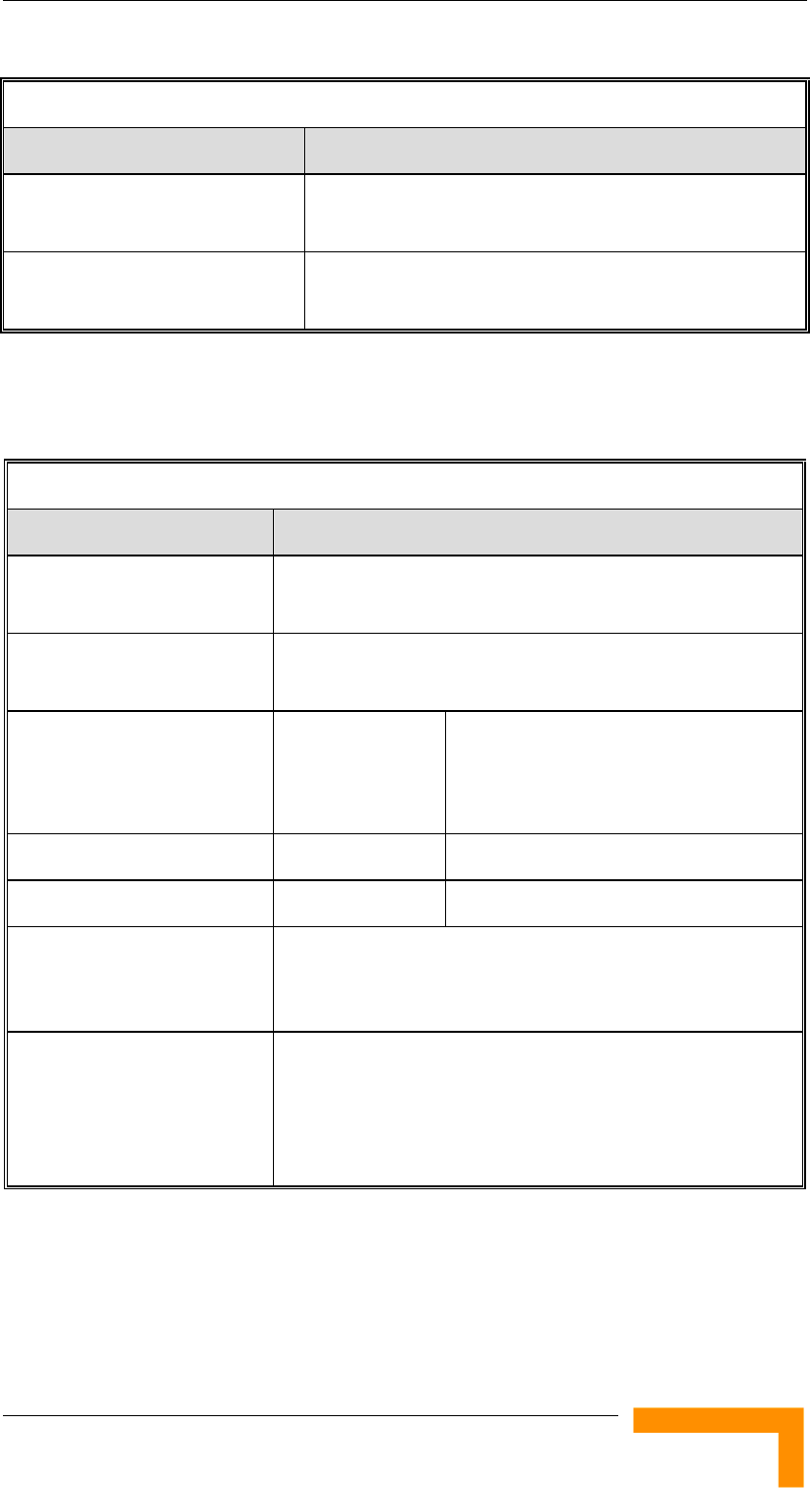
Specifications
Manual Revision 1.0
1-15
Table 1-7: Configuration and Management
Type Standard
Software upgrade ! FTP
! TFTP
Configuration upload/download ! FTP
! TFTP
Standards Compliance, General
Table 1-8: Standards Compliance, General
Type Standard
EMC ! FCC Part 15 class B
! ETSI EN 300 489-1
Safety ! UL 1950
! EN 60950
Environmental Operation
! ETS 300 019 part 2-3 class 3.2E
for indoor units
! ETS 300 019 part 2-4 class 4.1E
for outdoor units
Storage ETS 300 019-2-1 class 1.2E
Transportation ETS 300 019-2-2 class 2.3
Lightning protection
(AU-ODU Antenna
connection)
EN 61000-4-5, Class 3 (2kV)
Radio ! FCC Part 15
! ETSI EN 301 753
! ETSI EN 301 021
! ETSI EN 301 893 (2003-04)
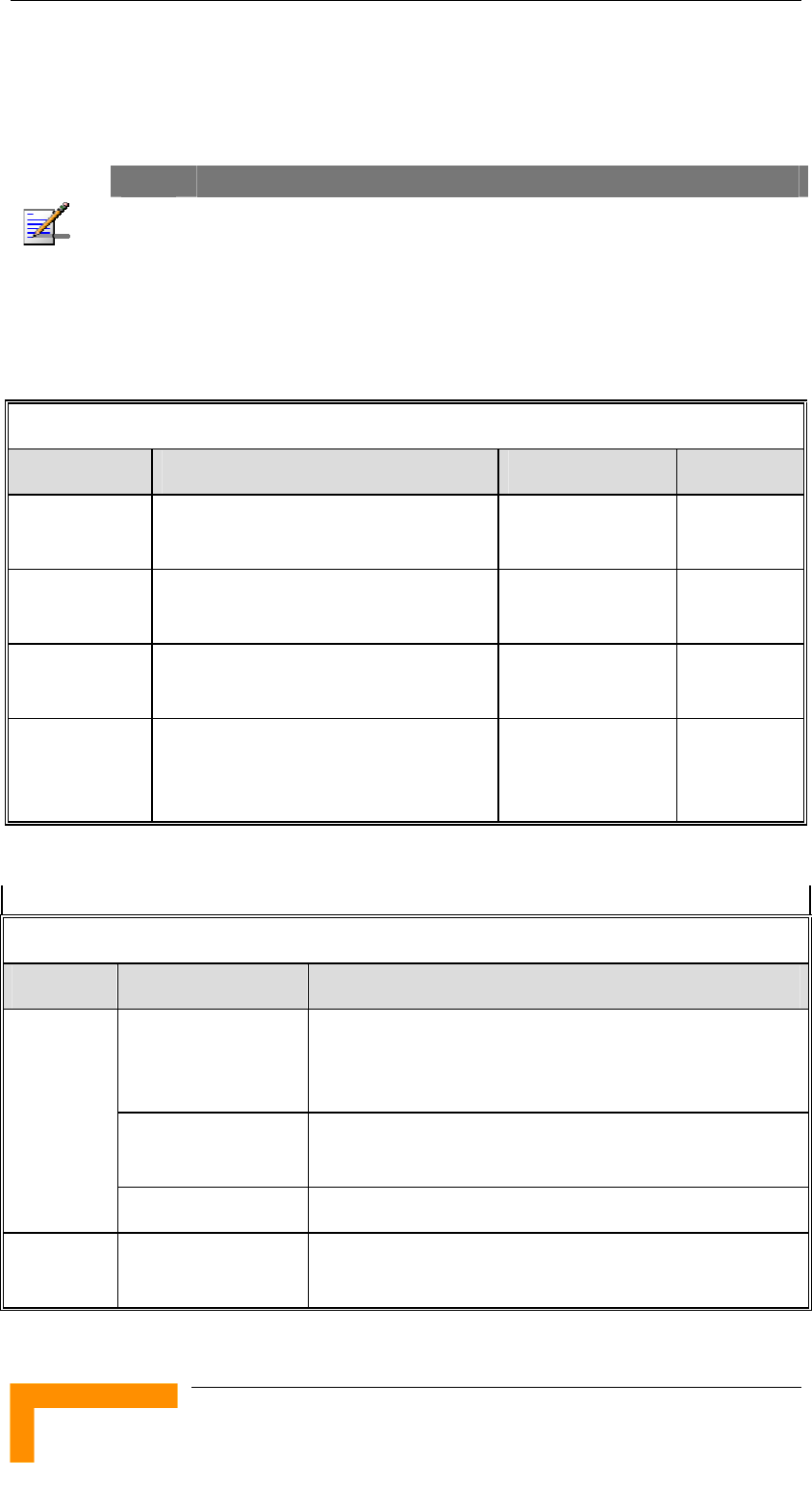
Chapter 1 - System Description
BreezeACCESSS VL System Manual
1-16
Physical and Electrical
NOTE
The equipment may be shipped with either a PS1036 or a PS1073 IDU. The differences
are primarily in the mechanical structure. The basic functionality is the same.
Subscriber Unit
Mechanical
Table 1-9: Mechanical Specifications, Subscriber Unit
Unit Structure Dimensions (cm) Weight (kg)
General An IDU indoor unit and an SU-A-ODU
outdoor unit with an integral antenna
IDU PS1036 Plastic box (white), desktop or wall
mountable
16 x 9 x 6 0.55
IDU PS1073 Plastic box (black), desktop or wall
mountable
14 x 6.6 x 3.5 0.3
SU-A-ODU Metal box plus an integral antenna in
a cut diamond shape in a plastic
enclosure, poll or wall mountable
43.2 x 30.2 x 5.9 1.85
Connectors
Table 1-10: Connectors, Subscriber Unit
Unit Connector Description
ETHERNET 10/100BaseT Ethernet (RJ-45)
Cable connection to a PC: crossed
Cable connection to a hub: Straight
RADIO 10/100BaseT Ethernet (RJ-45)
2 embedded LEDs in PS1036
IDU
AC IN 3 pin AC power plug
SU-A-ODU INDOOR 10/100BaseT Ethernet (RJ-45), protected by a
waterproof sealing assembly
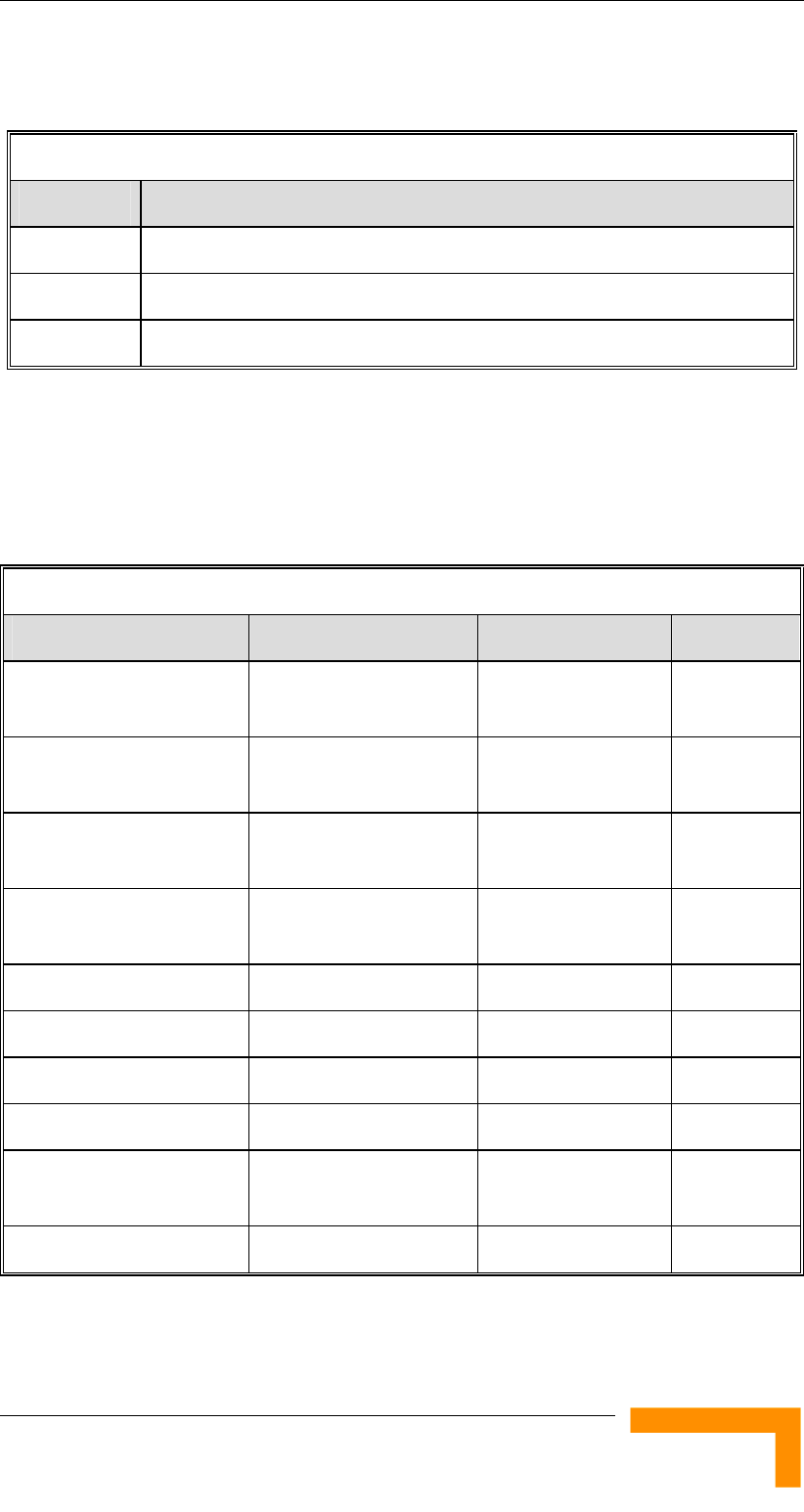
Specifications
Manual Revision 1.0
1-17
Electrical
Table 1-11: Electrical Specifications, Subscriber Unit
Unit Details
General Power consumption: 25W
IDU AC power input: 100-240 VAC, 50-60 Hz
SU-A-ODU 54VDC from the IDU over the indoor-outdoor Ethernet cable
Modular Base Station Equipment
Mechanical
Table 1-12: Mechanical Specifications, Modular Base Station Equipment
Unit Structure Dimensions (cm) Weight (kg)
BS-SH-VL 19" rack (3U) or
desktop
13 x 48.2 x 25.6 4.76
BS-PS-DC-VL DC power supply
module
12.9 x 7.0 x 25.3 1.2
BS-PS-AC-VL AC power supply
module
12.9 x 7.0 x 25.3 1.2
BS-AU Indoor module of the
AU-D-BS access unit
12.9 x 3.5 x 25.5 0.15
AU-D-BS-ODU pole or wall mountable 30.6 x 12.0 x 4.7 1.85
AU-Ant-5G-16-60 2"-3.5" pole mountable 43.6 x 25 x 1.0 2.2
AU-Ant-5G-17-90 2"-3.5" pole mountable 55 x 25 x 1.1 1.5
AU-Ant-5G-15-120 2"-3.5" pole mountable 53 x 26 x 1.1 2.5
AU-Ant-5.8G-8-Omni Surface or pole
mountable
40cm high, 3.2cm
base diameter
0.23
AU-Ant-5.8G-14-120-UK 1"-4" pole mountable 55 x 7.5 x 5 1
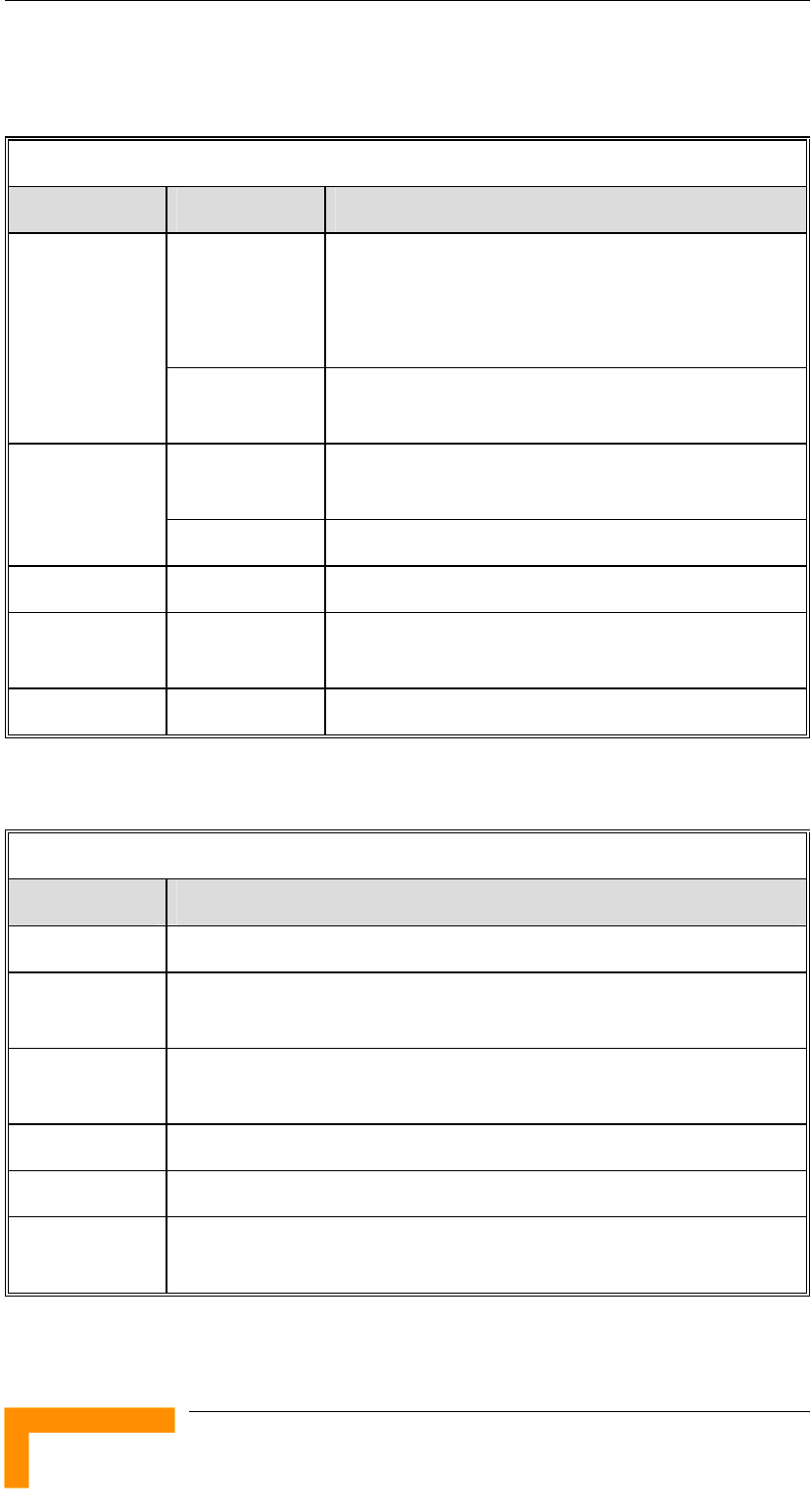
Chapter 1 - System Description
BreezeACCESSS VL System Manual
1-18
Connectors
Table 1-13: Connectors, Modular Base Station Equipment
Unit Connector Description
10/100 BaseT 10/100BaseT Ethernet (RJ-45) with 2 embedded
LEDs.
Cable connection to a PC: crossed
Cable connection to a hub: Straight
BS-AU
RADIO 10/100BaseT Ethernet (RJ-45) with 2 embedded
LEDs
INDOOR 10/100BaseT Ethernet (RJ-45), protected by a
waterproof sealing assembly
AU-D-BS-ODU
ANT N-Type jack, 50 ohm, lightning protected
BS-PS-AC-VL AC-IN 3-PIN AC power plug
BS-PS-DC-VL -48 VDC 3 pin DC D-Type 3 power pins plug
Amphenol 717TWA3W3PHP2V4RRM6
Antenna RF N-Type jack (on a 1.5m cable in the Omni-8-5.8)
Electrical
Table 1-14: Electrical Specifications, Modular Base Station Equipment
Unit Details
General 240W max. for a fully equipped chassis (1 PS, 6 AU)
BS-PS-AC-VL AC power input: 85-265 VAC, 47-65 Hz
DC power output: 54 V; 3.3 V
BS-PS-DC-VL DC power input: -48 VDC nominal (-34 to -72), 10 A max
DC power output: 54 V; 3.3 V
BS-AU 3.3 VDC, 54 VDC from the power supply module(s) via the back plane
AU-D-BS-ODU 54V DC from the BS-AU over the indoor-outdoor Ethernet cable
AU-D-BS
(IDU+ODU)
Power consumption: 30W
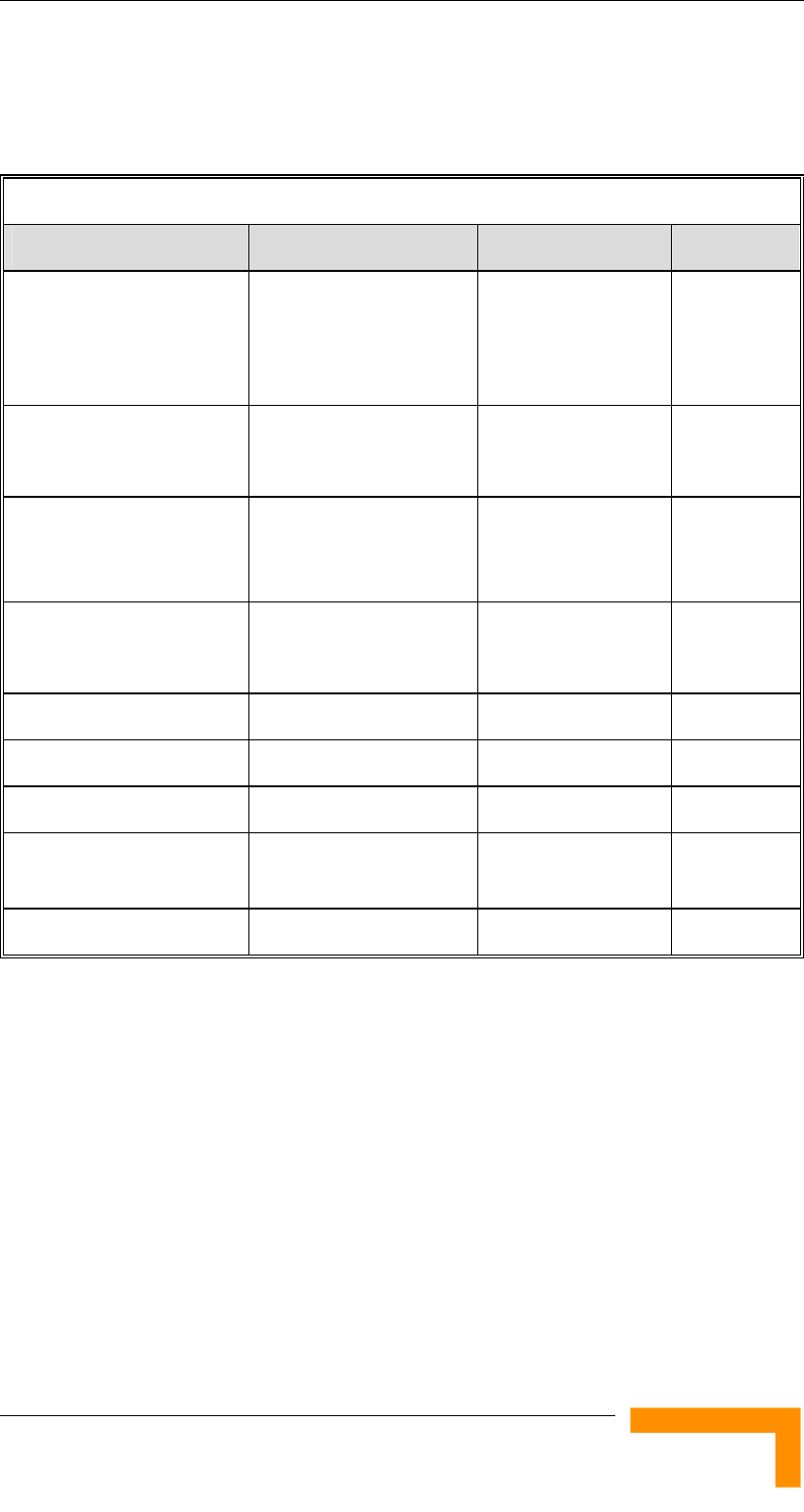
Specifications
Manual Revision 1.0
1-19
Standalone Access Unit
Mechanical
Table 1-15: Mechanical Specifications, Stand Alone Access Unit
Unit Structure Dimensions (cm) Weight (kg)
General An IDU indoor unit and
an AU-D-BS-ODU unit
outdoor connected to a
detached antenna
IDU PS1036 Desktop or wall
mountable.
16 x 9 x 6
0.55
IDU PS1073 Plastic box (black),
desktop or wall
mountable
14 x 6.6 x 3.5 0.3
AU-D-SA-ODU Poll or wall mountable 30.6 x 12 x 4.7
1.85
AU-Ant-5G-16-60 2"-3.5" pole mountable 43.6 x 25 x 1.0 2.2
AU-Ant-5G-17-90 2"-3.5" pole mountable 55 x 25 x 1.1 1.5
AU-Ant-5G-15-120 2"-3.5" pole mountable 53 x 26 x 1.1 2.5
AU-Ant-5.8G-8-Omni Surface or pole
mountable
40cm high, 3.2cm
base diameter
0.23
AU-Ant-5.8G-14-120-UK 1"-4" pole mountable 55 x 7.5 x 5 1
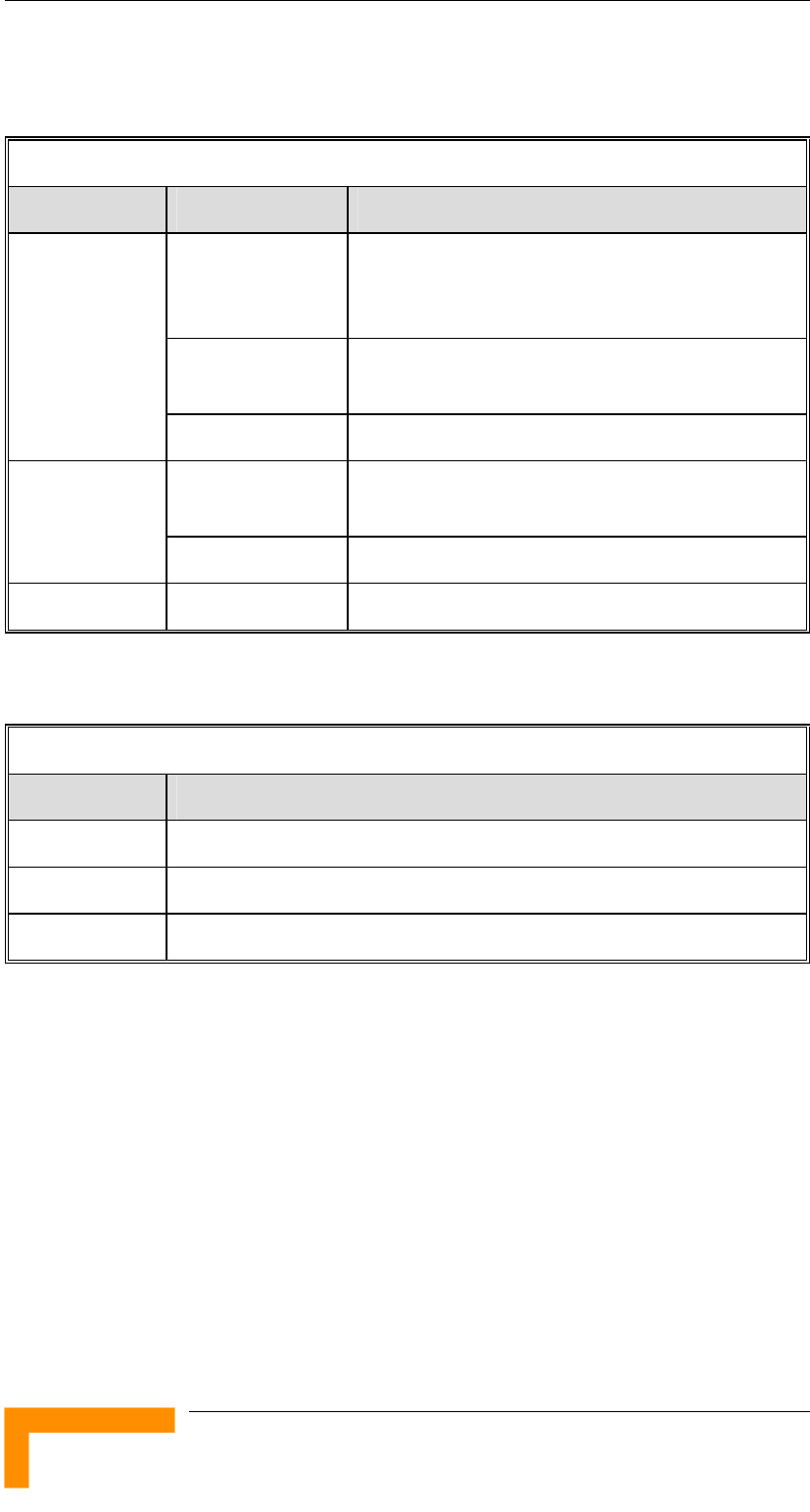
Chapter 1 - System Description
BreezeACCESSS VL System Manual
1-20
Connectors
Table 1-16: Connectors, Stand Alone Access Unit
Unit Connector Description
ETHERNET 10/100BaseT Ethernet (RJ-45)
Cable connection to a PC: crossed
Cable connection to a hub: Straight
RADIO 10/100BaseT Ethernet (RJ-45).
2 embedded LEDs in the PS1036.
IDU
AC IN 3-PIN AC power plug
INDOOR 10/100BaseT Ethernet (RJ-45), protected by a
waterproof sealing assembly
AU-D-SA-ODU
ANT N-Type jack, 50 ohm, lightning protected
Antenna RF N-Type jack (on a 1.5m cable in the Omni-8-5.8)
Electrical
Table 1-17: Electrical Specifications, Stand Alone Access Unit
Unit Details
General Power consumption: 25W
IDU AC power input: 100-240 VAC, 50-60 Hz
AU-D-SA-ODU 54VDC from the IDU over the indoor-outdoor Ethernet cable
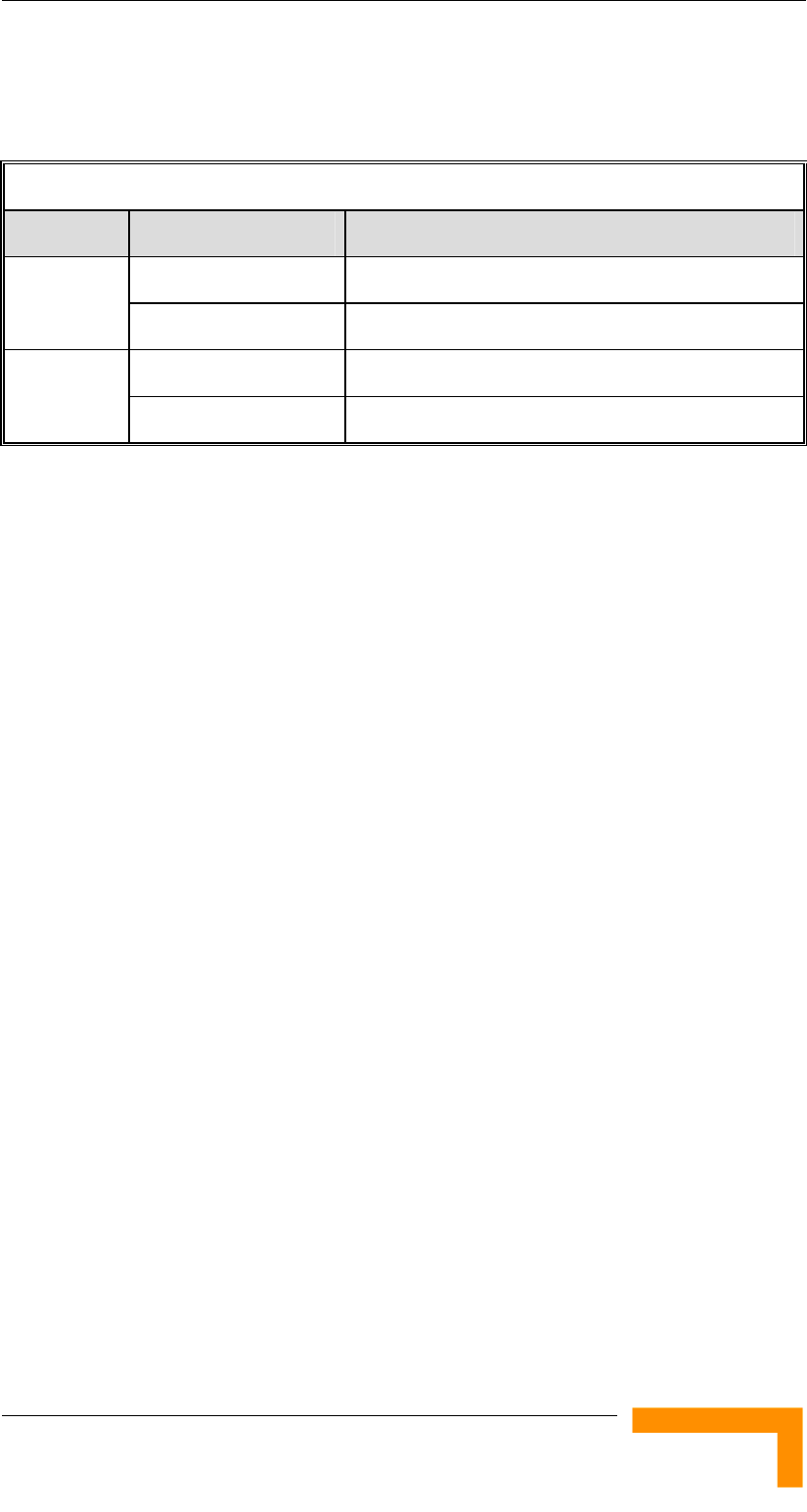
Specifications
Manual Revision 1.0
1-21
Environmental
Table 1-18: Environmental Specifications
Type Unit Details
Outdoor units -40 o C to 55 o C Operating
temperature Indoor equipment 0 o C to 40 o C
Outdoor units 5%-95% non condensing, Weather protected Operating
humidity Indoor equipment 5%-95% non condensing
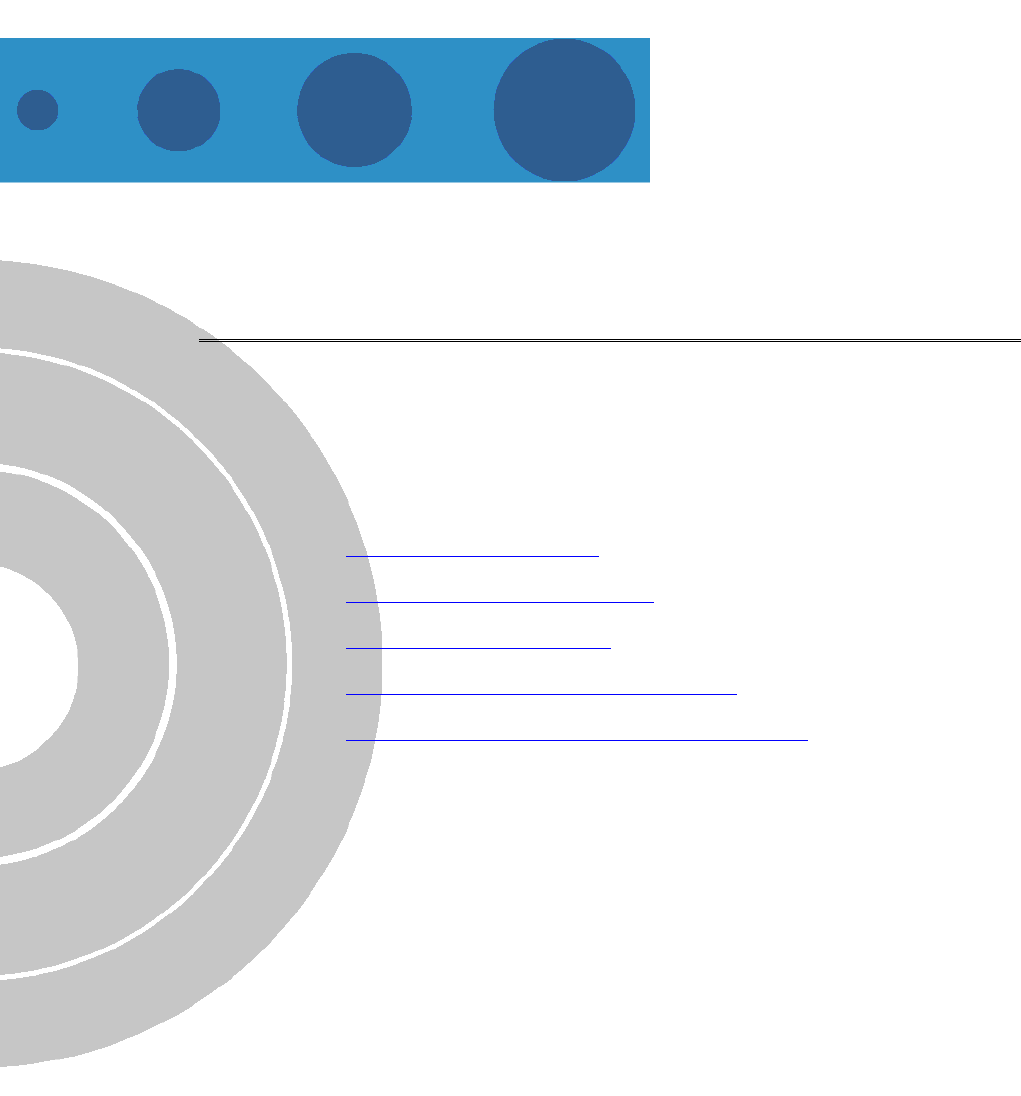
2
2
Chapter 2 - Installation
In this Chapter
! Installation Requirements, on page 2-2
! Equipment Location Guidelines, on page 2-6
! Installing the Outdoor Unit, on page 2-7
! Installing the Universal IDU Indoor Unit, on page 2-13
! Installing the Modular Base Station Equipment, on page 2-15

Chapter 2 - Installation
BreezeACCESSS VL System Manual
2-2
Installation Requirements
This section describes all the supplies required to install the
BreezeACCESS VL system components and the items included in each
installation package.
Packing List
Subscriber Unit
The SU installation kit includes the following components:
! IDU indoor unit with a wall mounting kit
! Mains power cord
! Outdoor Unit:
# SU-A-ODU outdoor unit with an integrated vertically polarized
antenna
OR
# SU-A-H-ODU outdoor unit with an integrated horizontally
polarized antenna
OR
# SU-E-ODU outdoor unit with a connection to an external
antenna
! Pole mounting kit for the ODU
! 20m Cat.5 indoor-to-outdoor Ethernet cable with shielded RJ-45
connectors
Modular Base Station Equipment
This section describes the items included in the installation packages
for each modular Base Station system component.
BS-SH-VL Base Station Chassis
The BS-SH-VL installation kit includes the following components:
! BS-SH-VL chassis with blank panels
! Rubber legs for optional desktop installation

Installation Requirements
Manual Revision 1.0
2-3
AU-D/E-BS Access Unit
The AU-D/E-BS installation kit includes the following components:
! BS-AU Network Interface module
! AU-D/E-BS-ODU outdoor unit
! Pole mounting kit for the AU-D/E-BS-ODU
! In AU-D-BS kits: Antenna, including pole mounting hardware
! RF cable
BS-PS-AC-VL Power Supply
Up to two BS-PS-AC-VL power supply modules can be included in each
Base Station chassis. The BS-PS-AC-VL installation kit includes the
following components:
! BS-PS-AC-VL power supply module
! Mains power cord
BS-PS-DC-VL Power Supply
Up to two BS-PS-DC-VL power supply modules can be included in each
Base Station chassis. The BS-PS-DC-VL installation kit includes the
following components:
! BS-PS-DC-VL power supply module
! DC power cable
AU-D/E-SA Standalone Access Unit
The AU-D/E-SA installation kit includes the following components:
! IDU indoor unit with a wall mounting kit
! Mains power cord
! AU-D/E-SA-ODU outdoor unit with an integrated antenna
! Pole mounting kit for the AU-D/E-SA-ODU
! In AU-D-SA kits: Antenna, including pole mounting hardware
! RF cable
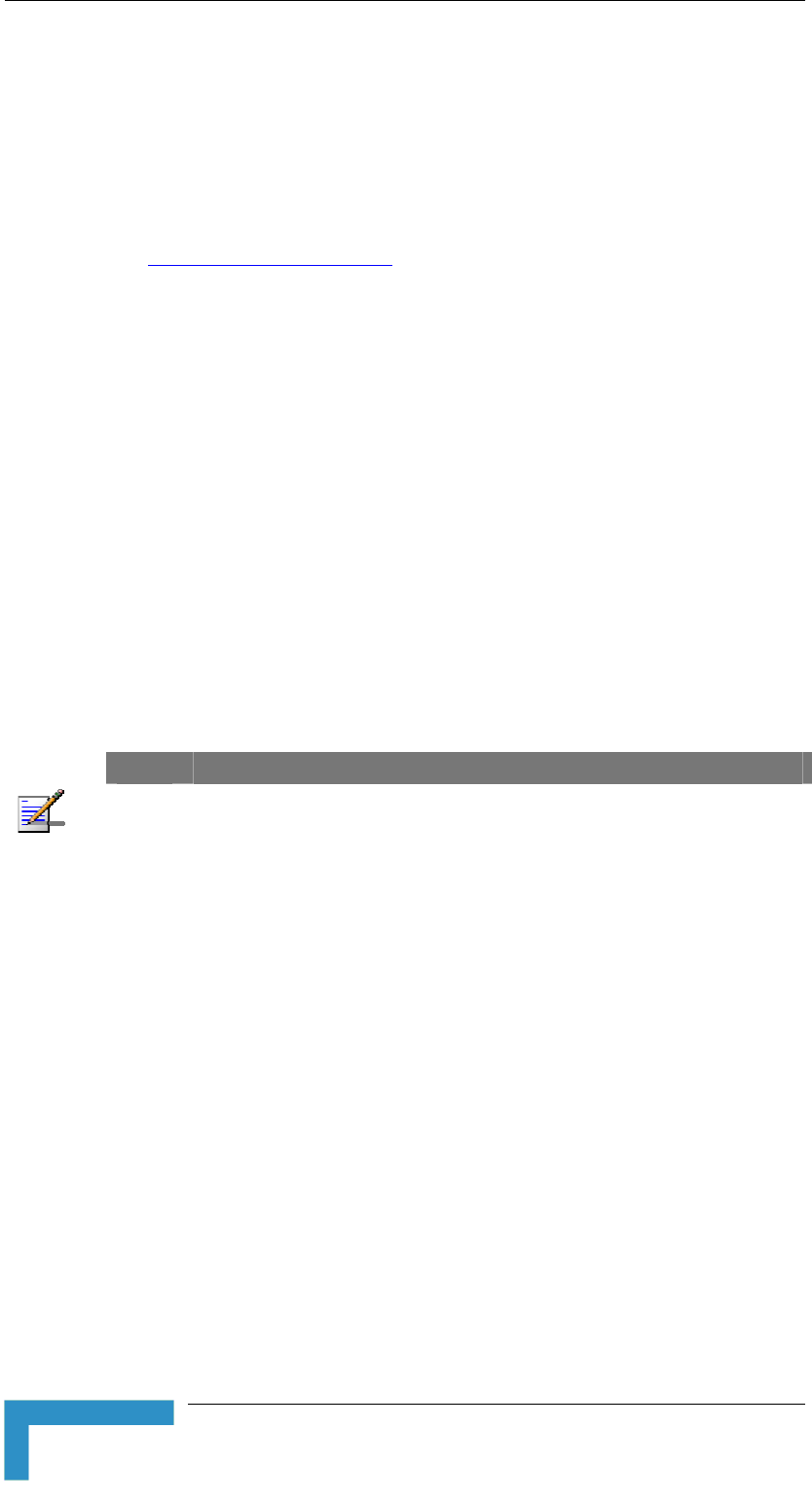
Chapter 2 - Installation
BreezeACCESSS VL System Manual
2-4
Additional Installation Requirements
The following items are also required to install the BreezeACCESS VL
system components:
! Indoor-to-outdoor Category 5 Ethernet cable with shielded RJ-45
connectors * (available in different lengths. For more details refer to
Indoor-to-Outdoor Cables on page 2-5).
! Ethernet cable (straight for connecting to a hub/switch etc., crossed
for connecting directly to a PC’s NIC)
! Crimping tool for RJ-45 connectors.
! Antenna, for E model units supplied without an antenna
! Ground cables with an appropriate termination.
! Mains plug adapter or termination plug (if the power plug on the
supplied AC power cord does not fit local power outlets).
! Portable PC with Ethernet card and Telnet software or
BreezeCONFIG ACCESS VL* application and a crossed Ethernet
cable.
! Installation tools and materials, including appropriate means (e.g. a
pole) for installing the outdoor unit.
NOTE
Items marked with an asterisk (*) are available from Alvarion.
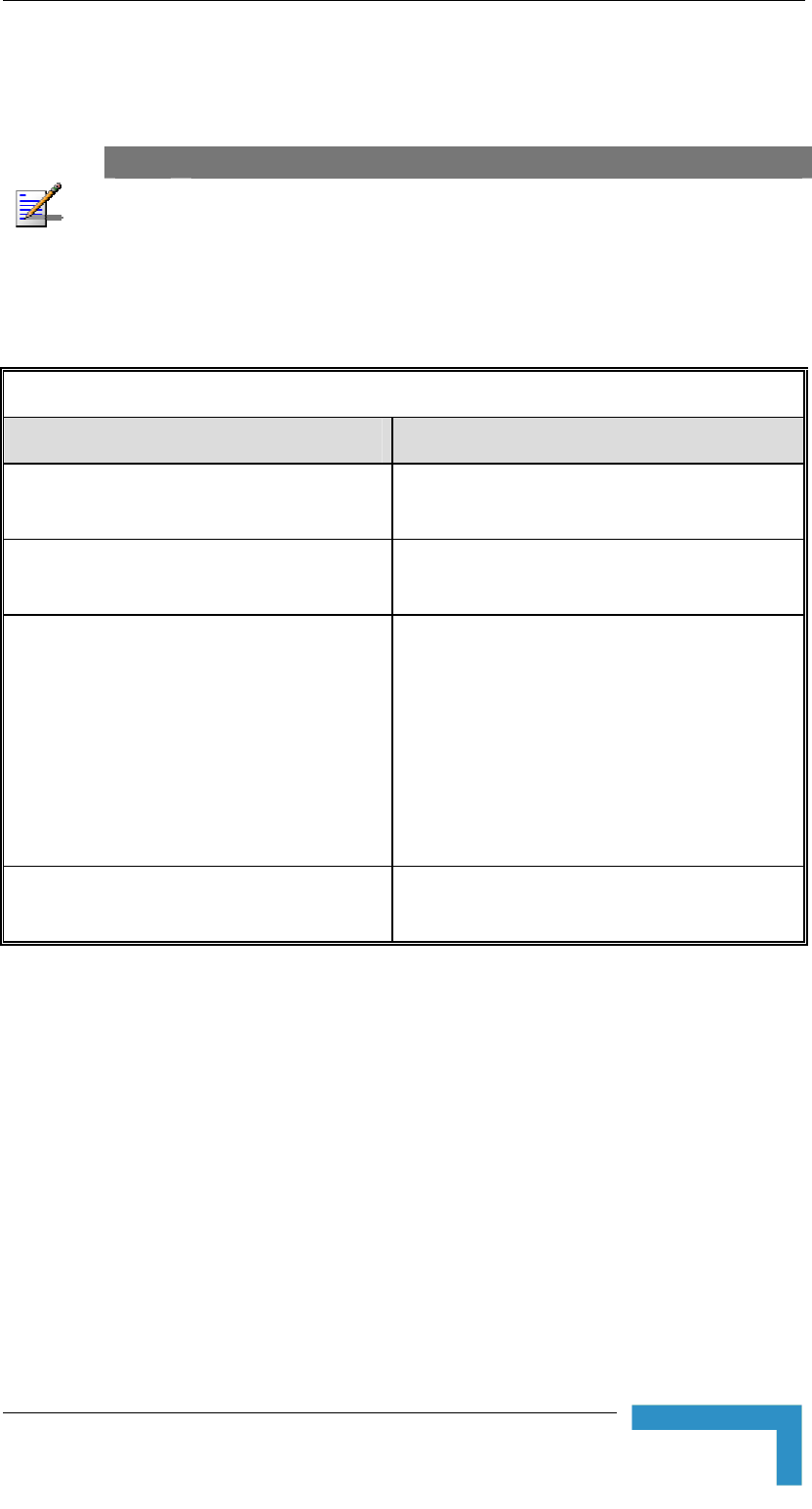
Installation Requirements
Manual Revision 1.0
2-5
Indoor-to-Outdoor Cables
NOTE
The length of the Ethernet cable connecting the indoor unit to the user's equipment,
together with the length of the Indoor-to-Outdoor cable, should not exceed 100 meters.
Use only Category 5E cables from approved manufacturers, listed in
Table 2-1. Consult with Alvarion specialists on the suitability of other
cables.
Table 2-1: Approved Category 5E Cables
Manufacturer Part Number
Superior Cables Ltd.
www.cvalim.co.il
612098
HES Cabling Systems
www.hescs.com
H5E-00481
Southbay Holdings Limited
11th Fl., 15, Lane 347, Jong Jeng Rd.
Shin Juang City, Taipei County
Taiwan, R.O.C
Attn: Eva Lin
Tel. 886-2-2832 3339
Fax. 886-2-2206 0081
E-mail: eva@south-bay.com.tw
TSM2404A0D
Teldor
www.teldor.com
8393204101
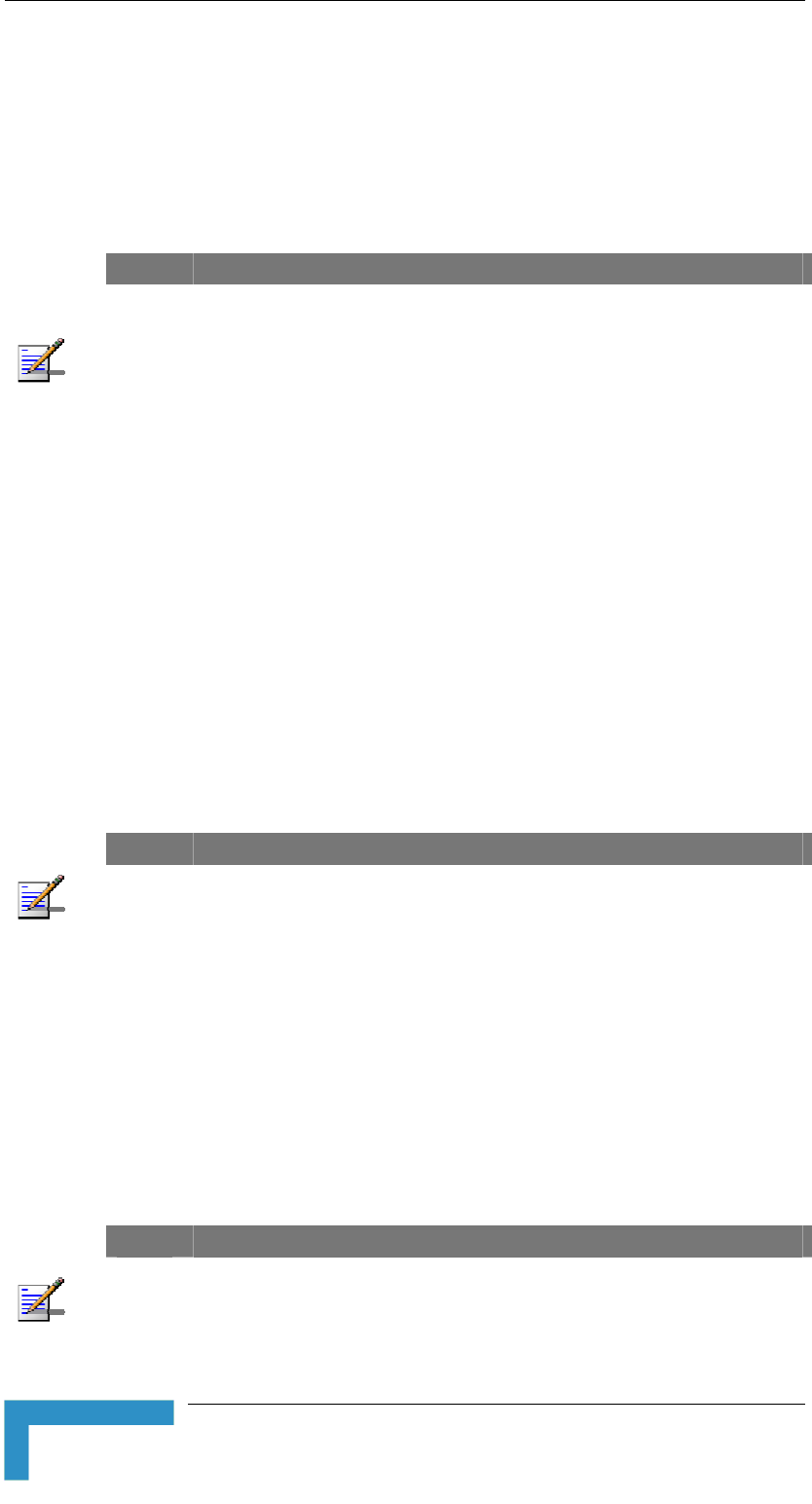
Chapter 2 - Installation
BreezeACCESSS VL System Manual
2-6
Equipment Location Guidelines
This section provides key guidelines for selecting the optimal
installation locations for the various BreezeACCESS VL system
components.
NOTE
ONLY experienced installation professionals who are familiar with local building and
safety codes and, wherever applicable, are licensed by the appropriate government
regulatory authorities should install outdoor units and antennas.
Failure to do so may void the BreezeACCESS product warranty and may expose the
end user or Service Provider to legal and financial liabilities. Alvarion and its resellers or
distributors are not liable for injury, damage or regulation violations associated with the
installation of Outdoor Units or antennas.
Select the optimal locations for the equipment using the following
guidelines:
! The outdoor unit can be either pole or wall mounted. Its location
should enable easy access to the unit for installation and testing.
! The higher the placement of the antenna, the better the achievable
link quality.
! AU-ODU units should be installed as close as possible to the
antenna.
! The antenna connected to the AU-ODU unit, should be installed so
as to provide coverage to all Subscriber Units within its service area.
NOTE
The recommended minimum distance between any two antennas serving adjacent
sectors is 2 meters. The recommended minimum distance between two antennas
serving opposite cells (installed back-to-back) is 5 meters.
! The antenna of the SU (integrated on the front side of SU-A-ODU
and SU-A-H-ODU unit) should be installed to provide a direct, or
near line of sight with the Base Station antenna. The antenna
should be aligned to face the Base Station.
! The indoor equipment should be installed as close as possible to the
location where the indoor-to-outdoor cable enters the building. The
location of the indoor equipment should take into account its
connection to a power outlet and the CPE.
NOTE
The system complies with the ETS 300 491-1 standard and is protected against
secondary lightning strikes when the Outdoor Unit is properly grounded according to the
relevant country specific industry standards for protection of structures against lightning.
The system complies with EN 61000 4 5 test level 3 (2kV).
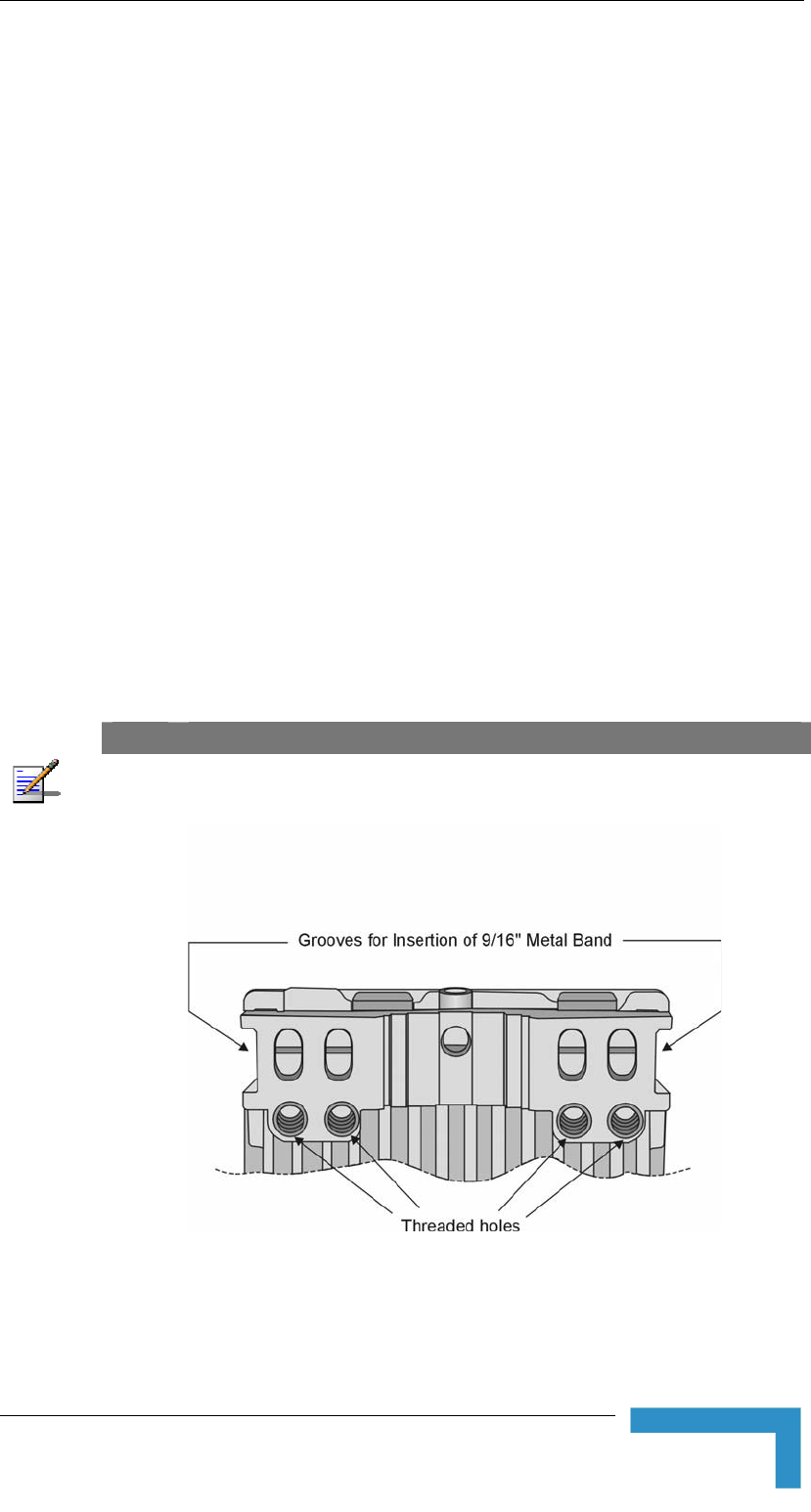
Installing the Outdoor Unit
Manual Revision 1.0
2-7
Installing the Outdoor Unit
The following sections describe how to install the outdoor units,
including pole mounting the ODU, and connecting the indoor-to-
outdoor, grounding and RF cables.
Pole Mounting the Outdoor Unit
The Outdoor Unit can be mounted on a pole using one of the following
options:
! Special brackets and open-ended bolts are supplied with each unit.
There are two pairs of threaded holes on the back of the unit,
enabling the special brackets to be mounted on diverse pole widths.
! Special grooves on the sides of the unit enable the use of metal
bands to secure the unit to a pole. The bands must be 9/16 inches
wide and at least 12 inches long. The metal bands are not included
with the installation package.
Figure 2-1 shows the locations of the holes and band grooves on the
back, top and bottom of the Outdoor Unit.
NOTE
Be sure to install the unit with the bottom panel, which includes the LED indicators,
facing downward.
Figure 2-1: Threaded Holes/Grooves
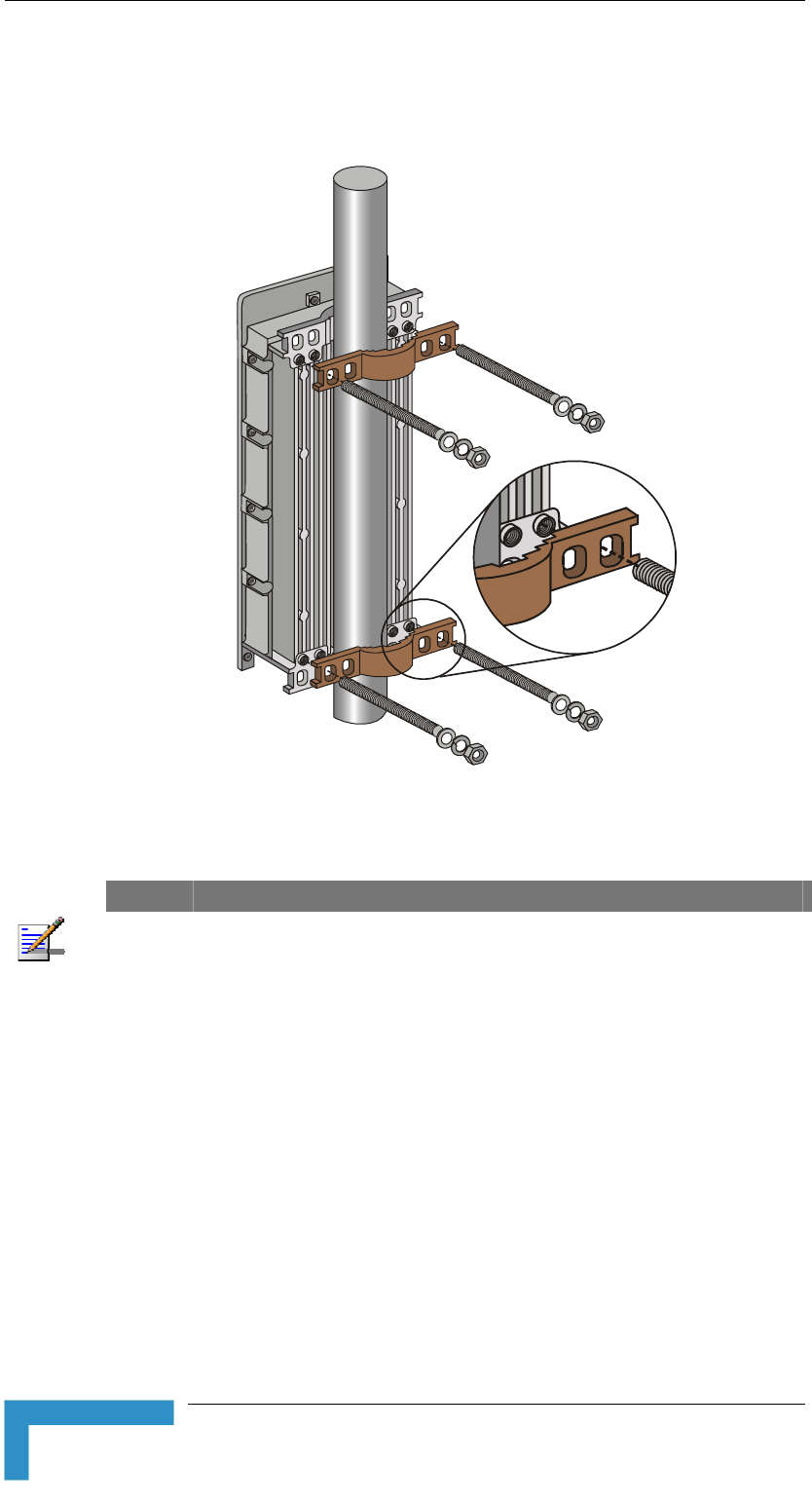
Chapter 2 - Installation
BreezeACCESSS VL System Manual
2-8
Figure 2-2 illustrates the method of installing an outdoor unit on a pole,
using the brackets and open-ended bolts.
Figure 2-2: 3" Pole Installation Using Special Brackets
NOTE
Be sure to insert the open ended bolts with the grooves pointing outward, since these
grooves enable you to use a screwdriver to fasten the bolts to the unit.
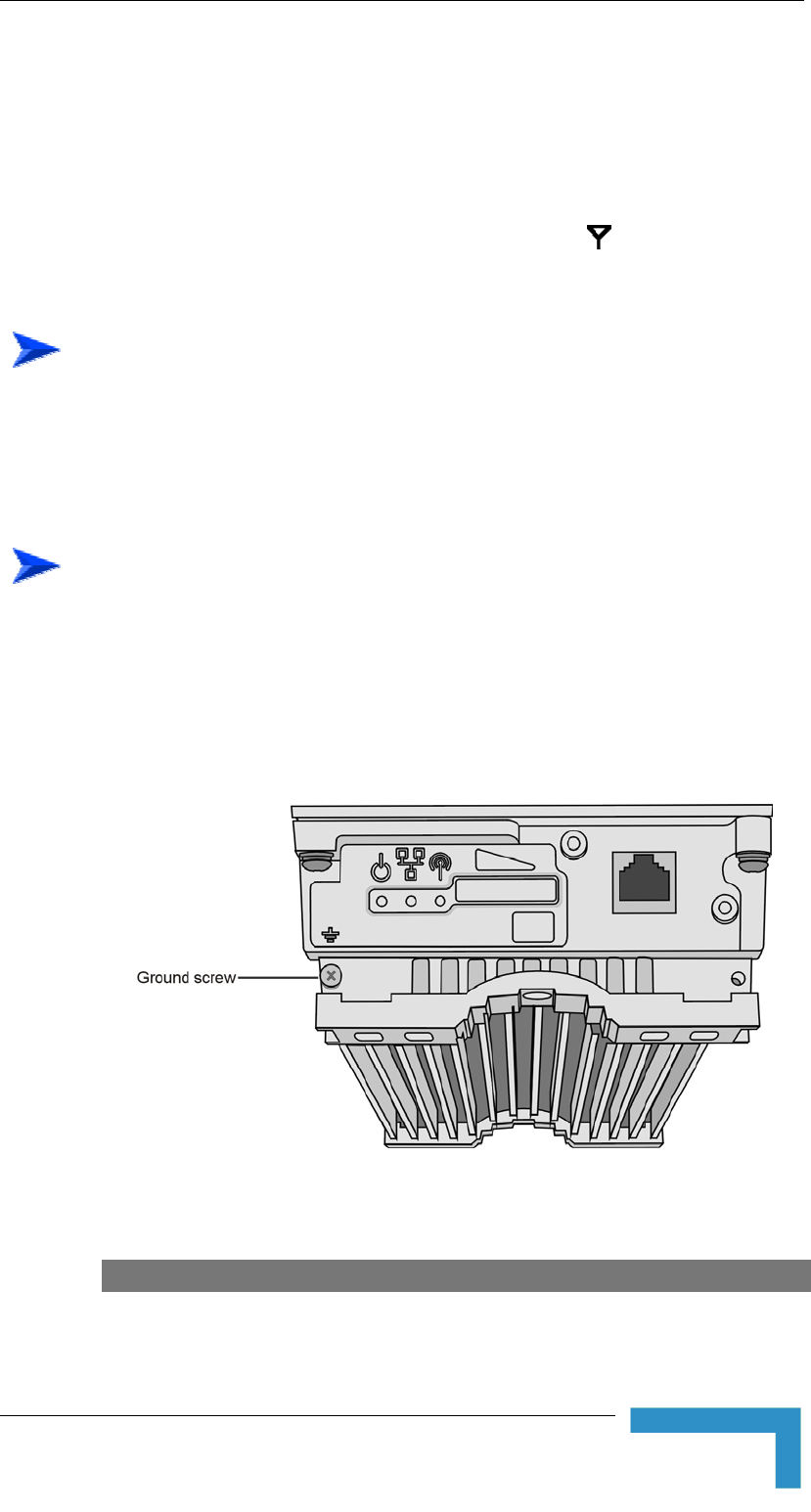
Installing the Outdoor Unit
Manual Revision 1.0
2-9
Connecting the Ground and Antenna
Cables
The Ground terminal (marked ╤) is located on the bottom panel of the
outdoor unit. The Antenna RF connector (marked ) is located on the
top panel of the AU-ODU.
1. Connect one end of a grounding cable to the ground terminal and
tighten the ground screw firmly.
2. Connect the other end of the ground cable to a ground connection.
1. Connect one end of the coaxial RF cable to the RF connector on the
top panel of the unit
2. Connect the other end of the RF cable to the antenna.
3. The RF connectors should be sealed properly to protect against rain
and moisture
Figure 2-3: Bottom Panel of the Outdoor Unit (without the seal assembly)
NOTE
To prepare the ground cable:
To connect the RF cable (units with external antenna)):
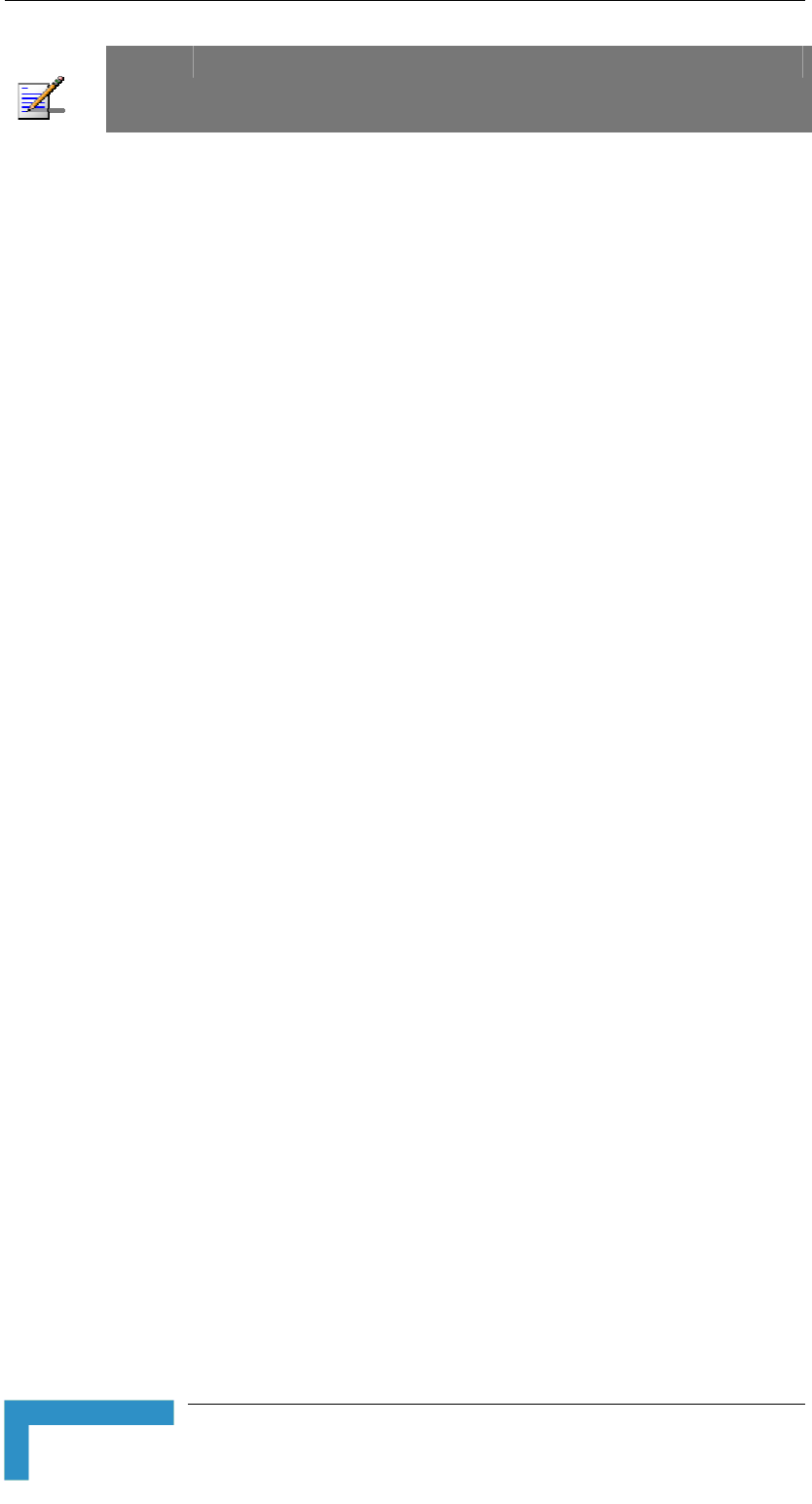
Chapter 2 - Installation
BreezeACCESSS VL System Manual
2-10
NOTE
The MAC Address of the unit is marked on both the ODU and the indoor unit (on the
print side of the BS-AU module or on the bottom side of the Universal IDU). If due to any
reason the ODU is not used with the IDU with whom it was shipped, the MAC Address
of the system is in accordance with the marking on the ODU.
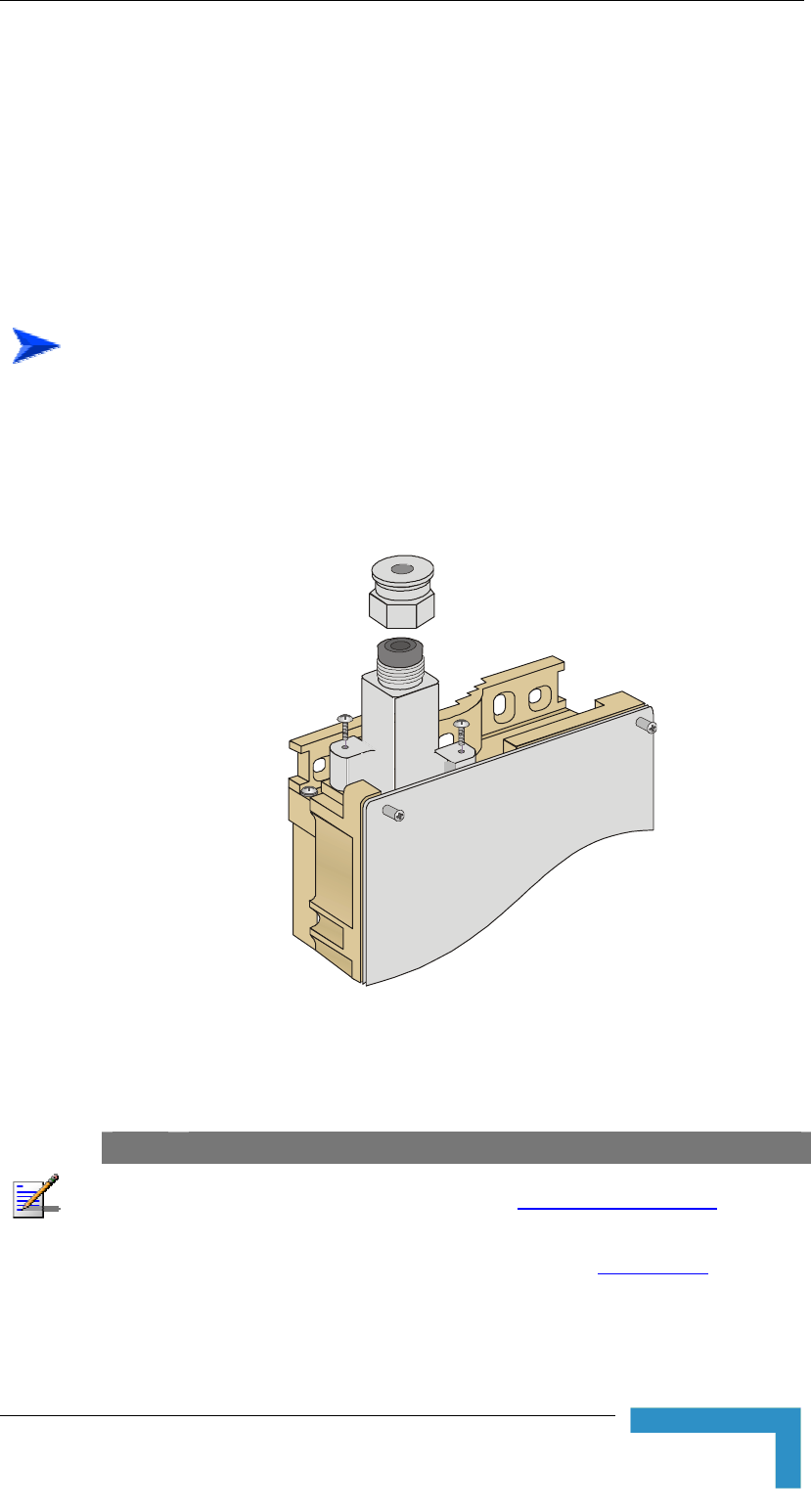
Connecting the Indoor-to-Outdoor Cable
Manual Revision 1.0
2-11
Connecting the Indoor-to-Outdoor
Cable
Units with an installed waterproof seal
1. Remove the two screws holding the waterproof seal to the outdoor
unit and remove the waterproof seal.
2. Unscrew the top nut from the waterproof seal.
Figure 2-4: The Waterproof Seal
3. Route a straight Cat. 5 Ethernet cable (8-wire, 24 AWG) through
both the top nut and the waterproof seal.
NOTE
Use only Category 5E 4x2x24# FTP outdoor cables from an approved manufacturer.
See list of approved cables and length limitations in Indoor-to-Outdoor Cables on page
2-5.
4. Insert and crimp the RJ-45 connector. Refer to Appendix C for
instructions on preparing the cable.
5. Connect the Ethernet cable to the outdoor unit RJ-45 connector.
To connect the indoor-to-outdoor cable:

Chapter 2 - Installation
BreezeACCESSS VL System Manual
2-12
6. Replace the waterproof seal and then the top nut. Make sure that
the external jack of the cable is well inside the waterproof seal to
guarantee a good seal.
7. Route the cable to the location selected for the indoor equipment.
8. Assemble an RJ-45 connector with a protective cover on the indoor
end of the indoor-to-outdoor cable.
Units with a waterproof seal supplied
with the Ethernet cable
1. Verify that the o-ring supplied with the cable kit is in place.
2. Connect the RJ-45 connector of the Ethernet cable to the outdoor
unit.
3. Attach the waterproof seal to the unit. Tighten the top nut.
4. Route the cable to the location selected for the indoor equipment.
5. Assemble an RJ-45 connector with a protective cover on the indoor
end of the indoor-to-outdoor cable.
See Appendix C - Preparing the Indoor to Outdoor SU Cable for
instructions on preparing the cable.
To connect the indoor-to-outdoor cable:
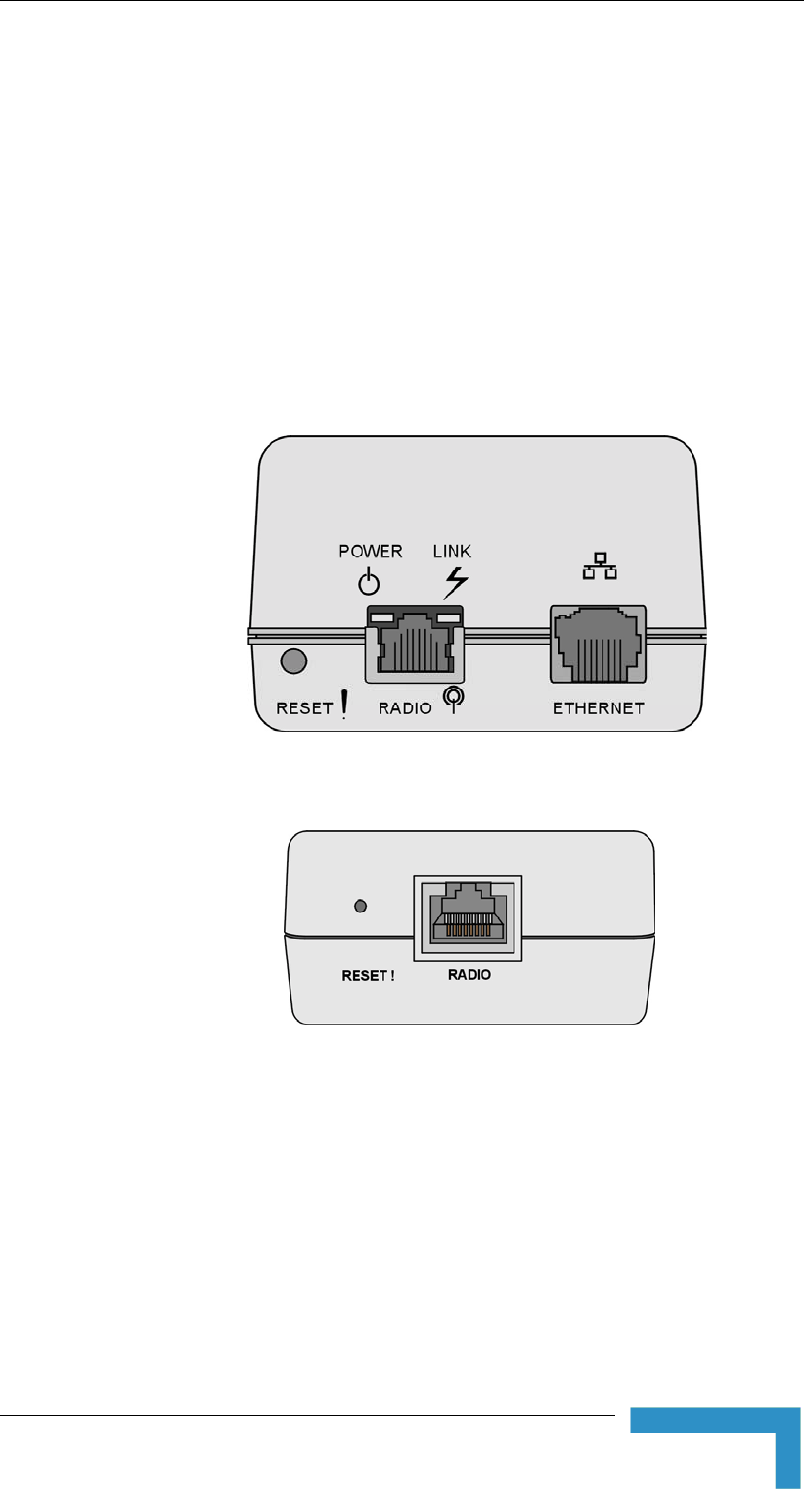
Installing the Universal IDU Indoor Unit
Manual Revision 1.0
2-13
Installing the Universal IDU Indoor
Unit
The unit can be placed on a desktop or a shelf. Alternatively, it may be
wall-mounted. The drilling template included with the unit can be used
to simplify the wall installation process.
The equipment is shipped with either a PS1036 (white box) or a PS1073
(black box) IDU. The type is marked on the bottom of the unit. The
functionality is very similar, although there are some mechanical
differences between the two types, as shown in the following figures:
Figure 2-5: IDU PS 1036 Front Panel
Figure 2-6: IDU PS 1073 Front Panel
In the PS1036 IDU, all connectors, indicators and RESET button are
located on the front panel. In the smaller PS1073 (black colored) IDU,
the RADIO connector and RESET button are located on the front panel,
the ETHERNET connector is located on the side panel and LEDs are
located on the top panel. There are also some differences in the names
and functionality of the LEDs.
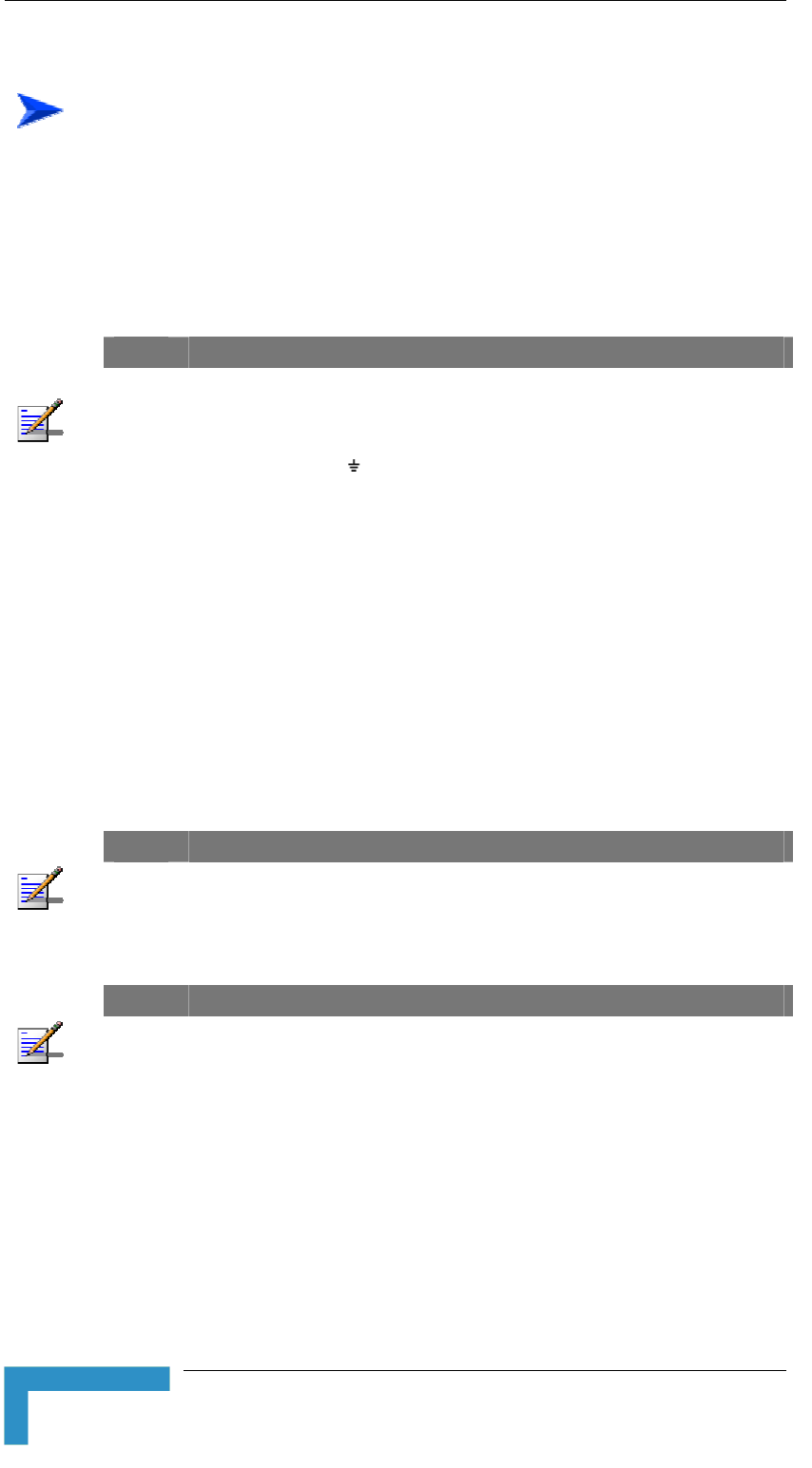
Chapter 2 - Installation
BreezeACCESSS VL System Manual
2-14
1. Connect the Indoor-to-Outdoor cable to the RADIO connector,
located on the front panel of the indoor unit.
2. Connect the power cord to the unit's AC socket, located on the rear
panel. Connect the other end of the power cord to the AC mains.
The unit can operate with AC mains of 100-240 VAC, 50-60 Hz.
NOTE
The color codes of the power cable are as follows:
Brown Phase ~
Blue Neutral 0
Yellow/Green Ground
3. Verify that the POWER LED (located on the front panel of the
PS1036 and on the top panel of the PS1073) is lit, indicating that
power is supplied to the unit.
4. Configure the basic parameters as described in Configuring Basic
Parameters on page 3-2.
5. Connect the 10/100 BaseT ETHERNET connector (located on the
front panel of the PS1036 and or the side panel of the PS1073) to
the network. The cable connection should be a straight Ethernet if
connecting the indoor unit to a Hub/Switch and a crossed cable if
connecting it directly to a PC Network Interface Card (NIC).
NOTE
The length of the Ethernet cable connecting the indoor unit to the user's equipment,
together with the length of the Indoor-to-Outdoor cable, should not exceed 100 meters.
NOTE
Reset the unit using the RESET recessed push button after connecting or reconnecting
the indoor and outdoor units with the indoor-to-outdoor cable.
To install the IDU:
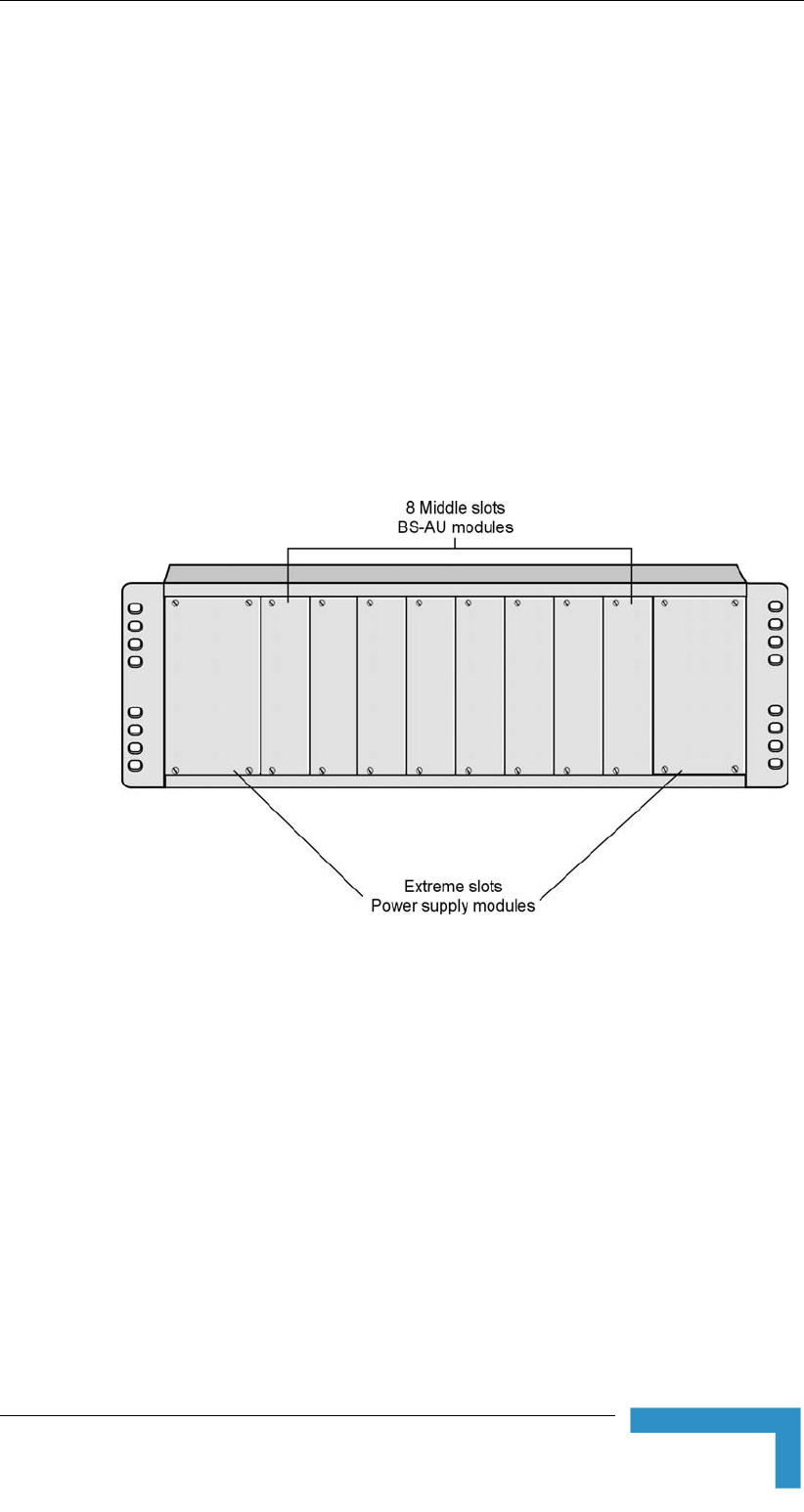
Installing the Modular Base Station Equipment
Manual Revision 1.0
2-15
Installing the Modular Base Station
Equipment
The following sections describe the slot assignments for the Base
Station chassis, provide illustrated descriptions of the power supply
modules and Access Unit network interface modules, and describe how
to install the Base Station equipment.
BS-SH-VL Slot Assignments
The Base Station chassis comprises ten slots, as shown in Figure 2-7.
Figure 2-7: BS-SH-VL Chassis Slot Assignments
To enable power supply redundancy two BS-PS power supply modules
can be installed in the wider side slots. If a single power supply module
is used, it can be inserted into either one of the two available slots.
The remaining eight slots can hold up to six BS-AU modules. Unused
slots should remain covered until required.
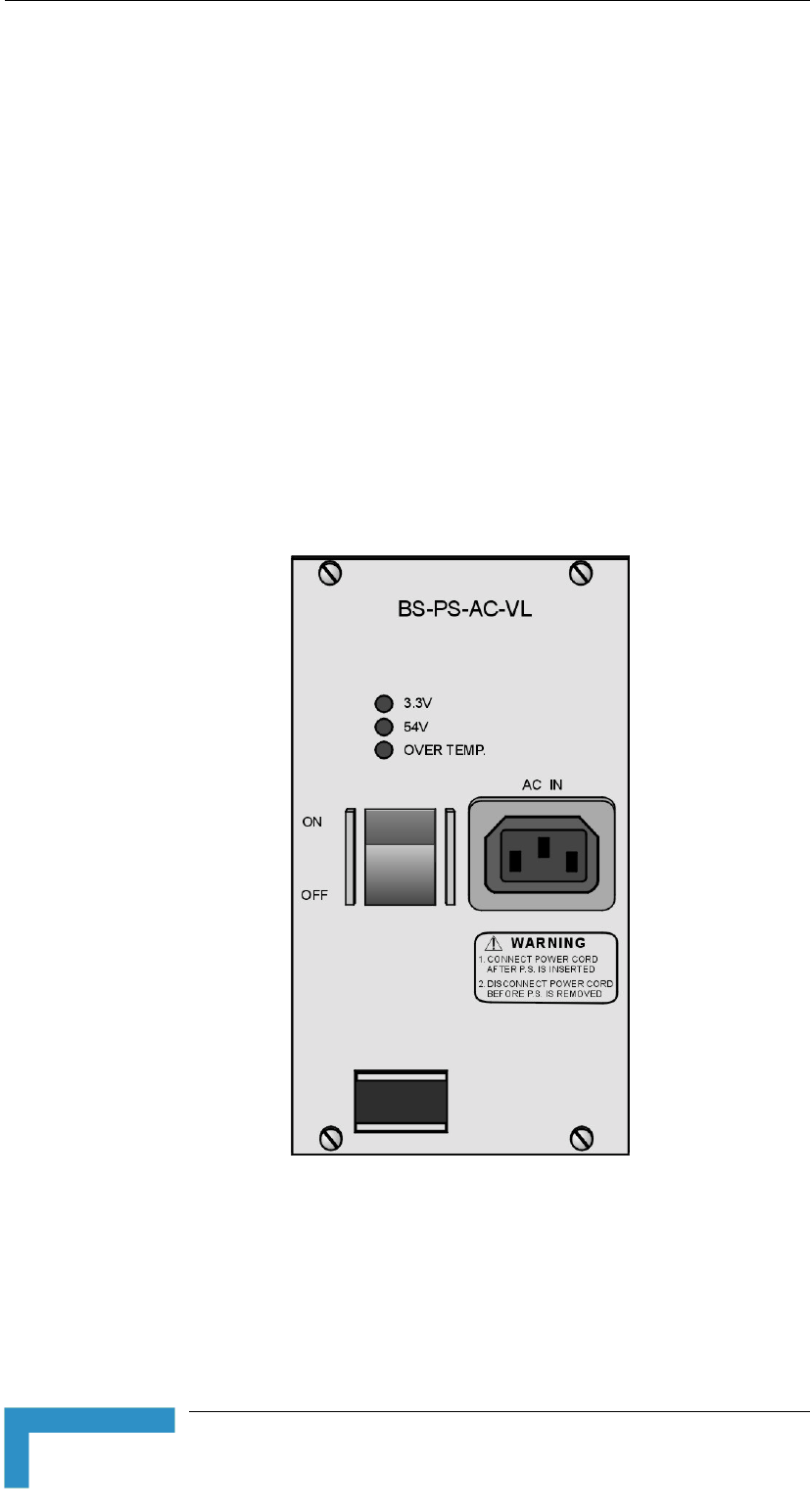
Chapter 2 - Installation
BreezeACCESSS VL System Manual
2-16
The design of the BS-SH-VL supports collocation of BreezeACCESS VL
Access Units with Access Units belonging to other BreezeACCESS
families using GFSK modulation. It supports any mix of BS-AU VL
modules with BreezeACCESS GFSK BS-AU modules, including an
optional BS-GU-GPS module. If Access Units belonging to other
BreezeACCESS families are used, than it is necessary to use two power
supply modules: one BS-PS-VL (AC or DC) power supply for the
BreezeACCESS VL Access Units and one BS-PS GFSK (AC or DC) for the
BreezeACCESS GFSK Access Units.
BS-PS- AC-VL Power Supply Module
The BS-PS-AC-VL is an AC to DC converter that provides power to all
the BS-AU VL modules installed in the BS-SH-VL chassis. The BS-PS-
AC-VL front panel is shown in Figure 2-8.
Figure 2-8: BS-PS-AC-VL Front Panel
The BS-PS-AC-VL provides a power input connector, marked AC IN, for
connecting the AC power cord to the mains.
The ON/OFF Power Switch controls the flow of mains power to the
power supply module.
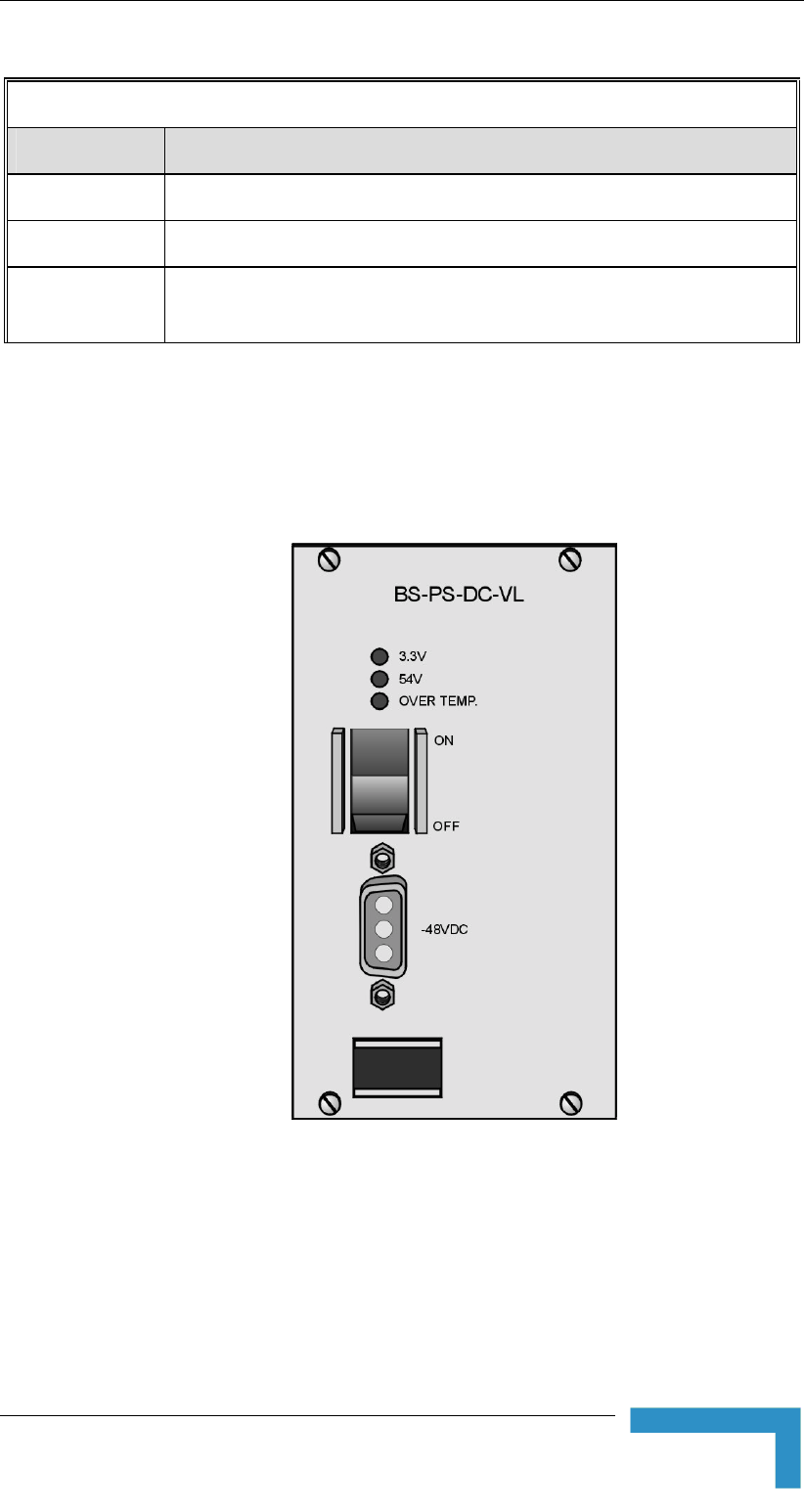
Installing the Modular Base Station Equipment
Manual Revision 1.0
2-17
Table 2-2: BS-PS LED Functionality
Name Description
54V Green LED. Indicates that the 54V power supply module is OK
3.3V Green LED. Indicates that the 3.3V power supply module is OK
OVER TEMP Red LED. Indicates an over temperature condition in the power supply
module
BS-PS-DC-VL Power Supply Module
The BS-PS-DC-VL is a DC-to-DC converter that provides power to all
the BS-AU VL modules installed in the BS-SH-VL chassis. The BS-PS-
DC-VL front panel is shown in Figure 2-9.
Figure 2-9: BS-PS-DC-VL Front Panel
The BS PS-VL-DC provides a power input connector, marked -48VDC,
for connecting the -48 VDC power source to the module.
The color codes of the cable wires are, as follows:
! Black (pin 2): 48VDC

Chapter 2 - Installation
BreezeACCESSS VL System Manual
2-18
! Red (pin 1): + (Return)
! Shield (pin 3)
The ON/OFF Power Switch controls the flow of mains power to the
power supply module.
The functionality of the LEDs is described in Table 2-2 on page 2-17.
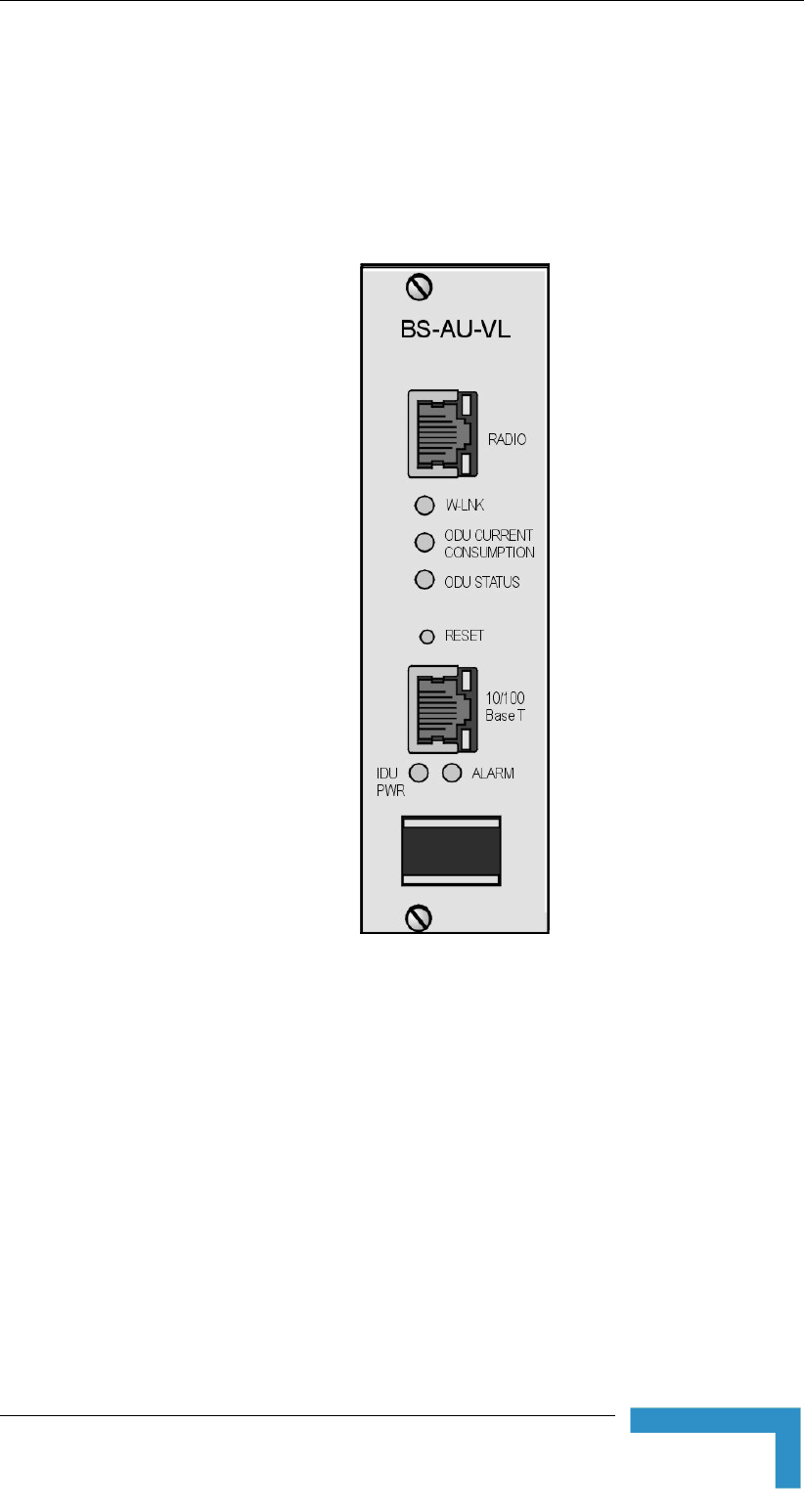
Installing the Modular Base Station Equipment
Manual Revision 1.0
2-19
BS-AU Network Interface Module
The front panel of the BS-AU Access Unit Network Interface module is
shown in Figure 2-10.
Figure 2-10: BS-AU Front Panel
The BS-AU provides the following interfaces:
! 10/100 BaseT: A 10/100BaseT Ethernet connector for connecting
the BS-AU to the network. A straight Ethernet cable should be used
to connect the module to a hub, router or switch.
! RADIO: A 10/100BaseT Ethernet connector for connecting the
BS-AU to an AU-ODU outdoor unit.
The recessed RESET switch on the front panel is for resetting the
outdoor unit.

Chapter 2 - Installation
BreezeACCESSS VL System Manual
2-20
Installing the BS-SH-VL Chassis and
Modules
This section describes how to install the power supply and Access Unit
network interface modules in the Base Station chassis.
1. Install the BS-SH-VL chassis in a 19 inch cabinet. To prevent over-
heating, leave a free space of at least 1U between the upper/lower
covers of the BS-SH-VL chassis and other units in the cabinet.
-Or-
Place the BS-SH-VL chassis on an appropriate shelf or table. When
mounting the BS-SH-VL on a shelf or table, attach the rubber legs
supplied with the unit.
2. Connect one end of a grounding cable to the ground terminal
located on the back panel of the BS-SH-VL chassis and firmly
tighten the ground screw.
3. Connect the opposite end of the ground cable to a ground
connection or to the cabinet, if applicable.
4. Carefully insert the BS-PS-VL power supply and the BS-AU modules
into the relevant slots and push firmly until they are securely
locked. Before insertion, verify that the switches of all BS-PS-VL
modules are in the OFF position. Refer to BS-SH-VL Slots
Assignments on page 2-15 for a description of the slot assignments.
5. Close the captive screws attached to each module.
6. Place blank covers over all of the unused slots.
7. Connect the indoor-to outdoor cable(s) to the RADIO connector(s) of
the BS-AU module(s).
8. If a BS-PS-DC-VL power supply is used, connect the DC power cord
to the -48 VDC In jack of the BS-PS-DC-VL power supply. If a
redundant power supply module is installed, connect a DC power
cord also to the second DC power module. Connect the power
cord(s) to the -48VDC power source, as follows.
A. Connect the black wire to the 48VDC contact of the power
source.
B. Connect the red wire to the + (Return) contact.
To install the BS SH Chassis and Modules:
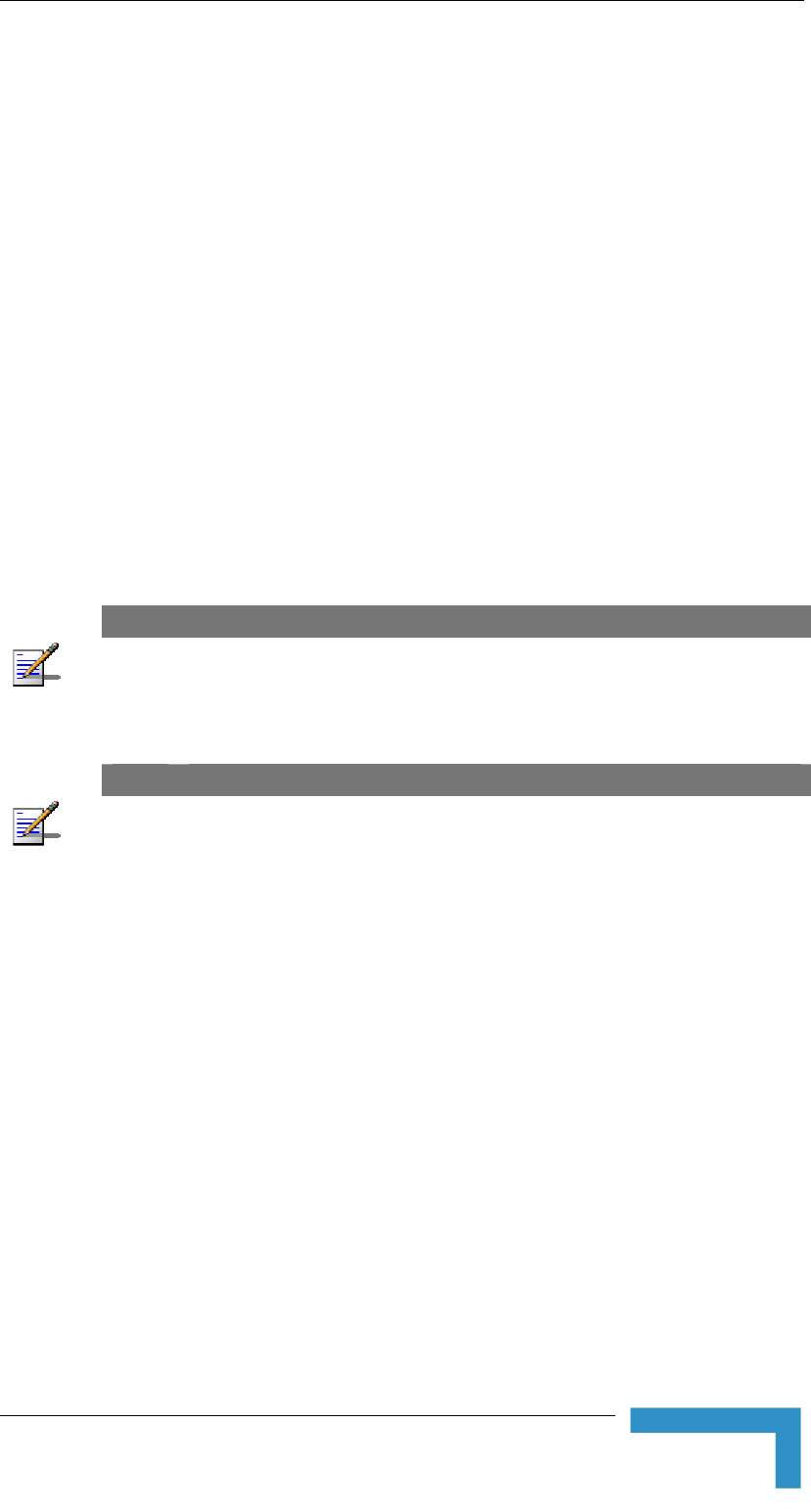
Installing the Modular Base Station Equipment
Manual Revision 1.0
2-21
C. Connect the shield to the ground.
9. If a BS-PS-AC-VL power supply is used, connect the AC power cord
to the AC In jack of the BS-PS-AC-VL power supply. If a redundant
power supply module is installed, connect an AC power cord also to
the second AC power module. Connect the power cord(s) to the
mains outlet.
10. Switch the BS-PS-AC/DC-VL power supplies to ON. Verify that all
power indicator LEDs on the BS-PS-AC/DC-VL front panel are ON
and that the OVERTEMP alarm indicator is off. Refer to Table 2-2 on
page 2-17 for a description of these LEDs.
11. Configure the basic parameters in all BS-AU modules as described
in Configuring Basic Parameters on page 3-2.
12. Connect the 10/100 BaseT LAN connector(s) to the network. The
cable connection should be straight Ethernet if connecting the
indoor unit to a Hub/Switch and a crossed cable if connecting it
directly to a PC Network Interface Card (NIC).
NOTE
The length of each of the Ethernet cables (the cable connecting the indoor unit to the
user's equipment and the Indoor-to-Outdoor cable) should not exceed 100 meters.
NOTE
Reset the unit using the RESET push button after connecting or reconnecting the indoor
and outdoor units with the indoor-to-outdoor cable.

3
3
Chapter 3 - Commissioning
About this Chapter
! Aligning the Subscriber Unit Antenna, page 3-5
! Configuring the Subscriber Unit's Maximum Modulation Level, page
3-7
! Operation Verification, page 3-9

Chapter 3 - Commissioning
BreezeACCESSS VL System Manual
3-2
Configuring Basic Parameters
After completing the installation process, as described in the preceding
chapter, the basic parameters must be configured to ensure that the
unit operates correctly. Once the basic parameters have been
configured, additional parameters can be remotely configured via the
Ethernet port or the wireless link using Telnet or SNMP management, or
by loading a configuration file.
Refer to Working With the Monitor Program on page 4-2 for information
on how to access the Monitor program using Telnet and how to use it.
The Basic Configuration menu includes all the parameters necessary for
the initial installation and operation of BreezeACCESS VL Subscriber
and Access Units. In many installations, most of these parameters
should not be changed from their default values. The basic parameters
and their default values are listed in Table 3-1.
Refer to Chapter 4 - Operation and Administration for detailed
information on the applicable parameters.
Table 3-1: Basic Parameters
Parameter Default Value Comment
Ethernet Port Negotiation Mode (in
Unit Control Parameters)
Auto Negotiation
IP Address 10.0.0.1
Subnet Mask 255.0.0.0
Default Gateway Address 0.0.0.0
DHCP Options Disable
Access to DHCP AU: From Ethernet Only
SU: From Wireless Only
ESSID ESSID1
Sub Band Select 1 Applicable only if more
than one Sub Band is
available
Frequency Subset Definition (SU) A (All) The list of frequencies is
in accordance with the
Sub Band.
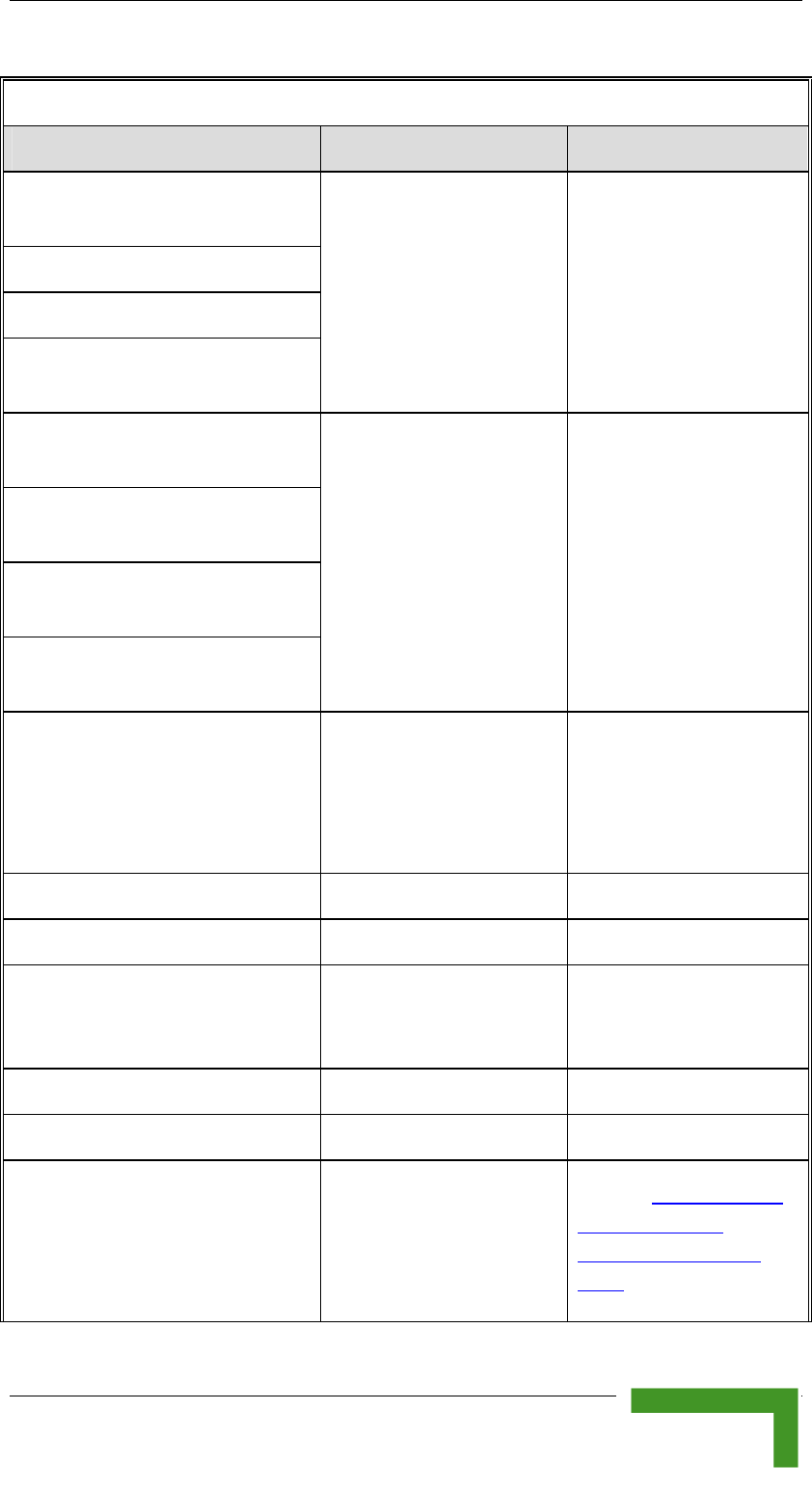
Configuring Basic Parameters
Manual Revision 1.0
3-3
Table 3-1: Basic Parameters
Parameter Default Value Comment
Tx Power for Modulation Levels 1
to 5
Tx Power for Modulation Level 6
Tx Power for Modulation Level 7
Tx Power for Modulation Level 8
(HW Revision B only)
Depend on HW revision,
unit type and Sub Band
Tx Power cannot be
higher than the applicable
Maximum Tx Power
parameter.
Maximum Tx Power for Modulation
Levels 1 to 5 (SU)
Maximum Tx Power for Modulation
Level 6 (SU)
Maximum Tx Power for Modulation
Level 7 (SU)
Maximum Tx Power for Modulation
Level 8 (SU, HW Revision B only)
Depend on HW revision
and Sub Band
Max Tx Power cannot be
higher than the upper
limit according to the Sub
Band in use.
Antenna Gain (units with external
antenna)
According to the antenna
supplied with the unit and
the Sub Band.
If set to “Not Set Yet”,
must be configured
according to actual value,
taking into account
cable’s attenuation.
ATPC Option Enable
Best AU Support (SU) Disable
Preferred AU MAC Address (SU) 00-00-00-00-00-00 (none)
Applicable only when
Best AU Support is
enabled
Cell Distance Mode (AU) Automatic
Maximum Cell Distance (AU) 0 (No Compensation)
Maximum Modulation Level (SU) 8 (or the highest value
supported according to
the country code). Not
higher than 7 for units
with HW revision A.
Refer to Configuring the
Subscriber Unit's
Maximum Modulation
Level on page 3-7
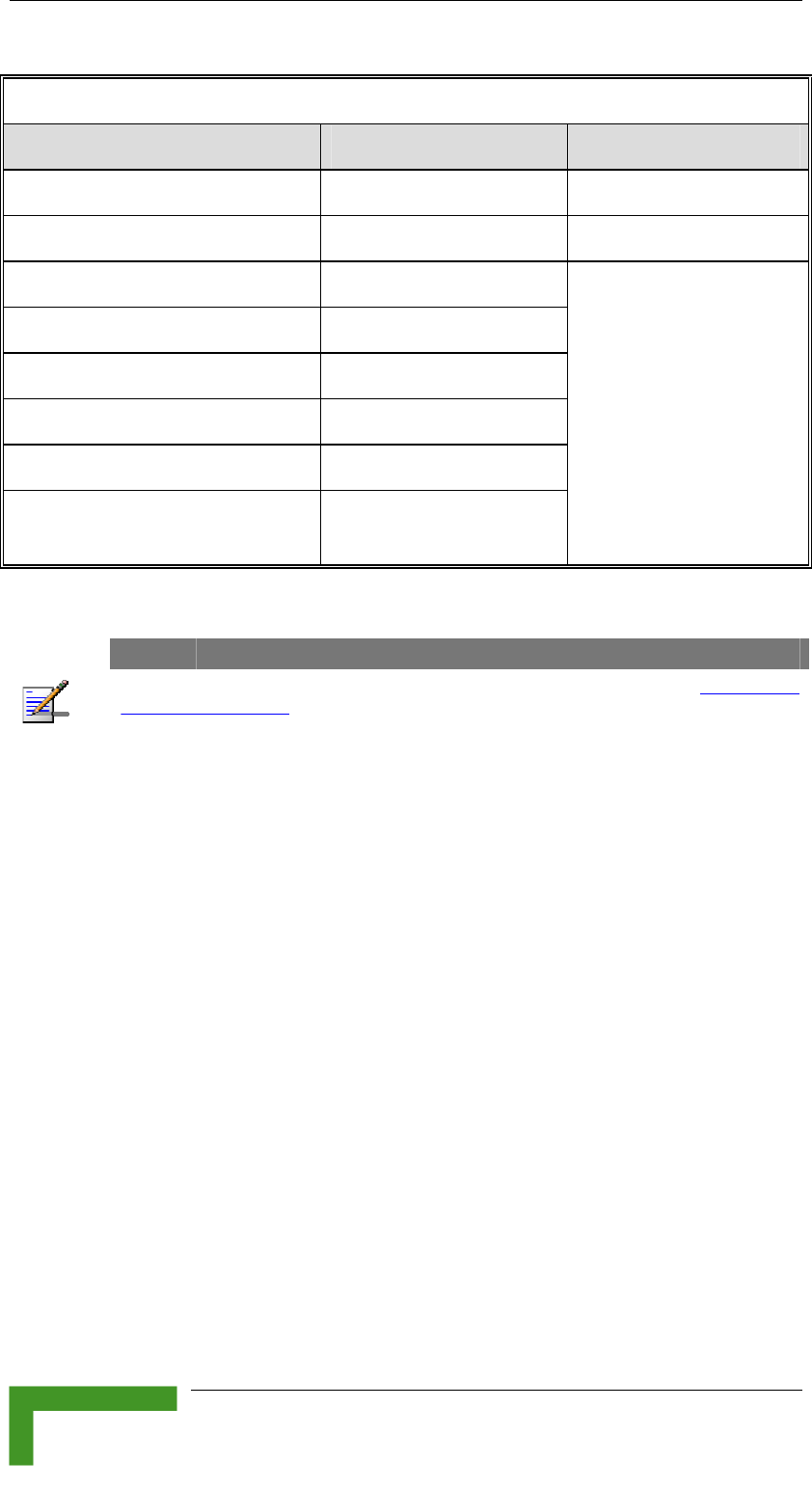
Chapter 3 - Commissioning
BreezeACCESSS VL System Manual
3-4
Table 3-1: Basic Parameters
Parameter Default Value Comment
VLAN ID-Management 65535
Authentication Algorithm Open System
Data Encryption Option Disable
Security Mode WEP
Default Multicast Key (AU) Key 1
Promiscuous Authentication (AU) Disable
Default Key (SU) Key 1
Key 1 to Key 4 00……0 (32 zeros,
meaning no key)
Availability of security
parameters depends on
support according to the
country code.
NOTE
Some parameters are changed to their new values only after reset (refer to Appendix E -
Parameters Summary for more details). Once the basic parameters are configured, the
unit should be reset in order to activate the new configuration.
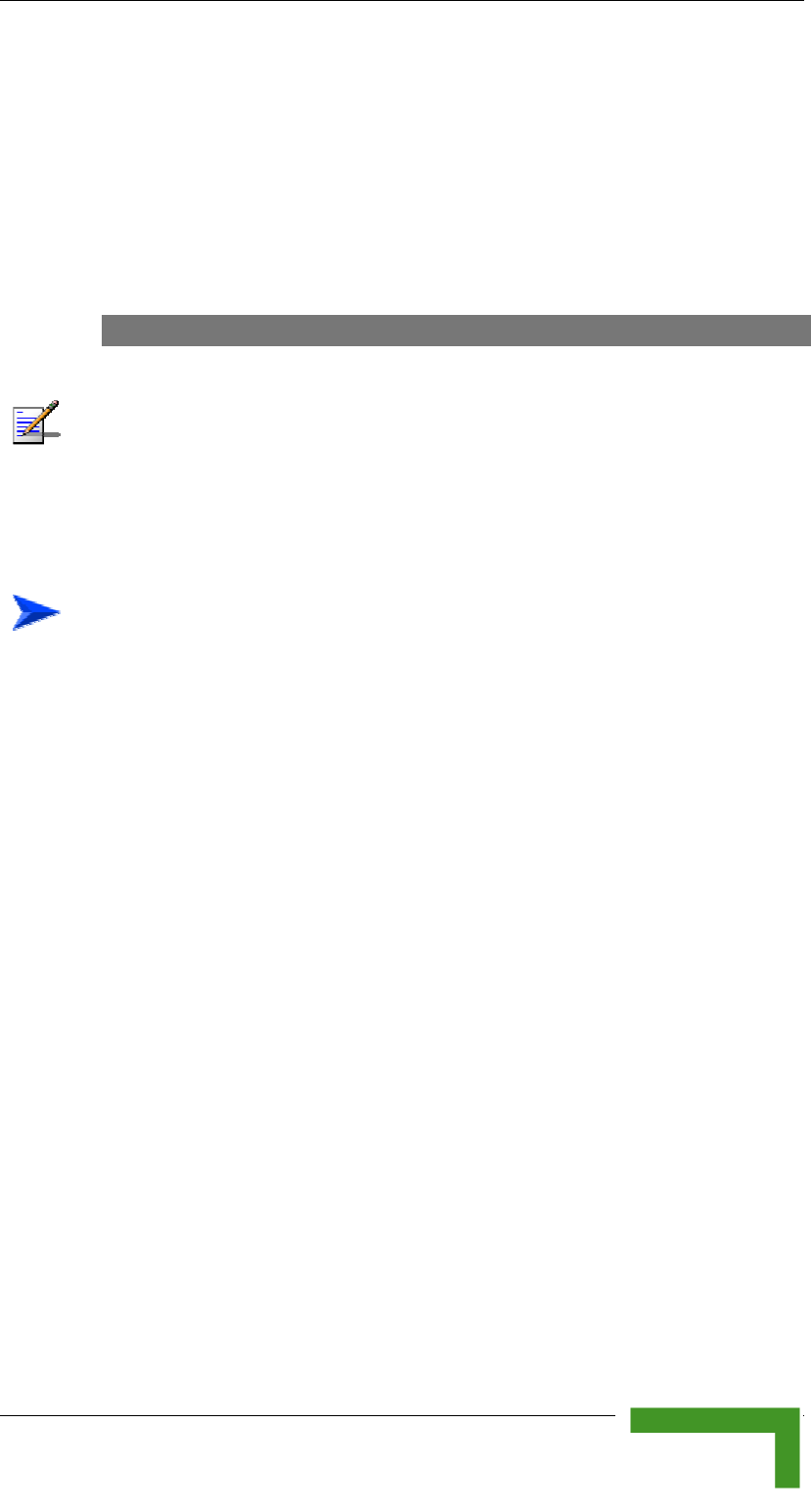
Aligning the Subscriber Unit Antenna
Manual Revision 1.0
3-5
Aligning the Subscriber Unit Antenna
The SNR bar display is located on the bottom panel of the outdoor unit.
The ten LEDs are used for indicating the quality of the received signal.
The higher the number of green LEDs indicating On, the higher the
quality of the received signal. This section describes how to align the
Subscriber Unit antenna using the SNR bar display.
NOTE
Antenna alignment using the SNR bar display is possible only after the Subscriber Unit
is associated with an Access Unit. The associated Access Unit must be operational and
the basic Subscriber Unit parameters must be correctly configured. If not, the unit will
not be able to synchronize with the Access Unit. As the SNR measurement is performed
on received frames, its results are meaningless unless the Subscriber Unit is associated
with an Access Unit.
1. Align the antenna by pointing it in the general direction of the Base
Station.
2. Verify that the power indication of the unit is On.
3. Verify that the W-LINK LED of the ODU is On, indicating that the
unit is associated with an Access Unit. If the W-LINK LED is Off,
check that the ESSID and Frequency parameters are correctly
configured. If the SU is still not associated with the AU, increase the
transmit power level to its maximum value. If the unit is still not
associated with the AU, improve the quality of the link by changing
the direction of the antenna or by placing the antenna at a higher or
alternate location.
4. Rotate the antenna until the maximum SNR reading is achieved,
where at least 1 green LED is on: If you encounter prolonged
difficulty in illuminating the minimum required number of green
LEDs, try to improve the reception quality by placing the antenna at
a higher point or in an alternate location.
5. Ensure that the front of the antenna is always facing the Base
Station. However, in certain conditions, such as when the line of site
to the Base Station is hampered, better reception may be achieved
using a reflected signal. In this case, the antenna is not always
directed toward the Base Station.
To align the Subscriber Unit antenna:

Chapter 3 - Commissioning
BreezeACCESSS VL System Manual
3-6
6. Secure the unit firmly to the pole.
NOTE
In some cases, the antenna may need to be tilted to ensure that the level at which the
SU receives transmissions from the AU (and vice versa) is not too high. As a rule of
thumb, if the SU is located at a distance of less than 300 meters from the AU, it is
recommended to up-tilt the antenna by approximately 10° to 15°. To guarantee a safety
margin from the saturation level (received signal of -40dBm at the antenna port), the
SNR should not be higher than 50dB. The orange LED of the SNR bar indicates that the
SNR is higher than 50dB.
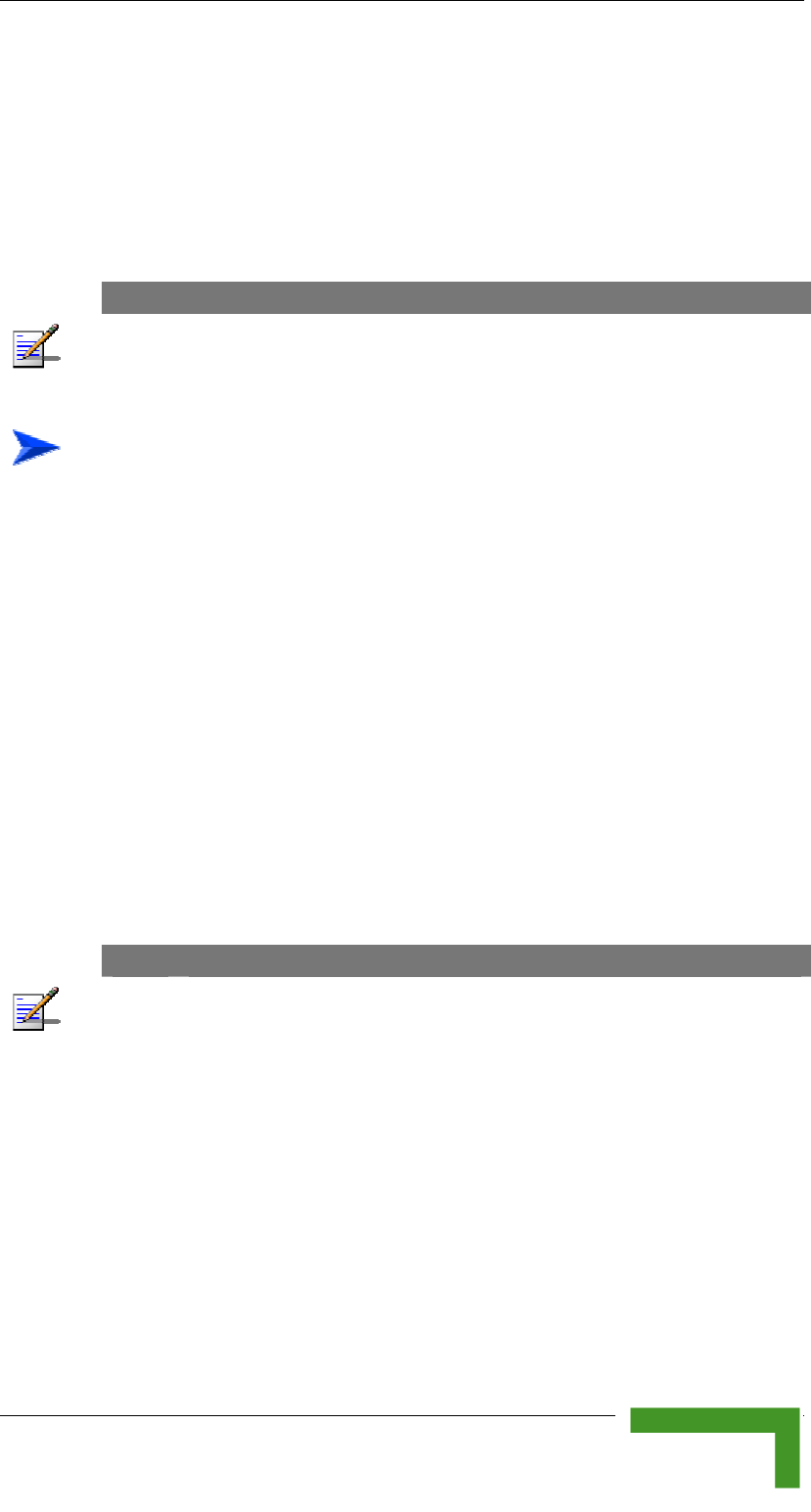
Configuring the Subscriber Unit’s Maximum Modulation Level
Manual Revision 1.0
3-7
Configuring the Subscriber Unit’s
Maximum Modulation Level
This section describes how to configure the maximum modulation level
for BreezeACCESS VL Subscriber Units.
NOTE
If the unit is associated with the AU, then the final configuration of the Maximum
Modulation Level parameter may be performed remotely, for example, from the site of
the AU or from another site.
1. If the SNR of the SU at the AU is too low, it is recommended that
you configure the Maximum Modulation Level parameter to a value
that is lower than the maximum supported by the unit. This can
decrease the number of retransmissions due to attempts to transmit
at modulation levels that are too high for the actual quality of the
link.
2. Check the SNR of the SU at the AU. You can use Telnet to view the
SNR values in the MAC Address Database, which can be accessed
from the Site Survey menu. If the ATPC algorithm is not enabled in
both AU and SU, the test should be done with the Initial Power Level
at the SU configured to its maximum value. If the SNR is lower than
the values required for the maximum modulation level according to
Table 3-2, it is recommended that you decrease the value of the
Maximum Modulation Level.
NOTE
The SNR measurement at the AU is accurate only when receiving transmissions from
the applicable SU. If necessary, use the Ping Test utility in the Site Survey menu to
verify data transmission.
3. Configure the Maximum Modulation Level according to Table 3-2,
using the typical SNR values. It is recommended that a 2 dB margin
be added to compensate for possible measurement inaccuracy or
variance in the quality of the link.
To configure the Maximum Modulation Level:

Chapter 3 - Commissioning
BreezeACCESSS VL System Manual
3-8
Table 3-2: Recommended Maximum Modulation Level
SNR Maximum Modulation Level
SNR> 23 dB 8*
22dB < SNR < 23 dB 7
18 dB< SNR < 22 dB 6
14 dB < SNR < 18 dB 5
11 dB < SNR < 14 dB 4
9 dB < SNR < 11 dB 3
7 dB < SNR < 9 dB 2
6 dB<SNR < 7 dB 1
* Modulation Level 8 is not supported in units with HW Revision A
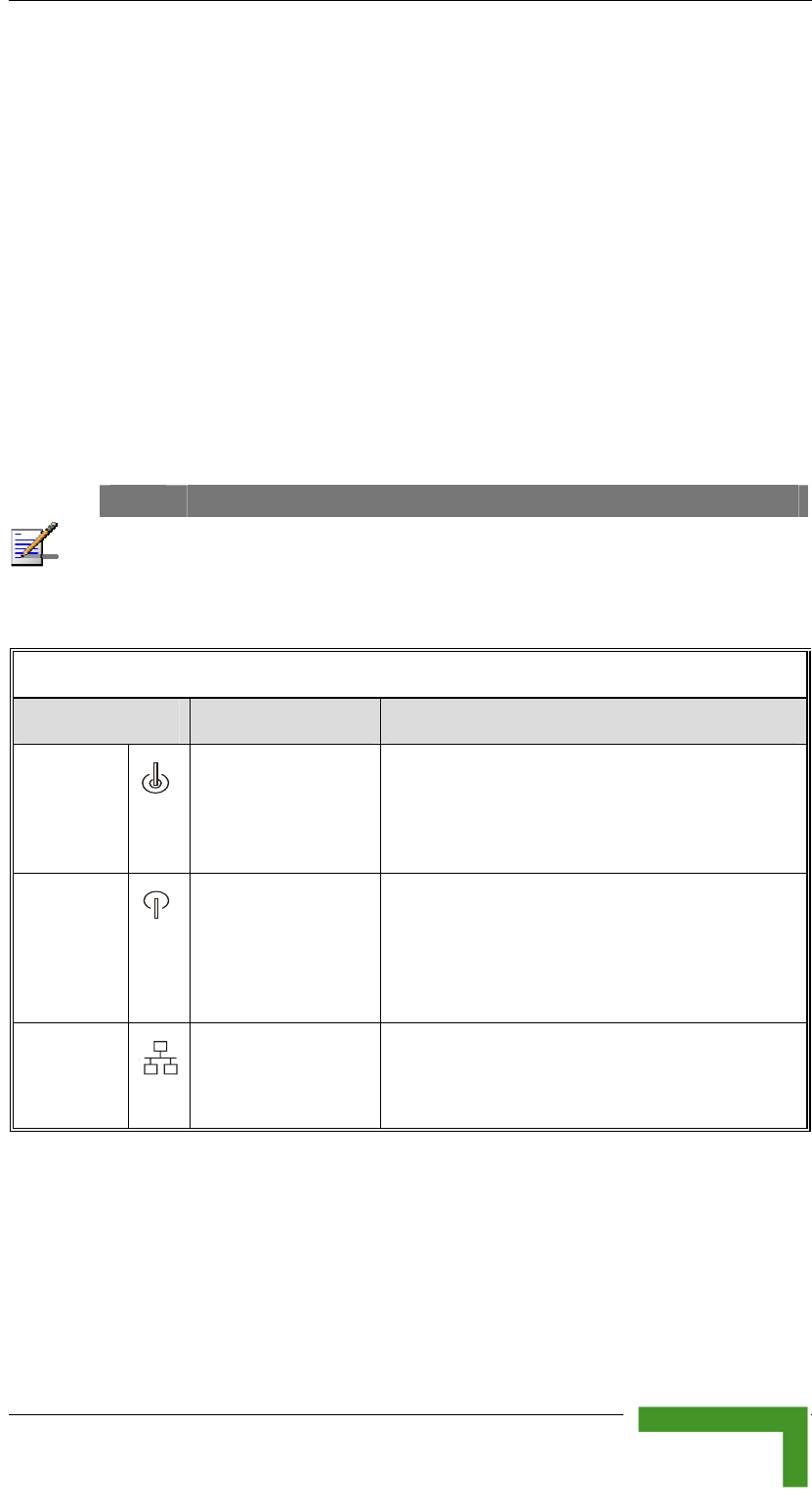
Operation Verification
Manual Revision 1.0
3-9
Operation Verification
The following sections describe how to verify the correct functioning of
the Outdoor Unit, Indoor Unit, Ethernet connection and data
connectivity.
Outdoor Unit Verification
To verify the correct operation of the Outdoor Unit, examine the LED
indicators located on the bottom panel of the outdoor unit.
The following tables list the provided LEDs and their associated
indications.
NOTE
Verifying the correct operation of the Outdoor Unit using the LEDs, as described below,
is only possible after the configuration and alignment processes are completed.
Table 3-3: AU-ODU LEDs
Name Description Functionality
W-LINK Wireless Link
Indictor
! Green – Unit is associated with one or more
SUs
! Blinking red – No associations
! Off – Wireless link disabled
Status Self-test and power
indication
! Green – Power is available and
self-test passed.
! Blinking Amber – Testing (not ready for
operation)
! Red – Self-test failed – fatal error
ETH Ethernet activity/
connectivity
indication
! Green –Ethernet link detected.
! Amber – No Ethernet connectivity between the
indoor and outdoor units.
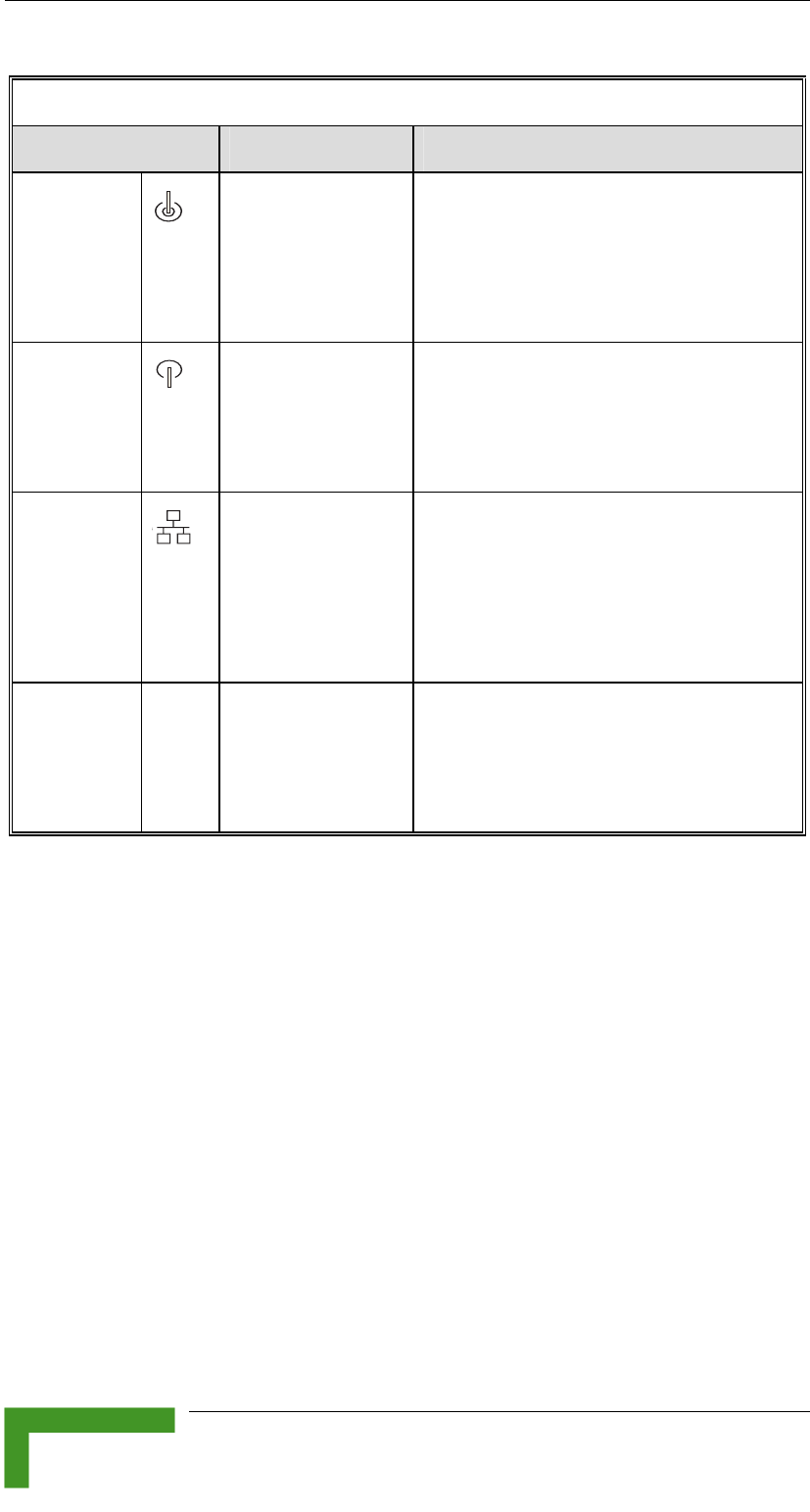
Chapter 3 - Commissioning
BreezeACCESSS VL System Manual
3-10
Table 3-4: SU-ODU LEDs
Name Description Functionality
W-LINK Wireless Link
Indictor
! Green – Unit is associated with an AU, no
wireless link activity
! Blinking Green – Data received or
transmitted on the wireless link. Blinking
rate is proportional to wireless traffic rate
! Off – Wireless link disabled
Status Self-test and power
indication
! Green – Power is available and
self-test passed.
! Blinking Amber – Testing (not ready for
operation)
! Red – Self-test failed – fatal error
ETH Ethernet activity/
connectivity
indication
! Green – Ethernet link between the indoor
and outdoor units is detected, no activity
! Blinking Green –Ethernet connectivity is
OK, with traffic on the port. Blinking rate
proportional to traffic rate.
! Red – No Ethernet connectivity between
the indoor and outdoor units.
SNR BAR
(SU-RA)
Received signal
strength Indication
! Red LED: Signal is too low (SNR<4dB)
! 8 green LEDs: Quality of the received
signal
! Orange LED: Signal is too high
(SNR>50dB)

Operation Verification
Manual Revision 1.0
3-11
Table 3-5: SU-ODU SNR Bar LED Functionality
SNR Bar LEDs SNR (typical)
LED 1 (red) is On Signal is too low (SNR < 4dB)
LED 2 (green) is On SNR > 4 dB
LEDs 2 to 3 (green) are On SNR > 8 dB
LEDs 2 to 4 (green) are On SNR > 13 dB
LEDs 2 to 5 (green) are On SNR > 19 dB
LEDs 2 to 6 (green) are On SNR > 26 dB
LEDs 2 to 7 (green) are On SNR > 31 dB
LEDs 2 to 8 (green) are On SNR > 38 dB
LEDs 2 to 9 (green) are On SNR > 44 dB
LEDs 2 to 9 (green) and 10 (orange) are On Signal is too high (SNR > 50 dB)

Chapter 3 - Commissioning
BreezeACCESSS VL System Manual
3-12
Indoor Unit Verification
To verify the correct operation of the indoor equipment, examine the
LED indicators located on the top panel of the SU IDU and AU IDU
units, or on the front panel of the BS-AU-VL module.
Table 3-6 provides similar information for the BS-AU IDU LEDs. Table
3-7 lists the LEDs of the PS1036 IDU and their associated indications.
Table 3-8 lists the LEDs of the PS1073 IDU.
Table 3-6: BS-AU LEDs
Name Description Functionality
W-LINK Wireless link activity ! Green - At least one SU is associated.
! Blinking Red - No SU is associated.
! Off - Wireless link disabled.
ODU CURRENT
CONSUMPTION
Current Consumption of
the Outdoor Unit
! Red - over current.
! Blinking Red - open circuit or below
anticipated current consumption.
! Green - within tolerance.
ODU STATUS Outdoor Unit Self-test ! Green - Self test passed and ODU ready
for operation.
! Blinking Amber - Testing (not ready for
operation)
! Red - fatal failure.
IDU PWR Power indication for the
Indoor Unit
! Green - IDU power OK.
! Off - no power is supplied to the IDU.
ALARM Indoor Unit Alarm
Indication
! Red - a fatal failure indication.
! Off - IDU is functioning properly.

Operation Verification
Manual Revision 1.0
3-13
Table 3-7: PS1036 SU IDU / AU-SA IDU LEDs
Name Description Functionality
POWER Power Indication
! Orange - 48VDC is present on the RADIO
port.
! Off - No power is supplied to the RADIO
port.
LINK Self test and end-to-
end Ethernet
connectivity
! Off – No Ethernet connectivity has been
detected between the outdoor unit and the
device connected to the indoor unit.
! Green– Self-test passed and Ethernet
connection confirmed by the outdoor unit
(Ethernet integrity check passed).
Table 3-8: PS1073 SU IDU / AU-SA IDU LEDs
Name Description Functionality
POWER Power Indication
! Green – IDU power is OK
! Off - No power or power failure
ETH Self test and end-to-
end Ethernet
connectivity
! Off – No Ethernet connectivity has been
detected between the outdoor unit and the
device connected to the indoor unit.
! Green– Self-test passed and Ethernet
connection confirmed by the outdoor unit
(Ethernet integrity check passed).
Verifying the Ethernet Connection
(Modular Base station)
Once you have connected the unit to an Ethernet outlet, verify that the
Ethernet Integrity Indicator, which is the yellow LED embedded in the
10/100 BaseT connector, is on. This indicates that the unit is
connected to an Ethernet segment. The Ethernet Activity Indicator,
which is the green embedded LED, should blink whenever the unit
receives or transmits traffic on the 10/100 BaseT port.

Chapter 3 - Commissioning
BreezeACCESSS VL System Manual
3-14
Verifying the Indoor-to-Outdoor
Connection (Modular Base Station)
Once you have connected the unit to an Ethernet outlet, verify that the
Ethernet Integrity Indicator, which is the yellow LED embedded in the
RADIO connector, is on. This indicates that the unit has detected an
Ethernet link connection. The Ethernet Activity Indicator, which is the
green embedded LED, should blink whenever the unit receives or
transmits traffic on the RADIO port.
Verifying Data Connectivity
To verify data connectivity, from the end-user’s PC or from a portable
PC connected to the unit, ping the Access Unit, or try to connect to the
Internet.
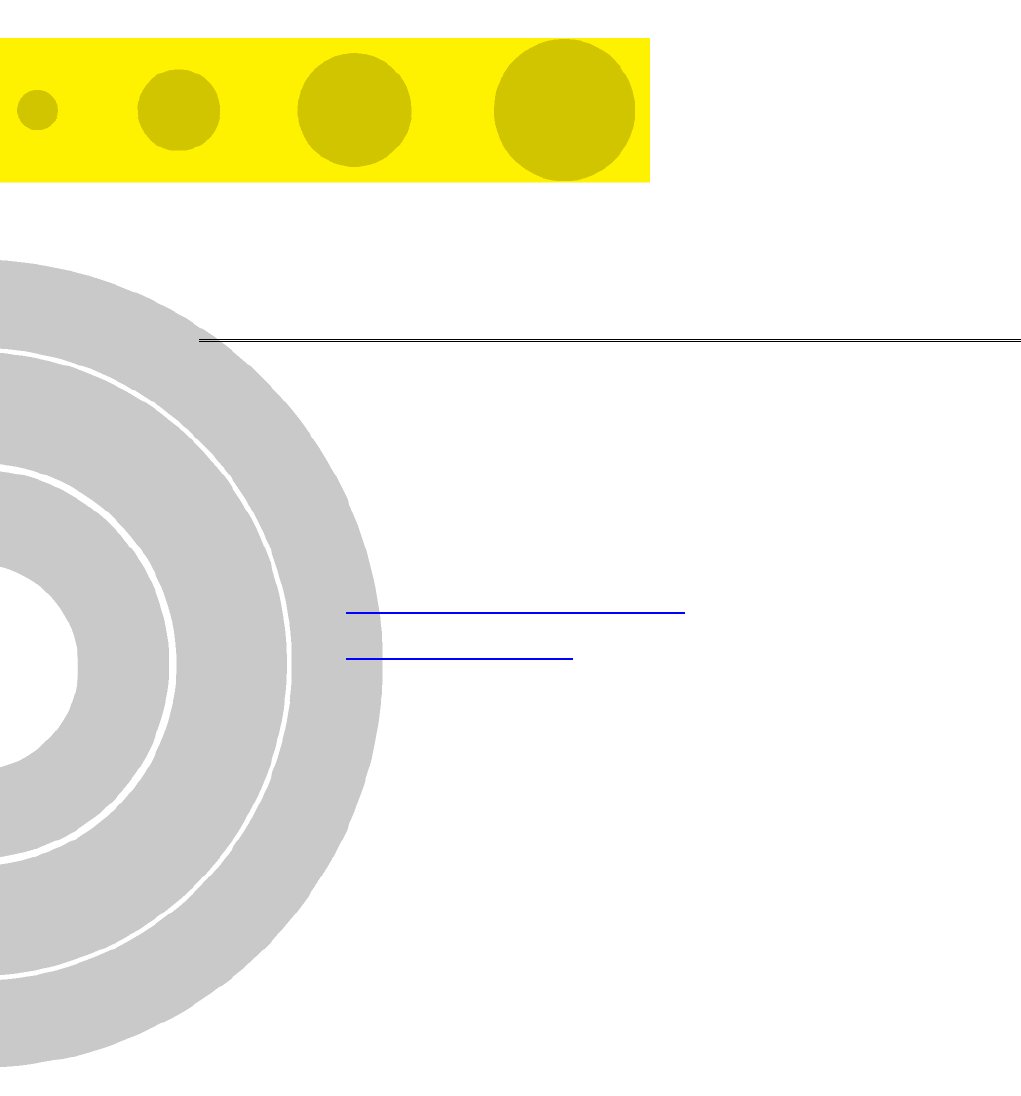
4
4
Chapter 4 - Operation and
Administration
In this Chapter
! Working with the Monitor Program, page 4-2
! Menus and Parameters, page 4-5
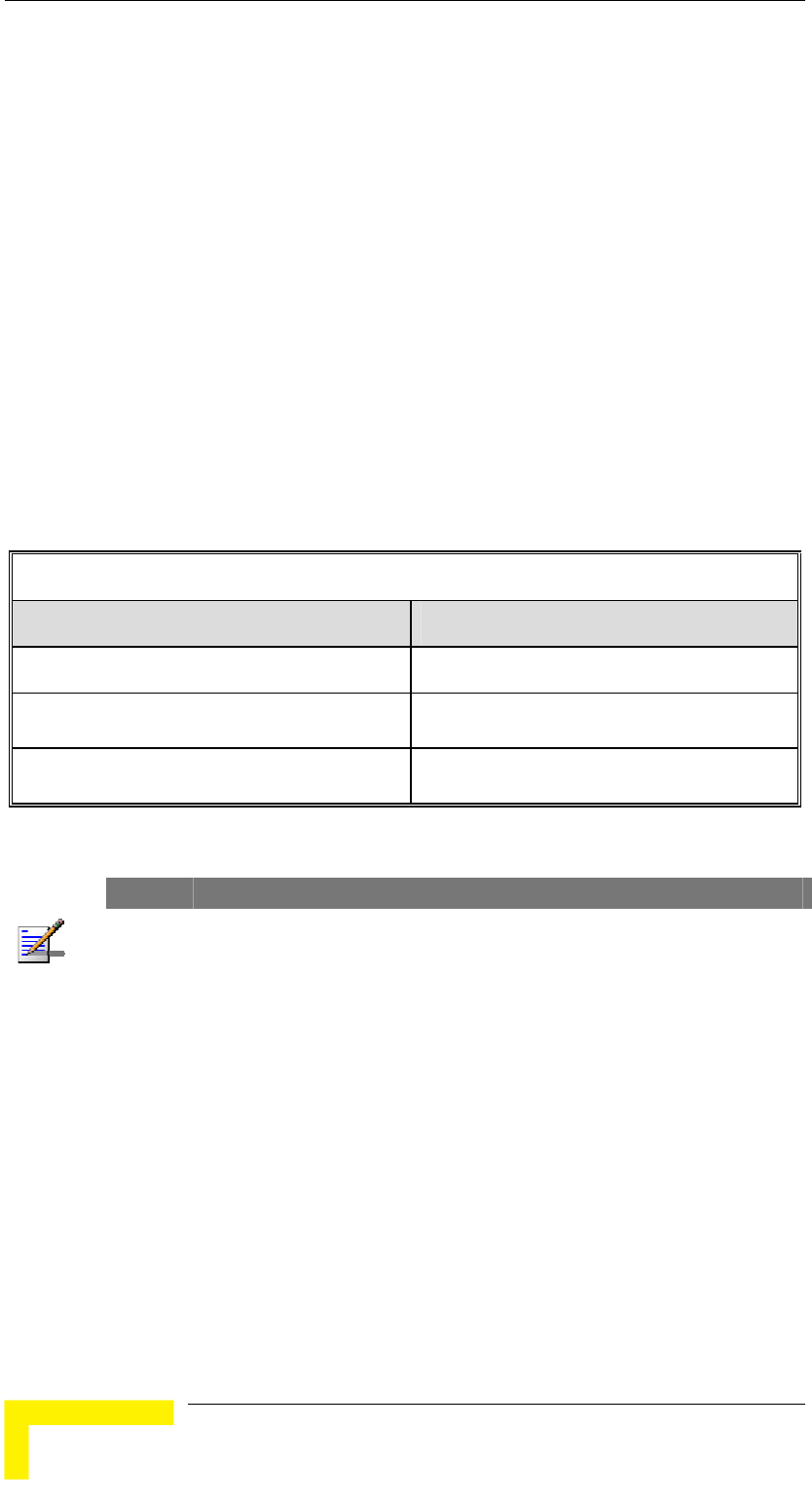
Chapter 4 - Operation and Administration
BreezeACCESSS VL System Manual
4-2
Working with the Monitor Program
Accessing the Monitor Program Using
Telnet
1. Connect a PC to the Ethernet port, using a crossed cable.
2. Configure the PC's IP parameters to enable connectivity with the
unit. The default IP address is 10.0.0.1.
3. Run the Telnet program. The Select Access Level menu is displayed.
4. Select the required access level, depending on your specific access
rights. A password entry request is displayed. Table 4-1 lists the
default passwords for each of the access levels.
Table 4-1: Default Passwords
Access Rights Password
Read-Only public
Installer user
Administrator private
NOTE
Following three unsuccessful login attempts (using incorrect passwords), the monitor
program is blocked for several minutes. To enable access to the monitor program during
that time, the unit must be reset via SNMP or by disconnecting/reconnecting power.
5. Enter your password and press Enter. The Main Menu is displayed
as shown in Figure 4-1: . The unit type, SW version number and SW
release date displayed in the Main Menu vary according to the
selected unit and SW version.
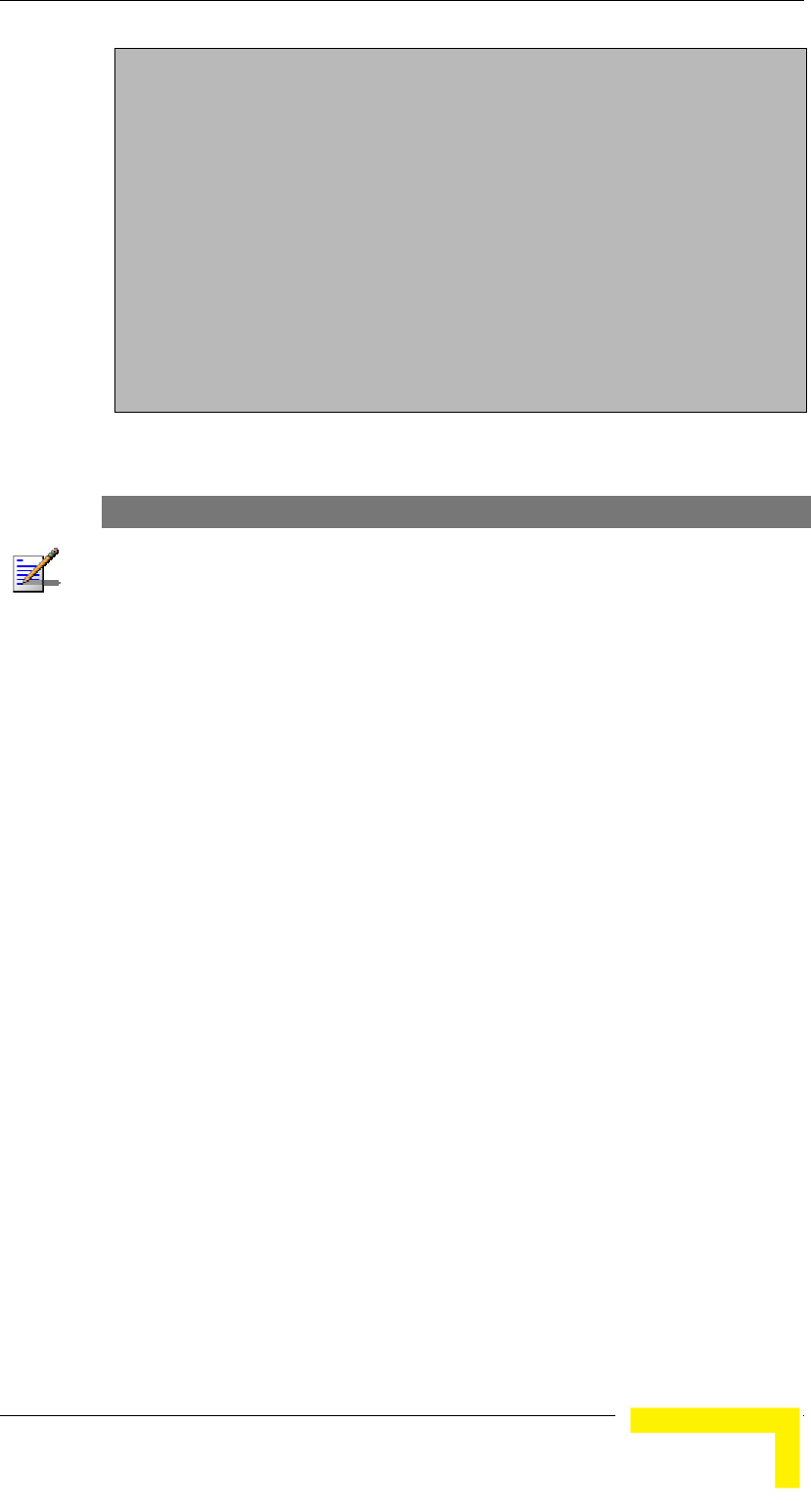
Working with the Monitor Program
Manual Revision 1.0
4-3
BreezeACCESS VL/AU
Official Release Version – 1.1.3
Release Date: Mon Jul 01 2003, 17:10:21
Main Menu
==========
1 – Info Screens
2 – Unit Control
3 - Basic Configuration
4 – Site Survey
5 - Advanced Configuration
x - Exit
>>>
Figure 4-1: Main Menu (Administrator Level)
NOTE
If the Telnet session is not terminated properly; for example, if you simply close the
window, the monitor program is blocked for several minutes. To enable access to the
monitor program during that time, the unit must be reset via SNMP or by
disconnecting/reconnecting power.
The appearance of the Main Menu varies depending on the user's access
level, as follows.
! For users with read only access rights, only the Info Screens option
is displayed. Users with this access level are not able to access the
Unit Control, Basic Configuration, Site Survey and Advanced
Configuration menus.
! For users with Installer access rights, the first four menu items, Info
Screens, Unit Control, Basic Configuration and Site Survey, are
displayed. Users with this access level are not able to access the
Advanced Configuration menu.
! For users with Administrator access rights, the full Main Menu is
displayed. These users can access all the menu items.

Chapter 4 - Operation and Administration
BreezeACCESSS VL System Manual
4-4
Common Operations
The following describes the standard operations that are used when
working with the Monitor program.
! Type an option number to open or activate the option. In certain
cases you may need to click Enter.
! Click Esc to exit a menu or option.
NOTE
The program is automatically terminated following a determined period of inactivity. The
default time out is 5 minutes and is configured with the Log Out Timer parameter.
In some cases, to activate any configuration changes, you must reset
the unit. Certain settings are automatically activated without the need
to reset the unit. Refer to Appendix E - Parameters Summary for
information on which parameters are run time configurable, which
means that the unit need not be reset for the parameter to take effect,
and which parameters do require that the unit be reset.

Menus and Parameters
Manual Revision 1.0
4-5
Menus and Parameters
The following sections describe the menus and parameters provided by
the Monitor program.
Main Menu
The Main Menu enables you to access the following menus, depending
on your access level, as described in Working with the Monitor Program,
on page 4-2.
! Info Screens: Provides a read only display of current parameter
values. Available at all access levels.
! Unit Control: Enables you to access general operations, such as
resetting the unit, reverting to factory default parameters, changing
passwords and switching between software versions. Available at the
Installer and Administrator access levels.
! Basic Configuration: Enables you to access the set of parameters
that are configured during the installation process. These
parameters are also available in the Advanced Configuration menu.
Available at the Installer and Administrator access levels.
! Site Survey: Enables you to activate certain tests and view various
system counters. Available at the Installer and Administrator access
levels.
! Advanced Configuration: Enables you to access all system
parameters, including the Basic Configuration parameters. Available
only at the Administrator access level.
Info Screens Menu
The Info Screens menu enables you to view the current values of
various parameter sets. The parameter sets are identical to the main
parameter groups in the configuration menus. You can view a specific
parameter set or choose to view all parameters at once. While this menu
is available at all access levels, some security related parameters
including the encryption Keys, ESSID and Operator ESSID are only
displayed to users with Administrator access rights.

Chapter 4 - Operation and Administration
BreezeACCESSS VL System Manual
4-6
The Info Screens menu includes the following options:
! Show Unit Status
! Show Basic Configuration
! Show Advanced Configuration
! Show Country Dependent Parameters
! Show All Parameters
Show Unit Status
The Show Unit Status menu is a read only menu that displays the
current values of the following parameters:
! Unit Name: As defined in Unit Control menu.
! Unit Type: Identifies the unit's function: AU-BS (a modular access
unit), AU-SA (a stand-alone access unit), SU-3-1D (subscriber unit
that supports a gross CPE rate of 3 Mbps and a single Ethernet
device), SU-6-1D (subscriber unit that supports a gross CPE rate of
6 Mbps and a single Ethernet device), SU-6-BD (subscriber unit that
supports a gross CPE rate of 6 Mbps and a full LAN), or SU-54-BD
(subscriber unit that supports a gross CPE rate of 54 Mbps and a
full LAN).
! Unit MAC Address: The unit's unique IEEE MAC address.
! Current Number of Associations (AU only): The total number of
SUs associated with this AU. This number may include units that
are not currently active since there is no aging algorithm for
associated SUs.
NOTE
An SU is only removed from the list of associated SUs under the following conditions:
a. A SNAP frame is received from another AU indicating that the SU is now associated
with the other AU.
b. The SU failed to respond to a certain number of consecutive frames transmitted by
the AU and is considered to have "aged out".
! Number of Associations Since Last Reset: In SUs - displays the
total number of associations with any AU since the last reset,
including duplicate associations with the same AU. In AUs -
displays the number of SUs that have associated with the AU since
the last reset, including duplicate associations with the same SU.
! Unit Status (SU only): The current status of the SU. There are two
status options:

Menus and Parameters
Manual Revision 1.0
4-7
# SCANNING: The SU is searching for an AU with which to
associate. If the DFS Option is enabled and the SU is currently
looking for its previous AU, the AU’s MAC Address will be
displayed.
# ASSOCIATED: The SU is associated with an AU.
! AU MAC Address (SU only): The MAC address of the AU with which
the unit is currently associated. If the unit is not associated with
any AU, the address defaults to the IEEE broadcast address, which
is FF-FF-FF-FF-FF-FF.
! Unit Hardware Version: The version of the outdoor unit hardware.
! Unit BOOT Version: The version of the BOOT SW
! Time Since Last Reset
! Flash Versions:
# Running from: Shows whether the unit is running from the
Main or from the Shadow Version.
# Main Version File Name: The name of the compressed file (with
a “.bz” extension) of the version currently defined as the main
version.
# Main Version Number: The software version currently defined
as the main version.
# Shadow Version File Name: The name of the compressed file
(with a “.bz” extension) of the version currently defined as the
shadow (backup) version.
# Shadow Version Number: The software version currently
defined as the shadow (backup) version.
! Radio Band: The radio band of the unit
! Log Out Timer: The value of the Log Out Timer as defined in Unit
Control menu.
! Ethernet Port Negotiation Mode: The Ethernet port negotiation
mode as defined in Unit Control menu.
! Ethernet Port State: The actual state of the Ethernet port.

Chapter 4 - Operation and Administration
BreezeACCESSS VL System Manual
4-8
! FTP Parameters: General FTP parameters (common to SW Version
Download, Configuration File Upload/Download and Event File
Upload using FTP):
# FTP Client IP Address
# FTP Client IP Mask
# FTP Server IP Address
# FTP Gateway IP Address
# FTP User Name
# FTP Password
! FTP Software Download Parameters: The parameters for SW
download using FTP, as defined in Unit Control menu.
# FTP Source Directory
# FTP SW Version File Name
! Configuration File Download/Upload Parameters: The parameters
for Configuration file upload/download using FTP, as defined in
Unit Control menu.
# Configuration File Name
# Configuration File Source Directory
# Operator Defaults File Name
! FTP Log File Upload Parameters: The parameters for Event Log file
upload using FTP, as defined in Unit Control menu.
# FTP Log File Name
# FTP Log File Destination Directory
! Event Log Policy
Show Basic Configuration
The Show Basic Configuration menu is a read only menu that displays
the current values of the parameters included in the Basic
Configuration menu.

Menus and Parameters
Manual Revision 1.0
4-9
Show Advanced Configuration
The Show Advanced Configuration menu enables you to access the read
only sub menus that display the current values of the parameters
included in the applicable sub menus of the Advanced Configuration
menu.
Show Country Dependent Parameters
Each country has its radio regulation regarding transmissions in the
applicable bands that affect parameters such as available frequencies,
bandwidth, transmit power, etc. Some other parameters and options
may also vary among countries. For each country, one or more sets of
parameters are pre-configured in the factory. If more than one set is
available, the set to be used can be selected. The Show Country
Dependent Parameters displays the available set(s) of these parameters,
and includes the following:
! Country Code: The up to 3 digits country code according to ISO
3166 and the country name. Some regulatory requirements apply to
more than one country. In these cases the Country Code includes a
4 digits proprietary group code and the Country Group name (for
example FCC).
For each of the available sets (Sub Bands), the following information is
provided:
! Sub Band ID and Frequencies
! Allowed Bandwidth: If more than one bandwidth is allowed, than
each bandwidth is associated with a different sub-band, since the
bandwidth may affect the available frequencies.. Currently only a
bandwidth of 20 MHz is supported.
! Max Tx Power: The maximum transmit power allowed at the
antenna port of the unit.
! Max EIRP: The maximum allowed EIRP (Effective Isotropic Radiated
Power).
! Min Modulation Level: The lowest allowed modulation level
! Max Modulation Level: The highest allowed modulation level
! Burst Mode: Indicates whether Burst Mode operation is allowed.
! Maximum Burst Duration: If Burst Mode is allowed, this parameter
displays the upper limit for the Maximum Burst Duration.

Chapter 4 - Operation and Administration
BreezeACCESSS VL System Manual
4-10
! DFS Option: Indicates whether the DFS (Dynamic Frequency
Selection) mechanism for identification and avoidance of channels
with radar activity is supported.
! Authentication Encryption: Indicates whether encryption of the
authentication process (Shared Key mode) is supported.
! Data Encryption: Indicates whether data encryption is supported.
! AES Algorithm: Indicates whether the use of AES for encryption of
authentication and/or data is supported.
New Country Code files can be uploaded remotely using TFTP (see
Appendix B - File Download and Upload Using TFTP).
Show All Parameters
The Show All Parameters menu is a read only menu that displays the
current values of all status and configuration parameters.
NOTE
The values of some security related parameters, including the encryption Keys, ESSID
and Operator ESSID, are available only with Administrator access rights.

Menus and Parameters
Manual Revision 1.0
4-11
Unit Control Menu
The Unit Control menu enables configuring control parameters for the
unit. The Unit Control menu includes the following options:
! Reset Unit
! Default Settings
! Change Unit Name
! Change Password
! Flash Memory Control
! SW Version Download
! Configuration File Upload/Download
! Log Out Timer
! Ethernet Port Negotiation Mode
! Change System Location
! Event Log Menu
! Feature Upgrade
Reset Unit
The Reset Unit option enables resetting the unit. After reset, any
modifications made to the system parameters are applied.
Default Settings
The Set defaults submenu enables resetting the system parameters to a
predefined set of default or saving the current configuration as the set
of Operator Defaults.
The Default Setting options are available only to users with
Administrator access rights.
The available options are:
! Set Defaults
! Save Current Configuration As Operator Defaults

Chapter 4 - Operation and Administration
BreezeACCESSS VL System Manual
4-12
Set Defaults:
The Set Defaults submenu enables reverting the system parameters to a
predefined set of defaults. There are two sets of default configurations:
A. Factory Defaults: This is the standard default configuration.
B. Operator Defaults: Operator Defaults configuration can be defined
by the Administrator using the Save Current Configuration As
Operator Defaults option in this menu. It may also be defined at the
factory according to specific operator's definition. The default
Operator Defaults configuration is the Factory Defaults
configuration.
The current configuration file and the Operator Defaults configuration
file can be uploaded/downloaded by the unit using FTP. For more
information, see Configuration File Upload/Download option on
page 4-18. These files can also be uploaded/downloaded remotely using
TFTP (see Appendix B - File Download and Upload Using TFTP).
The available options in the Set Defaults submenu are:
! Set Complete Factory Defaults
! Set Partial Factory defaults
! Set Complete Operator Defaults
! Set Partial Operator defaults
! Cancel Current Pending Request
Set Complete Factory Defaults
Select this option to reset the unit to the standard Factory Defaults
configuration, excluding several parameters that are listed in Table 4-2.
Table 4-2: Parameters not reset after Set Complete Factory/Operator Defaults
Parameters Group Parameter
All Passwords
FTP Server IP address
FTP Gateway IP address
FTP Client IP address
FTP Client IP Mask
Unit Control Parameters
FTP User Name
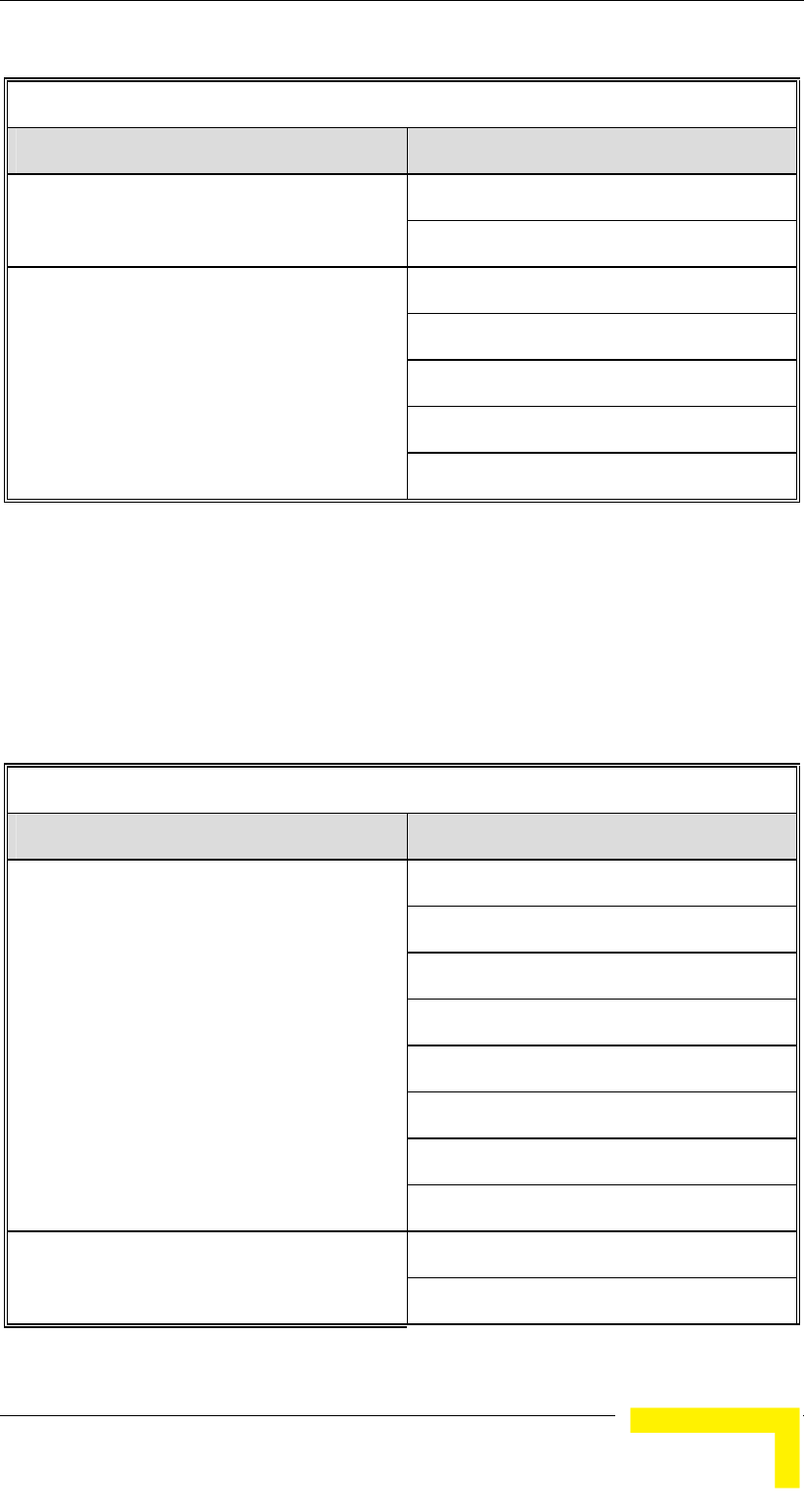
Menus and Parameters
Manual Revision 1.0
4-13
Table 4-2: Parameters not reset after Set Complete Factory/Operator Defaults
Parameters Group Parameter
FTP Password
Ethernet Port Negotiation Mode
Selected Sub Band
Frequency (AU)
DFS Option (AU)
Frequency Subset (AU)
Air Interface Parameters
Antenna Gain (AU)
Set Partial Factory defaults
Select this option to reset the unit to the standard Factory Default
configuration, excluding the parameters that are required to maintain
connectivity and management access. The parameters that do not
change after Set Partial Factory Defaults are listed in Table 4-3.
Table 4-3: Parameters that are not reset after Set Partial Factory/Operator Defaults
Parameters Group Parameter
Passwords
Ethernet Port Negotiation Mode
FTP Server IP address
FTP Gateway IP address
FTP Client IP address
FTP Client IP Mask
FTP User Name
Unit Control parameters
FTP Password
IP Address IP Parameters
Subnet Mask
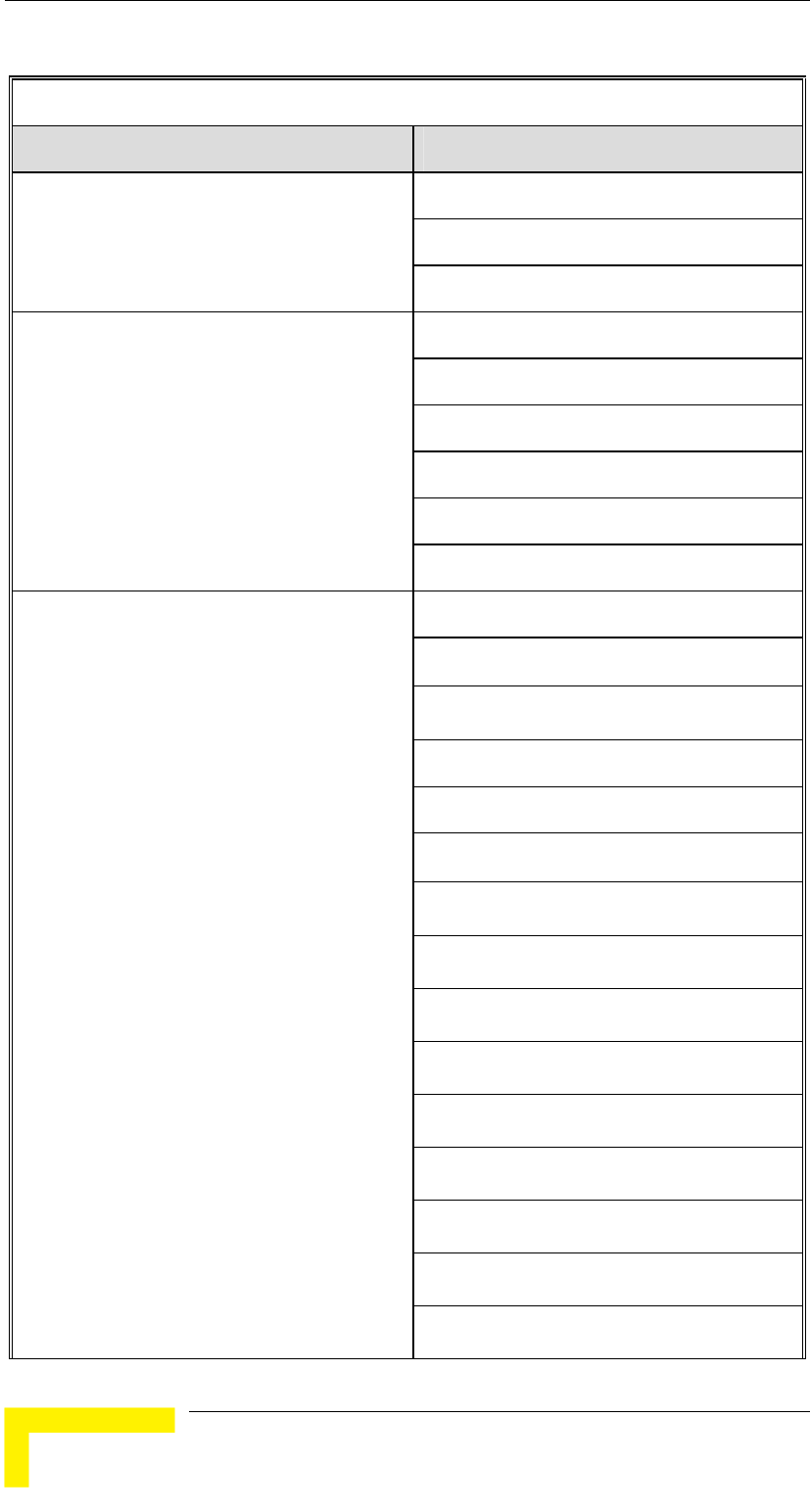
Chapter 4 - Operation and Administration
BreezeACCESSS VL System Manual
4-14
Table 4-3: Parameters that are not reset after Set Partial Factory/Operator Defaults
Parameters Group Parameter
Default Gateway Address
DHCP Option
Access to DHCP
Authentication Algorithm
Default Key (SU)
Data Encryption Mode
Default Multicast Key (AU)
Security Mode
Security Parameters
Key # 1 to Key # 4
ESSID
Operator ESSID Option (AU)
Operator ESSID (AU)
Cell Distance Mode (AU)
Maximum Cell Distance (AU)
SU Waiting Option (AU)
Selected Sub Band
Frequency (AU)
DFS Option (AU)
Frequency Subset
SU Waiting Option (AU)
ATPC Option (AU)
Transmit Power
Best AU Support (SU)
Air Interface Parameters
Preferred AU MAC Address (SU)
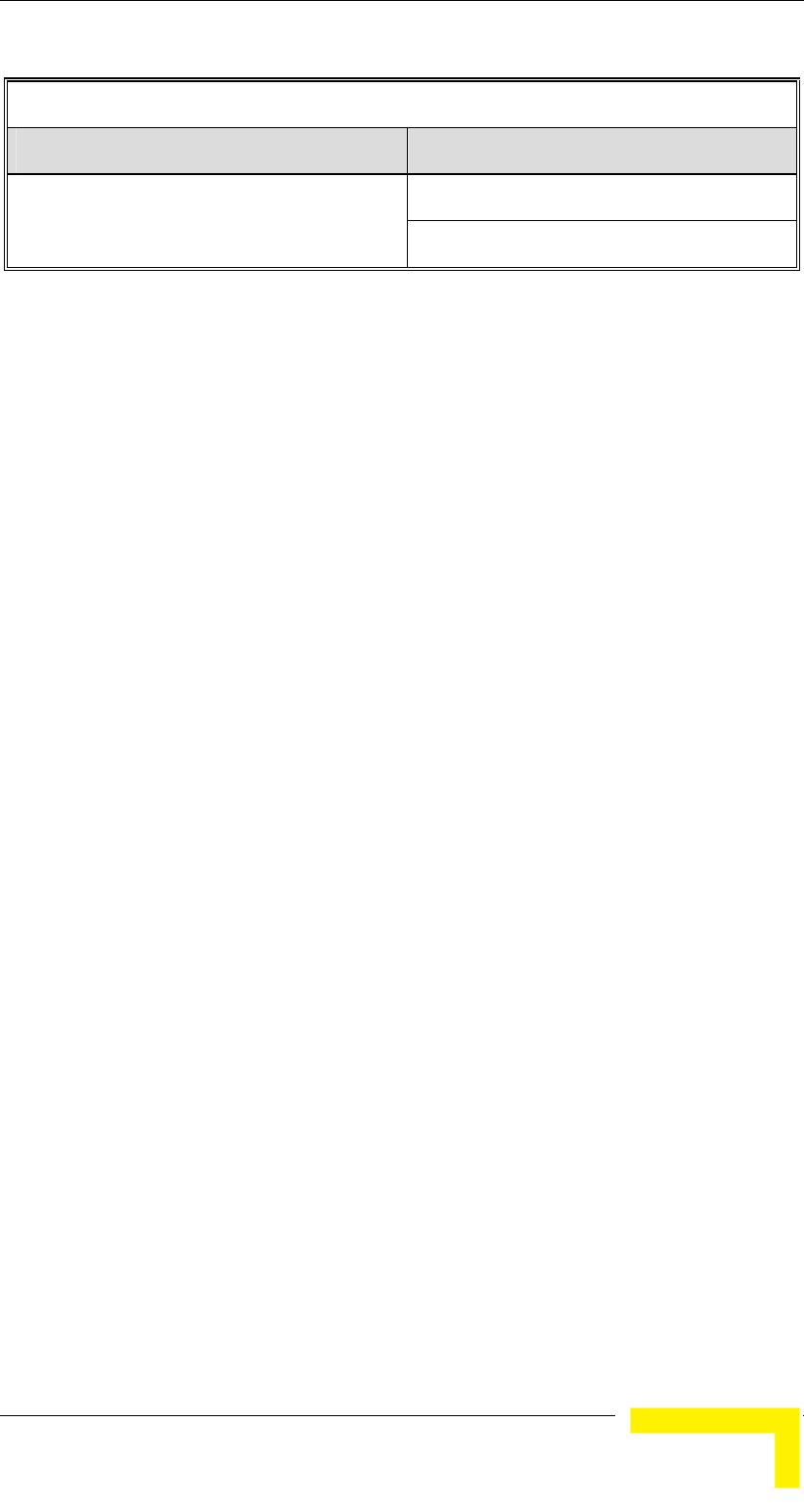
Menus and Parameters
Manual Revision 1.0
4-15
Table 4-3: Parameters that are not reset after Set Partial Factory/Operator Defaults
Parameters Group Parameter
VLAN ID – Management Bridge Parameters
MAC Address Deny List (AU)
Set Complete Operators Defaults
Select this option to reset the unit to the Operator Defaults
configuration, excluding several parameters that are listed in Table 4-2.
Set Partial Operator defaults
Select this option to reset the unit to the Operator Defaults
configuration, excluding the parameters that are required to maintain
connectivity and management access. The parameters that do not
change after Set Partial Operator Defaults are listed in Table 4-3.
Cancel Current Pending Request
Once you selected one of the Set defaults options, it will be executed
after the next reset. This option enables you to regret and cancel the
pending request before execution (provided the unit has not been reset
yet).
Save Current Configuration As Operator Defaults
The Save Current Configuration As Operator Defaults enables defining
the current configuration of the unit as the Operator Defaults
configuration.
Change Unit Name
The Change Unit Name option enables changing the name of the unit,
which is also the system's name in the MIB2. The name of the unit is
also used as the prompt at the bottom of each Monitor window.
Valid values: A string of up to 32 printable ASCII characters.
The default unit name is an empty string.
Change Password
The Change Password submenu enables changing the access
password(s). The Change Password submenu is available only to users
with Administrator access rights.

Chapter 4 - Operation and Administration
BreezeACCESSS VL System Manual
4-16
Valid values: A string of up to 8 printable ASCII characters.
Refer to Working with the Monitor Program, on page 4-2 for a list of the
default passwords for each of the access levels.
Flash Memory Control
The Flash Memory Control submenu enables selecting the active
software version for the unit.
The flash memory can store two software versions. One version is called
Main and the other is called Shadow. New software versions are loaded
as the shadow version. You can select the shadow version as the new
active version by selecting Reset and Boot from Shadow Version.
However, after the next reset, the main version is re-activated. To
continue using the currently active version after the next reset, select
Use Running Version After Reset: The previous shadow version will be
the new main version, and vice versa.
The parameters configured in the unit are not changed as a result of
loading new software versions unless the new version includes
additional parameters or additional changes in the list of parameters.
New parameters are loaded with their default values.
Select from the following options:
! Reset and Boot from Shadow Version: Activates the shadow
(backup) software version. The unit is reset automatically. Following
the next reset the unit will switch to the main version.
! Use Running Version After Reset: Defines the current running
version as the new main version. This version will also be used
following the next reset.
SW Version Download
The SW Version Download submenu enables the optional downloading
of a SW Version file from a remote FTP server. The SW Version
Download submenu includes the following options:
! Execute FTP GET SW Version: The Execute FTP GET SW Version
option executes the SW Version FTP download according to the
parameters defined below.
! FTP SW Source Dir: The FTP SW Source Dir option enables
defining the source directory of the SW version file.
Valid values: A string of up to 80 printable ASCII characters. To
clear the field press "."

Menus and Parameters
Manual Revision 1.0
4-17
The default is an empty string.
! FTP SW Version File Name: The FTP SW Version File Name option
enables defining the name of the SW version file in the FTP server.
Valid values: A string of up to 20 printable ASCII characters. An
empty string is not allowed.
The default is VxWorks.bz.
! FTP Client IP Address: The FTP Client IP Address option enables
defining the IP address of the FTP client in the unit. This secondary
IP address is required only to support the optional FTP process.
The default is: 1.1.1.3
! FTP Client IP Mask: The FTP Client IP Mask option enables
defining the IP Mask for the FTP client mask in the unit.
The default is: 255.255.255.0
! FTP Server IP Address: The FTP Server IP Address option enables
defining the IP address of the FTP server that is hosting the SW
Version file.
The default is: 1.1.1.4
! FTP Gateway IP Address: The FTP Gateway IP Address option
enables defining the FTP default gateway address.
The default is: 0.0.0.0.
! FTP User Name: The FTP User Name option enables defining the
user name to be used for accessing the FTP server that is hosting
the SW Version file.
Valid values: A string of up to 18 printable ASCII characters.
The default is: vx
! FTP Password: The FTP Password option enables defining the
password to be used for accessing the FTP server that is hosting the
SW Version file.
Valid values: A string of up to 18 printable ASCII characters.
The default is: vx
! Show SW Version Download Parameters and Status: Displays the
current values of the SW Version Download parameters, the current
SW version and the SW versions stored in the Flash memory.

Chapter 4 - Operation and Administration
BreezeACCESSS VL System Manual
4-18
NOTE
There is one set of general FTP parameters (FTP Server IP Address, FTP Gateway
IP Address, FTP Client IP Address, FTP Client IP Mask, FTP User Name and FTP
Password). This set (or relevant parts of the set) serves the SW Download Procedure,
the Configuration File Upload/Download procedure and the Event Log File Upload
procedure. Changing any of these parameters in the menu for either procedure will
automatically change its value in the menu for the other procedures.
Configuration File Upload/Download
The Configuration File Upload/Download submenu enables the optional
uploading or downloading of a configuration or an Operator Defaults file
from a remote FTP server. The Configuration File Upload/Download
submenu includes the following options:
! Execute FTP GET/PUT Configuration File: The Execute FTP
GET/PUT Configuration File executes the upload/download of a
Configuration file or an Operator Defaults file according to the
parameters defined below. The following options are available:
# Execute FTP Get Configuration File (cfg)
# Execute FTP Put Configuration File (cfg)
# Execute FTP Get Operator Defaults File (cmr)
# Execute FTP Put Operator Defaults File (cmr)
! FTP Configuration File Source Dir: The FTP Configuration File
Source Dir option enables defining the source directory of the
configuration/Operator Defaults file.
Valid values: A string of up to 80 printable ASCII characters. To
clear the field press "."
The default is an empty string.
! Configuration File FTP File Name: The Configuration File FTP File
Name option enables defining the name of the configuration file to
be uploaded/downloaded.
Valid values: A string of up to 20 printable ASCII characters. An
empty string is not allowed.
The default is config.cfg.
! Operator Defaults FTP File Name: The Operator Defaults File
Name option enables defining the name of the Operator Defaults file
to be uploaded/downloaded.
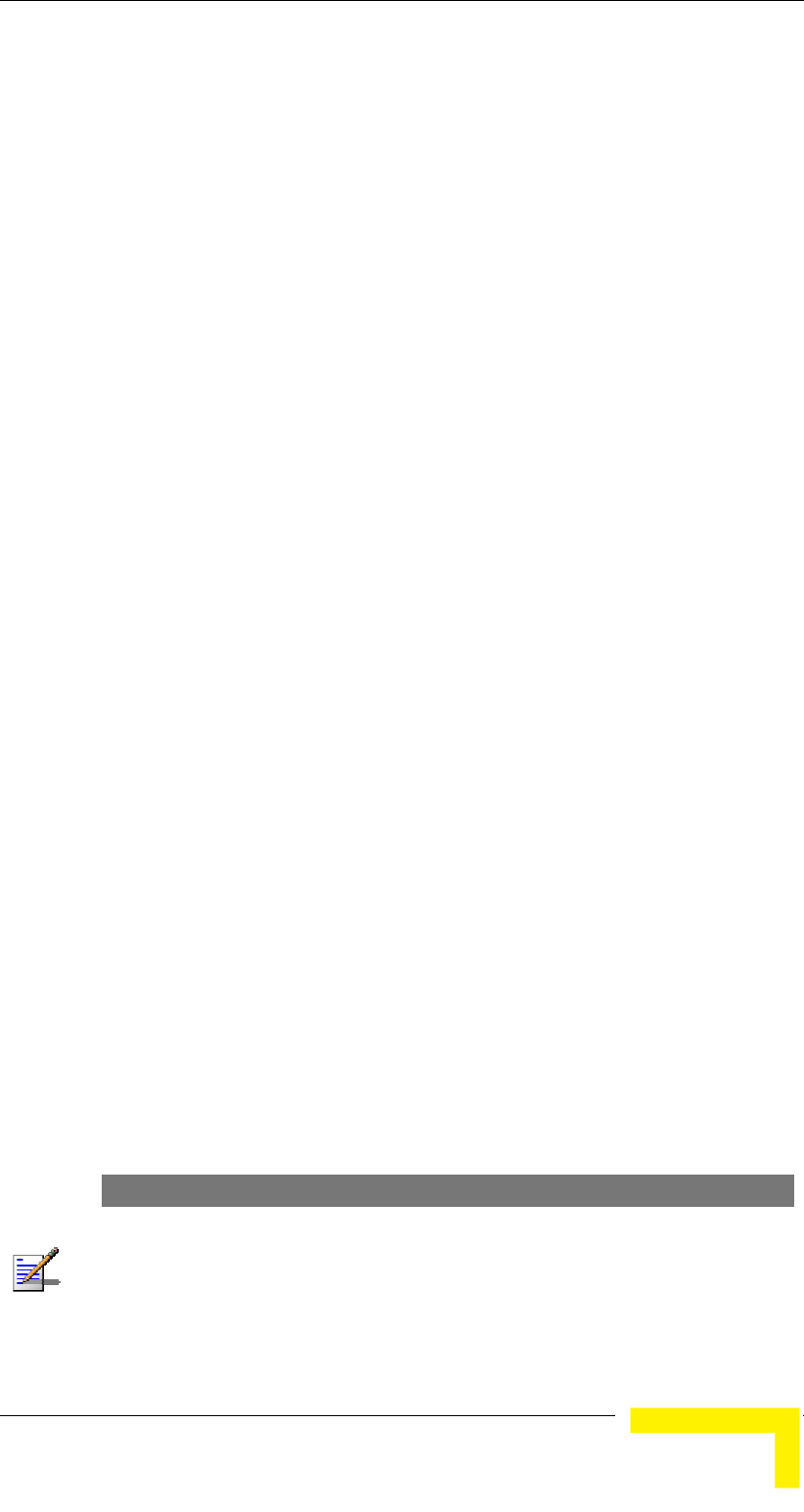
Menus and Parameters
Manual Revision 1.0
4-19
Valid values: A string of up to 20 printable ASCII characters. An
empty string is not allowed.
The default is operator.cmr.
! FTP Client IP Address: The FTP Client IP Address option enables
defining the IP address of the FTP client in the unit. This secondary
IP address is required only to support the optional FTP process.
The default is: 1.1.1.3
! FTP Client IP Mask: The FTP Client IP Mask option enables
defining the IP Mask for the FTP client mask in the unit.
The default is: 255.255.255.0
! FTP Server IP Address: The FTP Host IP Address option enables
defining the IP address of the FTP server that is hosting the file.
The default is: 1.1.1.4
! FTP Gateway IP Address: The FTP Gateway IP Address option
enables defining the FTP default gateway address.
The default is: 0.0.0.0.
! FTP User Name: The FTP User Name option enables defining the
user name to be used for accessing the FTP server that is hosting
the file.
Valid values: A string of up to 18 printable ASCII characters.
The default is: vx
! FTP Password: The FTP Password option enables defining the
password to be used for accessing the FTP server that is hosting the
file.
Valid values: A string of up to 18 printable ASCII characters.
The default is: vx
! Show Configuration File Upload/Download Parameters: Displays
the current values of the Configuration File Upload/Download
parameters.
NOTE
There is one set of general FTP parameters (FTP Server IP Address, FTP Gateway
IP Address, FTP Client IP Address, FTP Client IP Mask, FTP User Name and FTP
Password). This set (or relevant parts of the set) serves the SW Download Procedure,
the Configuration File Upload/Download procedure and the Event Log File Upload
procedure. Changing any of these parameters in the menu for either procedure will
automatically change its value in the menu for the other procedures.

Chapter 4 - Operation and Administration
BreezeACCESSS VL System Manual
4-20
Log Out Timer
The Log Out Timer parameter determines the amount of inactive time
following which the unit automatically exits the Monitor program.
The time out duration can range from 1 to 999 minutes.
The default value is 5 minutes.
Ethernet Port Negotiation Mode
The Ethernet Port Negotiation Mode submenu displays the current
Ethernet port state and enables defining the negotiation mode of the
Ethernet port. The available options are:
! Force 10 Mbps and Half-Duplex
! Force 10 Mbps and Full-Duplex
! Force 100 Mbps and Half-Duplex
! Force 100 Mbps and Full-Duplex
! Auto Negotiation (10/100 Mbps and Half/Full Duplex)
The default is Auto Negotiation (10/100 Mbps and Half/Full Duplex)
Change System Location
The Change System Location option enables changing the system
location of the unit, which is also the sys location in MIB2. The System
Location is also displayed as a part of the Monitor menu’s header.
Valid values: A string of up to 35 printable ASCII characters.
The default system location is an empty string.

Menus and Parameters
Manual Revision 1.0
4-21
Event Log Menu
The Event Log Menu enables controlling the event log feature. The event
log is an important debugging tool and a flash memory sector is
dedicated for storing it. Events are classified according to their severity
level: Message (lowest severity), Warning, Error or Fatal (highest
severity).
The severity at which events are saved in the Event Log is configurable.
Events from the configured severity and higher are saved and may be
displayed upon request. Log history can be displayed up to the full
number of current active events. In the log, an event is defined as active
as long as it has not been erased (a maximum of 1000 events may be
stored). The Event Log may be read using TFTP, with remote file name
<SNMP Read Community>.log (the default SNMP Read Community is
“public”). The Event Log may also be uploaded to a remote FTP server.
The Event Log Menu includes the following options:
! Event Log Policy
! Display Event Log
! Erase Event Log
! Event Load Upload
Event Log Policy
The Event Log Policy determines the minimal severity level. All events
whose severity is equal to or higher than the defined severity are logged.
Valid values are: Message (MSG) Level, Warning (WRN) Level, Error
(ERR) Level, Fatal (FTL) Level, Log None.
The default selection is Warning Level severity.
Display Event Log
The Display Event Log option enables viewing how many events are
logged and selecting the number of events to be displayed (up to 1000).
The display of each event includes the event time (elapsed time since
last reset), the severity level and a message string. The events are
displayed in descending order, with the most recent event displayed
first.
Erase Event Log
The Erase Event Log option enables clearing the event log.

Chapter 4 - Operation and Administration
BreezeACCESSS VL System Manual
4-22
Event Log Upload
The Event Log Upload submenu enables the optional uploading of the
event log file to a remote FTP server. The Event Log Upload submenu
includes the following options:
! FTP Event Log Upload Execute: The FTP event Log Upload Execute
executes the upload of the Event Log file according to the
parameters defined below.
! Event Log Destination Directory: The Event Log Destination
Directory enables defining the destination directory for the Event
Log File.
Valid values: A string of up to 80 printable ASCII characters. To
clear the field press "."
The default is an empty string.
! Event Log File Name: The Event Log File Name option enables
defining the name of the event log file to be uploaded.
Valid values: A string of up to 20 printable ASCII characters.
The default is logfile.log.
! FTP Server IP Address: The FTP Host IP Address option enables
defining the IP address of the FTP server that is hosting the file.
The default is: 1.1.1.4
! FTP Gateway IP Address: The FTP Gateway IP Address option
enables defining the FTP default gateway address.
The default is: 0.0.0.0.
! FTP User Name: The FTP User Name option enables defining the
user name to be used for accessing the FTP server that is hosting
the file.
Valid values: A string of up to 18 printable ASCII characters.
The default is: vx
! FTP Password: The FTP Password option enables defining the
password to be used for accessing the FTP server that is hosting the
file.
Valid values: A string of up to 18 printable ASCII characters.
The default is: vx
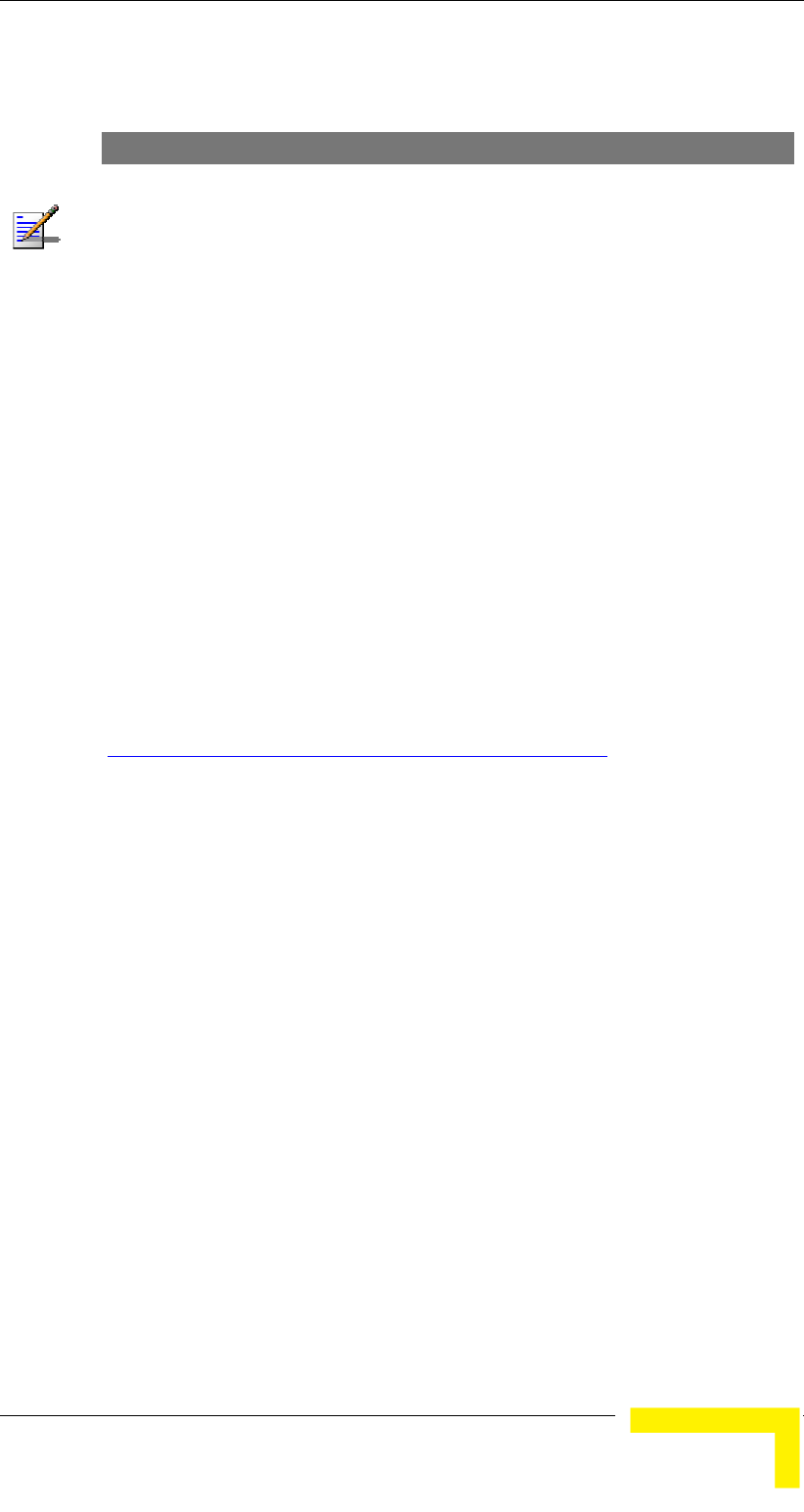
Menus and Parameters
Manual Revision 1.0
4-23
! Show FTP Event Log File Upload Parameters: Displays the
current values of the Event Log Upload parameters.
NOTE
There is one set of general FTP parameters (FTP Server IP Address, FTP Gateway
IP Address, FTP Client IP Address, FTP Client IP Mask, FTP User Name and FTP
Password). This set (or relevant parts of the set) serves the SW Download Procedure,
the Configuration File Upload/Download procedure and the Event Log File Upload
procedure. Changing any of these parameters in the menu for either procedure will
automatically change its value in the menu for the other procedures.
Feature Upgrade
The Feature Upgrade option enables to enter a license string for
upgrading the unit to support new features and/or options. Upon
selecting the Manual Feature Upgrade option the user will be requested
to enter the license string. Each license string is associated with a
unique MAC Address and one feature/option. If the encrypted MAC
Address in the license string does not match the unit’s MAC Address,
the string will be rejected. If there is a match, a message notifying of the
new feature/option will be displayed. The unit must be reset for the
change to take effect.
The license string should comprise 32 to 64 hexadecimal digits.
New Feature License files can be uploaded remotely using TFTP (see
Appendix B - File Download and Upload Using TFTP).

Chapter 4 - Operation and Administration
BreezeACCESSS VL System Manual
4-24
Basic Configuration Menu
The Basic Configuration menu includes all parameters required for the
initial installation and operation of the unit. Once the unit is properly
installed and operational, additional parameters can be configured
either locally or remotely using Telnet or SNMP management.
NOTE
All parameters in the Basic Configuration menu are also available in the relevant sub
menus of the Advanced Configuration menu.
The Basic Configuration menu enables to access the following
parameter sets:
IP Parameters
! IP Address
! Subnet Mask
! Default Gateway Address
! DHCP Client
# DHCP Option
# Access to DHCP
Refer to IP Parameters, on page 4-37, for a description of these
parameters.
Air Interface Parameters
! ESSID
! Operator ESSID Parameters (AU)
# Operator ESSID Option
# Operator ESSID
! Frequency Definition
# Select Sub Band (if more than one is available)
# Frequency (AU)
# Sub Band Definition
! Best AU Parameters (SU)
# Best AU Support

Menus and Parameters
Manual Revision 1.0
4-25
# Preferred AU MAC Address
! Cell distance Parameters
# Cell distance Mode (AU)
# Maximum Cell Distance (AU)
! ATPC
# ATPC Option
! Transmit Power parameters
! Maximum Transmit Power parameters (SU)
! Antenna Gain (AU)
Refer to Air Interface Parameters, on page 4-40, for a description of
these parameters.
Performance Parameters
! Maximum Modulation Level (SU)
Refer to Performance Parameters on page 4-76, for a description of
these parameters.
Bridge Parameters
! VLAN ID – Management
! MAC Address Deny List
Refer to Bridge Parameters, on page4-62, for a description of these
parameters.
Security Parameters
! Authentication Algorithm
! Data Encryption Option
! Security Mode
! Default Multicast Key (AU)
! Default Key (SU)
! Key 1 to Key 4
! Promiscuous Authentication (AU)

Chapter 4 - Operation and Administration
BreezeACCESSS VL System Manual
4-26
Some or all of the security parameters may not be available in units
that do not support the applicable features. Refer to Security
Parameters, on page 4-90, for a description of these parameters.

Menus and Parameters
Manual Revision 1.0
4-27
Site Survey Menu
The Site Survey menu displays the results of various tests and counters
for verifying the quality of the wireless link. These tests can be used to
help determine where to position the units for optimal coverage,
antenna alignment and troubleshooting. The counters can serve for
evaluating performance and identify potential problems. In the AU,
there is also an extensive database for all SUs served by it.
The Site Survey menu includes the following options:
! Traffic Statistics
! Ping Test
! Continuous Link Quality display (SU only)
! MAC Address Database
! Per Modulation Level Counters
Traffic Statistics
The traffic statistics are used to monitor, interpret and analyze the
performance of the wired and wireless links. The counters display
statistics relating to wireless link and Ethernet frames. The Traffic
Statistics menu includes the following options:
! Display Counters: Select this option to display the current value of
the Ethernet and wireless link (WLAN) counters.
! Reset Counters: Select this option to reset the counters.
Ethernet Counters
The unit receives Ethernet frames from its Ethernet port and forwards
the frames to its internal bridge, which determines whether each frame
should be transmitted to the wireless media. Frames discarded by the
unit's hardware filter are not counted by the Ethernet counters. The
maximum length of a regular IEEE 802.1 Ethernet frame that can be
accepted from the Ethernet port is 1518 bytes. For tagged IEEE 802.1Q
frames the maximum size is 1522 bytes.
The unit transmits valid data frames received from the wireless media to
the Ethernet port, as well as internally generated frames, such as
responses to management queries and pings received via the Ethernet
port. The Ethernet Counters include the following statistics:

Chapter 4 - Operation and Administration
BreezeACCESSS VL System Manual
4-28
! Total received frames via Ethernet: The total number of frames
received from the Ethernet port. This counter includes both invalid
frames (with errors) and valid frames (without errors).
! Transmitted wireless to Ethernet: The number of frames
transmitted by the unit to the Ethernet port. These are generally
frames received from the wireless side, but also include frames
generated by the unit itself.
WLAN Counters
The unit submits data frames received from the Ethernet port to the
internal bridge, as well as self generated control and wireless
management frames. After a unicast data frame is transmitted, the unit
waits for an acknowledgement (ACK) message from the receiving unit.
Some control and wireless management frames, as well as broadcast
and multicast frames sent to more than one unit, are not acknowledged.
If an ACK is not received after a predefined time, which is determined by
the Maximum Cell distance parameter, the unit retransmits the frame
until an ACK is received. If an ACK is not received before the number of
retransmissions has reached a maximum predefined number, which is
determined by the Number of HW Retries and Number of SW Retries
parameters, the frame is dropped.
The Wireless Link Counters include the following statistics:
! Total transmitted frames to wireless: The number of frames
transmitted to the wireless media. The total includes one count for
each successfully transmitted unicast frame (excluding
retransmissions), and the number of transmitted multicast and
broadcast frames, including control and wireless management
frames. In the AU, there are also separate counters for the following:
# Beacons (AU only)
# Management and Other Data frames, including successfully
transmitted unicast frames and multicast/broadcast data
frames (excluding retransmissions, excluding Beacons in AU)
! Total Transmitted Unicasts (AU only): The number of unicast
frames successfully transmitted to the wireless media, excluding
retransmissions. This count is useful for calculating the rates of
retransmissions or dropped frames, since only unicast frames are
retransmitted if not acknowledged.

Menus and Parameters
Manual Revision 1.0
4-29
! Total submitted frames (bridge): The total number of data frames
submitted to the internal bridge for transmission to the wireless
media. The count does not include control and wireless
management frames, or retransmissions. There are also separate
counts for each priority queue to which the frames were routed,
which are High, Mid and Low (currently the High queue is not used
for data frames).
! Frames dropped (too many retries): The number of dropped
frames, which are the frames unsuccessfully retransmitted until the
maximum permitted number of retransmissions without being
acknowledged. This count includes dropped data frames as well as
dropped control and wireless management frames.
! Total retransmitted frames: The total number of retransmissions,
including all unsuccessful transmissions and retransmissions.
! Total Tx events: The total number of transmit events. Typically,
transmission events include cases where transmission of a frame
was delayed or was aborted before completion. The following
additional counters are displayed to indicate the reason for and the
nature of the event:
# Dropped: The number of dropped frames, which are the frames
unsuccessfully retransmitted until the maximum permitted
number of retransmissions without being acknowledged.
# Delayed: The number of frames whose transmission was delayed
because they were in the queue for transmission when the SW
Retry mechanism was activated for a previous frame designated
to the same address. (refer to Adaptive Modulation Algorithm on
page 4-81 for more information)
# Underrun: The number of times that transmission of a frame
was aborted because the rate of submitting frames for
transmission exceeds the available transmission capability.
# Others: The number of frames whose transmission was not
completed or delayed due to a problem other than those
represented by the other counters.
! Total received frames from wireless: The total number of frames
received from the wireless media. The count includes data frames as
well as control and wireless management frames. The count does
not include bad frames and duplicate frames. For a description of
these frames, refer to Bad frames received and Duplicate frames
discarded below.

Chapter 4 - Operation and Administration
BreezeACCESSS VL System Manual
4-30
! Total received data frames: The total number of data data frames
received from the wireless media, including duplicate frames. Refer
to Duplicate frames discarded below.
! Total Rx events: The total number of frames that were not received
properly. The following additional counters are displayed to indicate
the reason for the failure:
# Phy: Applicable only when DFS is enabled. The number of
unidentified signals.
# CRC: The number of frames received from the wireless media
containing CRC errors.
# Overrun: The number of frames that were discarded because the
receive rate exceeded the processing capability or the capacity of
the Ethernet port.
# Decrypt: The number of frames that were not received properly
due to a problem in the data decryption mechanism.
! Bad fragments received: The number of fragments received from
the wireless media containing CRC errors.
! Duplicate frames discarded: The number of data frames discarded
because multiple copies were received. If an acknowledgement
message is not received by the originating unit, the same data frame
can be received more than once. Although duplicate frames are
included in all counters that include data frames, only the first copy
is forwarded to the Ethernet port.
! Internally discarded MIR\CIR: The number of data frames
received from the Ethernet port that were discarded by the MIR/CIR
mechanism to avoid exceeding the maximum permitted information
rate.
Ping Test
The Ping Test submenu is used to control pinging from the unit and
includes the following options:
! Destination IP Address: The destination IP address of the device
being pinged. The default IP address is 192.0.0.1.
! Number of Pings to Send: The number of ping attempts per
session. The available range is from 0 to 9999. The default value is
1. Select 0 for continuous pinging.
! Ping Frame Length: The ping packet size. The available range is
from 60 to 1472 bytes. The default value is 64 bytes.

Menus and Parameters
Manual Revision 1.0
4-31
! Ping Frame Timeout: The ping frame timeout, which is the amount
of time (in ms) between ping attempts. The available range is from
100 to 60,000 ms. The default value is 200 ms.
! Start Sending: Starts the transmission of ping frames.
! Stop Sending: Stops the transmission of ping frames. The test is
automatically ended once the number of pings has reached the
value specified in the No. of Pings parameter, described above. The
Stop Sending option can be used to end the test before completing
the specified number of pings, or if continuous pinging is selected.
! Show Ping Test Values: Displays the current values of the ping test
parameters, the transmission status, which means whether it is
currently sending or not sending pings, the number of pings sent,
and the number of pings received, which means the number of
acknowledged frames.
Continuous Link Quality Display (SU only)
The Continuous Link Quality Display option displays continuously
updated information regarding the average quality of the received signal
using Signal to Noise Ratio (SNR) measurements.
Click the Esc key to abort the test.
MAC Address Database
The MAC Address Database submenu includes the following options:
! MAC Address Database in AU
! MAC Address Database in SU
MAC Address Database in AU
The MAC Address Database option in the AU displays information
regarding the Subscriber Units associated with the AU, as well as
bridging (forwarding) information. The following options are available:
! Display Bridging and Association Info: The Display Bridging and
Association Info option displays a list of all the Subscriber Units and
stations in the AU's Forwarding Database. For stations behind an
SU, the SU's MAC address is also displayed (SU Address).
Each MAC address entry is followed by a description, which may
include the following:
# Et (Ethernet): An address learned from the Ethernet port.

Chapter 4 - Operation and Administration
BreezeACCESSS VL System Manual
4-32
# Vp (Virtual port): An address of a node behind an associated
SU. For these addresses, learned from the wireless port, the
address of the applicable SU is also displayed (in parenthesis).
# St (Static): An associated SU. For these entries, the SW version
of the SU is also displayed.
# Sp (Special): 7 addresses that are always present, which
include:
! The MAC address of the AU, which appears twice as it is
learned from both the Ethernet and wireless ports.
! The MAC address of the internal Operating System stack,
which also appears twice.
! Alvarion's Multicast address (01-20-D6-00-00-01, which also
appears twice. The system treats this address as a Broadcast
address.
! The Ethernet Broadcast address (FF-FF-FF-FF-FF-FF).
In addition, a summary table displays information about the
Forwarding Database (Bridging Info) and the Associated Subscriber
Units Database (Association Info). Each database includes the
following information:
# The current number of entries. For Bridging Info this includes
the Et (Ethernet) and the Vp (Virtual ports) entries. For
Association Info this is the number of currently associated SUs.
NOTE
There is no aging algorithm for associated SUs. An SU is only removed from the list of
associated SUs under the following conditions:
a. A SNAP frame is received from another AU indicating that the SU is now associated
with the other AU.
b. The SU failed to respond to a certain number of consecutive frames transmitted by
the AU and is considered to have "aged out".
# The aging time specified for entries in these tables. The aging
time for Bridging Info is as specified by the Bridge Aging Time
parameter. The default is 300 seconds. There is no aging time
for Association Info entries.
# The maximum number of entries permitted for these tables,
which are 1017 (1024 minus the number of special Sp addresses
as defined above) for Bridging Info and as specified by the
Maximum Number of Associations parameter for Association
Info. The default value of the Maximum Number of
Associations parameter is 512.
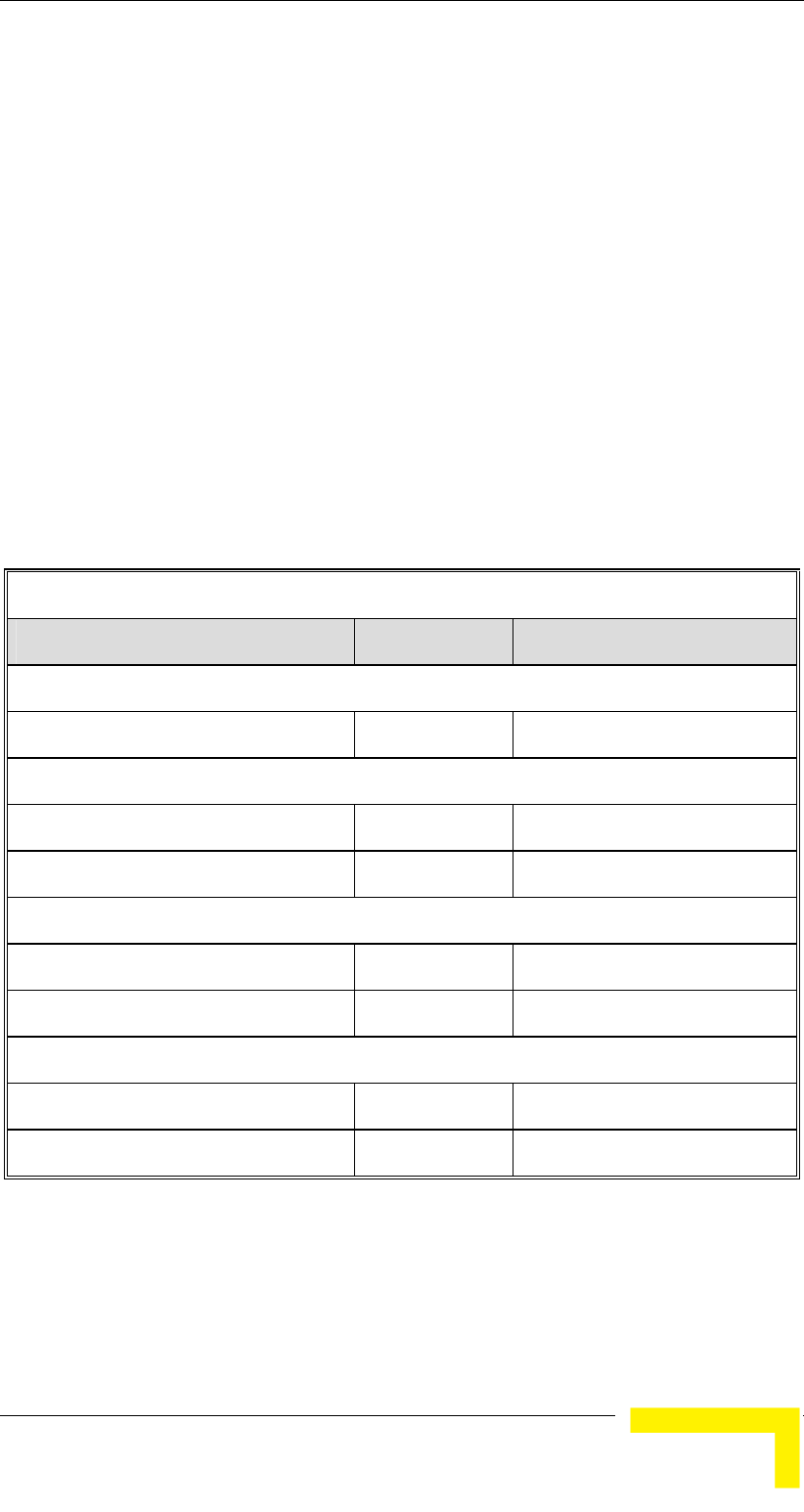
Menus and Parameters
Manual Revision 1.0
4-33
! Display Association Info: Displays information regarding the
Subscriber Units associated with the AU. Each list entry includes
the following information:
# The MAC Address of the associated Subscriber Unit
# The value configured for the Maximum Modulation Level
parameter of the Subscriber Unit
# The Status of the Subscriber Unit. There are three options:
A. Associated
B. Authenticated
C. Not Authenticated (a temporary status)
The various status states are described below (this is a
simplified description of the association process without the
effects of the Best AU algorithm).
Table 4-4: Authentication and Association Process
Message Direction Status in AU
SU Status: Scanning
A Beacon with correct ESSID AU → SU -
SU Status: Synchronized
Authentication Request SU → AU Not authenticated
Authentication Successful AU → SU Authenticated
SU Status: Authenticated
Association Request SU → AU Authenticated
Association Successful AU → SU Associated
SU Status: Associated
ACK SU → AU Associated
Data Traffic SU ↔ AU Associated
# The SNR measured at the SU
# The SW version of the SU.
# Distance.
# Unit Type.

Chapter 4 - Operation and Administration
BreezeACCESSS VL System Manual
4-34
In addition, a summary table displays information about the
Forwarding Database (Bridging Info). The database includes the
following information:
# The current number of entries. This is the number of currently
associated SUs.
NOTE
There is no aging algorithm for associated SUs. An SU is only removed from the list of
associated SUs under the following conditions:
A. A SNAP frame is received from another AU indicating that the SU is now associated
with the other AU.
B. The SU failed to respond to a certain number of consecutive frames transmitted by
the AU and is considered to have "aged out".
# The aging time specified for entries in these table. There is no
aging time for Association Info entries.
# The maximum number of entries permitted for this table, which
is specified by the Maximum Number of Associations
parameter. The default value of the Maximum Number of
Associations parameter is 512.
! Show MIR/CIR Database: Displays information on the MIR/CIR
support for associated Subscriber Units.
Each entry includes the following information:
# The MAC address of the associated Subscriber Unit
# The values of the MIR and CIR parameters configured in the
applicable SU for the downlink (AU to SU) and for the uplink (SU
to AU).
# The value configured in the applicable SU for the Maximum
Delay parameter.
# The maximum data rate of the Subscriber Unit
MAC Address Database in SU
The MAC Address Database option in the SU displays information
regarding the Subscriber Units bridging (forwarding) information. The
following option is available:
! Display Bridging Info: The Display Bridging Info option displays a
list of all the stations in the SU's Forwarding Database.
Each MAC address entry is followed by a description, which may
include the following:
# Et (Ethernet): An address learned from the Ethernet port.

Menus and Parameters
Manual Revision 1.0
4-35
# Wl (Wireless): An address of a node behind the associated AU,
learned via the wireless port.
# Sp (Special): 8 addresses that are always present, which
include:
! The MAC address of the SU, which appears twice as it is
learned from both the Ethernet and wireless ports.
! The MAC address if the internal Operating System stack,
which also appears twice.
! Alvarion's Multicast address (01-20-D6-00-00-01), which
also appears twice. The system treats this address as a
Broadcast address.
! Alvarion's special Multicast address (01-20-D6-00-00-05),
reserved for future use.
! The Ethernet Broadcast address (FF-FF-FF-FF-FF-FF).
In addition, a summary table displays information about the
Forwarding Database (Bridging Info). The summary table includes
the current number of entries, the aging time specified by the Bridge
Aging Time parameter and the maximum number of entries
permitted for this table, which is 1016.

Chapter 4 - Operation and Administration
BreezeACCESSS VL System Manual
4-36
Per Modulation Level Counters
The Per Modulation Level Counters display statistics relating to wireless
link performance at different radio modulation levels. The Per
Modulation Level Counters menu includes the following options:
! Display Counters: Select this option to display the current values of
the Per Modulation Level Counters.
! Reset Counters: Select this option to reset the Per Modulation Level
Counters.
The statistics show the number of frames accumulated in different
categories since the last reset.
For SUs, the Per Modulation Level Counters display the following
information for each modulation level supported by the unit:
! Success: The total number of successfully transmitted unicasts at
the applicable modulation level.
! Failed: The total number of failures to successfully transmit unicast
frame during a HW Retry cycle at the applicable modulation level.
For AUs, the information is provided for each of the associated SUs,
which are identified by their MAC address.

Menus and Parameters
Manual Revision 1.0
4-37
Advanced Configuration Menu
The Advanced Configuration menu provides access to all parameters,
including the parameters available through the Basic Configuration
menu.
The Advanced Configuration menu enables accessing the following
menus:
! IP Parameters
! Air Interface Parameters
! Network Management Parameters
! Bridge Parameters
! Performance Parameters
! Service Parameters
! Security Parameters

Chapter 4 - Operation and Administration
BreezeACCESSS VL System Manual
4-38
IP Parameters
The IP Parameters menu enables defining IP parameters for the selected
unit and determining its method of IP parameter acquisition.
The IP Parameters menu includes the following options:
! IP Address
! Subnet Mask
! Default Gateway address
! DHCP Client
IP Address
The IP Address parameter defines the IP address of the unit.
The default IP address is 10.0.0.1.
Subnet Mask
The Subnet Mask parameter defines the subnet mask for the IP address
of the unit.
The default mask is 255.0.0.0.
Default Gateway Address
The Default Gateway Address parameter defines the IP address of the
unit's default gateway.
The default value for the default gateway address is 0.0.0.0.
DHCP Client
The DHCP Client submenu includes parameters that define the method
of IP parameters acquisition.
The DHCP Client submenu includes the following options:
! DHCP Option
! Access to DHCP
DHCP Option
The DHCP Option displays the current status of the DHCP support, and
allows selecting a new operation mode. Select from the following
options:

Menus and Parameters
Manual Revision 1.0
4-39
! Select Disable to configure the IP parameters manually. If this
option is selected, configure the static IP parameters as described
above.
! Select DHCP Only to cause the unit to search for and acquire its IP
parameters, including the IP address, subnet mask and default
gateway, from a DHCP (Dynamic Host Configuration Protocol) server
only. If this option is selected, you must select the port(s) through
which the unit searches for and communicates with the DHCP
server, as described in the following parameter, Access to DHCP.
You do not have to configure static IP parameters for the unit. DHCP
messages are handled by the units as management frames.
! Select Automatic to cause the unit to search for a DHCP server and
acquire its IP parameters from the server. If a DCHP server is not
located within approximately 40 seconds, the currently configured
parameters are used. If this option is selected, you must configure
the static IP parameters as described above. In addition, you must
select the port(s) through which the unit searches for and
communicates with the DHCP server, as described in the following
parameter, Access to DHCP.
The default is Disable.
Access to DHCP
The Access to DHCP option enables defining the port through which the
unit searches for and communicates with a DHCP server. Select from
the following options:
! From Wireless Link Only
! From Ethernet Only
! From Both Ethernet and Wireless Link
The default for Access Units is From Ethernet Only. The default for
Subscriber Units is From Wireless Link Only.
Show IP Parameters
The Show IP Parameters option displays the current values of the IP
parameters, including the Run Time IP Address, Run Time Subnet
Mask and Run Time Default Gateway Address.

Chapter 4 - Operation and Administration
BreezeACCESSS VL System Manual
4-40
Air Interface Parameters
The Air Interface Parameters menu enables viewing the current Air
Interface parameters defined for the unit and configuring new values for
each of the relevant parameters.
Country Code and Sub Bands
Each country has its own regulations regarding operation modes and
parameters such as allowable frequencies and bandwidth, the need to
employ an automatic mechanism for detection and avoidance of
frequencies used by radar systems, maximum transmit power at each of
the supported modulation levels and the ability to use burst
transmissions. To efficiently manage these country dependent
parameters, each unit has a ‘Country Code’ parameter and a set of
accompanying parameters, which depend on this country code. Where
more than one set of parameters can be used, the available sets are
defined as Sub Bands, selectable through the Frequency configuration
menu.
ESSID Parameters
The ESSID (Extended Service Set ID) is a string used to identify a
wireless network and to prevent the unintentional merging of two
wireless networks or two sectors in the same network. Typically, a
different ESSID is defined for each AU. To facilitate easy addition of SUs
to an existing network without a prior knowledge of which specific AU
will serve it, and to support the Best AU feature, a secondary "global"
ESSID, namely "Operator ESSID", can be configured in the AU. If the
Operator ESSID Option is enabled at the AU, the Beacon frames
transmitted by it will include both the ESSID and Operator ESSID. The
SU shall regard such frames if either the ESSID or the Operator ESSID
matches it own ESSID. The ESSID of the AU with which the SU is
eventually associated is defined as the Run-Time ESSID of the SU.
Typically, the initial ESSID of the SU is configured to the value of the
Operator ESSID. Once the SU has become associated with a specific
AU, its ESSID can be reconfigured to the value of the ESSID of the AU.
ESSID
The ESSID parameter defines the ESSID of the unit.
Valid values: A string of up to 31 printable ASCII characters.
The default value is ESSID1.
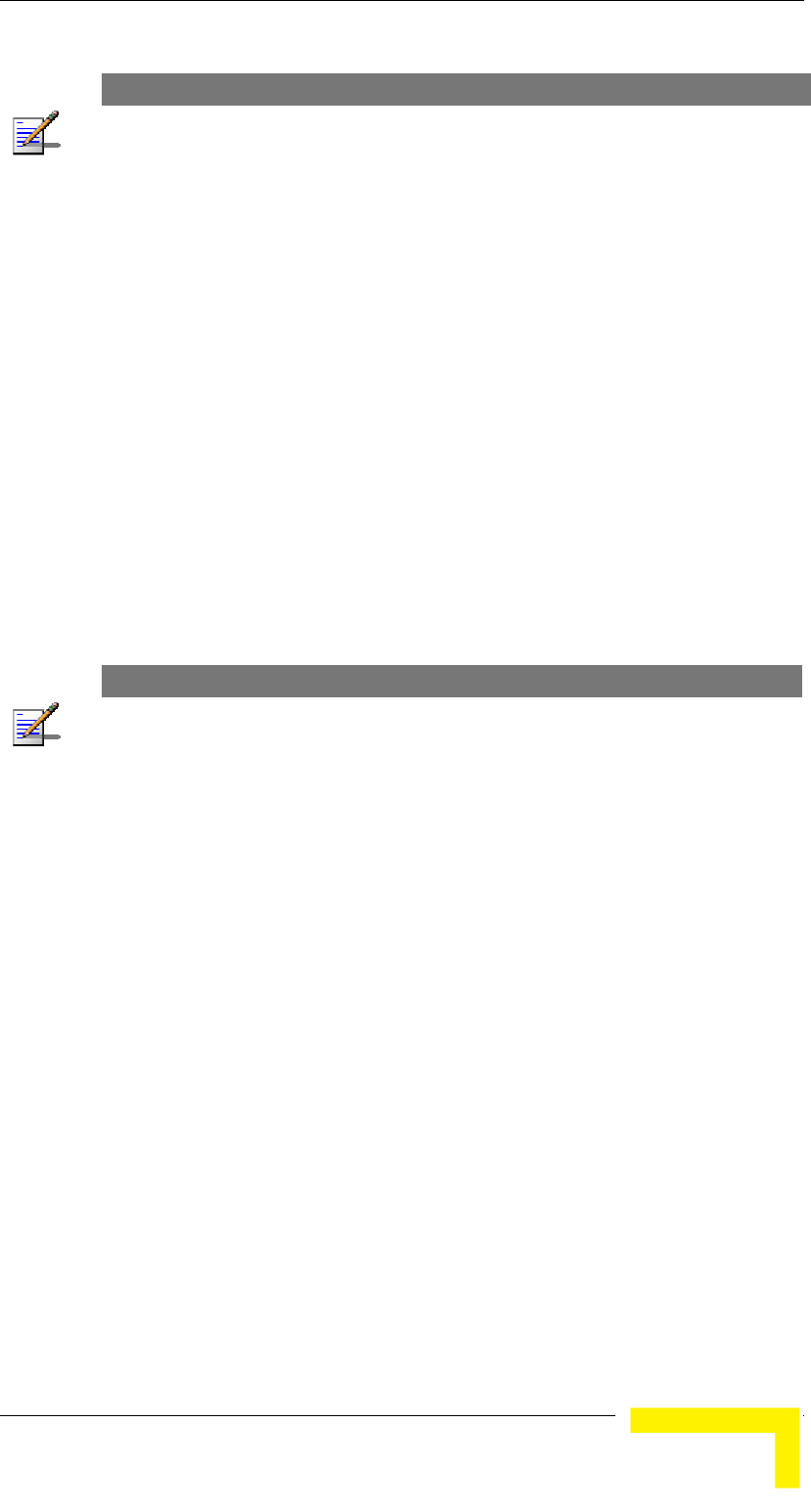
Menus and Parameters
Manual Revision 1.0
4-41
NOTE
The ESSID string is case sensitive.
Operator ESSID Parameters (AU only)
The Operator ESSID Parameters submenu includes the following
parameters:
Operator ESSID Option
The Operator ESSID Option enables or disables the use of Operator
ESSID for establishing association with SUs.
The default is Enable.
Operator ESSID
The Operator ESSID parameter defines the Operator ESSID.
Valid values: A string of up to 31 printable ASCII characters.
The default value is ESSID1.
NOTE
The Operator ESSID string is case sensitive.
Frequency Definition Parameters
The parameters that determine the frequency to be used are set in the
AU. The SU should be configured with a minimal set of parameters to
ensure that it will be able to automatically detect and use the frequency
used by the AU, including possible changes in this frequency.
To simplify the installation process the SU scans a definable frequencies
subset after power-up. If the Best AU feature is enabled, the SU will
scan the defined subset and the operating frequency will be determined
by the Best AU mechanism (including the optional use of the Preferred
AU feature). Otherwise the SU will try to associate with the first AU it
finds. If no AU is found, the SU will start another scanning cycle.
Each unit is delivered with one or more pre-configured Sub-Bands,
according to the country code. These sets of parameters include also the
frequencies that can be used and the bandwidth. If more than one Sub-
Band is available, the sub-band to be used can be selected in both the
AU and the SU. If only one Sub-Band is supported, then the sub-band
selection option is not available.

Chapter 4 - Operation and Administration
BreezeACCESSS VL System Manual
4-42
In some regions, it is important to ensure that wireless access
equipment does not interfere with certain radar systems in the 5 GHz
band. In case radar is being detected, the wireless access network
should move automatically to a frequency that does not interfere with
the radar system.
The country dependent set of parameters includes also an indication
whether DFS (Dynamic Frequency Selection) should be used. The DFS
algorithm is designed to detect and avoid operation in channels with
radar activity. If the current sub-band does not support DFS, then the
DFS parameters configuration submenu is not available.
When the DFS Option is enabled, the AU monitors the spectrum
continuously, searching for signals with a specific pattern indication
radar activity. Upon detecting radar activity, the AU immediately stops
transmitting on this frequency and starts looking for another radar-free
frequency. The subset of viable frequencies is configurable.
The AU maintains a continuously updated database of all applicable
frequencies, where each frequency is marked as Radar Free, Radar
Detected or Adjacent to Radar. The AU attempts to check a new
frequency only if it is marked as Radar Free. If a radar activity was
detected on a certain frequency, it will be marked in the database as a
Radar Detected frequency. The AU will not attempt to check for radar
activity in frequencies marked as Radar Detected. A certain time after
detecting radar activity on a frequency, it will be removed from the list
of Radar Detected frequencies and will be marked as Radar Free. If
radar activity was detected on a certain frequency, adjacent channels
should not be used as well, according to the bandwidth. For instance, if
the bandwidth is 20 MHz, then if radar activity was detected in 5800
MHz, frequencies 5790 MHz and 5810 MHz should not be used as well.
These frequencies are marked in the database as Adjacent to Radar,
and will be treated the same as Radar Detected frequencies.
Before ceasing transmission on the frequency where radar signals had
been detected, the AU sends a special disassociation message to its
associated SUs. This message includes an indication whether the SUs
should wait for this AU. If the SUs should wait, the message includes
also the waiting time. During this time each SU searches for the AU in
the defined frequencies subset. If the AU was not found within the
waiting time, or if a waiting request was not included in the message,
the SU starts searching for any AU, using the Best AU mechanism if
applicable.

Menus and Parameters
Manual Revision 1.0
4-43
Frequency Definition Submenu in AU
The Frequency Definition submenu in AU includes the following
parameters:
Sub Band Select
This parameter is available only if the country code supports two or
more Sub Bands. For information on how to view the Sub Bands
supported by the unit and the supported parameters’ values and
options, refer to Show Country Dependent Parameters on page 4-9.
The range depends on the number of Sub Bands supported by the
country code.
The default selection is Sub Band 1.
Frequency
The Frequency parameter defines the transmit/receive frequency when
the DFS Option is not enabled. If the DFS Option is enabled, it sets the
initial operational frequency upon starting the DFS mechanism the first
time.
The range depends on the selected Sub Band.
The default is the lowest frequency in the Sub Band.
DFS Parameters
The DFS Parameters submenu is available only if DFS is supported by
the current Sub Band. The DFS Parameters submenu includes the
following parameters:
DFS Option
The DFS Option enables or disables the radar detection and dynamic
frequency selection mechanism.
The default is Enable.
Frequency Subset Definition
The Frequency Subset Definition parameter defines the frequencies that
will be used in the DFS mechanism. The available frequencies according
to the Sub Band are displayed, and each of the frequencies in the list is
associated with an index. The frequencies subset can be defined by
entering the indexes of the required frequencies, or “A” to select all
available frequencies.
The default is the complete list of frequencies available in the Sub Band.

Chapter 4 - Operation and Administration
BreezeACCESSS VL System Manual
4-44
Channel Check Time
The Channel Check Time defines the time allocated for checking
whether there is a radar activity on a new frequency after power up or
after trying to move to a new frequency upon detecting radar activity on
the previously used frequency. During this time the AU does not
transmit.
The range is 1 to 3600 seconds.
The default is 60 seconds.
Channel Avoidance Period
The Channel Avoidance Period defines the time that the frequency will
remain marked in the database as Radar Detected or Adjacent to Radar
after detecting radar activity. These frequencies will not be used when
searching for a new frequency. Once this time has elapsed, the unit
frequency’s marking will change to Radar Free.
The range is 1 to 60 minutes.
The default is 30 minutes.
SU Waiting Option
The SU Waiting Option defines whether the disassociation message sent
by the AU, after detecting radar activity on the current frequency, will
include a message instructing the SU to search only for the AU before
attempting to search for another AU. The message includes also the
time period during which the SU should not search for any other AU.
The waiting tine is the Channel Check Time plus 5 seconds.
The default is Enable.
Minimum Pulses to Detect
The Minimum Pulses to Detect parameter defines the minimum number
of radar pulses that should be detected before reaching a decision that
radar is active on the channel.
The range is from 1 to 100 pulses.
The default is 6 pulses.

Menus and Parameters
Manual Revision 1.0
4-45
Clear Radar Detected Channels After Reset
When the Clear Radar Detected Channels After Reset is enabled, than
after the next reset all viable frequencies will be marked in the database
as Radar Free, including frequencies previously marked as either Radar
Detected or Adjacent to Radar. In addition, the AU will start operation
using its default frequency.
The default is Disable.
Show DFS Settings And Data
Upon selecting the Show DFS Settings and Data, the values of all DFS
parameters and the current operating frequency will be displayed. The
current defined frequency subset as well as the defined subset (to be
used after the next reset) are also displayed. In addition, all the
applicable frequencies will be displayed together with their status in the
database (Radar Free, Radar Detected or Adjacent to Radar).
Country Code Learning by SU
This feature support simplified installation and updates processes by
enabling the SU to adapt the Country Code used by the AU.
The AU advertises its country code in every beacon and association
response message. Upon synchronization the SU shall check if its
country code and the country code received from the AU are the same.
If they are not the same and the Country Code Learning by SU is
enabled, the SU shall use the AU’s country code: the country code
derived limitations shall be forces and the following parameters shall be
set according to new country definitions:
! Maximum TX Power (per modulation level) shall be set to the
maximum defined by country code.
! TX Power (per modulation level) shall be set to the maximum defined
by country code.
! The Modulation Level shall be set to the maximum modulation level
defined by country code.
! The Multicast Modulation Level shall be set to the minimum
modulation level defined by country code.
! The Burst Mode shall be set to enable if the country code supports
burst mode, and the burst duration shall be set to default.

Chapter 4 - Operation and Administration
BreezeACCESSS VL System Manual
4-46
After country code learning (adaptation) the unit is automatically reset.
Before this automatic reset, if the unit is running from shadow version,
the versions must be swapped and the running version must be set as
main. This is done to avoid returning to the previous version, which
shall happen automatically after the reset.
The default is Enable.
Show Frequency definitions
Upon selecting Show Frequency Definitions, the selected Sub Band and
Frequency are displayed. In addition, all the parameters displayed upon
selecting Show DFS Settings and Data are also displayed.
Frequency Definition Submenu in SU
Sub Band Select
This parameter is available only if the country code supports two or
more Sub Bands. For information on how to view the Sub Bands
supported by the unit and the supported parameters’ values and
options, refer to Show Country Dependent Parameters on page 4-9.
The range depends on the number of Sub Bands supported by the
country code.
The default selection is Sub Band 1.
Frequency Subset Definition
The Frequency Subset Definition parameter defines the frequencies that
will be used in by the SU when scanning for an AU. The available
frequencies according to the Sub Band are displayed, and each of the
frequencies in the list is associated with an index. The frequencies
subset can be defined by entering the indexes of the required
frequencies, or “A” to select all available frequencies.
The default is the complete list of frequencies available in the Sub Band.
Show Frequency Definitions
Upon selecting the Show Frequency Definitions, the selected Sub Band
parameters and the current operating frequency will be displayed. The
current defined frequency subset as well as the defined subset (to be
used after the next reset) are also displayed.
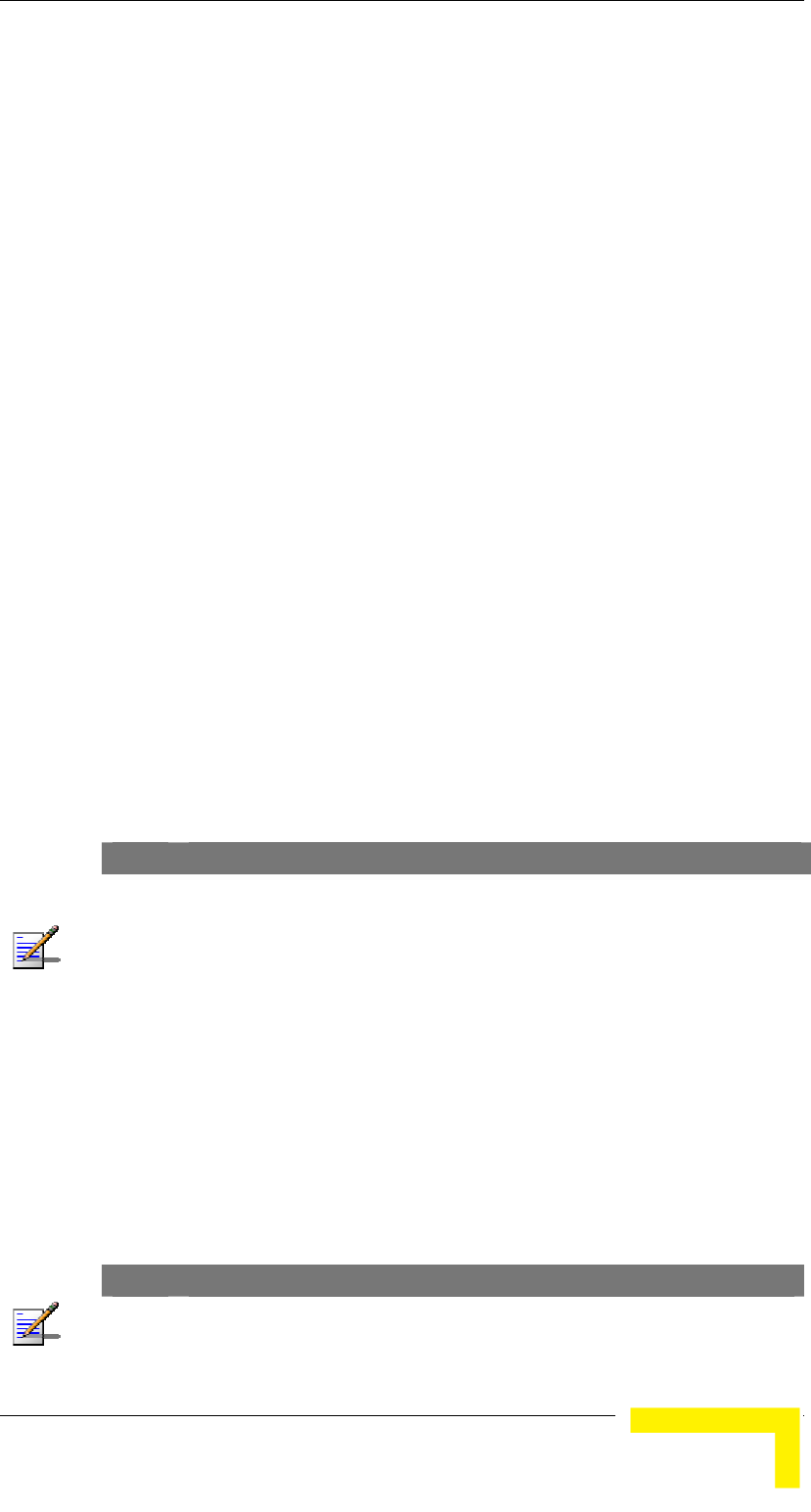
Menus and Parameters
Manual Revision 1.0
4-47
Best AU Parameters (SU)
An SU that can communicate with more than one AU using the same
ESSID may become associated with the first AU it "finds", not
necessarily the best choice in terms of quality of communication or
other factors such as number of SUs serviced by each AU. The same
limitation also exists if only one AU in the neighborhood has an ESSID
identical to the one used by the SU, since it is not always necessarily
the best choice.
The topology of a fixed access network is constantly changing. Changes
in base station deployment and subscriber density can accumulate to
create substantial changes in SU performance. The quest for load
sharing together with the desire to create best throughput conditions for
the SU created the need for the Best AU feature, to enable a SU to
connect to the best AU in its neighborhood.
When the Best AU feature is used, each of the AUs is given a quality
mark based on the level at which it is received by the SU. The SU scans
for a configured number of cycles, gathering information from all the
AUs it can communicate with. At the end of the scanning period, the SU
reaches a Best AU decision according to the information gathered. The
AU with the highest quality mark is selected as the Best AU, and the SU
will immediately try to associate with it. The quality mark given to each
AU depends on the level at which it is received by the SU.
The Best AU selection mechanism can be overridden by defining a
specific AU as the preferred AU.
NOTE
Although the SU selects the Best AU based on long-term conditions prior to the decision
time, it may not always be connected to the instantaneous Best AU at any given time.
Note also that the decision is done only once during the scanning interval. The decision
may not remain the optimal one for ever. If there are significant changes in deployment
of neighboring AUs and the SUs served by them, overall performance may be improved
if the applicable SUs are reset intentionally so as to re-initiate the Best AU decision
process.
The Best AU Parameters menu includes the following options:
Best AU Support
The Best AU Support option enables or disables the Best AU selection
feature.
The default is Disable.
NOTE
If the Best AU feature is not used, the SU associates with the first AU it finds whose
ESSID or Operator ESSID is identical to its own ESSID.

Chapter 4 - Operation and Administration
BreezeACCESSS VL System Manual
4-48
Number Of Scanning Attempts
When the Best AU option is enabled, the SU gathers information on
neighboring AUs for approximately 2 seconds on each of the scanned
frequencies. The Number of Scanning Attempts parameter defines the
number of times that the process will be repeated for all relevant
frequencies. A higher number may result in a better decision at the
cost of an increased scanning time during which the SU is not
operational.
Valid values: 1 - 255.
Default value: 4.
Preferred AU MAC Address
The Preferred AU MAC Address parameter defines a specific AU with
which the SU should associate. Gaining control of the SUs association
is a powerful tool in network management. The Preferred AU MAC
Address parameter is intended for applications where there is a need to
dictate the preferred AU with whom the SU should associate. To prevent
the SU from associating with the first viable AU it finds, the Best AU
Support mechanism should be enabled. Once the SU has identified the
preferred AU based on its MAC address, it will associate with it and
terminate the scanning process. If the preferred AU is not found, the SU
will associate with an AU according to the decision reached using the
best AU algorithm.
Valid values: A MAC address string.
The default value for the Preferred AU MAC Address is 00-00-00-00-00-
00 (12 zeros), meaning that there is no preferred AU.
Show Best AU Parameters and Data
The Show Best AU Parameters and Data option displays the applicable
information:
The Neighboring AU Data table displays for each AU that the unit can
communicate with the following details:
! MAC Address
! SNR of the received signal
! Mark - The computed quality mark for the AU.

Menus and Parameters
Manual Revision 1.0
4-49
! Full - The association load status of the AU. It is defined as full if
the number of SUs associated with the AU has reached the
maximum allowed according to the value of the Maximum Number
of Associations parameter. An AU whose associations load status is
full cannot be selected as the Best AU, even if its' computed mark is
the highest.
! ESSID - The ESSID of the AU.
In addition to the neighboring AU data table, the following information
is displayed:
! Best AU Support
! Preferred AU MAC Address
! Number of Scanning Attempts
! Associated AU MAC Address (the MAC address of the selected AU)
Scanning Mode (SU only)
The Scanning Mode parameter defines whether the SU will use Passive
or Active scanning when searching for an AU.
In passive scanning, the SU “listens” to the wireless media for
approximately two seconds at each frequency, searching for beacons.
The disassociation period, which is the time from the moment the link
was lost until the SU decides that it should start searching for another
AU, is approximately seven seconds.
In some situations when there is a high probability that SUs might need
to roam among different AUs, the use of active scanning enables to
significantly reduce the link establishment time. This is achieved by
using shorter dwell periods, transmitting a Probe Request at each
frequency. This reduces the time spent at each frequency as well as the
disassociation period.
When DFS Option is enabled, Scanning Mode is forced to Passive.
The default selection is Passive.

Chapter 4 - Operation and Administration
BreezeACCESSS VL System Manual
4-50
Power Control Parameters
The Automatic Transmit Power Control (ATPC) algorithm simplifies the
installation process and ensures optimal performance while minimizing
interference to other units. This is achieved by automatically adjusting
the power level transmitted by each SU according to the actual level at
which it is received by the AU. To support proper operation of the
system with optimal performance and minimum interference between
neighboring sectors, the ATPC algorithm should be enabled in all units.
The algorithm is controlled by the AU that calculates for each received
frame the average SNR at which it receives transmissions from the
specific SU. The average calculation takes into account the previous
calculated average, thus reducing the effect of short temporary changes
in link conditions. The weight of history (the previous value) in the
formula used for calculating the average SNR is determined by a
configurable parameter. In addition, the higher the time that has passed
since the last calculation, the lower the impact of history on the
calculated average. If the average SNR is not in the configured target
range, the AU transmits to the SU a power-up or a power-down
message. The target is that each SU will be received at an optimal level,
or as high (or low) as possible if the optimal range cannot be reached
because of specific link conditions.
Each time that the SU tries to associate with the AU (following either a
reset or loss of synchronization), it will initiate transmissions using its'
Transmit Power parameters. If after a certain time the SU does not
succeed to synchronize with the AU, it will start increasing the transmit
power level.
In an AU the maximum supported transmit power is typically used to
provide maximum coverage. However, there may be a need to decrease
the transmitted power level in order to support relatively small cells and
to minimize the interference with the operation of neighboring cells, or
for compliance with local regulatory requirements.
In some cases the maximum transmit power of the SU should be limited
to ensure compliance with applicable regulations or due to other
reasons.
Different power levels may be used for different modulation levels to
optimize performance taking into account the different modulation
schemes as well as possible regulatory restrictions.

Menus and Parameters
Manual Revision 1.0
4-51
Transmit Power
The Transmit Power parameters are defined separately for different
modulation levels. Note that the supported modulation levels depend on
the Min modulation Level and Max Modulation Level defined for the
applicable Sub Band.
In the AU, the Transmit Power parameter defines the fixed transmit
power level and is not a part of the ATPC algorithm.
In the SU, The Initial Transmit Power parameter defines the fixed
transmit power level when the ATPC algorithm is disabled. If the ATPC
Option is enabled the value configured for this parameter serves for
setting the initial value to be used by the ATPC algorithm after either
power up or loosing synchronization with the AU.
The minimum value for the Transmit Power Parameters is -10 dBm.
(The ATPC may reduce the actual transmit power of the SU to lower
values). The maximum value of the Transmit Power Parameter depends
on several unit properties and parameters:
! The HW revision of the unit
! The modulation level
! The Maximum Allowed Tx Power as defined for the applicable Sub
Band.
! The Maximum EIRP as defined for the applicable Sub Band,
together with the value of the Antenna Gain. In certain countries the
Maximum EIRP of some equipment types cannot exceed a certain
value. In these cases the Transmit Power cannot exceed the value of
(Maximum EIRP – Antenna Gain).
! Maximum Tx Power parameter (in SU only)
For information on how to view the Sub Bands supported by the unit
and the supported parameters’ values and options, refer to Show
Country Dependent Parameters on page 4-9.
The unit calculates the maximum allowed Transmit Power according to
the unit properties and parameters listed above, and displays the
allowed range when a Transmit Power parameter is selected.
The default Transmit Power is the highest allowed value.
Maximum Tx Power (SU only)
The Maximum Tx Power parameter limits the maximum transmit power
that can be reached by the ATPC algorithm. It also sets the upper limits
for the Transmit Power parameters.

Chapter 4 - Operation and Administration
BreezeACCESSS VL System Manual
4-52
The minimum value for the Maximum Tx Power is -10 dBm. The
maximum value depends on several unit properties and parameters:
! The HW revision of the unit
! The modulation level
! The Maximum Allowed Tx Power as defined for the applicable Sub
Band.
! The Maximum EIRP as defined for the applicable Sub Band,
together with the value of the Antenna Gain. In certain countries the
Maximum EIRP of some equipment types cannot exceed a certain
value. In these cases the Transmit Power cannot exceed the value of
(Maximum EIRP – Antenna Gain).
For information on how to view the Sub Bands supported by the unit
and the supported parameters’ values and options, refer to Show
Country Dependent Parameters on page 4-9.
The unit calculates the maximum allowed Maximum Tx Power
according to the unit properties and parameters listed above, and
displays the allowed range when the Maximum Tx Power parameter is
selected.
The default Maximum Tx Power is the highest allowed value.
ATPC Parameters in AU
ATPC Option
The ATPC Option enables or disables the Automatic Transmit Power
Control (ATPC) algorithm.
The default is Enable.
ATPC Minimum SNR Level
The Minimum SNR Level defines the lowest SNR at which you want
each SU to be received at the AU (the lower limit of the optimal
reception level range).
Available values: 4 to 60 (dB).
Default value: 28 (dB).
ATPC Delta from Minimum SNR Level
The Delta from Minimum SNR Level is used to define the highest SNR at
which you want each SU to be received at the AU (the higher limit of the
optimal reception level range):

Menus and Parameters
Manual Revision 1.0
4-53
Max. Level=Minimum SNR Level + Delta from Minimum SNR Level.
Available values: 4 to 20 (dB) for units operating in the 5.2, 5.4 and 5.8
GHz bands. 11 to 20 (dB) for units operating in the 4.9 and 5.3 GHz
bands.
Default value: 4 (dB) for units operating in the 5.2, 5.4 and 5.8 GHz
bands. 11 (dB) for units operating in the 4.9 and 5.3 GHz bands.
Minimum Interval Between ATPC Messages
The Minimum Interval Between ATPC Messages parameter sets the
minimal time between consecutive power-up/power-down messages to a
specific SU. Setting a low value for this parameter may lead to a higher
overhead and an excessive rate of power level changes at the SUs. High
values for this parameter increase the time it will take until the SUs
reach optimal transmit power level.
Available values: 1 to 3600 seconds.
Default value: 30 seconds.
ATPC Power Level Step
The ATPC Power Level Step parameter defines the step size to be used
by the SUs for incrementing/decrementing the Current Transmit
Power after receiving a power-up/power-down message. If the distance
between the value of the Current Transmit Power and the desired
range is smaller than the step size, the power-up/power-down message
will include the specific step value required for this condition.
Valid range: 1-20 (dB)
Default value: 5 (dB)
ATPC Parameters in SU
ATPC Option
The ATPC Option enables or disables the Automatic Transmit Power
Control (ATPC) algorithm. The parameter takes effect immediately.
However, when changed from Enable to Disable, the transmit power
level shall remain at the last Current Transmit Power determined by the
ATPC algorithm before it was disabled. It will change to the value
configured for the Initial Transmit Power parameter only after the next
reset or following loss of synchronization.
The default is Enable.

Chapter 4 - Operation and Administration
BreezeACCESSS VL System Manual
4-54
Antenna Gain
The Antenna Gain parameter enables to define the net gain of a
detached antenna. The configured gain should take into account the
attenuation of the cable connecting the antenna to the unit. The
Antenna Gain is important especially in countries where there is a limit
on the EIRP allowed for the unit; the maximum allowed value for the
Transmit Power parameters cannot exceed the value of (EIRP- Antenna
Gain), where the EIRP is defined in the selected Sub Band.
In certain units with an integral antenna the Antenna Gain is not
available as a configurable parameter. However, it is available as a read-
only parameter in the applicable “Show” menus.
The range is 0 – 50 (dB). A value of “Don’t Care” means that the actual
value is not important. A value of “Not Set Yet” means that the unit will
not transmit until the actual value (in the range 0 to 50) is configured.
The unit can be configured to “Don’t Care” or “Not Set Yet” only in
factory (when upgraded to SW version 2.0 from a lower version it will be
set automatically to one of these options). Once a value is configured, it
is not possible to reconfigure the unit to either “Don’t Care” or “Not Set
Yet”.
The default value depends on unit type. In SUs with integral antenna it
is set to 21 (read only). The default value for AUs that are supplied with
a detached antenna is in accordance with the antenna’s gain. In units
supplied without an antenna the default is typically “Not Set Yet”.
Cell Distance Parameters (AU only)
The higher the distance of an SU from the AU that is serving it, the
higher the time it takes for messages sent by one of them to reach the
other. To ensure appropriate services to all SUs regardless of their
distance from the AU while maintaining a high overall performance
level, two parameters should be adapted to the distances of SUs from
the serving AU:
! The time that a unit waits for a response message before
retransmission (acknowledge time delay) should take into account
the round trip propagation delay of the farthest SU. (the one-way
propagation delay at 5 GHz is 3.3 microsecond/km). The higher the
distance from the AU of the farthest SU served by it, the higher
should be the acknowledge time delay for all units in the cell.

Menus and Parameters
Manual Revision 1.0
4-55
! To ensure fairness in the contention back-off algorithm between SUs
located at different distances from the AU, the size of the time slot
should also take into account the one-way propagation delay. The
size of the time slot of all units in the cell should be proportional to
the distance from the AU of the farthest SU served by it.
The distance from the AU of the farthest SU served by it can be
determined either manually or automatically. In manual mode, this
distance is configured manually. In automatic mode, the AU uses a
special algorithm to estimate its distance from each of the SUs it serves,
determine which SU is located the farthest and use the estimated
distance of the farthest SU as the maximum distance.
It should be noted that if the size of the time slot used by all units is
adapted to the distance of the farthest unit, than no unit will have an
advantage when competing for services. However, this reduces the
overall achievable throughput of the cell. In certain situations, the
operator may decide to improve the overall throughput by reducing the
slot size below the value required for full fairness. This means that
when there is competition for bandwidth, the back-off algorithm will
give advantage to SUs that are located closer to the AU.
The Cell Distance Parameters menu includes the following parameters:
Cell Distance Mode
The Cell Distance Mode option defines whether the maximum distance
of the AU from any of the SUs it serves will be determined manually
(using the Maximum Cell Distance parameter) or automatically.
The Options are Automatic or Manual.
The default is Automatic.
Maximum Cell Distance
The Maximum Cell Distance parameter allows configuring the
maximum distance when the Cell Distance Mode option is Manual.
The range is 0 to 54 (Km). The value of 0 has a special meaning for No
Compensation: Acknowledge Time Out is set to a value representing the
maximum distance of 54 km. The time slot size is set to its minimal
value of 9 microseconds.
The default is 0 (No Compensation).

Chapter 4 - Operation and Administration
BreezeACCESSS VL System Manual
4-56
Fairness Factor
The Fairness Factor enables to define the level of fairness in providing
services to different SU. When set to 100%, all SUs have the same
probability of getting services when competing for bandwidth. If set to
X%, than SUs located up to X% of the maximum distance from the AU
will have advantage in getting services over SUs located farther than
this distance.
The range is 0 to 100 (%)
The default is 100 (%).
Show Cell Distance Parameters
Select Show Cell Distance Parameters to view the Cell Distance
parameters. In addition, the Measured Maximum Cell Distance and the
MAC address of the unit that the mechanism found to be the farthest
from the AU are displayed. A distance of 1 km means any distance
below 2km.
Arbitration Inter-Frame Spacing (AIFS)
The time interval between two consecutive transmissions of frames is
called Inter-Frame Spacing (IFS). This is the time during which the unit
determines whether the medium is idle using the carrier sense
mechanism. The IFS depends on the type of the next frame to be
transmitted, as follows:
! SIFS (Short Inter-Frame Spacing) is used for certain frames that
should be transmitted immediately, such as ACK and CTS frames.
The value of SIFS is 16 microseconds.
! DIFS (Distributed coordination function Inter-Frame Spacing) is
typically used for other frame types when the medium is free. If the
unit decides that the medium is not free, it will defer transmission
by DIFS plus a number of time slots as determined by the
Contention Window back-off algorithm (see Minimum Contention
Window on page 4-77) after reaching a decision that the medium
has become free.
DIFS equal SIFS plus AIFS, where AIFS can be configured to one or two
time slots. Typically AIFS should be configured to two time slots. A
value of 1 should only be used in one of the two units in a point-to-
point link, where in the other unit the AIFS remains configured to two
time slots. This ensures that the unit with AIFS configured to one has
an advantage over the other unit, provided that the Minimum
Contention Window parameter (see page 4-77) in both units is
configured to 0 to disable the contention window back-off algorithm.
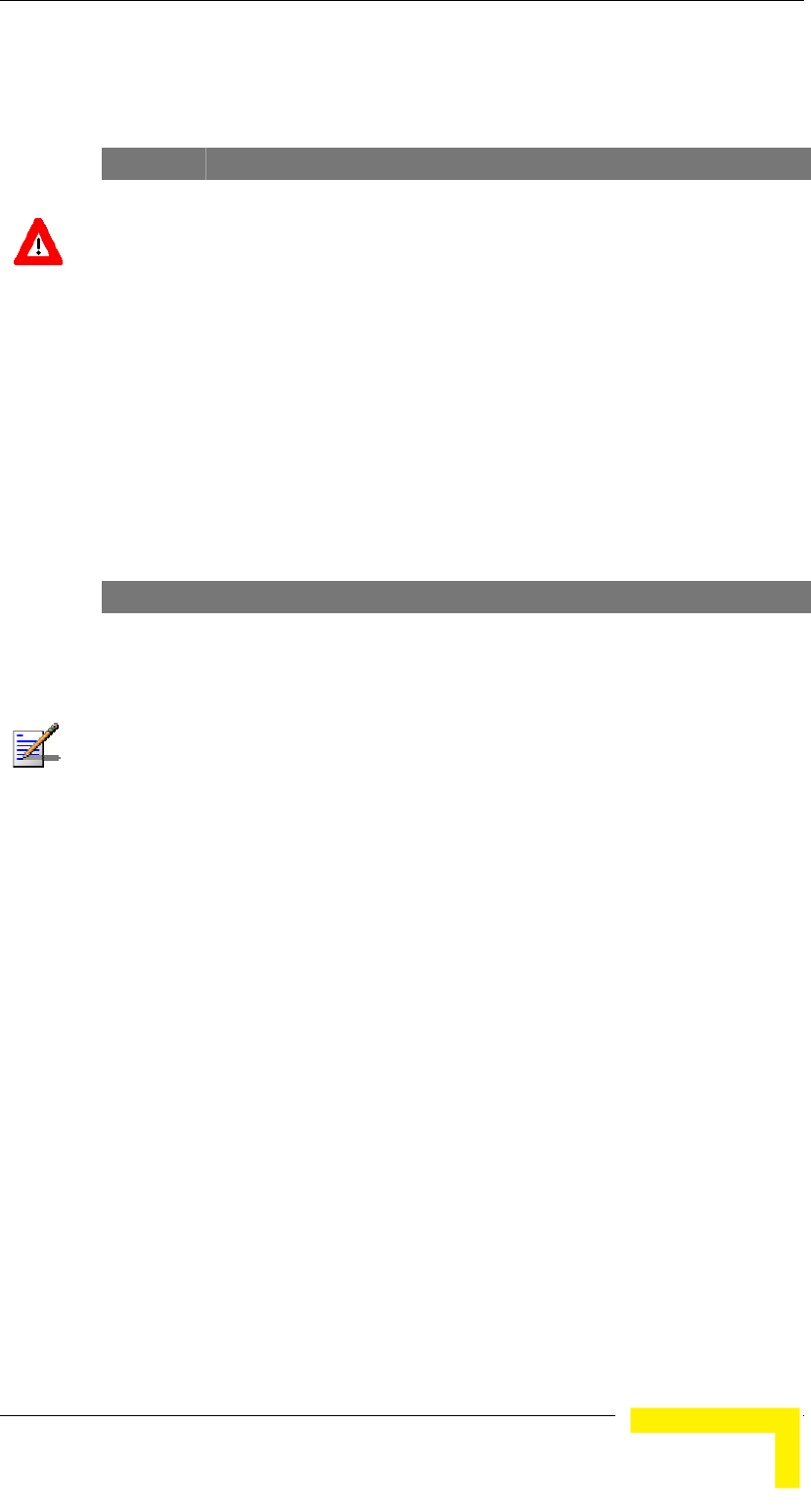
Menus and Parameters
Manual Revision 1.0
4-57
The available options are 1 or 2 (time slots).
The default is 2 time slots.
CAUTION
An AIFS value of 1 should only be used in point-to-point applications. Otherwise the
default value of 2 must always be used. In a point-to-point link, only one unit should be
configured to an AIFS value of 1. When both units need to transmit, the unit with an
AIFS value of 1 shall have an advantage over the unit with AIFS of 2. In this case, the
Minimum Contention Window parameter in both units must be configured to 0 to disable
the contention window back-off algorithm.
Maximum Number of Associations (AU only)
The Maximum Number of Associations parameter defines the maximum
number of Subscriber Units that can be associated with the selected
AU, while still guaranteeing the required quality of service to customers.
Available values range from 0 to 512.
Default value: 512.
NOTE
There is no aging time for SUs. An SU is only removed from the list of associated SUs
under the following conditions:
a. A SNAP frame is received from another AU indicating that the SU is now associated
with the other AU.
b. The SU failed to respond to a certain number of consecutive frames transmitted by
the AU and is considered to have "aged out".
Therefore, the database of associated SUs may include units no longer associated with
the AU. If the number of associated SUs has reached the value of the Maximum
Number of Associations parameter, the selected AU cannot serve additional SUs. To
view the current number of associated SUs, use the Display Association Info option in
the MAC Address Database menu. To delete inactive SUs from the database you must
reset the AU.
Wireless Link Trap Threshold (AU only)
The Wireless Link Trap Threshold parameter defines the threshold for
the wireless quality trap, indicating that the quality of the wireless link
has dropped below (on trap) or has increased above (off trap) the
specified threshold.
The Wireless Link Trap Threshold is in percentage of retransmissions,
and the allowed range is from 1 to 100 (%).
The default is 30 (%).

Chapter 4 - Operation and Administration
BreezeACCESSS VL System Manual
4-58
Country Code Learning by SU
This feature support simplified installation and updates processes by
enabling the SU to adapt the Country Code used by the AU.
The AU advertises its country code in every beacon and association
response message. Upon synchronization the SU shall check if its
country code and the country code received from the AU are the same.
If they are not the same and the Country Code Learning by SU is
enabled, the SU shall use the AU’s country code: the country code
derived limitations shall be forces and the following parameters shall be
set according to new country definitions:
! Maximum TX Power (per modulation level) shall be set to the
maximum defined by country code.
! TX Power (per modulation level) shall be set to the maximum defined
by country code.
! The Modulation Level shall be set to the maximum modulation level
defined by country code.
! The Multicast Modulation Level shall be set to the minimum
modulation level defined by country code.
! The Burst Mode shall be set to enable if the country code supports
burst mode, and the burst duration shall be set to default.
After country code learning (adaptation) the unit is automatically reset.
Before this automatic reset, if the unit is running from shadow version,
the versions must be swapped and the running version must be set as
main. This is done to avoid returning to the previous version, which
shall happen automatically after the reset.
The default is Enable.
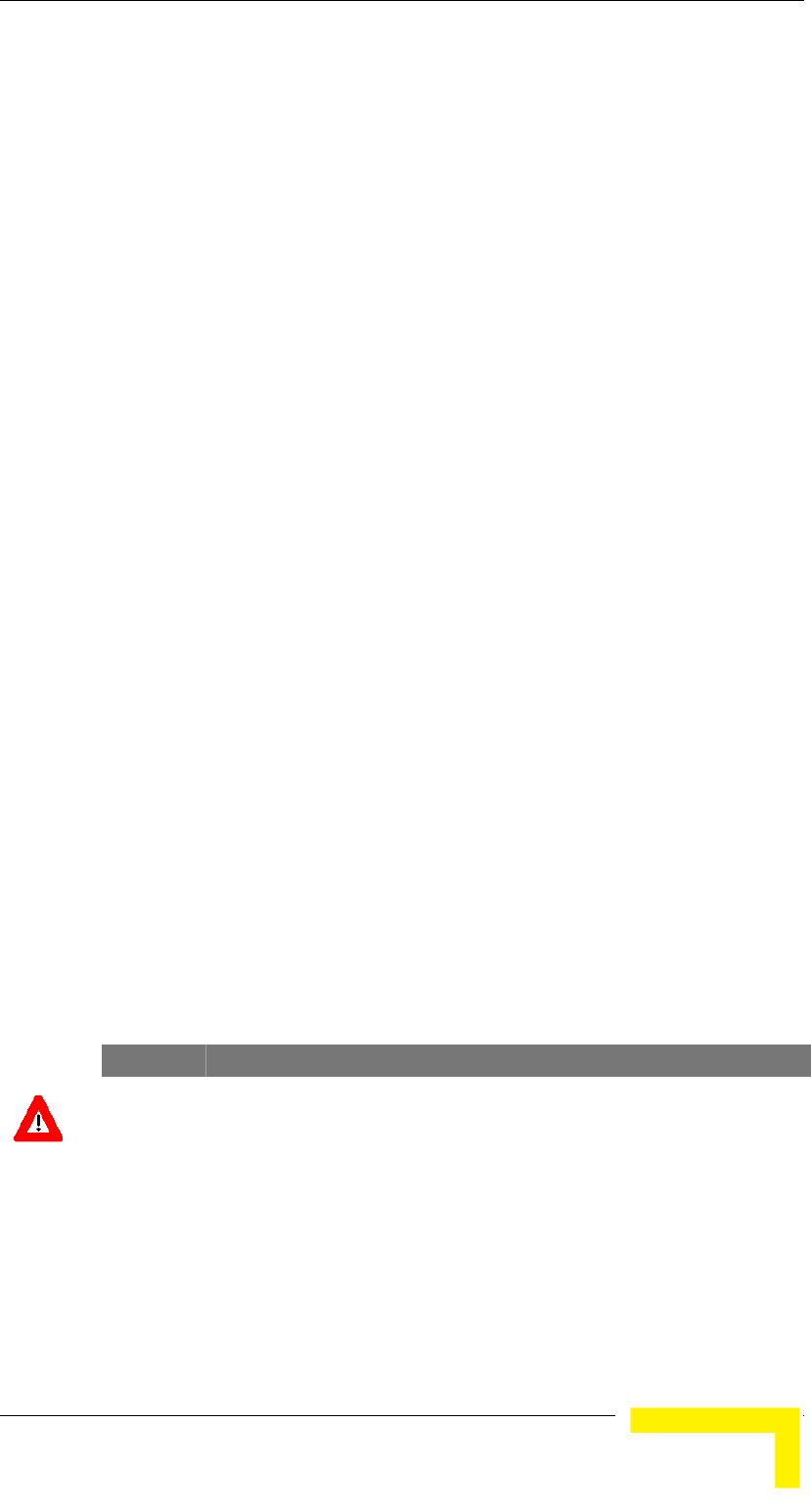
Menus and Parameters
Manual Revision 1.0
4-59
Network Management Parameters
The Network Management Parameters menu enables protecting the Unit
from unauthorized access by defining a set of IP addresses from which
the unit can be managed using protocols such as Telnet, FTP, TFTP,
SNMP, DHCP and ICMP. This excludes management messages
generated in the unit, such as Traps or Ping Test frames, which are not
filtered. You can also determine the direction from which management
access is permitted, which means from the wireless media or the wired
Ethernet or both.
The Network Management Parameters menu includes the following
options:
! Access to Network Management
! Network Management Filtering
! Set Network Management IP address
! Delete a Network Management IP Address
! Delete All Network Management IP Addresses
! SNMP Traps
Access to Network Management
The Access to Network Management option defines the port through
which the unit can be managed. The following options are available:
! From Wireless Link Only
! From Ethernet Only
! From Both Ethernet and Wireless Link
The default selection is From Both Ethernet and Wireless Link.
CAUTION
Be careful not to block your access to the unit. For example, if you manage an SU via
the wireless link, setting the Access to Network Management parameter to From
Ethernet Only completely blocks your management access to the unit. In this case, a
technician may be required to change the settings at the user's site.

Chapter 4 - Operation and Administration
BreezeACCESSS VL System Manual
4-60
Network Management Filtering
The Network Management Filtering option enables or disables the IP
address based management filtering. If management filtering is enabled,
the unit can only be managed by stations with IP addresses matching
one of the entries in the Set Network Management IP Addresses option,
described below, and that are connected to the unit via the defined
port(s). The following options are available:
! Disable: No IP address based filtering is configured.
! Activate IP Filter on Ethernet Port: Applicable only if the Access
to Network Management parameter is configured to either From
Ethernet Only or From Both Ethernet and Wireless Link. The unit
can be managed from the Ethernet port only by stations with IP
addresses matching one of the entries in the Set Network
Management IP Addresses parameter. If the Access to Network
Management parameter is configured to From Both Ethernet and
Wireless Link then no IP address based filtering is configured for the
wireless port.
! Activate IP Filter on Wireless Link Port: Applicable only if the
Access to Network Management parameter is configured to either
From Wireless Link Only or From Both Ethernet and Wireless Link.
The unit can be managed from the wireless port only by stations
with IP addresses matching one of the entries in the Set Network
Management IP Addresses parameter. If the Access to Network
Management parameter is configured to From Both Ethernet and
Wireless Link then no IP address based filtering is configured for the
Ethernet port.
! Activate IP filter on Both Ethernet and Wireless Link Ports:
Applicable to all options of the Access to Network Management
parameter. The unit can be managed from the port(s) defined by the
Access to Network Management parameter only by stations with IP
addresses matching one of the entries in the Set Network
Management IP Addresses parameter.
The default selection is Disable.
Set Network Management IP Address
The Set Network Management IP Address option enables defining up
to 10 IP addresses of devices that can manage the unit if the Network
Management Filtering option is enabled.
The default Network Management IP Address is 0.0.0.0 (all 10
addresses)

Menus and Parameters
Manual Revision 1.0
4-61
Delete a Network Management IP Address
The Delete Network Management IP Address option enables deleting IP
address entries from the Network Management IP Addresses list.
Delete All Network Management IP Addresses
The Delete All Network Management IP Addresses option enables
deleting all entries from the Network Management IP Addresses list.
SNMP Traps
The SNMP submenu enables or disables the transmission of SNMP
Traps. If this option is enabled, up to 10 IP addresses of stations to
which SNMP traps are sent can be defined.
Send SNMP Traps
The Send SNMP Traps option enables or disables the sending of SNMP
traps.
The default selection is Disable.
SNMP Traps Destination IP Addresses
The SNMP Traps Destination IP Addresses submenu enables defining
up to 10 IP addresses of devices to which the SNMP Traps are to be
sent.
The default of all 10 SNMP Traps IP destinations is 0.0.0.0.
SNMP Traps Community
The SNMP Traps Community option enables defining the Community
name for each IP address to which SNMP Trap messages are to be sent.
Valid strings: Up to 8 ASCII characters.
The default for all 10 addresses is “public”, which is the default Read
community.
Delete One Trap Address
The Delete One Trap Address option enables deleting Trap address
entries from the SNMP Traps Addresses list.
Delete All Trap Addresses
The Delete All Trap Addresses option enables deleting all entries from
the SNMP Traps Addresses list.

Chapter 4 - Operation and Administration
BreezeACCESSS VL System Manual
4-62
Bridge Parameters
The Bridge Parameters menu provides a series of parameter sets that
enables configuring parameters such as control and filtering options for
broadcast transmissions, VLAN support, and Type of Service
prioritization.
The Bridge Parameters menu includes the following options:
! VLAN Support
! ToS Parameters
! Ethernet Broadcast Filtering
! Bridge Aging Time
! Roaming Option (SU only)
! Broadcast Relaying (AU only)
! Unicast Relaying (AU only)
! MAC Address Deny List (AU only)
VLAN Support
The VLAN Support menu enables defining the parameters related to the
IEEE 802.1Q compliant VLAN aware (Virtual LAN aware) feature of the
BreezeACCESS VL units. Each VLAN includes stations that can
communicate with each other, but cannot communicate with stations
belonging to different VLANs. The VLAN feature also provides the ability
to set traffic priorities for transmission of certain frames. The
information related to the VLAN is included in the VLAN Tag Header,
which is inserted in each frame between the MAC header and the data.
VLAN implementation in BreezeACCESS VL units supports frame
routing by port information, whereby each port is connected to only one
VLAN.
The VLAN Support menu includes the following parameters:
! VLAN Link Type
! VLAN ID – Data (SU only)
! VLAN ID – Management
! VLAN Forwarding
! VLAN Relaying (AU only)
! VLAN Traffic Priority

Menus and Parameters
Manual Revision 1.0
4-63
VLAN ID-Data (SU only)
The VLAN ID-Data is applicable only when the VLAN Link Type
parameter is set to Access Link. It enables defining the VLAN ID for data
frames, which identifies the VLAN to which the unit belongs.
Valid values range from 1 to 4094.
Default value: 1.
The VLAN ID-Data affects frames received from the wireless link port, as
follows:
! Only tagged frames with a VLAN ID (VID) equal to the VLAN ID-Data
defined in the unit are forwarded to the Ethernet port.
! The tag headers are removed from the data frames received from the
wireless link before they are transmitted on the Ethernet port.
The VLAN ID-Data affects frames received from the Ethernet port, as
follows:
! A VLAN Data Tag is inserted in all untagged frames received from
the Ethernet port before transmission on the wireless link. The tag
includes the values of the VLAN ID-Data and the VLAN Priority-
Data parameters.
! Tagged frames received on Ethernet port, which are meant to be
forwarded to the wireless link port, are discarded. This includes
frames with tagging for prioritization purpose only.
VLAN ID-Management
The VLAN ID-Management is applicable for all link types. It enables
defining the VLAN ID for management frames, which identifies remote
stations for management purposes. This applies to all management
applications using protocols such as SNMP, TFTP, ICMP (ping), DHCP
and Telnet. All servers/stations using these protocols must tag the
management frames sent to the unit with the value of the VLAN ID-
Management parameter.
Valid values: 1 to 4094 or 65535 (No VLAN).
The default value is 65535.
If the VLAN ID-Management is other than 65535:
! Only tagged management frames with a matching VLAN ID received
on either the Ethernet or wireless link ports are forwarded to the
unit.
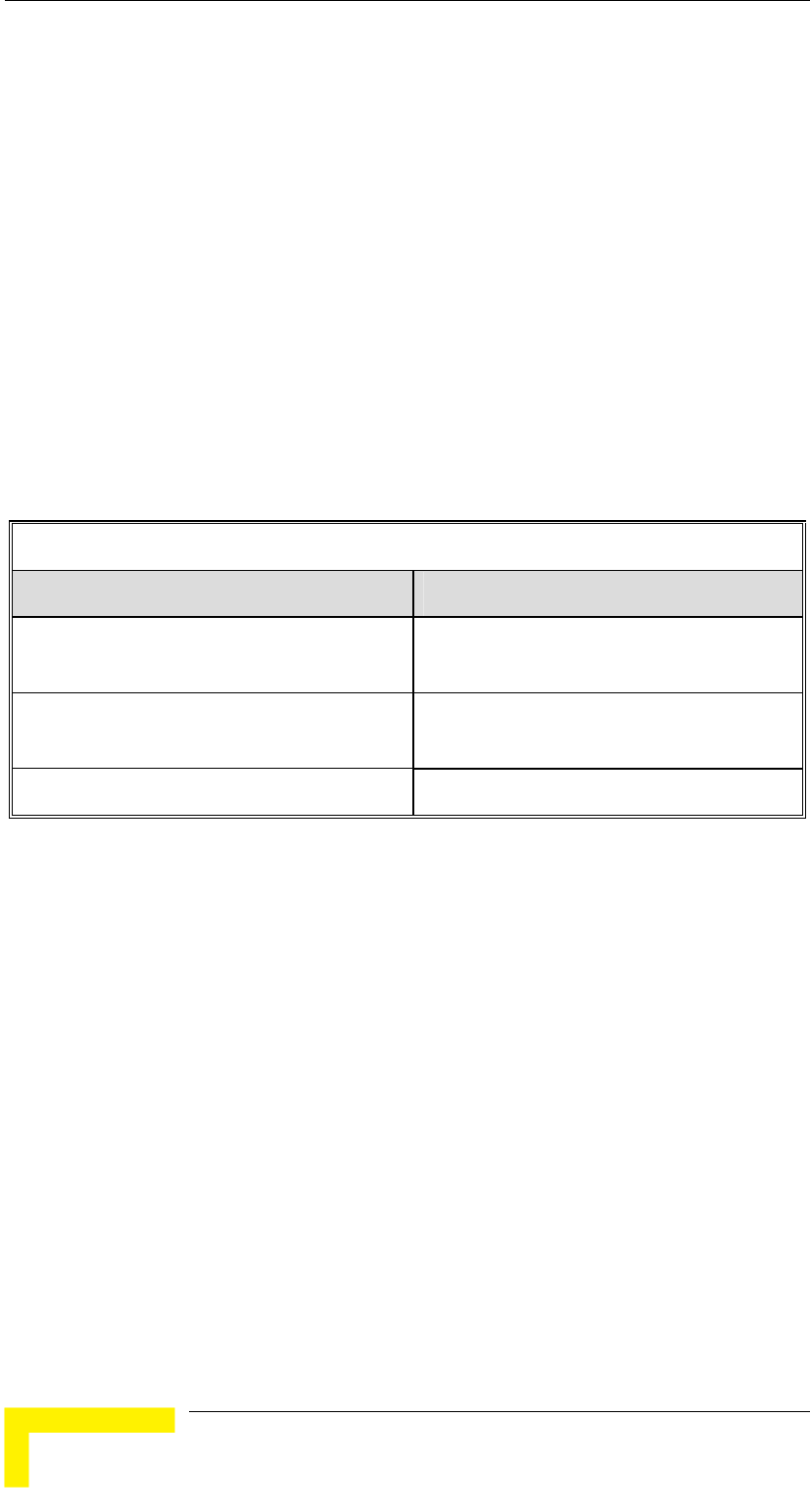
Chapter 4 - Operation and Administration
BreezeACCESSS VL System Manual
4-64
! A VLAN Management Tag is inserted in all management frames
generated by the unit before transmission on either the Ethernet or
wireless link port. The tag includes the values of the VLAN ID-
Management and the VLAN Priority-Management parameters.
If the VLAN ID-Management is 65535 (No VLAN):
! Only untagged management frames received on either the Ethernet
or wireless link ports are forwarded to the unit.
! Management frames generated by the unit are not tagged.
The following table summarizes the functionality of the internal
management port in accordance with the value of the VLAN ID-
Management parameter. The table is valid for all link types. Refer to the
VLAN Link Type - Access Link and Trunk Link options for some
restrictions when configuring this parameter.
Table 4-5: VLAN Management Port Functionality
Action Management Port - Internal
Receive from Ethernet Tagged frames, matching VID-M
Untagged frames when VID-M=65535
Receive from Wireless Tagged frames, matching VID-M
Untagged frames when VID-M=65535
Transmit Insert VID-M, PID-M
Table Legend:
! VID-M: VLAN ID-Management
! PID-M: VLAN Priority-Management
VLAN Link Type
The VLAN Link Type parameter enables defining the functionality of the
VLAN aware capability of the unit.
The available options are Hybrid Link, Trunk Link and Access Link
(Access Link option is available only in SUs).
The default selection is Hybrid Link.
Access Link (SU only)
Access Link transfers frames while tagging/untagging them since all
devices connected to the unit are VLAN unaware. Thus, the unit cannot
transfer tagged frames.
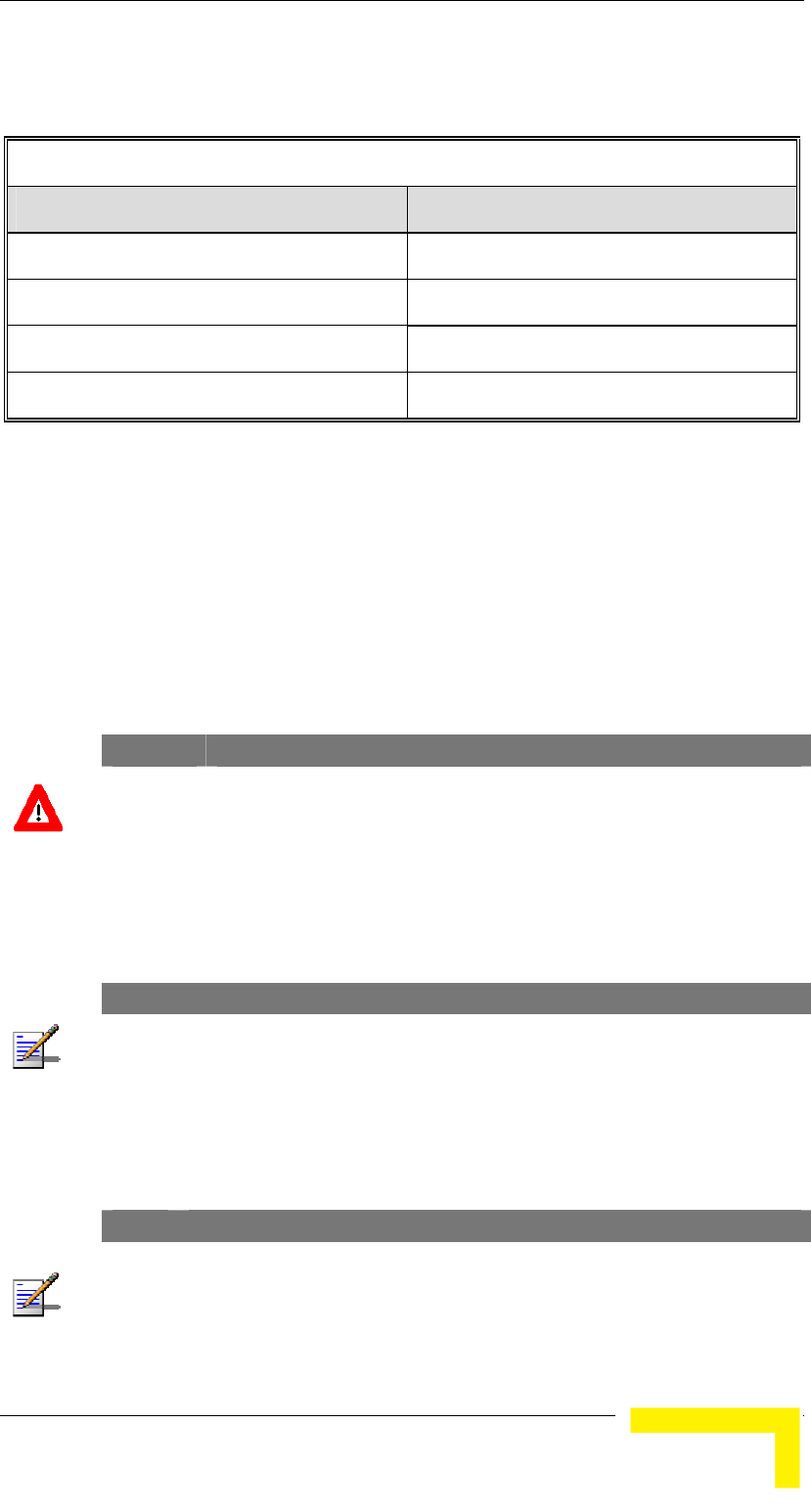
Menus and Parameters
Manual Revision 1.0
4-65
Table 4-6 summarizes the functionality of the data port for an Access
link.
Table 4-6: VLAN Data Port Functionality - Access Link
Action Data Port - SU
Receive from Ethernet Untagged frames
Accept from Wireless Tagged frames, matching VID-D
Tag Insert VID-D, PID-D (to wireless)
Tag Remove Yes (to Ethernet)
Table Legend:
! VID-D: VLAN ID-Data
! PID-D: VLAN Priority-Data
Trunk Link
Trunk Link transfers only tagged frames, since all devices connected to
the unit are VLAN aware: Only tagged data frames received on the
Ethernet or wireless link ports are forwarded.
CAUTION
It is not recommended that you configure a unit as a Trunk Link with the VLAN ID-
Management parameter set at 65535, as it does not forward any 'NO VLAN'
management frames to its other port making it impossible to manage devices connected
behind the unit that are also configured with 'NO VLAN'.
If the VLAN Forwarding option is enabled, a data frame received with a
VLAN ID that is not a member of the unit's VLAN Forwarding List is
discarded.
NOTE
If the VLAN Forwarding option is enabled, be sure to include the VLAN ID-
Management value of all units that should be managed via the wireless port of the unit,
in the Forwarding List.
If the VLAN Relaying option is enabled in an AU, a data frame relayed
with a VLAN ID that is not a member of the unit's VLAN Relaying List is
discarded.
NOTE
If the VLAN Relaying option is enabled and you manage your devices from behind an
SU unit, be sure to include the VLAN ID-Management value of all units to be managed
when relaying via the wireless port of the AU unit, in the Relaying List. If the VLAN
Forwarding option is also enabled in the AU, these VLAN IDs should also be included in
the Forwarding List.
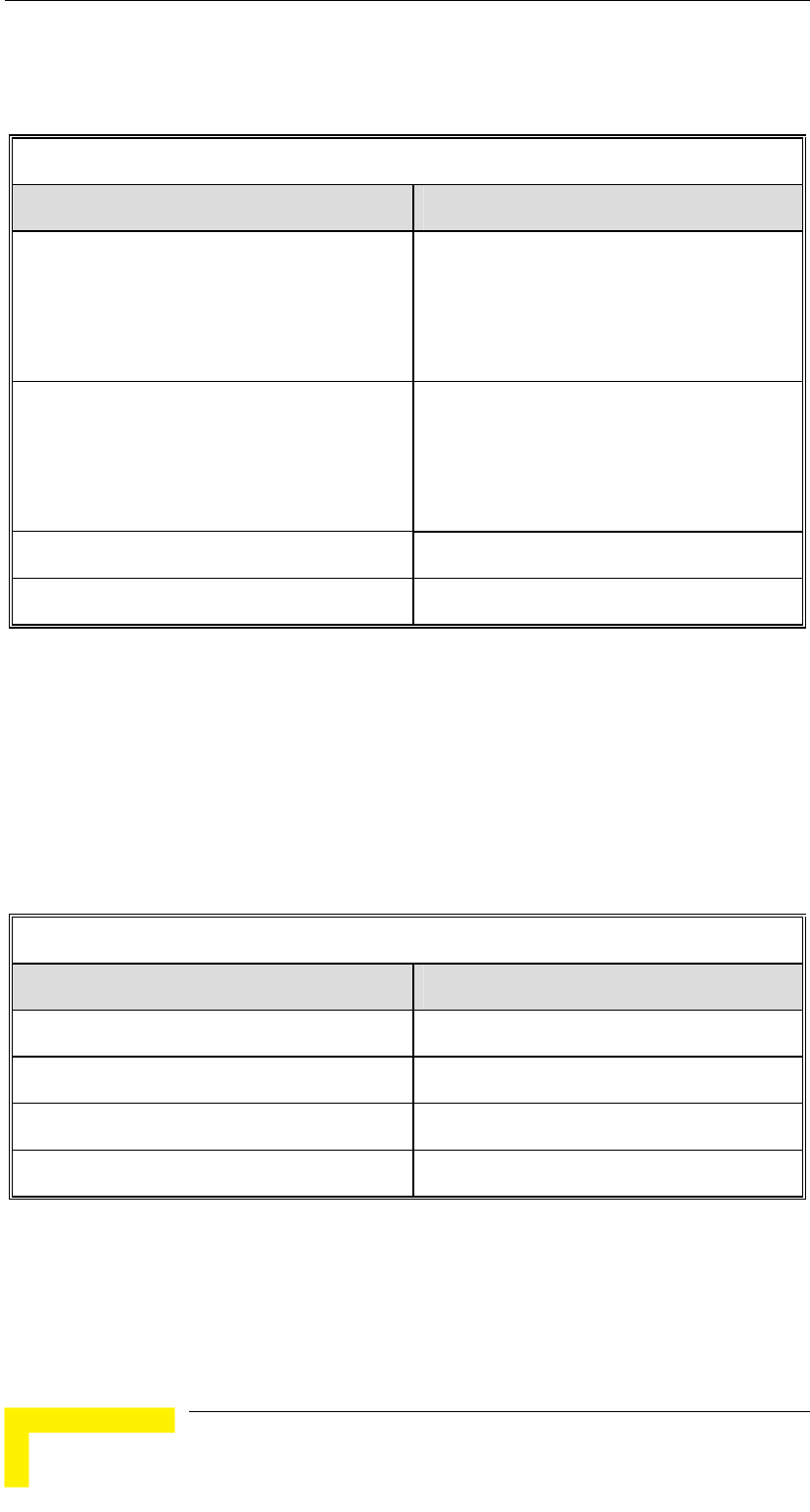
Chapter 4 - Operation and Administration
BreezeACCESSS VL System Manual
4-66
Table 4-7 summarizes the functionality of the data port for a Trunk
link.
Table 4-7: VLAN Data Port Functionality - Trunk Link
Action Data Port – AU and SU
Accept from Ethernet Tagged frames.
If Forwarding is enabled, only frames with
VLAN ID values which are included in the
Forwarding list
Accept from Wireless Tagged frames
If Forwarding is enabled, only frames with
VLAN ID values which are included in the
Forwarding list
Tag Insert No
Tag Remove No
Hybrid Link
Hybrid Link transfers both tagged and untagged frames, since the
devices connected to the unit can be either VLAN aware or VLAN
unaware. This is equivalent to defining no VLAN support, as the unit is
transparent to VLAN.
Table 4-8 summarizes the functionality of the data port for a Hybrid
link.
Table 4-8: VLAN Data Port Functionality - Hybrid Link
Action Data Port – AU and SU
Accept from Ethernet All
Accept from Wireless All
Tag Insert No
Tag Remove No
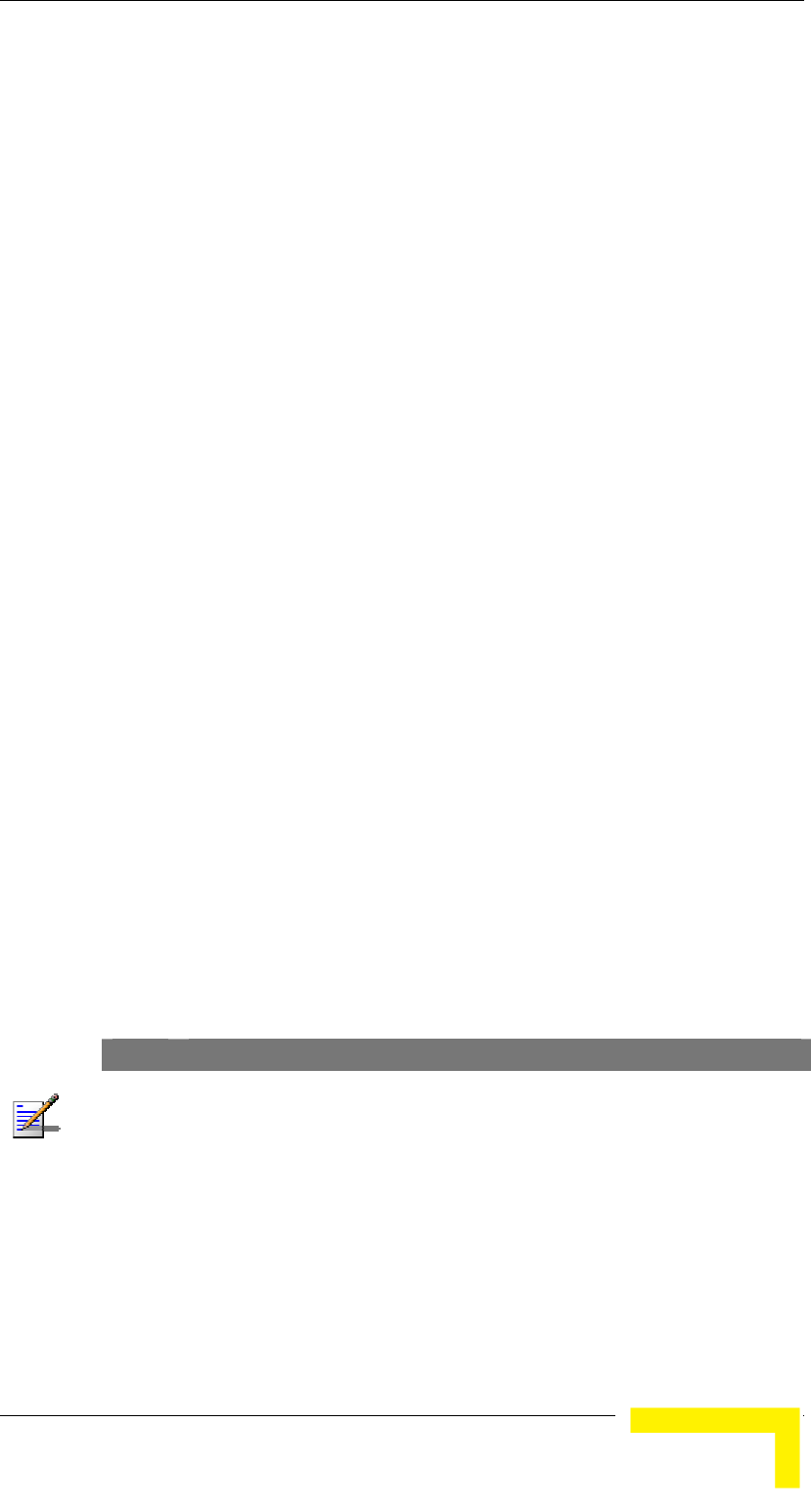
Menus and Parameters
Manual Revision 1.0
4-67
VLAN Forwarding (AU and SU)
The VLAN Forwarding feature is applicable for Trunk Links only. It
enables defining the VLAN ID values to be included in the VLAN
Forwarding List. If the Link Type is defined as a Trunk Link and the
VLAN Forwarding option is enabled, a data frame received with a VLAN
ID that is not a member of the unit's VLAN Forwarding List is discarded.
The VLAN Forwarding submenu provides the following options:
VLAN Forwarding Support
The VLAN Forwarding Support option enables or disables the VLAN
Forwarding feature.
Available selections are Disable and Enable.
The default selection is Disable.
Add Forwarding VLAN ID
The Add Forwarding VLAN ID option enables adding a VLAN ID to the
VLAN Forwarding List. One VLAN ID can be entered at a time. The
maximum number of VLAN IDs in the VLAN Forwarding List is 20.
Valid values are 1 to 4094.
Remove Forwarding VLAN ID
The Remove Forwarding VLAN ID option enables removing a VLAN ID
from the VLAN ID Forwarding List.
Valid values are VID values (from 1 to 4094) that are included in the
VLAN Forwarding List.
Show VLAN ID Forwarding List
The Show VLAN Forwarding List option displays the values of the VLAN
IDs included in the VLAN Forwarding List.
NOTE
If the VLAN ID Forwarding List is empty and the VLAN Forwarding Support is set to
Enable, then all data frames are discarded.
If VLAN Relaying Support and VLAN Forwarding Support are both enabled, then all
VLAN IDs configured in the Relaying List must also be configured in the Forwarding List.

Chapter 4 - Operation and Administration
BreezeACCESSS VL System Manual
4-68
VLAN Relaying (AU only)
The VLAN Relaying feature is applicable for Trunk Links only. It enables
defining the VLAN ID values to be included in the VLAN Relaying List. If
the Link Type is defined as Trunk Link and the VLAN Relaying Support
option is enabled, a frame relayed from the wireless link, which is a
frame received from the wireless link that should be transmitted back
through the wireless link, with a VLAN ID that is not a member of the
unit's VLAN Relaying List, is discarded. If VLAN Forwarding Support is
also enabled, it is necessary to configure all the VLAN IDs in the
Relaying List also in the Forwarding List to enable the relaying
operation.
The VLAN Relaying menu provides the following options:
VLAN Relaying Support
The VLAN Relaying Support option enables or disables the VLAN
Relaying feature.
Available selections are Disable and Enable.
The default selection is Disable.
Add Relaying VLAN ID
The Add Relaying VLAN ID option enables adding a VLAN ID to the
VLAN Relaying List. One VLAN ID can be entered at a time. The
maximum number of VLAN IDs in the VLAN Relaying List is 20.
Valid values are 1 to 4094.
Remove Relaying VLAN ID
The Remove Relaying VLAN ID option enables removing a VLAN ID from
the VLAN ID Relaying List. Valid values are VID values (from 1 to 4094))
that are included in the VLAN Relaying List.
Show VLAN ID Relaying List
The Show VLAN Relaying option displays the values of the VLAN IDs
included in the VLAN Relaying List.
NOTE
If the VLAN ID Relaying List is empty and the VLAN Relaying Support is Enabled, then
all data frames relayed from the wireless link are discarded.
If VLAN Relaying Support and VLAN Forwarding Support are both enabled, then all
VLAN IDs configured in the Relaying List must also be configured in the Forwarding List.
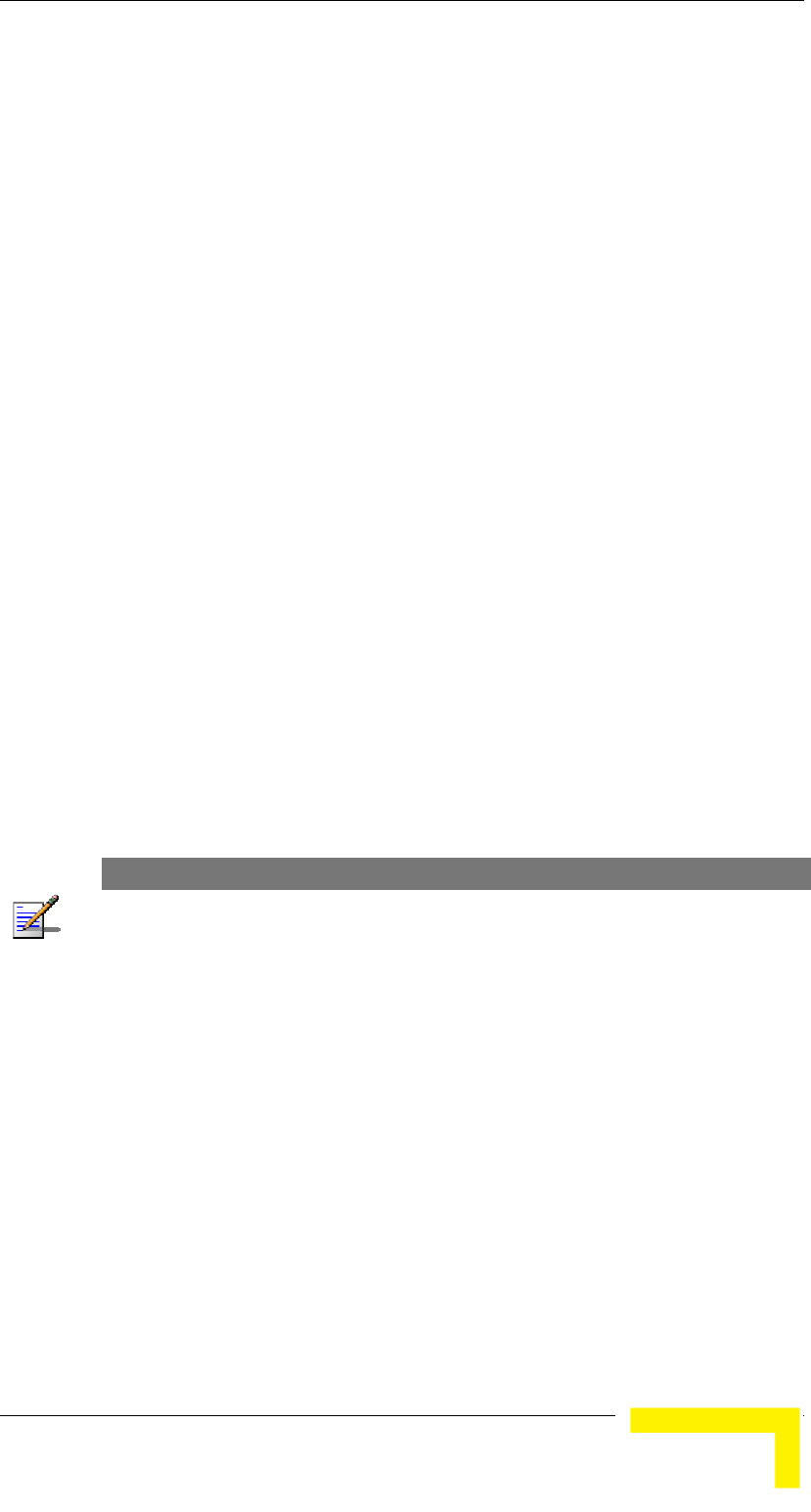
Menus and Parameters
Manual Revision 1.0
4-69
VLAN Traffic Priority
Each packet to be transmitted to the wireless link is transferred to one
of three queues: Low, Mid and High. Packets in the High queue have the
highest priority for transmission, and those in the Low queue have the
lowest priority.
BreezeACCESS Subscriber and Access units support layer-2 traffic
prioritization according to the IEEE 802.1p standard. The priority field
in the 802.1Q header tag can have a value in the range 0 to 7. This
value determines the relative priority of the packet.
Packets received from the Ethernet port that have a priority higher than
the value of the VLAN Priority Threshold are routed to the Mid queue.
Since the system also supports layer 3 prioritization, based on ToS,
packets with precedence in the ToS field higher than the value of the
ToS Precedence Threshold parameter are also routed to the Mid queue.
This is applicable to both tagged and untagged frames.
All other packets received from the Ethernet port are routed to the Low
queue.
Control and wireless management frames generated in the unit are
routed to the High queue.
Any frame coming from the Ethernet port, which is meant to reach
another BreezeACCESS unit via the wireless port (as opposed to
messages intended for stations behind other BreezeACCESS units), is
sent to the High queue, regardless of the priority configuration.
NOTE
The prioritization mechanism is disabled when the traffic rate reaches the maximum
information rate supported by the SU.
The VLAN Traffic Priority menu includes the following parameters:
! VLAN Priority – Data (SU only)
! VLAN Priority – Management
! VLAN Priority Threshold
VLAN Priority - Data (SU only)
The VLAN Priority - Data is applicable for Access Links only. It enables
configuring the value of the VLAN Priority field for data frames
transmitted to the wireless link. All data frames are routed to the Low
queue. This parameter only impacts the way that other VLAN aware
devices handle the packet.

Chapter 4 - Operation and Administration
BreezeACCESSS VL System Manual
4-70
Valid values range from 0 to 7.
The default value is 0.
NOTE
Packets Received from the Ethernet port with a ToS Precedence value higher than the
defined ToS Precedence Threshold are routed to the Mid queue.
VLAN Priority - Management
The VLAN Priority - Management enables defining the value of the VLAN
Priority field for management frames in units with VLAN ID
Management that is other than 65535. All management frames are
routed to the High queue. This parameter only impacts the way other
VLAN aware devices handle the packet.
Valid values range from 0 to 7.
The default value is 4 for SUs and 0 for AUs.
VLAN Priority Threshold
The VLAN Priority Threshold is applicable for Trunk and Hybrid Links
only. It enables defining the value of the VLAN Priority Threshold. This
parameter impacts the way the unit handles tagged packets received
from the Ethernet port.
Since the system supports both layer 2 and layer 3 prioritization, a
frame is routed to the Mid queue if either of the following conditions are
met:
! The precedence in the ToS field is higher than the value of the ToS
Precedence Threshold parameter. This is applicable to both tagged
and untagged frames.
! The VLAN Priority field in a tagged frame is higher than the value of
the VLAN Priority Threshold parameter.
Valid values range from 0 to 7.
The default value is 3.
Show VLAN Parameters
The Show VLAN Parameters option displays the current values of the
VLAN support parameters.
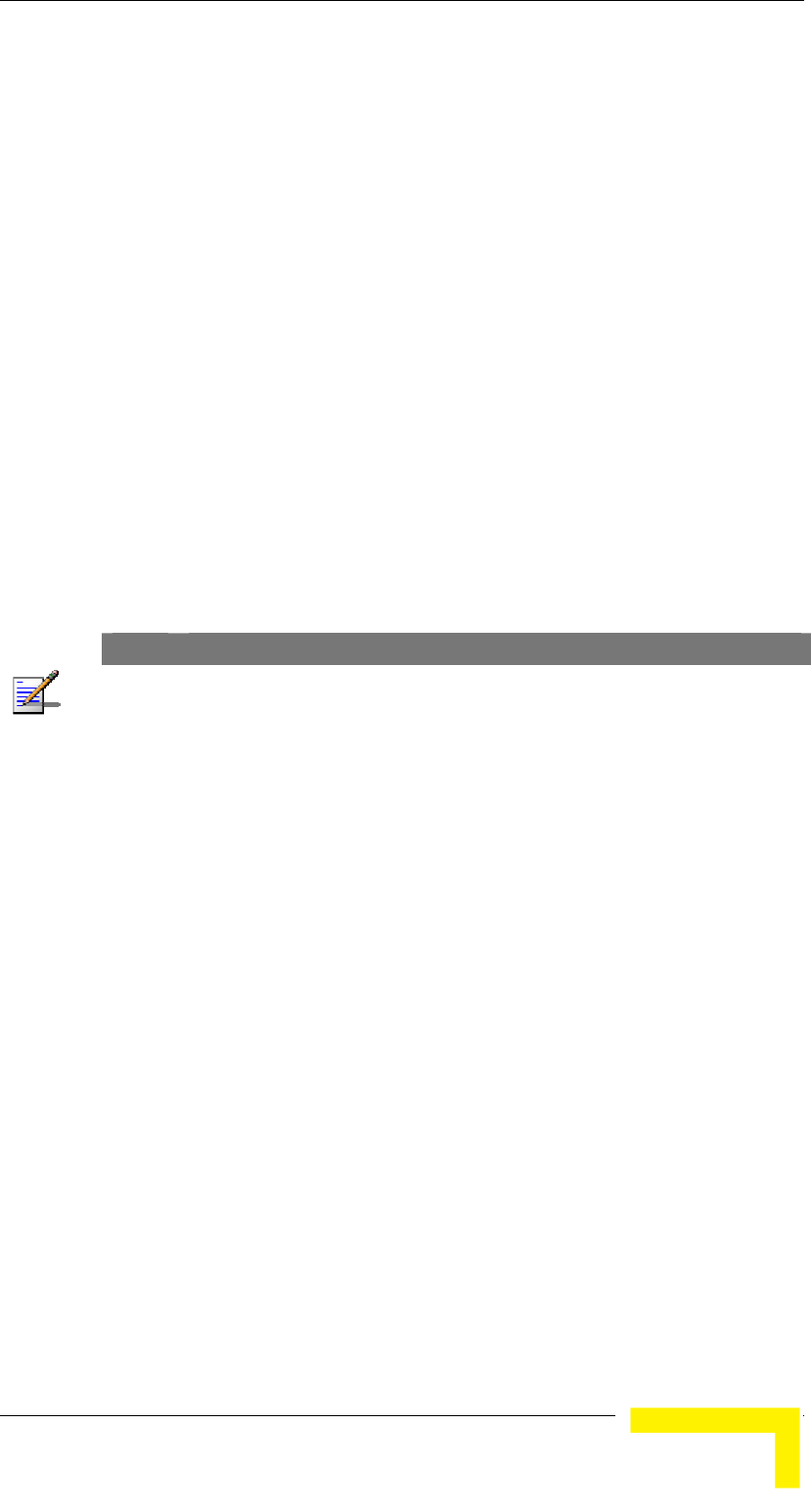
Menus and Parameters
Manual Revision 1.0
4-71
ToS Parameters
ToS Precedence Threshold
The ToS Precedence Threshold parameter enables defining ToS based
prioritization in accordance with the precedence bits of the ToS field in
the IP header. An IP packet received from the Ethernet port is routed to
the Mid queue if any one of the following conditions is met:
! The precedence in the ToS field is higher than the value of the ToS
Precedence Threshold parameter. This is applicable to both tagged
and untagged frames.
! The VLAN Priority field in a tagged frame (Hybrid or Trunk Link) is
higher than the value of the VLAN Priority Threshold parameter.
All other packets received from the Ethernet port are routed to the Low
queue.
Valid values are 0 to 7.
The default value is 3.
NOTE
The prioritization mechanism is disabled when the traffic rate reaches the maximum
information rate supported by the SU.
Ethernet Broadcast Filtering (SU only)
The Ethernet Broadcast Filtering menu enables defining the layer 2
(Ethernet) broadcast and multicast filtering capabilities for the selected
SU. Filtering the Ethernet broadcasts enhances the security of the
system and saves bandwidth on the wireless media by blocking
protocols that are typically used in the customer's LAN but are not
relevant for other customers, such as NetBios, which is used by the
Microsoft Network Neighborhood. Enabling this feature blocks Ethernet
broadcasts and multicasts by setting the I/G bit at the destination
address to 1. This feature should not be enabled when there is a router
behind the SU.
The Ethernet Broadcast Filtering menu includes the following
parameters:
! Filter Options
! DHCP Broadcast Override Filter
! PPPoE Broadcast Override Filter
! ARP Broadcast Override Filter

Chapter 4 - Operation and Administration
BreezeACCESSS VL System Manual
4-72
Filter Options
The Filter Options enables defining the Ethernet Broadcast filtering
functionality of the unit. Select from the following options:
! Disable, which means no Ethernet Broadcast Filtering.
! On Ethernet Port Only, which filters broadcast messages received
from the Ethernet port.
! On Wireless Port Only, which filters broadcast messages received
from the wireless link port.
! On Both Ethernet and Wireless Ports, which filters broadcast
messages received from both the Ethernet and wireless link ports.
The default selection is Disable.
DHCP Broadcast Override Filter
The DHCP Broadcast Override Filter option enables or disables the
broadcasting of DHCP messages. Even if according to the selected
option in the Filter Options parameter, broadcast messages should be
filtered, DHCP broadcasts are transmitted if this parameter is set to
Enable. Select from the following options:
! Disable, which means that DHCP Broadcast messages are filtered or
transmitted according to the general filtering criteria in the Filter
Options parameter.
! Enable, which means that DHCP Broadcast messages are
transmitted regardless of the selected value of the Filter Options
parameter.
The default selection is Disable.
PPPoE Broadcast Override Filter
The PPPoE Broadcast Override Filter option enables or disables the
broadcasting of PPPoE (Point to Point Protocol over Ethernet) messages.
Even if according to the selected option in the Filter Options parameter,
broadcast messages should be filtered, PPPoE broadcasts are
transmitted if this parameter is set to Enable. Select from the following
options:
! Disable, which means that PPPoE Broadcast messages are filtered
or transmitted according to the general filtering criteria in the Filter
Options parameter.

Menus and Parameters
Manual Revision 1.0
4-73
! Enable, which means that PPPoE Broadcast messages are
transmitted regardless of the selected value of the Filter Options
parameter.
The default selection is Disable.
ARP Broadcast Override Filter
The ARP Broadcast Override Filter option enables or disables the
broadcasting of ARP messages. Even if according to the selected option
in the Filter Options parameter, broadcast messages should be filtered,
ARP broadcasts are transmitted if this parameter is set to Enable. Select
from the following options:
! Disable, which means that ARP messages are filtered or transmitted
according to the general filtering criteria in the Filter Options
parameter.
! Enable, which means that ARP messages are transmitted regardless
of the selected value of the Filter Options parameter.
The default selection is Enable.
Bridge Aging Time
The Bridge Aging Time parameter enables selecting the bridge aging
time for learned addresses of devices on both the wired and wireless
sides, not including BreezeACCESS VL units.
The available range is 20 to 2000 seconds.
The default value is 300 seconds.
Broadcast Relaying (AU only)
The Broadcast Relaying option enables selecting whether the unit
performs broadcast relaying. When the Broadcast Relaying parameter is
enabled, broadcast packets originating from devices on the wireless link
are transmitted by the AU back to the wireless link devices, as well as to
the wired LAN. If disabled, these packets are sent only to the local wired
LAN and are not sent back to the wireless link. Disable the broadcast
relaying only if all broadcast messages from the wireless link are certain
to be directed to the wired LAN.
The default selection is Enable.

Chapter 4 - Operation and Administration
BreezeACCESSS VL System Manual
4-74
Unicast Relaying (AU only)
The Unicast Relaying option enables selecting whether the unit
performs unicast relaying. When the Unicast Relaying parameter is
enabled, unicast packets originating from devices on the wireless link
can be transmitted back to the wireless link devices. If disabled, these
packets are not sent to the wireless link even if they are intended for
devices on the wireless link. Disable the Unicast Relaying parameter
only if all unicast messages from the wireless link are certain to be
directed to the local wired LAN.
The default selection is Enable.
MAC Address Deny List (AU only)
The MAC Address Deny List submenu enables to define units that are
not authorized to receive services. The AU will not provide services to a
unit whose MAC Address is included in the deny list. This feature
enables to disconnect units from the services in cases such as when the
user had fraudulently succeeded to configure the unit to values
different than his subscription plan. The deny list can include up to 100
MAC Addresses.
The MAC Address Deny List submenu includes the following:
Add MAC Address to Deny List
Select Add MAC Address to Deny List to add a MAC Address to the Deny
List.
Remove MAC Address from Deny List
Select Remove MAC Address from Deny List to remove a MAC Address
from the Deny List.
Show MAC Address Deny List
Select Show MAC Address Deny List to display the current list of MAC
Addresses included in the Deny List.

Menus and Parameters
Manual Revision 1.0
4-75
Roaming Option (SU only)
The Roaming Option defines the roaming support of the unit. When
roaming is not expected, it is preferable to set this parameter to Disable.
This will cause the unit to start scanning for another AU after loosing
connectivity with the current AU only after 7 seconds during which no
beacons were received from the current AU. This will prevent scanning
for another AU in cases where no beacons were received due to a short
temporary problem.
When set to Enable, the SU will wait only one second before it starts
scanning for another AU. In addition, when the Roaming Option is
enabled, the SU will send Roaming SNAP messages upon associating
with a new AU. This enables fast distribution of the new location for all
clients that are behind the SU. In this case, the SU will send multicast
SNAP messages via the wireless link each time it associates with a new
AU, except for the first association after reset. The SU will send one
SNAP message for each client learned on its Ethernet port, based on its
bridging table. In the SNAP message the clients’ MAC address is used as
the source address. The AU that receives this SNAP message learns
from it the new location of the clients. It forwards the SNAP to other
AUs and Layer-2 networking equipment via its Ethernet port, to
facilitate uninterrupted connectivity and correct routing of
transmissions to these clients. The new AU as well as the previous AU
with which the SU was associated, will forward the SNAP messages to
all other SUs associated with them.
The default is Disable.
Show Bridge Parameters
The Show Bridge Parameters option displays the current values of the
Bridge parameters.

Chapter 4 - Operation and Administration
BreezeACCESSS VL System Manual
4-76
Performance Parameters
The Performance Parameters menu enables defining a series of
parameters that control the method by which traffic is transmitted
through the BreezeACCESS VL wireless access network.
The Performance Parameters menu includes the following parameters:
! RTS Threshold
! Minimum Contention Window
! Maximum Contention Window
! Multicast Modulation Level (AU only)
! Maximum Modulation Level
! Average SNR Memory Factor
! Number of HW Retries
! Burst Mode
! Adaptive Modulation Algorithm
RTS Threshold
The RTS Threshold parameter defines the minimum frame size that
requires an RTS/CTS (Request To Send/Clear To Send) handshake.
Frames whose size is smaller than the RTS Threshold value are
transmitted directly to the wireless link without being preceded with
RTS frames. Setting this parameter to a value larger than the maximum
frame size eliminates the RTS/CTS handshake for frames transmitted
by this unit.
The available values range from 20 to 1600 bytes.
The default value is 60 bytes for SUs and 1600 for AUs. It is
recommended that these values be used to ensure that RTS/CTS is
never used in the AU.
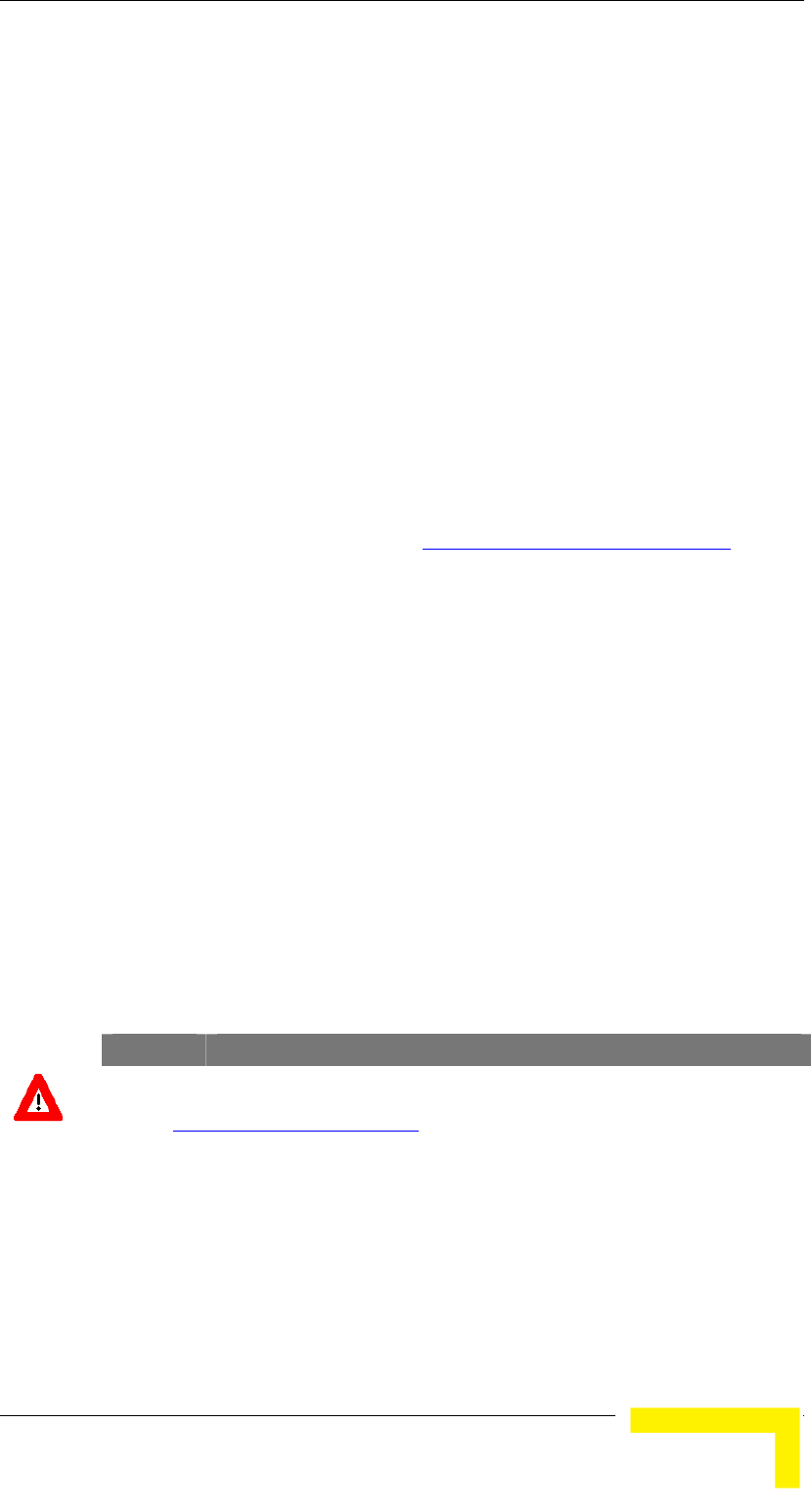
Menus and Parameters
Manual Revision 1.0
4-77
Minimum Contention Window
The Minimum Contention Window parameter determines the time that a
unit waits from the time it has concluded that there are no detectable
transmissions by other units until it attempts to transmit. The
BreezeACCESS VL system uses a special mechanism based on detecting
the presence of a carrier signal and analyzing the information contained
in the transmissions of the AU to estimate the activity of other SUs
served by the AU. The target is to minimize collisions in the wireless
media resulting from attempts of more than one unit to transmit at the
same time.
The system uses an exponential Back-off algorithm to resolve
contention between several units that want to access the wireless
media. The method requires each station to choose a random number N
between 0 and a given number C each time it wants to access the
media. The unit will attempt to access the media only after a time equal
to DIFS (for more details refer to Arbitration Inter-Frame Spacing on
page 4-56) plus N time slots, always checking if a different unit has
accessed the media before. Each time the unit tried to transmit and a
collision happened; the maximum number C used for the random
number selection will be increased to the next available value. The
available values are 7, 15, 31, 63, 127, 255, 511 and 1023.
The Minimum Contention Window parameter is the first maximum
number C used in the back-off algorithm. The higher the number of SUs
served by the same AU, the higher the Minimum Contention Window for
each SU should be.
The available values are 0, 7, 15, 31, 63, 127, 255, 511 and 1023. A
value of 0 means that the contention window algorithm is not used and
that the unit will attempt to access the media immediately after a time
equal to DIFS.
The default value is 15.
CAUTION
A value of 0 disables the contention window back-off algorithm. It should only be used in
point-to-point applications. For more details on configuring units in a point-to-point link
refer to Arbitration Inter-Frame Spacing on page 4-56.

Chapter 4 - Operation and Administration
BreezeACCESSS VL System Manual
4-78
Maximum Contention Window
The Maximum Contention Window parameter defines the upper limit for
the maximum number C used in the back-off algorithm as described in
Minimum Contention Window above.
The available values are 7, 15, 31, 63, 127, 255, 511 and 1023.
The default value is 1023.
Multicast Modulation Level (AU only)
The Multicast Modulation Level parameter defines the modulation level
used for transmitting multicast and broadcast data frames. Multicast
and broadcast transmissions are not acknowledged; therefore if a
multicast or broadcast transmission is not properly received there is no
possibility of retransmitting. It is recommended that you set a lower
modulation level for broadcast and multicast frame transmissions to
increase the probability that they are received without errors.
The Multicast Modulation Level parameter is applicable only to data
frames. Beacons and other wireless management and control frames are
always transmitted at the lowest modulation level according to the Sub
Band.
The minimum value for the Multicast Modulation Level is defined by the
Sub Band in use.
The maximum value for the Multicast Modulation Level is defined by the
Sub Band in use and the HW revision of the unit. Units with HW
revision A support a maximum value of 7, while units with HW revision
B and higher support a maximum value of 8.
For information on how to view the Sub Bands supported by the unit
and the supported parameters’ values and options, refer to Show
Country Dependent Parameters on page 4-9.
The default value is the lowest supported modulation level.

Menus and Parameters
Manual Revision 1.0
4-79
Maximum Modulation Level
When the Adaptive Modulation Algorithm (see Adaptive Modulation
Algorithm on page 4-81) is enabled, it changes the modulation level
dynamically according to link conditions. The purpose is to increase the
probability of using the maximum possible modulation level at any
given moment. Although the algorithm will avoid using modulation
levels that are too high for the prevailing link conditions, it might be
desired under certain conditions to limit the use of higher modulation
levels. If the link quality is not sufficient, it is recommended that the
maximum modulation level be decreased, since higher modulation
levels increase the error rate. In such conditions, a higher Maximum
Modulation Level increases the number or retransmissions before the
modulation level is being reduced by the Adaptive Modulation
Algorithm. A high number of retransmissions reduces the overall
throughput of the applicable SU as well as all other SUs associated with
the same AU.
The link quality can be estimated based on the SNR measurement of the
SU at the AU, which can be viewed in the MAC Address Database option
in the Site Survey menu. If the measured SNR is less than a certain
threshold, it is recommended that the maximum modulation level of the
SU be decreased in accordance with Table 4-9, using the values of
typical sensitivity. It is recommended to add a 2 dB safety margin to
compensate for possible measurement inaccuracy or variance in the
link quality.
NOTE
The SNR measurement at the AU is accurate only when receiving transmissions from
the applicable SU. If necessary, use the Ping Test utility in the Site Survey menu to
verify data transmission.
When the Adaptive Modulation Algorithm is disabled, this parameter
will serve to determine Fixed Modulation Level used for transmissions.
The minimum value for the Maximum Modulation Level is defined by
the Sub Band in use.
The maximum value for the Maximum Modulation Level is defined by
the Sub Band in use and the HW revision of the unit. Units with HW
revision A support a maximum value of 7, while units with HW revision
B and higher support a maximum value of 8.
For information on how to view the Sub Bands supported by the unit
and the supported parameters’ values and options, refer to Show
Country Dependent Parameters on page 4-9.
The default is the highest supported Modulation Level.

Chapter 4 - Operation and Administration
BreezeACCESSS VL System Manual
4-80
Table 4-9: Recommended Maximum Modulation Level*
SNR Maximum Modulation Level
SNR> 23 dB 8
22dB < SNR < 23 dB 7
18 dB< SNR < 22 dB 6
14 dB < SNR < 18 dB 5
11 dB < SNR < 14 dB 4
9 dB < SNR < 11 dB 3
7 dB < SNR < 9 dB 2
6 dB<SNR < 7 dB 1
* the maximum supported value depends on the unit’s HW revision and on the
Max Modulation Level according to the Sub Band.
Average SNR Memory Factor
The Average SNR Memory Factor defines the weight of history (value of
last calculated average SNR) in the formula used for calculating the
current average SNR for received data frames. This average SNR is used
by the ATPC algorithm in the AU and is also included in the Adaptive
Modulation Algorithm information messages transmitted by the AU and
the SU. The higher the value of this parameter, the higher is the weight
of history in the formula.
Available values: -1 to 32. -1 is for no weight for history, meaning that
average SNR equals the last measured SNR.
Default value: 5
Number of HW Retries
The Number of HW Retries parameter defines the maximum number of
times that an unacknowledged packet is retransmitted. When the
Adaptive Modulation Algorithm is disabled, a frame will be dropped
when the number of unsuccessful retransmissions reaches this value.
For details on the effect of this parameter when the Adaptive
Modulation Algorithm is enabled, refer to Adaptive Modulation
Algorithm, on page 4-81.
The available values range is from 1 to 15.
The default value is 10.
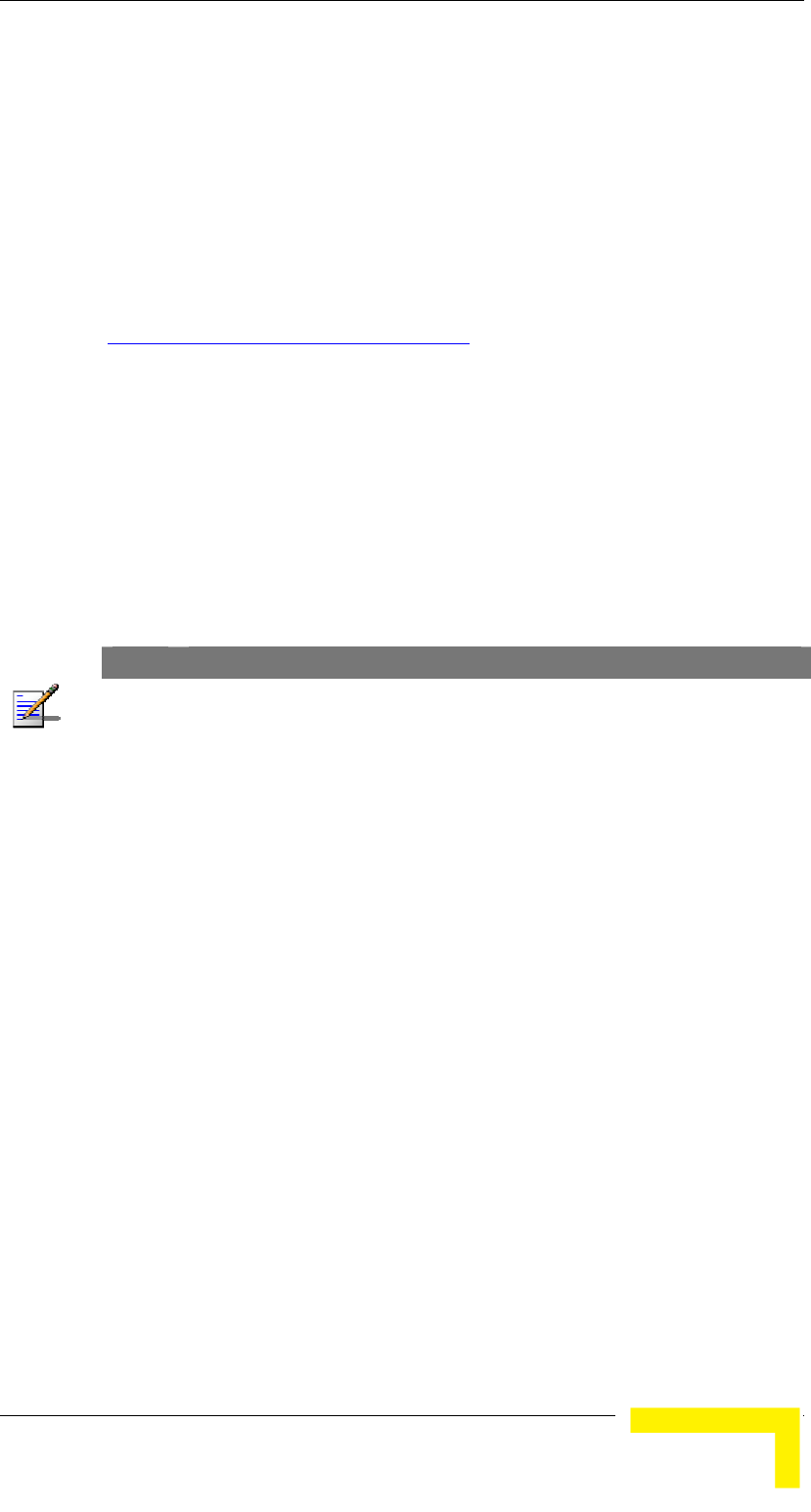
Menus and Parameters
Manual Revision 1.0
4-81
Burst Mode
Burst mode provides an increased throughput by reducing the overhead
associated with transmissions in the wireless media. In a burst
transmission the inter-frame spacing is reduced and data frames are
transmitted without any contention period.
The Burst Mode is available only if Burst Mode is supported by the Sub
Band in use. For information on how to view the Sub Bands supported
by the unit and the supported parameters’ values and options, refer to
Show Country Dependent Parameters on page 4-9.
In AU, the Burst Mode option will be “blocked” upon trying to enable
Burst Mode when the DFS Option is enabled or when using WEP for
data encryption. In SU, the Burst Mode option will be “blocked” upon
trying to enable when using WEP for data encryption.
Burst Mode Option
The Burst Mode Option enables or disables the Burst Mode operation.
The default is Enable.
NOTE
When Burst Mode Option is enabled, the SW Retry feature of the Adaptive Modulation
Algorithm is disabled. Otherwise it is enabled.
Burst Mode Time Interval
The Burst Mode Time Interval defines the burst size, which is the time
in which data frames are sent immediately without contending for the
wireless medium.
The range is 1 to the value of the Maximum Burst Duration defined for
the Sub Band.
The default is 5 milliseconds or the value of Maximum Burst Duration
defined for the Sub Band (the lower of the two values).
Adaptive Modulation Algorithm (Multi Rate)
The Adaptive Modulation Algorithm enables adapting the modulation
level of transmitted data to the prevailing conditions of the applicable
radio link. The algorithm provides Access Units with simultaneous,
adaptive support for multiple Subscriber Units at different modulation
levels, as transmission’s modulation level decisions are made separately
for each associated SU.

Chapter 4 - Operation and Administration
BreezeACCESSS VL System Manual
4-82
Link quality fluctuates due to various environmental conditions.
Dynamically switching between the possible modulation levels increases
the probability of using the maximum modulation level suitable for the
current radio link quality at any given moment.
The decisions made by the Adaptive Modulation Algorithm relate to the
modulation level selected for transmission of new frames (first trial
attempt) as well as the modulation level for retransmissions. The
decisions are based on multiple parameters, including information on
received signal quality (SNR) that is received periodically from the
destination unit, the time that has passed since last transmission to the
relevant unit, and the recent history of successful and unsuccessful
transmissions/retransmissions. In the AU the decision algorithm is
performed separately for each SU.
The transmission/retransmission mechanism operates as follows:
A. Each new frame (first transmission attempt) will be transmitted at a
modulation level selected by the Adaptive Modulation algorithm.
B. If first transmission trial has failed, the frame will be retransmitted
at the same modulation level up to the maximum number of
retransmission attempts defined by the Number of HW Retries
parameter.
C. If the frame was not acknowledged it frame will be moved to the end
of the queue. All other frames in the queue that are intended to the
same destination will be moved as well, to preserve the original
order. This process is referred to as a Software Retry.
D. The frame will be retransmitted at the modulation level selected by
the algorithm for the new retrials sequence. Each retrial sequence
comprises a number of attempts defined by the Number of HW
Retries.
E. The process will be repeated up to a maximum number of Software
Retries defined by the Number of SW Retries parameter. The
Number of SW Retries parameter is not configurable and it is set to
the default of 3 SW Retries. (In units upgraded to SW version 2.0
from a lower version it will be set to the previously configured
value)..
NOTE
When Burst Mode Option is enabled, the SW Retry feature of the Adaptive Modulation
Algorithm is disabled. Otherwise it is enabled.
The Adaptive Modulation Parameters menu includes the following
parameters:

Menus and Parameters
Manual Revision 1.0
4-83
Adaptive Modulation Option
The Adaptive Modulation Option enables or disables the Adaptive
Modulation decision algorithm. When enabled, the algorithm supports
decrease/increase of transmission’s modulation levels between the
lowest possible level to the value configured for the Maximum
Modulation Level parameter. If the Maximum Modulation Level is set at
the lowest possible level, the Adaptive Modulation algorithm has no
effect.
The default selection is Enable.
Minimum Interval Between Adaptive Modulation Messages
The Minimum Interval Between Adaptive Modulation Messages sets the
minimum interval between two consecutive adaptive modulation
messages, carrying information on the SNR of received signals. The
messages in the AU include SNR information on all the SUs associated
with it.
The available range is from 1 to 3600 seconds.
The default is 4 seconds.

Chapter 4 - Operation and Administration
BreezeACCESSS VL System Manual
4-84
Service Parameters
The Service Parameters menu enables defining user filtering and
MIR/CIR parameters.
The Service Parameters menu includes the following parameters:
! User Filtering Parameters (SU only)
! MIR and CIR Parameters
User Filtering Parameters (SU only)
The User Filtering Parameters submenu enables defining the IP
addresses of user devices authorized to access the wireless media for
security and/or control purposes. In addition, it can be used to enable
the transmission and reception of specific protocol frames. These
filtering options do not affect management frames sent to or generated
by the unit.
The User Filtering Parameters menu provides the following options:
User Filtering Option
The User Filtering Option disables or enables the User Filtering feature.
The following options are available:
! Disable, which means no filtering.
! IP Protocol Only, which means only IP Protocol packets pass.
! User Defined Addresses Only, which means only IP frames from/to
IP addresses included in the User Filter Addresses list pass.
! PPPoE Protocol Only, which means only PPPoE messages pass
(Ethernet type 0x8863 and 0x8864).
The default selection is Disable.
Set User Filter Address
The Set User Filter Address option enables entering up to 8 IP
addresses from/to which IP frames are to pass if the User Defined
Addresses Only option is selected in the User Filtering Option
parameter.
The default for all addresses is 0.0.0.0.
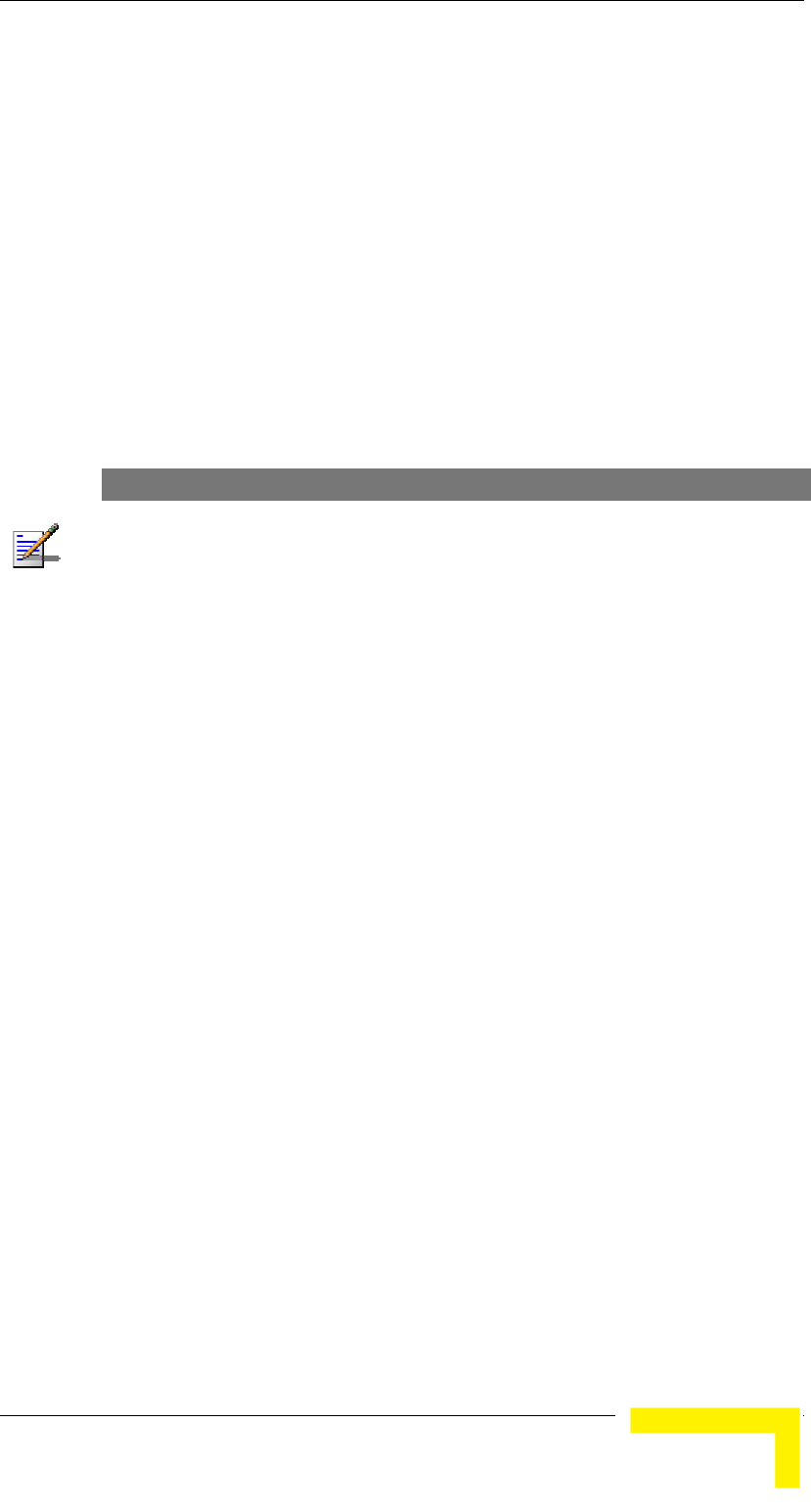
Menus and Parameters
Manual Revision 1.0
4-85
Set User Filter Mask
The Set User Filtering Mask option enables entering subnet masks for
each of the User Filter IP Address entries.
The default for all subnet masks is 255.255.255.255.
Set User Filter Range
The Set User Filter Range option enables defining a range of addresses
for each of the User Filter IP Address entries. The range includes the
base address.
Available values range from 0 to 255.
The default value is 0 (not used).
NOTE
Use either a mask or range, but not both, to define a group of user filter addresses. If
the range is other than 0, than the mask is ignored.
If IP broadcast packets are supposed to reach a device behind an SU unit, the
broadcast IP address must be included in the list of user filter addresses.
Delete a User Filtering Entry
The Delete a User Filtering Entry option enables deleting a selected
entry from the User Filtering list. The entry is replaced by the default
value.
Delete all User Filtering Entries
The Delete All User Filtering Entries option enables deleting all entries
from the User Filtering list. The list entries are replaced by the default
values.
Show User Filtering Parameters
The Show All User Filtering Parameters option displays the current
value of the User Filtering Option and the list of User Filtering
addresses, subnet masks and ranges.

Chapter 4 - Operation and Administration
BreezeACCESSS VL System Manual
4-86
MIR and CIR Parameters
The CIR (Committed Information Rate) specifies the minimum data rate
guaranteed to the relevant subscriber. The MIR (Maximum Information
Rate) value specifies the maximum data rate available for burst
transmissions, provided such bandwidth is available.
Under normal conditions, the actual Information Rate (IR) is between
the applicable CIR and MIR values, based on the following formula:
IR=CIR+K(MIR - CIR).
In this formula K is between 0 and 1 and is determined dynamically by
the AU according to overall demand in the cell and the prevailing
conditions that influence the performance of the wireless link. In some
situations the minimum rate (CIR) cannot be provided. This may result
from high demand and poor wireless link conditions and/or high
demand in over-subscribed cells. When this occurs, the actual
information rate is lower than the CIR.
The simple solution for managing the information rate in such cases
can result in an unfair allocation of resources, as subscribers with a
higher CIR actually receive an IR lower than the CIR designated for
subscribers in a lower CIR bracket.
A special algorithm for graceful degradation is incorporated into the AU,
ensuring that the degradation of performance for each individual
Subscriber Unit is proportional to its CIR.
The MIR/CIR algorithm uses buffers to control the flow of data. To
balance the performance over time, a special Burst Duration algorithm
is employed to enable higher transmission rates after a period of
inactivity. If no data is received from the Ethernet port during the last N
seconds, the unit is allowed to transmit N times its CIR value without
any delay. For example, after a period of inactivity of 0.5 seconds, a unit
with CIR = 64Kbps can transmit up to 64Kbits x 0.5 = 32Kbits without
any delay.
MIR: Downlink (SU only)
Sets the Maximum Information Rate of the downlink from the AU to the
SU. The MIR value cannot be lower than the corresponding CIR value.
Available values range and default value are shown in Table 4-10 on
page 4-87.
The actual value will be the entered value rounded to the nearest
multiple of 128 (N*128).
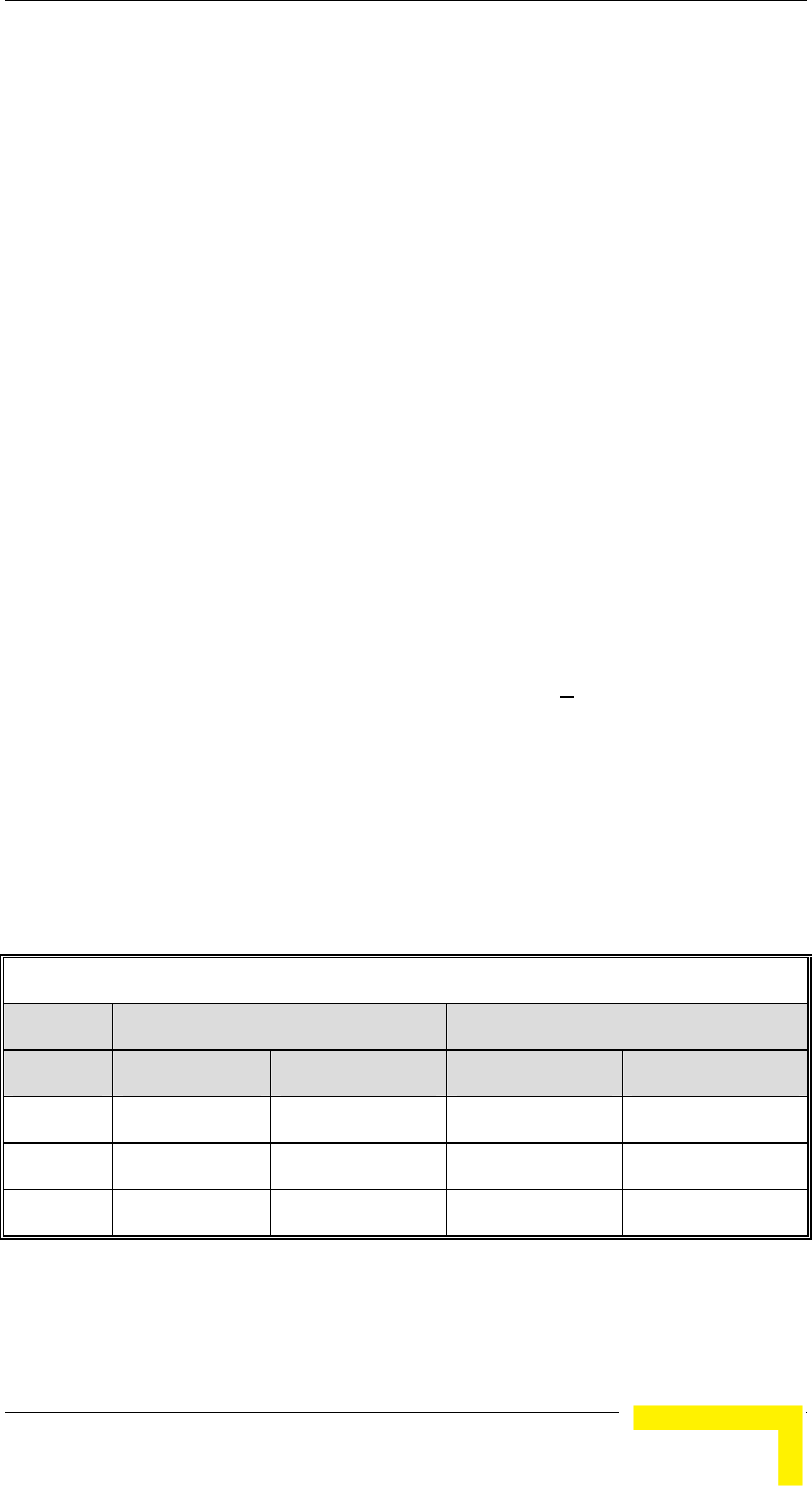
Menus and Parameters
Manual Revision 1.0
4-87
MIR: Uplink (SU only)
Sets the Maximum Information Rate of the up-link from the SU to the
AU. The MIR value cannot be lower than the corresponding CIR value.
Available values range and default value are shown in Table 4-10 on
page 4-87.
The actual value will be the entered value rounded to the nearest
multiple of 128 (N*128).
CIR: Downlink (SU only)
Sets the Committed Information Rate of the down-link from the AU to
the SU. The CIR value cannot be higher than the corresponding MIR
value.
Available values range and default value are shown in Table 4-10 on
page 4-87.
The actual value will be the entered value rounded to the nearest
multiple of 128 (N*128).
CIR: Uplink (SU only)
Sets the Committed Information Rate of the up link from the SU to the
AU. The CIR value cannot be higher than the corresponding MIR value.
Available values range and default value are shown in Table 4-10 on
page 4-87.
The actual value will be the entered value rounded to the nearest
multiple of 128 (N*128).
Table 4-10: MIR and CIR Ranges and Defaults
MIR (Uplink and Downlink) CIR (Uplink and Downlink
Unit Type Range (Kbps) Default (Kbps) Range (Kbps) Default (Kbps)
SU-3 128-2,048 2,048 0-2,048 0
SU-6 128-3,968 3,968 0-3,968 0
SU-54 128-32,896 32,896 0-32,896 0

Chapter 4 - Operation and Administration
BreezeACCESSS VL System Manual
4-88
Maximum Burst Duration (SU and AU)
Sets the maximum time for accumulating burst transmission rights
according to the Burst Duration algorithm.
Available values range from 0 to 2000 (milliseconds).
The default value is 5 (milliseconds), enabling a maximum burst of
(0.005 X CIR) Kbps after a period of inactivity of 5 milliseconds or more.
Maximum Delay (SU only)
Sets the maximum permitted delay in the buffers system. Since certain
applications are very sensitive to delay, if relatively high delays are
permitted, these applications may suffer from poor performance due to
data accumulation in the buffers from other applications, such as FTP.
The Maximum Delay parameter limits the number of available buffers.
Data that is delayed more than the permitted maximum delay is
discarded. If the SU supports applications that are very sensitive to
delay, the value of the Maximum Delay should be decreased.
Valid values range from 300 to 10000 (milliseconds).
The default value is 5000 (milliseconds).
Graceful Degradation Limit (AU only)
Sets the limit on using the graceful degradation algorithm. In cases of
over demand, the performance of all SUs is degraded proportionally to
their CIR (IR=(100%-k%) x CIR). The graceful degradation algorithm is
used as long as k ≤K, where K is the Graceful Degradation Limit.
Beyond this point the simple “brute force” algorithm is used. The
Graceful Degradation Limit should be raised in proportion to the
demand in the cell. The higher the expected demand in a cell, the higher
the value of the Graceful Degradation Limit. Higher demand can be
expected in cases of significant over subscription and/or in
deployments where a high number of subscribers are in locations are
not enabled for proper communication with the AU at the highest data
rate.
The available values range from 0 to 70 (%).
The default value is 70 (%).

Menus and Parameters
Manual Revision 1.0
4-89
MIR Only Option (AU only)
When the MIR Only Option is enabled, it forces the MIR/CIR algorithm
to use MIR values only. The MIR/CIR algorithm determines the actual
information rate for each of the supported SUs under changing
conditions of demand, based on the configured CIR and MIR values.
When the MIR Only Option is enabled, the MIR/CIR algorithm is
overridden and forced to operate with MIR values only. For example, the
AU attempts to enable all SUs to transmit/receive information at the
specified MIR value. When enabled, the graceful degradation algorithm,
which is a part of the CIR/MIR algorithm, is also disabled.
The default is Enable.
Show MIR/CIR Parameters
Displays the current values of the MIR and CIR parameters.
Show Service Parameters
Displays the current values of the Service Parameters, including the
user filtering parameters and MIR and CIR parameters.

Chapter 4 - Operation and Administration
BreezeACCESSS VL System Manual
4-90
Security Parameters
BreezeACCESS VL can support encryption of authentication messages
and/or data frames using one of two encryption standards:
! WEP Wireless Equivalent Privacy algorithm. WEP is defined in the
IEEE 802.11 Wireless LAN standard and is based on the RSA’s RC4
encryption algorithm.
! AES Advanced Encryption Standard. AES is defined by the National
Institute of Standards and Technology (NIST) and is based on
Rijndael block cipher.
The following parameters are available through the Security Parameters
menu (in certain units some or all of the security options may not be
available):
! Authentication Algorithm
! Data Encryption Option
! Security Mode
! Default Key (SU only)
! Default Multicast Key (AU only)
! Key # 1 to Key # 4
! Promiscuous Authentication (AU only)
Authentication Algorithm
The Authentication Algorithm option determines the operation mode of
the selected unit. The two following options are available:
! Open System: An SU configured to Open System can only associate
with an AU also configured to Open System. In this case, the
authentication encryption algorithm is not used.
! Shared Key: The authentication messages are encrypted. An SU
configured to use a Shared Key can only be authenticated by an AU
configured to use a Shared Key, provided the applicable Key (which
means both the key number and its content) in the AU is identical
to the key selected as the Default Key in the SU.
The default is Open System.
NOTE
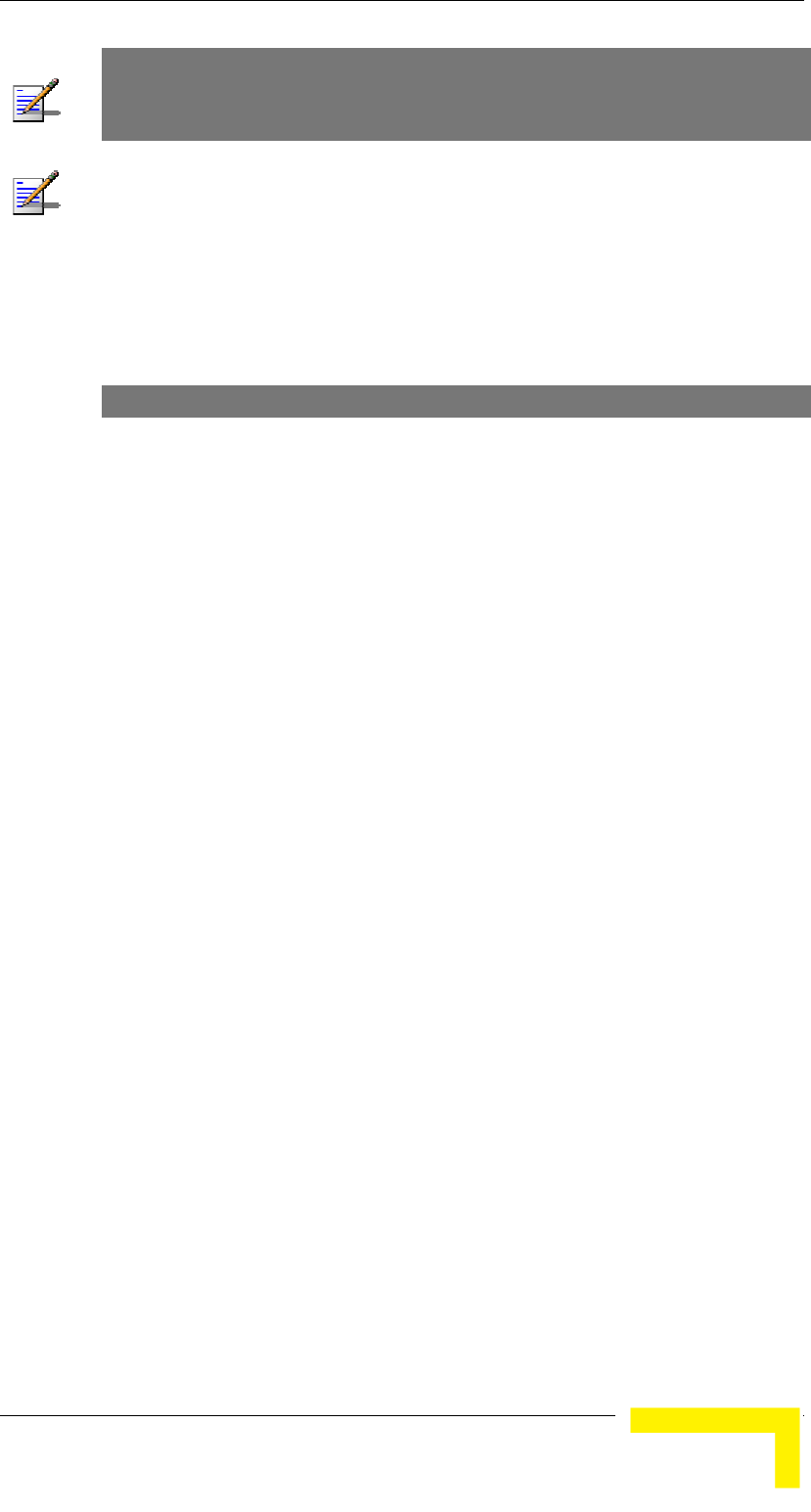
Menus and Parameters
Manual Revision 1.0
4-91
NOTE
The Shared Key option cannot be selected before at least one Key is defined. In the SU,
a Default Key that refers to a valid Key must be selected.
The AU and all the SUs it serves should be configured to the same Authentication
Algorithm option. Mixed operation is not supported.
Data Encryption Option
The Data Encryption Option option allows enabling or disabling data
encryption. When enabled, all data frames are encrypted.
The default is Disable.
NOTE
The AU and all the SUs it serves should be configured to the same Data Encryption
Option. Mixed operation is not supported.
Security Mode
The Security Mode option enables selecting the algorithm to be used for
encrypting the authentication messages and/or data frames.
The available options are WEP and AES.
The default is WEP.
Default Key (SU only):
The Default Key defines the Key to be used for encrypting/decrypting
the authentication messages (Shared Key mode) and/or data frames
(Data Encryption enabled). The AU learns the Default Key from the SU,
and it may use different keys when authenticating and/or
communicating with different SUs.
Available values range from 1 to 4.
The default is KEY # 1.
Default Multicast Key (AU only):
The Multicast Default Key defines the Key to be used for
encrypting/decrypting multicasts and broadcasts when Data
Encryption is enabled.
Available values range from 1 to 4.
The default is KEY # 1.

Chapter 4 - Operation and Administration
BreezeACCESSS VL System Manual
4-92
Key # 1 to Key # 4
The Key # options enables defining the encryption key to be used for
initializing the pseudo-random number generator that forms a part of
the encryption/decryption process. The Keys must be set before the
Shared Key authentication algorithm or Data Encryption can be used.
To support proper operation, both the Key # and the content must be
identical at both sides of a wireless link.
Each Key is a string of 32 hexadecimal numbers. For security reasons,
it is a “write only” parameter, displayed as a string of asterisks (“*”).
The default for all 4 Keys is 000…0 (a string of 32 zeros), which means
no key.
Promiscuous Authentication (AU only)
The Promiscuous Authentication mode enables new SUs to join an
active cell where Shared Key operation and/or Data Encryption is used,
even if this SU does not have the correct security parameters (or if it
runs a lower SW version that does not support the security features).
After the SU joins the cell it should be remotely configured with the
proper parameters (or upgraded). Once the SU is configured properly,
the Promiscuous Mode should be disabled.
The default is Disable.
NOTE
Do not leave the AU in the mode of Promiscuous Authentication enabled for prolonged
periods. Use it only when absolutely necessary, perform the required actions as quickly
as possible and disable it. The unit will return automatically to Promiscuous
Authentication disabled mode after reset.

Menus and Parameters
Manual Revision 1.0
4-93
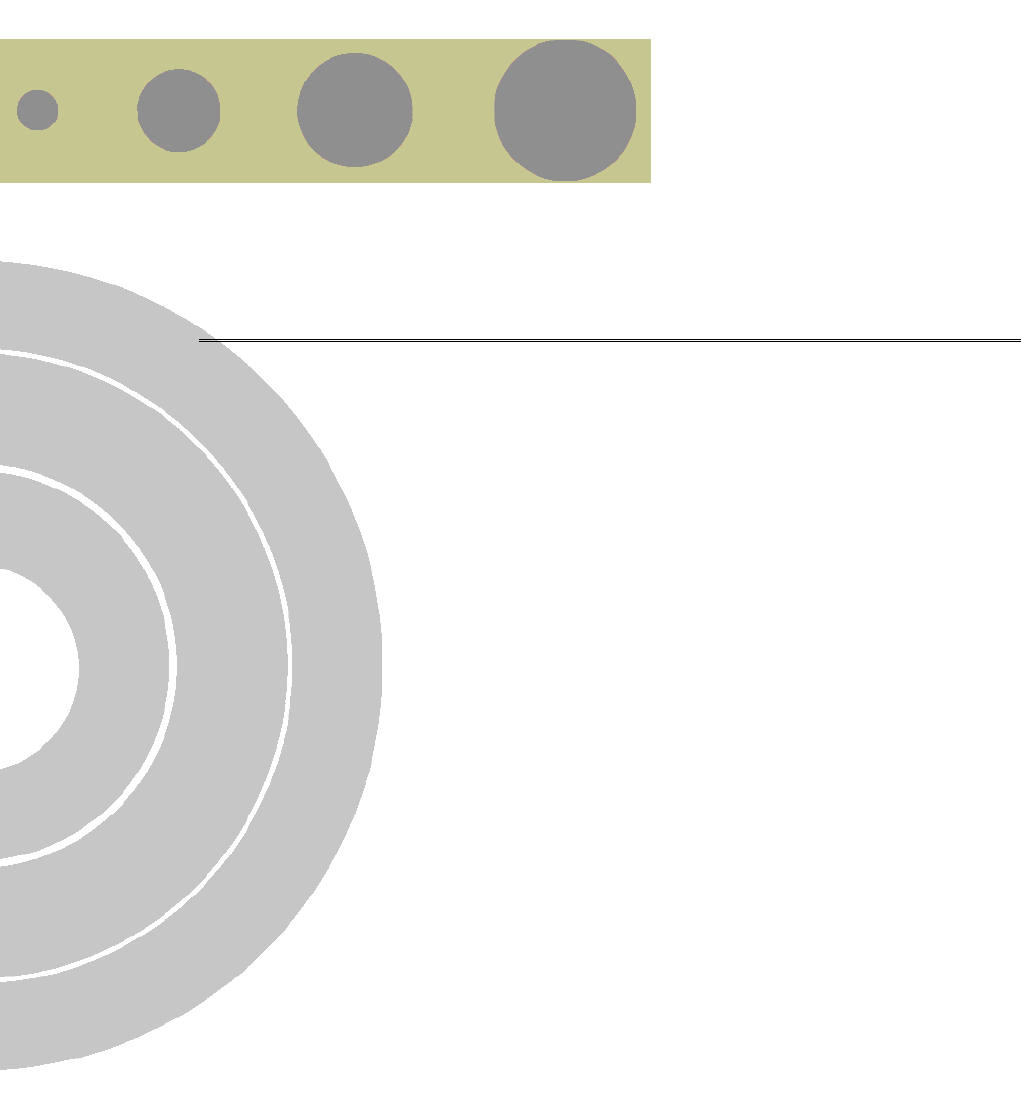
A
A
Appendix A - Software Version
Loading Using TFTP
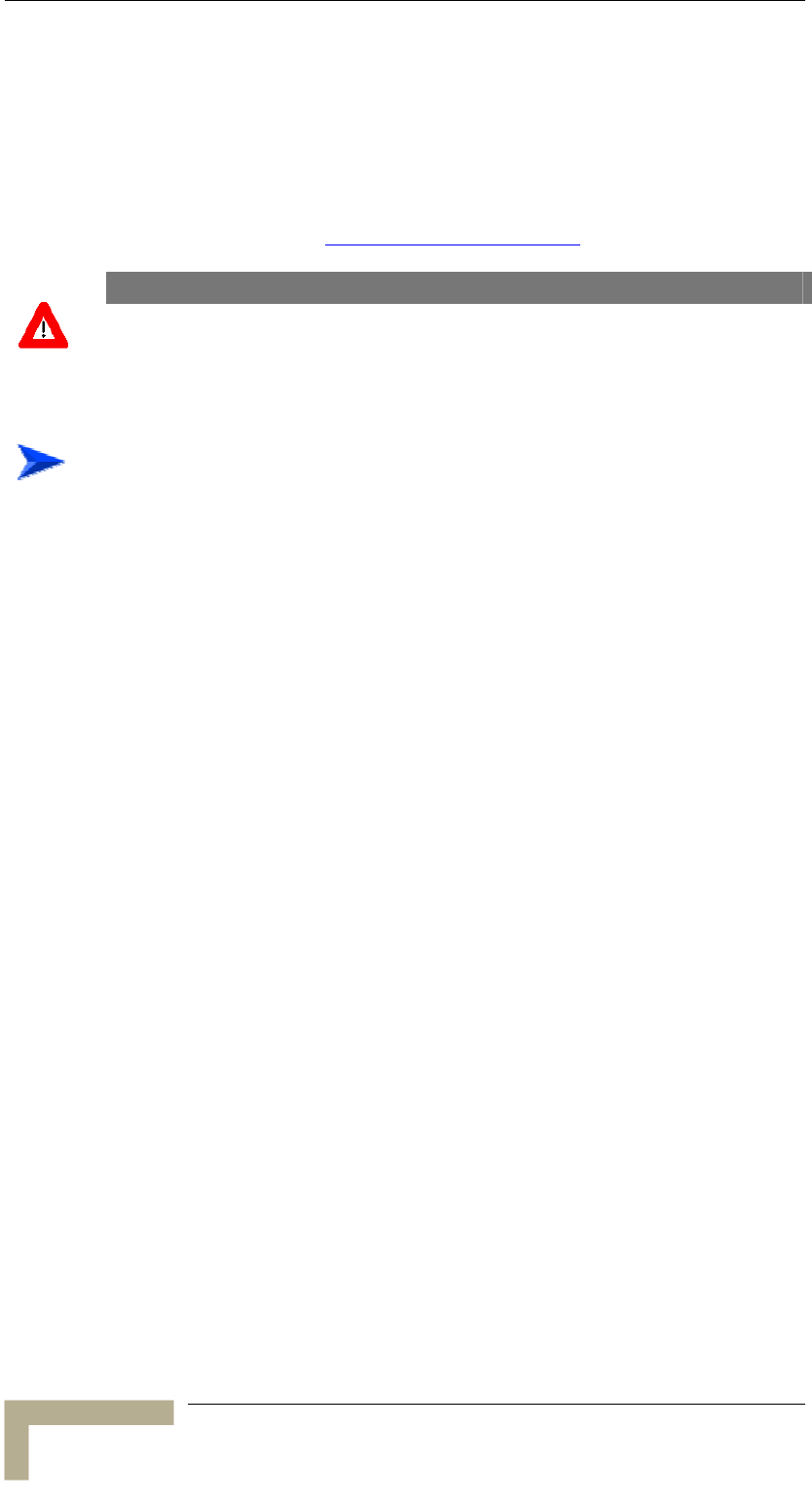
Appendix A - Software Version Loading Using TFTP
BreezeACCESSS VL System Manual
A
-2
Firmware upgrades to the unit's FLASH memory can be performed by a
simple loading procedure using a TFTP application. Before performing
an upgrade procedure, be sure you have the correct files and most
recent instructions.
Upgrade packages can be obtained from the Technical Support section
of Alvarion's web site, http://www.alvarion.com/.
CAUTION
Shutting down power to the unit before completion of the loading procedure may cause
the unit to be inoperable.
1. Verify that IP connectivity to the required unit is established.
2. Ensure that the IP address of the PC from which the upgrade is to
be performed belongs to the same subnet as the unit to be
upgraded, unless the unit is behind a router. If the unit is behind a
router, verify that the unit is configured with the correct Default
Gateway Address.
3. To view the current IP parameters of the unit, use the Monitor
program by connecting the PC to the unit either directly or via
Telnet. To access the IP parameters via the Monitor program:
A. From the Main Menu select 1 - Info Screens.
B. From the Info Screen menu select 2 - Show Basic
Configuration. The current basic configuration is displayed,
including the run time values for the IP Address, Subnet Mask
and Default Gateway Address parameters.
4. To modify any of the IP parameters:
A. From the Main Menu, select 3 - Basic Configuration.
B. To configure the IP address, select: 1 - IP Address.
C. To configure the subnet mask, select 2 - Subnet Mask.
D. To configure the default gateway address, select 3 - Default
Gateway Address.
5. To verify the connection, PING the unit's IP address and verify that
PING replies are being received.
To load software versions:

Menus and Parameters
Manual Revision 1.0
A
-3
6. Use the TFTP utility, with the following syntax, to perform the
upgrade:
tftp -i hostaddress put sourcefile [destinationfile]
where -i is for binary mode and hostaddress is the IP address of the
unit to be upgraded. put causes the PC client to send a file to the
hostaddress.
7. The original sourcefile name of SW files supplied by Alvarion is in
the structure uX_Y_Z.bz, where u is the unit type (a for AU, s for
SU) and X.Y.Z is the version number.
8. destinationfile is the name of the file to be loaded. Use the SNMP
write community <SnmpWriteCommunity>.bz to define the
destination filename. The default SNMP write community is private.
For example, to load the upgrade file a1_0_6.bz to an AU whose IP
address is 206.25.63.65: tftp -i 206.25.63.65 put a1_0_6.bz
private.bz
9. When the loading is complete, the following message is displayed,
indicating completion of the TFTP process:
Download operation has been completed successfully
10. The unit decompresses the loaded file and checks the integrity of
the new version. The new version replaces the previous shadow
version only after verification. If verification tests fail, the loaded
version will be rejected. Among other things that are tested, the unit
will reject a file if either the file name or the version number
matches the current Main versions. The unit will also reject a file
designated for a different unit type, e.g. an AU upgrade file with the
prefix a in the original file name will not be accepted by SUs.
11. The FLASH memory can store two software versions. One version is
called Current and the second version is called Shadow. The new
version is loaded into the Shadow (backup) FLASH memory. To
check that the new firmware was properly downloaded and verified,
view the firmware versions stored in the FLASH, as follows:
A. From the Main Menu, select 2 - Unit Control.
B. From the Unit Control menu, select 5 - Flash Memory Control.
C. From the Flash Memory Control menu, select S - Show Flash
Versions. The following information is displayed:

Appendix A - Software Version Loading Using TFTP
BreezeACCESSS VL System Manual
A
-4
Flash Versions
============
Running from :Main Version
Main Version File Name :1_0_5.bz
Main Version Number :1.0.5
Shadow Version File Name :1_0_6.bz
File Name Number :1.0.6
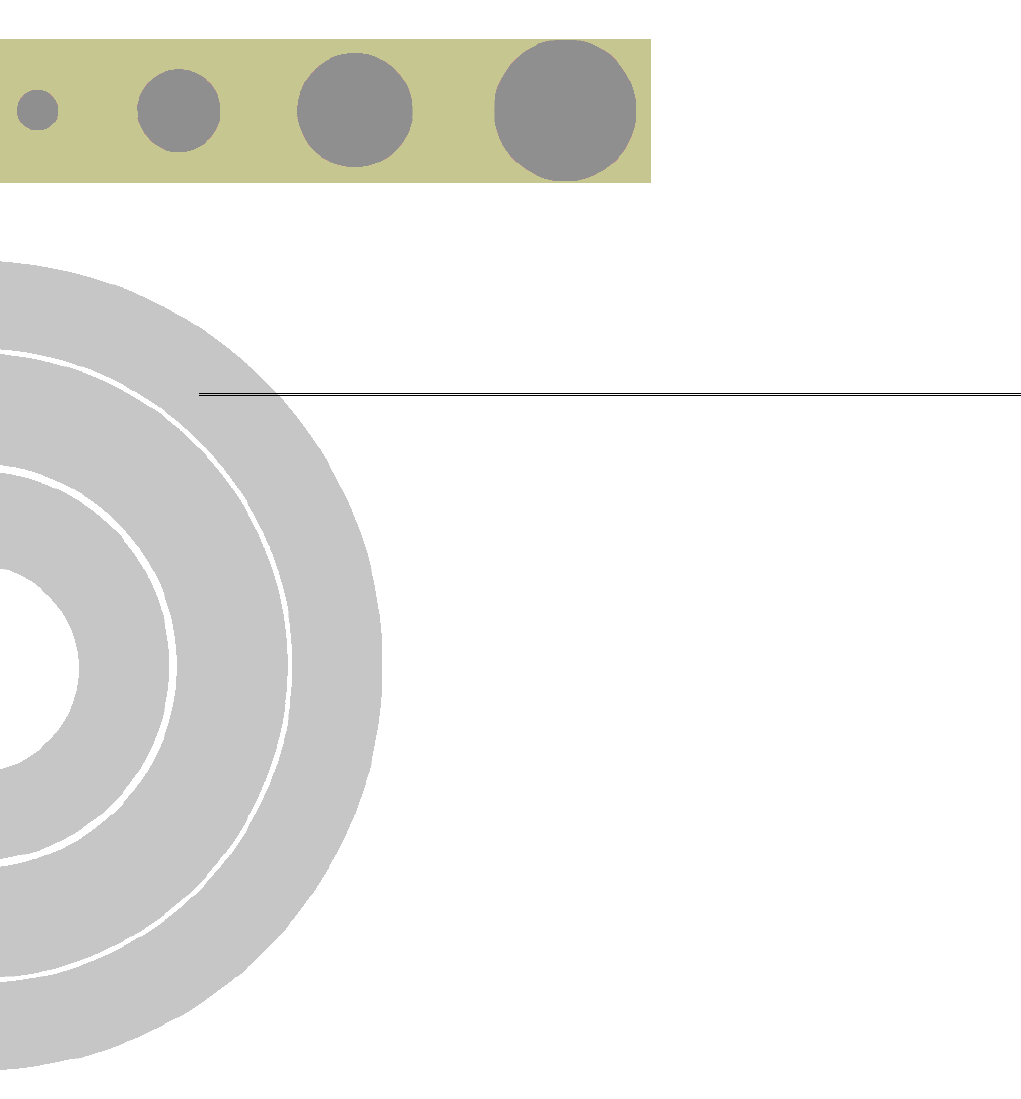
B
B
Appendix B - File Download and
Upload Using TFTP

Appendix B - File Download and Upload Using TFTP
BreezeACCESSS VL System Manual
B-2
The BreezeACCESS VL File Download/Upload feature simplifies the
task of remotely configuring a large number of units using TFTP
protocol. By downloading the configuration file to a PC it is possible to
view all the parameters configured for the unit, as a plain ASCII text file.
It is necessary to edit the file using a simple editor and remove certain
parameters or change their values prior to uploading the configuration
to another unit. The file loading procedure can also be used for
uploading a feature license file or an updated country code file to
multiple units.
When multiple configurations are being done simultaneously, which
means that the file is being uploaded to several units, it is
recommended that the file will include only the required parameters.
In the configuration file, the following three fields represent each
parameter:
1. A symbolic string similar to the name of the parameter in the
Monitor program, followed by "=".
2. The value of the parameters, which uses the same values as the
Monitor program.
3. An optional comment. If used, the comment should start with a ";"
character.
An unknown parameter will be ignored. A known parameter with a
value that is invalid or out of range will be set by the unit to its default
value.
Use the SNMP write community string (the default is “private”) to define
both the uploaded file (put) and the downloaded file (get). The file
should be transferred in ASCII mode.
Use the extension cfg for a configuration file.
Use the extension cmr for the Operator Defaults file.
Use the extension fln for a Feature License file.
Use the extension ccf for a Country Code file.
Feature license and country code files include multiple strings, where
each string is applicable only for a certain unit identified by its MAC
address. When uploading a feature license or a country code file to
multiple units, each unit will accept only the parts that are applicable
for itself.

Menus and Parameters
Manual Revision 1.0
B-3
Examples:
1. To upload the configuration file using a DOS based TFTP Client to
an SU whose IP address is 206.25.63.65, enter:
tftp 206.25.63.65 put Suconf private.cfg
2. To download the Operator Defaults file from the same unit, enter:
tftp 206.25.63.65 get private.cmr Suconf
3. To upload the Feature Upgrade file to the same unit, enter:
tftp 206.25.63.65 put private.fln Suconf
4. To upload the Country Code file from to same unit, enter:
tftp 206.25.63.65 put private.ccf Suconf
NOTE
The Configuration File mechanism is common to BreezeACCESS VL and BreezeNET B
product lines. The Configuration File includes also parameters that are applicable only
to BreezeNET B products: burst Mode Option and Burst Interval. Do not attempt to
change the default values of these parameters.

Appendix B - File Download and Upload Using TFTP
BreezeACCESSS VL System Manual
B-4
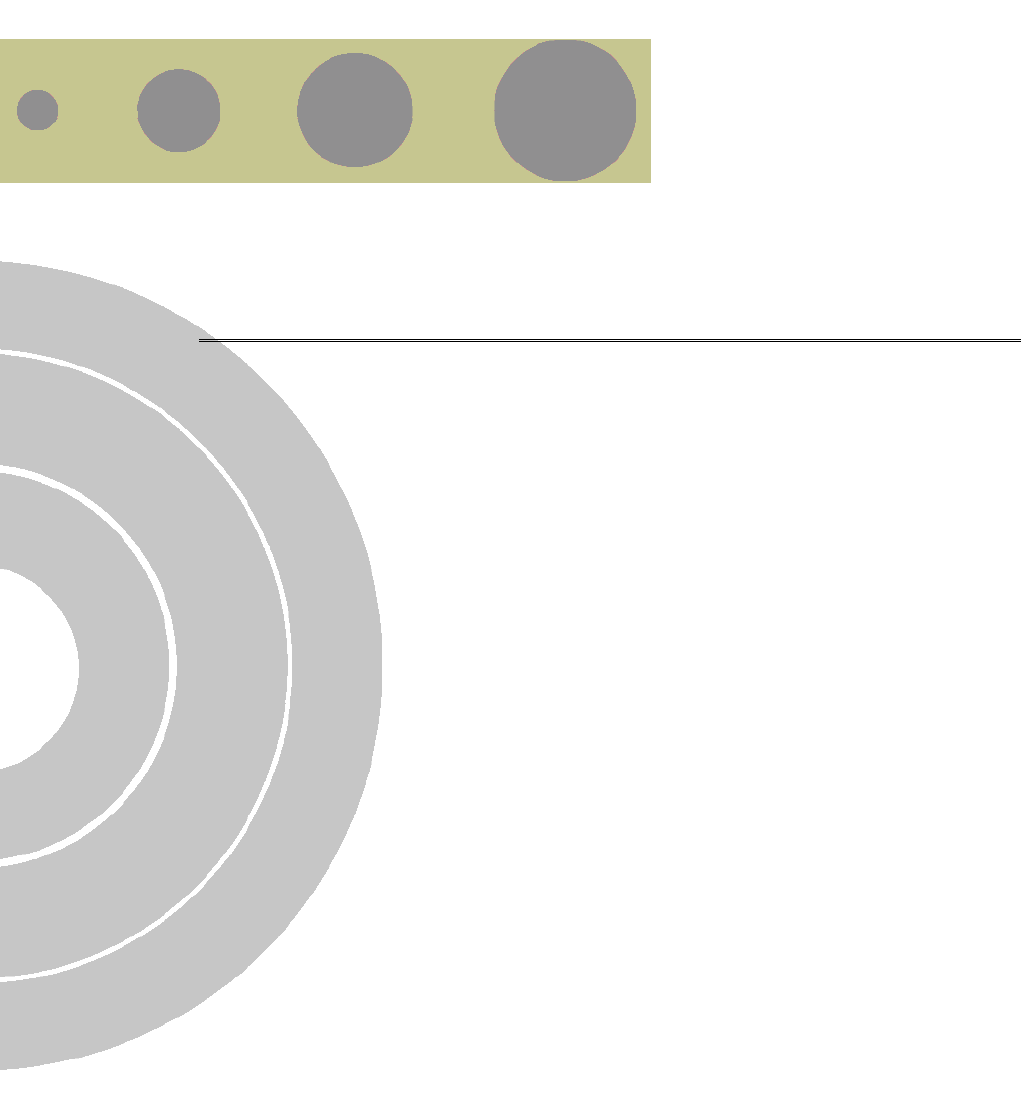
C
C
Appendix C - Using the Set Factory
Defaults Utility
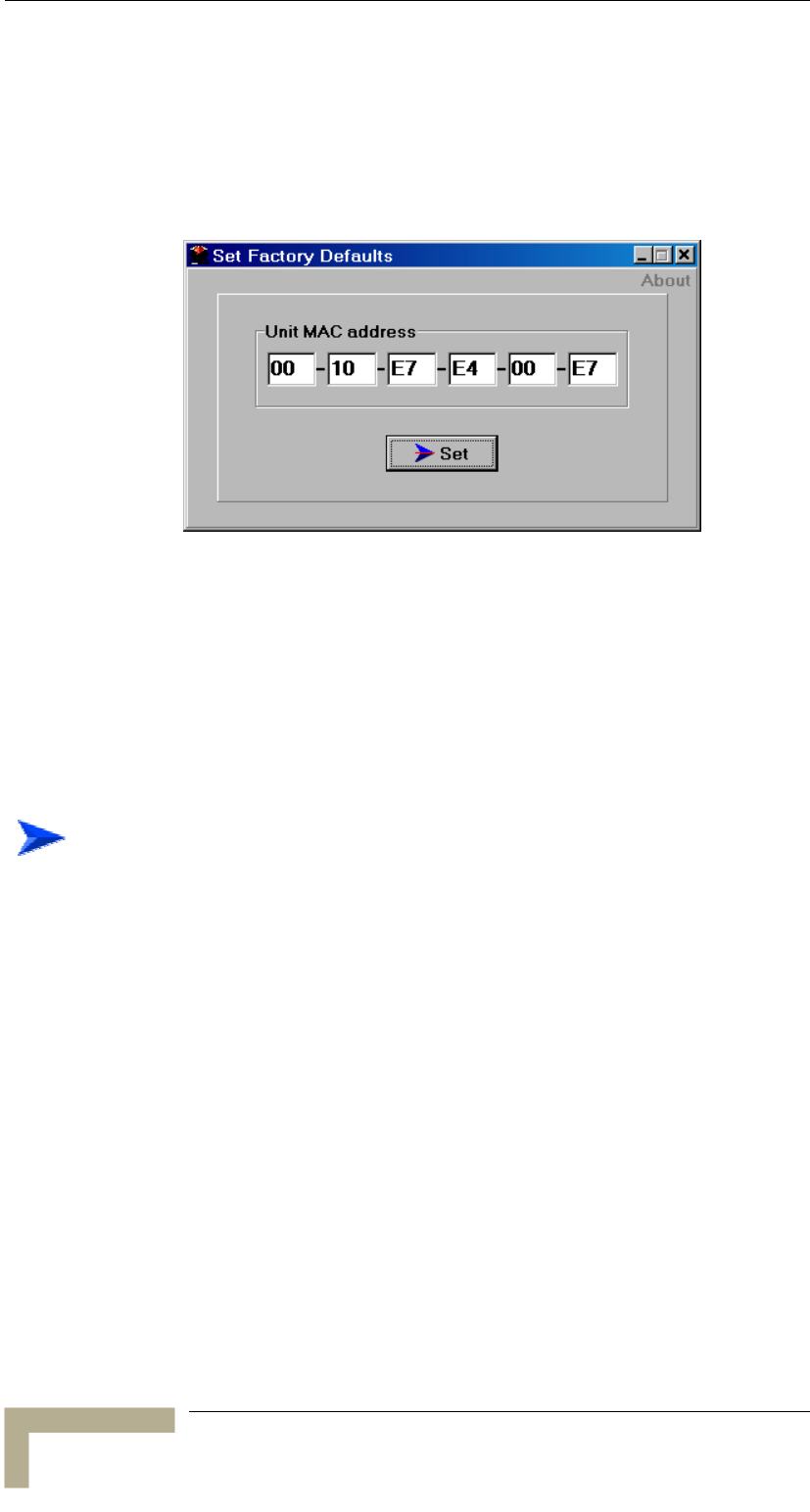
Appendix C - Using the Set Factory Defaults Utility
BreezeACCESSS VL System Manual
C-2
The Set Factory Defaults utility is intended to enable management
access to a unit in cases where such access is not possible due to wrong
or unknown configuration of certain parameters. This includes cases
such as unknown Management VLAN ID and wrong management
access filtering.
The utility accesses the unit by sending a special packet. Access to the
unit is based on its MAC address, which must be entered in the Unit
MAC address field.
The set unit defaults feature is only available via the Ethernet port.
1. Connect the PC with the Set Factory Defaults utility to the Ethernet
port of the unit.
2. Enter the unit’s MAC address.
3. Click on the Set button.
This utility performs the same operation as Set Complete Factory
Defaults, restoring the default factory configuration of all parameters,
except to Passwords, general FTP parameters and AU’s Frequency.
To set factory defaults:
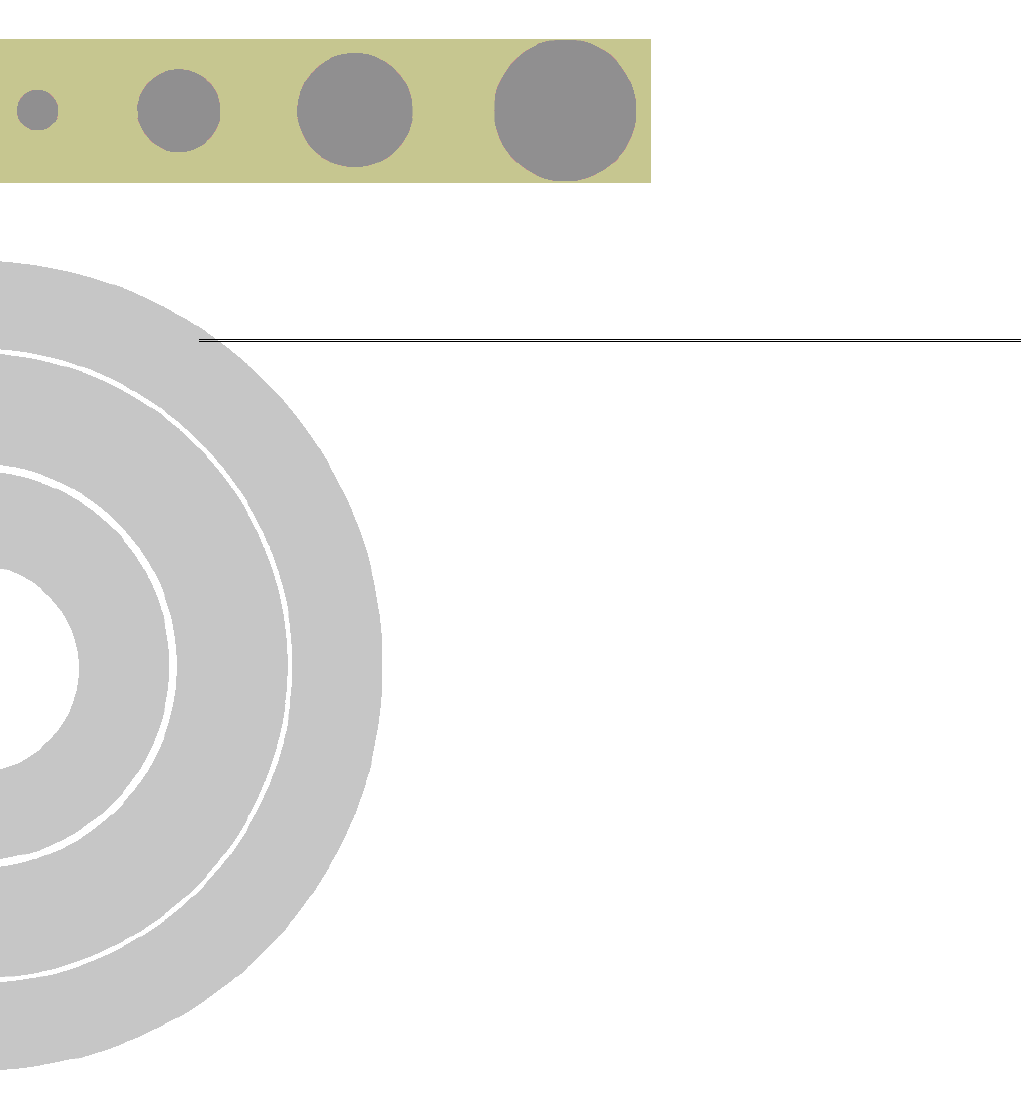
D
D
Appendix D - Preparing the Indoor to
Outdoor SU Cable
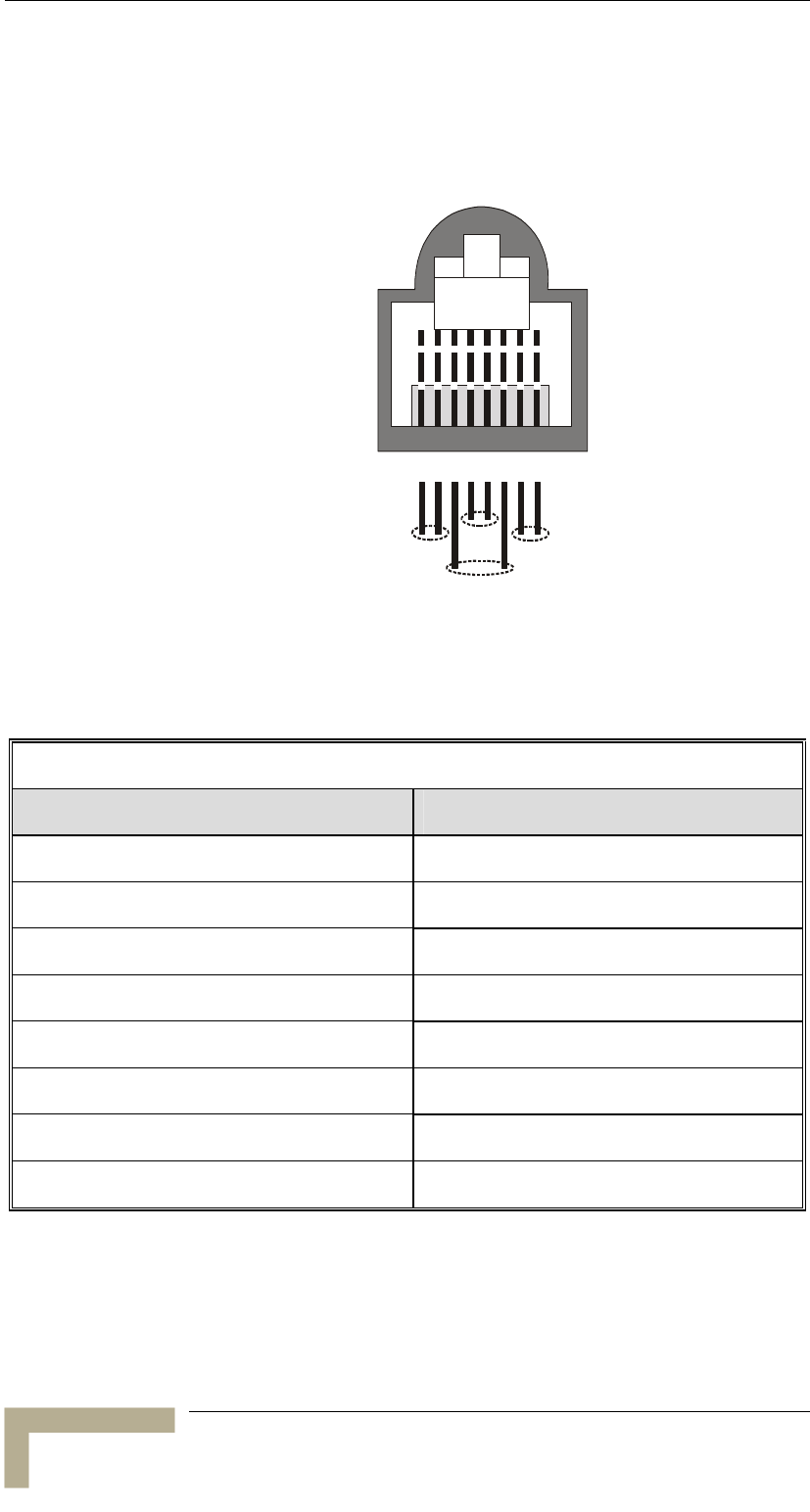
Appendix D - Preparing the Indoor to Outdoor SU Cable
BreezeACCESSS VL System Manual
D-2
The Indoor-to-Outdoor cable provides pin-to-pin connection on both
ends.
Figure D-1 shows the wire pair connections required for the Indoor-to-
Outdoor cable.
12345678
1 + 2 4 + 5
7 + 8
3 + 6
Figure D-1: Ethernet Connector Pin Assignments
The color codes used in cables that supplied by Alvarion with crimped
connectors are as listed in the following table:
Table D-1: Cable Color Codes
Wire color Pin
Blue 1
Blue/white 2
Orange 3
Orange/white 6
Brown 4
Brown/white 5
Green 7
Green/white 8

Menus and Parameters
Manual Revision 1.0
D-3
Use a crimp tool for RJ-45 connectors to prepare the wires, insert them
into the appropriate pins and use the crimp tool to crimp the connector.
Make sure to do the following:
1. Remove as small a length as possible of the external jacket. Verify
that the external jacket is well inside the service box to ensure good
sealing.
2. Take back the shield drain wire before inserting the cable into the
RJ-45 connector, to ensure a good connection with the connector's
shield after crimping.

E
E
Appendix E - Supported MIBs and
Traps
In this Appendix:
BreezeACCESS agents support the following MIBs:
! MIB II (RFC1213)
! BRIDGE MIB (RFC1286)
! Alvarion Private MIB (breezeAccessVLMib)
The following are described in this Appendix:
! BreezeACCESS VL System Object Identifiers, on page E-2.
! BreezeAccessVLMib, on page E-3
! Supported Traps, on page E-38.
NOTE
The BreezeAccessVLMib is used for both BreezeACCESS VL (AU, SU) and BreezeNET
B (BU, RB) product lines. Some of the parameters are only applicable to one of the
product lines.

Appendix E - Supported MIBs and Traps
BreezeACCESSS VL System Manual
E-2
BreezeACCESS VL System Object
Identifiers
Table E-1: BreezeACCESS VL System Object Identifiers
Object Path
alvarion OID =1.3.6.1.4.1.12394 {(iso(1) org(3) dod(6) internet(1)
private(4) enterprises(1) alvarion(12394)}
products OID = 1.3.6.1.4.1.12394.1 {alvarion 1}
breezeAccessVLMib OID = 1.3.6.1.4.1.12394.1.1 {products 1}
alvarionOID OID = 1.3.6.1.4.1.12394.4 {alvarion 4}
brzAccessVLOID OID = 1.3.6.1.4.1.12394.4.1 {alvarionOID 1}
brzAccessVLAU OID = 1.3.6.1.4.1.12394.4.1.1 {brzAccessVLOID 1}
brzAccessVLSU OID = 1.3.6.1.4.1.12394.4.1.2 {brzAccessVLOID 2}
brzAccessVLAU-BS OID = 1.3.6.1.4.1.12394.4.1.4 {brzAccessVLOID 4}
brzAccessVLAU-SA OID = 1.3.6.1.4.1.12394.4.1.5 {brzAccessVLOID 5}
brzAccessVLSU-6-1D OID = 1.3.6.1.4.1.12394.4.1.11 {brzAccessVLOID 11}
brzAccessVLSU-6-BD OID = 1.3.6.1.4.1.12394.4.1.12 {brzAccessVLOID 12}
brzAccessVLSU-24-BD OID = 1.3.6.1.4.1.12394.4.1.13 {brzAccessVLOID 13}
brzAccessVLSU-BD OID = 1.3.6.1.4.1.12394.4.1.14 {brzAccessVLOID 14}
brzAccessVLSU-54-BD OID = 1.3.6.1.4.1.12394.4.1.15 {brzAccessVLOID 15}
brzAccessVLSU-3-1D OID = 1.3.6.1.4.1.12394.4.1.16 {brzAccessVLOID 16}
brzAccessVLSU-3-4D OID = 1.3.6.1.4.1.12394.4.1.17 {brzAccessVLOID 17}
brzNetB-BU-B14 OID = 1.3.6.1.4.1.12394.4.1.21 {brzAccessVLOID 21}
brzNetB-BU-B28 OID = 1.3.6.1.4.1.12394.4.1.22 {brzAccessVLOID 22}
BrzNetB-RB-B14 OID = 1.3.6.1.4.1.12394.4.1.31 {brzAccessVLOID 31}
brzNetB-RB-B28 OID = 1.3.6.1.4.1.12394.4.1.32 {brzAccessVLOID 32}
brzAccessVLProducts OID = 1.3.6.1.4.1.12394.4.1.3 {brzAccessVLOID 3}
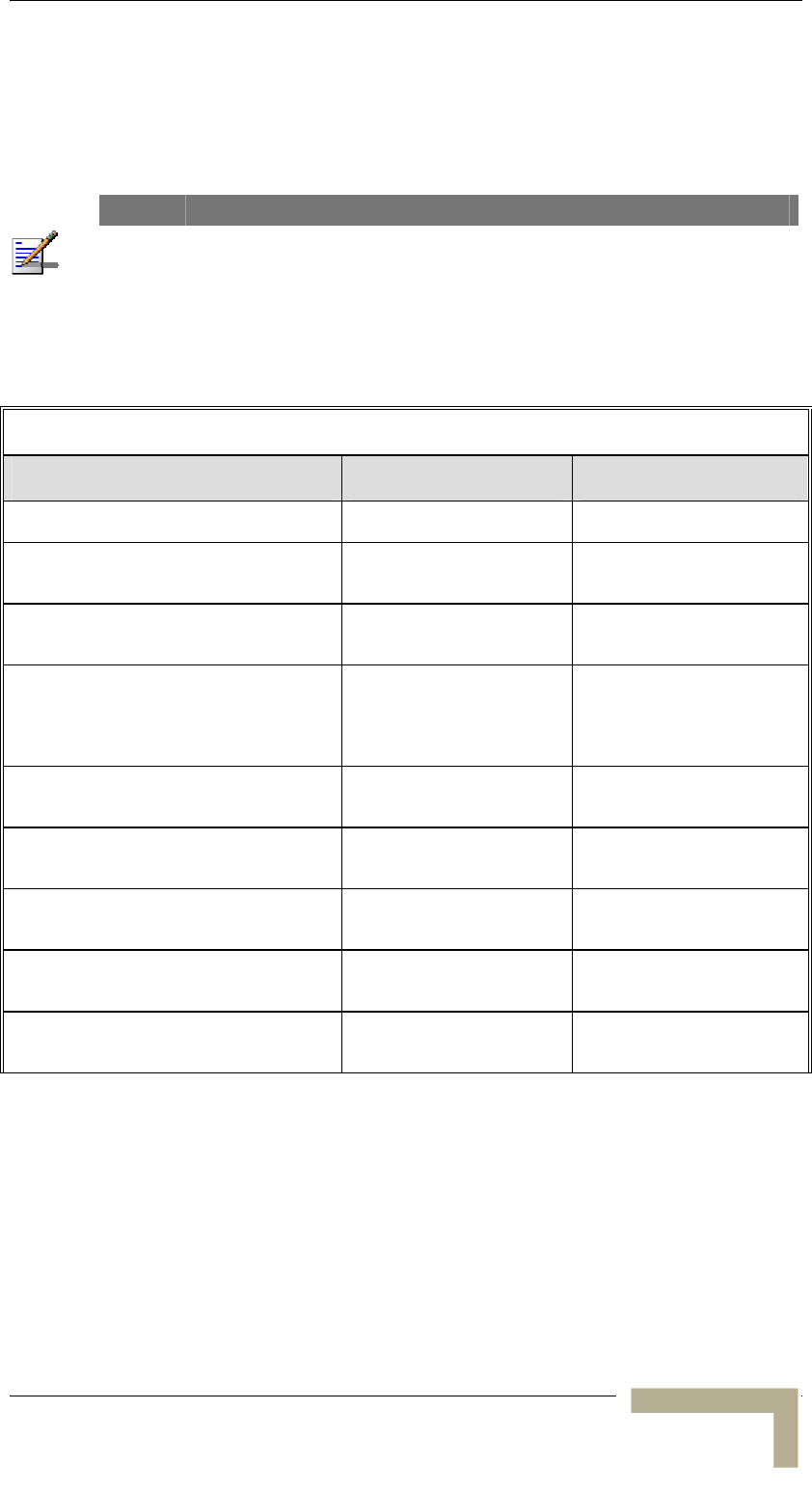
breezAccessVLMib
Manual Revision 1.0
E-3
breezAccessVLMib
OBJECT IDENTIFIER = 1.3.6.1.4.1.12394.1.1
NOTE
An * is used instead of the brzaccVL prefix.
System Information Parameters
Table E-2: System Information Parameters
MIB Parameter Description Value/Range
*SysInfo
(breezeAccessVLMib 1)
System Information
Parameters
*UnitHwVersion
(*SysInfo 1)
Applicable to all units.
Read-only: Hardware
platform version.
DisplayString (SIZE(0..32))
*RunningSoftwareVersion
(*SysInfo 2)
Applicable to all units.
Read-only: Running
software version.
DisplayString (SIZE(0..32))
*RunningFrom
(*SysInfo 3)
Applicable to all units.
Read-only: The memory
(main or shadow) from
which the current version
is running from.
Integer
mainVersion (1)
shadowVersion (2)
*MainVersionNumber
(*SysInfo 4)
Applicable to all units.
Read only: Main software
version number.
DisplayString (SIZE(0..32))
*MainVersionFileName
(*SysInfo 5)
Applicable to all units.
Read-only: Main software
version file name.
DisplayString (SIZE(0..32))
*ShadowVersionNumber
(*SysInfo 6)
Applicable to all units.
Read-only: Shadow
software version number.
DisplayString (SIZE(0..32))
*ShadowVersionFileName
(*SysInfo 7)
Applicable to all units.
Read-only: Shadow
software version file name.
DisplayString (SIZE(0..32))
*UnitMacAddress
(*SysInfo 8)
Applicable to all units.
Read-only: Unit hardware
MAC address.
MAC address

Appendix E - Supported MIBs and Traps
BreezeACCESSS VL System Manual
E-4
Table E-2: System Information Parameters
MIB Parameter Description Value/Range
*UnitType
(*SysInfo 9)
Applicable to all units.
Read-only: Unit type.
Integer
auBS (1)
auSA (2)
su-6-BD (3)
su-24-BD (4)
su-6-1D (5)
bu-B14 (6)
bu-B28 (7)
rb-B14 (8)
rb-B28 (9)
su-BD (10)
su-54-BD (11)
su-3-1D (12)
su-3-4D) (13)
*AssociatedAU
(*SysInfo 10)
Applicable to SU/RB.
Read-only: Associated
AU/BU MAC address.
MAC address
*NumOfAssociationsSinceLastReset
(*SysInfo 11)
Applicable to all units.
Read-only: The number of
associations since last
reset, including duplicate
associations (re-
associations).
Integer
*CurrentNumOfAssociations
(*SysInfo 13)
Applicable to AU only. Not
applicable to BreezeNET B
products. Read-only. The
number of subscriber units
currently associated with
the AU.
Integer
na (65535)
*UnitBootVersion
(*SysInfo 14)
Applicable to all units.
Read-only: The Boot
software version.
DisplayString (SIZE(0..32))
*RadioBand
(*SysInfo 15)
Applicable to all units.
Read-only: The radio band
of the unit.
Integer
band-5-8GHz (1)
band-5-4GHz (2)
band-4-9GHz (3)
band-5-2GHz (3)
*CurrentEthernetPortState
(*SysInfo 16)
Applicable to all units.
Read-only. The current
state of the Ethernet port.
Integer
HalfDuplexAnd10Mbps (1)
FullDuplexAnd10Mbps (2)
HalfDuplexAnd100Mbps 3)
FullDuplexAnd100Mbps (4)
linkDown (5)
*TimeSinceLastReset
(*SysInfo 17)
Applicable to all units.
Read-only. The elapsed
time since last reset.
DisplayString (SIZE(0..32))
*CountryDependentParameters
(*SysInfo 18)
Country Dependent
Parameters
*CountryCode
(*CountryDependentParameters 1)
Applicable to all units.
Read only. The country
code and country or
country group name that is
supported by the unit
DisplayString (SIZE(0..32))
*CountryDependentParamsTable
(*CountryDependentParameters 2)
Applicable to all units. Not
accessible. A table of
country dependent
parameters.

breezAccessVLMib
Manual Revision 1.0
E-5
Table E-2: System Information Parameters
MIB Parameter Description Value/Range
*CountryDependentParameterEntry
(*CountryDependentParamsTable 1)
Applicable to all units. Not
accessible. An entry in the
country dependent
parameters table.
*CountryDependentParameterTableIdx
(*CountryDependentParameterEntry 1)
Applicable to all units.
Read only. The sub-band
ID of the entry in the
Country Dependent
Parameters table. Serves
also as index for the table
entry.
Integer
*CountryDependentParameterFrequenci
es
(*CountryDependentParameterEntry 2)
Applicable to all units.
Read only. The
frequencies included in the
applicable sub-band entry.
DisplayString
*AllowedBandwidth
(*CountryDependentParameterEntry 3)
Applicable to all units.
Read only. The bandwidth
when using the applicable
the sub-band.
Integer
*MaxAllowedTxPower
(*CountryDependentParameterEntry 4)
Applicable to all units.
Read only. The maximum
allowed Tx power when
using the applicable sub-
band.
Integer
*MaxEIRP
(*CountryDependentParameterEntry 5)
Applicable to all units.
Read only. The maximum
allowed EIRP when using
the applicable sub-band.
Integer
*MinModulationLevel
(*CountryDependentParameterEntry 6)
Applicable to all units.
Read only. The minimum
supported modulation
level.
Integer
level1 (1)
level2 (2)
level3 (3)
level4 (4)
level5 (5)
level6 (6)
level7 (7)
level8 (8)
*MaxModulationLevel
(*CountryDependentParameterEntry 7)
Applicable to all units.
Read only. The maximum
supported modulation
level.
Integer
level1 (1)
level2 (2)
level3 (3)
level4 (4)
level5 (5)
level6 (6)
level7 (7)
level8 (8)
*BurstModeSupport
(*CountryDependentParameterEntry 8)
Applicable to all units.
Read only. The supported
Burst Mode Option.
Integer
supported (1)
notSupported (2)
*MaximumBurstDuration
(*CountryDependentParameterEntry 9)
Applicable to all units.
Read only. Applicable only
if Burst Mode Option is
supported. The maximum
supported burst duration.
Integer
*DfsSupport
(*CountryDependentParameterEntry 10)
Applicable to AU/BU only.
Read only. The supported
DFS Option.
Integer
supported (1)
notSupported (2)

Appendix E - Supported MIBs and Traps
BreezeACCESSS VL System Manual
E-6
Table E-2: System Information Parameters
MIB Parameter Description Value/Range
*AuthenticationEncryptionSupport
(CountryDependentParameters 3)
Applicable to all units.
Read only. The supported
Authentication Encryption
Option.
Integer
supported (1)
notSupported (2)
*DataEncryptionSupport
(CountryDependentParameters 4)
Applicable to all units.
Read only. The supported
Data Encryption Option.
Integer
supported (1)
notSupported (2)
*AESEncryptionSupport
(CountryDependentParameters 5)
Applicable to all units.
Read only. The supported
AES Encryption Option.
Integer
supported (1)
notSupported (2)
*AntennaGainChange
(*SysInfo 19)
Applicable to all units.
Indicates whether the
Antenna Gain parameter is
changeable of fixed.
Integer
supported (1)
notSupported (2)
Unit Control Parameters
Table E-3: Unit Control Parameters
MIB Parameter Description Value/Range
*UnitControl
(breezeAccessVLMib 2)
*ResetUnit
(*UnitControl 1)
Applicable to all units.
Resets the unit and
applies new parameter
values.
Integer
cancel (1)
resetSystemNow (2)
*SetDefaults
(*UnitControl 2)
Applicable to all units.
Sets unit configuration to
Defaults values after the
next reset.
completeFactory: All
parameters revert to
Factory Defaults values
partialFactory: All
parameters revert to
Factory Defaults values,
except the parameters
required for maintaining
wireless connectivity.
completeOperator: All
parameters revert to
Operator Defaults values
partialOperator: All
parameters revert to
Operator Defaults values,
except the parameters
required for maintaining
wireless connectivity.
Integer
NoDefaultSettingRequested
(0),
completeFactory (1)
partialFactory (2)
completeOperator (3)
partialOperator (4)
cancelCurrentPendingRequest
(5)
*UnitName
(*UnitControl 3)
Applicable to all units. The
unit name.
DisplayString (SIZE(32))
A string of up to 32 printable
ASCII characters.

breezAccessVLMib
Manual Revision 1.0
E-7
Table E-3: Unit Control Parameters
MIB Parameter Description Value/Range
*FlashMemoryControl
(*UnitControl 4)
Applicable to all units.
Reset And Boot From
Shadow Version:
Activates the shadow
version.
Use Running Version
After Reset: The currently
active version will become
the main version and will
be activated after next
reset.
Integer
resetAndBootFrom
ShadowVersion (1)
useRunningVersion
AfterReset (2)
cancel (3)
*TelnetLogoutTimer
(*UnitControl 5)
Applicable to all units.
Time-out of management
via Telnet. Automatic exit
if the program is inactive
for the defined time.
Integer
1-999 (minutes)
*SaveCurrentConfigurationAs
OperatorDefaults
(*UnitControl 6)
Applicable to all units.
Saves the current
configuration as Operator
Defaults.
Integer
saveAsDefaults (1)
cancel (2)
*ExitTelnet
(*UnitControl 7)
Applicable to all units. Exit
the Telnet Monitor
session.
Integer
cancelOperation (1)
exit (2)
*UnitPasswords
(*UnitControl 8)
Applicable to all units.
Unit passwords.
*ReadOnlyPassword
(*UnitPasswords 1)
Applicable to all units. The
User (read only)
password.
DisplayString (SIZE(8)).
Up to 8 printable ASCII
characters.
*InstallerPassword
(*UnitPasswords 2)
Applicable to all units. The
Installer password.
DisplayString (SIZE(8)).
Up to 8 printable ASCII
characters.
*AdminPassword
(*UnitPasswords 3)
Applicable to all units. The
Administrator password.
This is also the SNMP
Write Community String.
DisplayString (SIZE(8)).
Up to 8 printable ASCII
characters.
*EthernetNegotiationMode
(*UnitControl 9)
Applicable to all units.
Ethernet port mode of
operation.
Integer
force10MbpsAnd
HalfDuplex (1)
force10MbpsAnd
FullDuplex (2)
force100MbpsAnd
HalfDuplex (3)
force100MbpsAnd
FullDuplex (4)
autoNegotiationMode (5)
*FTPParameters
(*UnitControl 10)
Applicable to all units.
FTP parameters
*FTPServerParams
(*FTPParameters 1)
Applicable to all units.
General FTP server
parameters.
*FTPServerUserName
(*FTPServerParams 1)
Applicable to all units. The
user name to be used for
access to the FTP server
DisplayString (SIZE(20)).
Up to 18 printable ASCII
characters.
*FTPServerPassword
(*FTPServerParams 2)
Applicable to all units. The
password to be used for
access to the FTP server
DisplayString (SIZE(20)).
Up to 18 printable ASCII
characters.

Appendix E - Supported MIBs and Traps
BreezeACCESSS VL System Manual
E-8
Table E-3: Unit Control Parameters
MIB Parameter Description Value/Range
*FTPClientIpAddress
(*FTPParameters 3)
Applicable to all units. The
IP address of the FTP
stack in the unit.
IP address
*FTPServertIpaddress
(*FTPServerParams 4)
Applicable to all units. The
IP address of the FTP
server
IP address
*FTPClientMask
(*FTPParameters 5)
Applicable to all units. The
IP MASK of the FTP stack
in the unit.
IP address
*FTPGatewayIPAddress
(*FTPParameters 6)
Applicable to all units. The
FTP Default Gateway IP
address.
IP address
*FTPSwDownload
(*FTPParameters 2)
Applicable to all units. SW
download parameters.
*FTPSwFileName
(*FTPSwDownload 1)
Applicable to all units. The
name of the SW file to be
downloaded.
DisplayString (SIZE(80)).
Up to 20 printable ASCII
characters. An empty string is
not allowed.
*FtpSwDownloadSourceDir
(*FTPSwDownload 2)
Applicable to all units. The
source directory of the
required file in the FTP
server
DisplayString (SIZE(80)).
Up to 80 printable ASCII
characters. Use “.” To clear
field.
*DownloadSwFile
(*FTPSwDownload 3)
Applicable to all units.
Execution of the SW
download operation.
Integer
downloadFile (1)
cancel (2)
*ConfigurationFileLoading
(*FTPParameters 3)
Applicable to all units.
Configuration file and
Operator Defaults file
download/upload
parameters.
*ConfigurationFileName
(*ConfigurationFileLoading 1)
Applicable to all units. The
name of the configuration
file to be
downloaded/uploaded.
DisplayString (SIZE(80)).
Up to 20 printable ASCII
characters. An empty string is
not allowed.
*OperatorDefaultsFileName
(*ConfigurationFileLoading 2)
Applicable to all units. The
name of the Operator
Defaults file to be
downloaded/uploaded.
DisplayString (SIZE(80)).
Up to 20 printable ASCII
characters. An empty string is
not allowed.
*FTPConfigurationFileSourceDir
(*ConfigurationFileLoading 3)
Applicable to all units. The
source directory of the
required file in the FTP
server
DisplayString (SIZE(80)).
Up to 80 printable ASCII
characters. Use “.” To clear
field.
*ExecuteFTPConfigurationFileLoading
(*ConfigurationFileLoading 4)
Applicable to all units.
Execution of the file
download/upload
operation.
Integer
executeFTPGetConfiguration
File (1)
executeFTPPutConfiguration
File (2)
executeFTPGetOperator
Defaults (3)
executeFTPPutOperator
Defaults (4)
cancel (5)
*EventLogFileUploading
(*FTPParameters 4)
Applicable to all units.
Event Log file upload
parameters.

breezAccessVLMib
Manual Revision 1.0
E-9
Table E-3: Unit Control Parameters
MIB Parameter Description Value/Range
*EventLogFileName
(*EventLogFileUploading 1)
Applicable to all units. The
name of the event log file
to be uploaded.
DisplayString (SIZE(80)).
Up to 20 printable ASCII
characters.
*EventLogDestinationDir
(*EventLogFileUploading 2)
Applicable to all units. The
destination directory for
the event logd file in the
FTP server
DisplayString (SIZE(80)).
Up to 80 printable ASCII
characters. Use “.” To clear
field.
*UploadEventLogFile
(*EventLogFileUploading 3)
Applicable to all units.
Execution of the event log
upload operation
Integer
uploadFile (1)
cancel (2)
*LoadingStatus
(*UnitControl 11)
Applicable to all units. The
status of an FTP or TFTP
loading process.
Integer
inProcess (1)
successful (2)
failed (3)
*EventLogFileParams
(*UnitControl 12)
Event Log parameters
*EventLogPolicy
(*EventLogFileParams 1)
Applicable to all units. The
lowest severity of events
to be logged.
Integer
message (1)
warning (2)
error (3)
fatal(4)
logNone(5)
*EraseEventLog
(*EventLogFileParams 2)
Applicable to all units.
Erase the log file.
Integer
eraseEventLog (1)
cancel(2)
*SysLocation
(*UnitControl 13)
Applicable to all units. The
unit location.
DisplayString (SIZE(0..34))
*FeatureUpgrade
(*UnitControl 14)
Feature Upgrade
parameters
*FeatureUpgradeManually
(*FeatureUpgrade 1)
Applicable to all units.
Upgrade unit to support
new feature.
DisplayString (SIZE(32..64))
License string: 32 to 64
hexadecimal digits.
Network Management Parameters
Table E-4: Network Management Parameters
MIB Parameter Description Value/Range
*NwMngParameters
(breezeAccessVLMib 3)
Network management
parameters.
*AccessToNwMng
(*NwMngParameters 1)
Applicable to all units. The
port to be used for remote
management.
Integer
fromwirelessOnly (1)
fromEthernetOnly (2)
fromBothWirelessnAndEthernet (3)
na (255)
*NwMngFilter
(*NwMngParameters 2)
Applicable to all units.
Disables or enable IP
address based filtering of
management messages on
one or both ports.
Integer
disable (1)
activateOnEthernetPort (2)
activateOnWirelessPort (3)
activateOnBothWirelessAndEthernet (4)
na (255)

Appendix E - Supported MIBs and Traps
BreezeACCESSS VL System Manual
E-10
Table E-4: Network Management Parameters
MIB Parameter Description Value/Range
mngIpFilterTable
(*NwMngParameters 3)
Applicable to all units. A
table of up to 10 IP
addresses of stations that
are authorized to access the
unit for management
purposes. Not accessible.
mngIpFilterEntry
(mngIpFilterTable 1)
Applicable to all units. A
Management IP Filter Table
entry. Not accessible.
*NwMngIpAddress
(mngIpFilterEntry 1)
Applicable to all units. An IP
address in the Management
IP Filter Table entry.
IP address
*NwMngIpTableIdx
(mngIpFilterEntry 2)
Applicable to all units.
Read-only. A table index for
an entry in the Management
IP Filter Table.
Integer
1-10
*DeleteOneNwIpAddr
(*NwMngParameters 4)
Applicable to all units.
Deletes a single selected
entry from the Management
IP Filter Table.
Integer
cancelOperation (0)
deleteEntry (1…10)
na (255)
*DeleteAllNwIpAddrs
(*NwMngParameters 5)
Applicable to all units.
Deletes all entries from the
Management IP Filter Table.
Integer
deleteAll (1)
cancelOperation (2)
na (255)
*AccessToNwTrap
(*NwMngParameters 6)
Applicable to all units.
Enables or disables the
sending of SNMP traps.
Integer
disable (1)
enable (2)
mngTrapTable
(*NwMngParameters 7)
Applicable to all units. A
table of up to 10 IP
addresses of stations to
which to send SNMP traps.
Not accessible.
mngTrapEntry
(mngTrapTable 1)
Applicable to all units. A
Management Trap Table
entry. Not accessible.
*NwMngTrapCommunity
(mngTrapEntry 1)
Applicable to all units. The
trap community associated
with the applicable entry in
the Management Trap
Table.
DisplayString (SIZE(14))
Up to 14 printable ASCII characters.
*NwMngTrapAddress
(mngTrapEntry 2)
Applicable to all units. An IP
address in the Management
Trap Table.
IP address
*NwMngTrapTableIdx
(mngTrapEntry 3)
Applicable to all units. Read
only. Index for an entry in
the Management Trap
Table.
Integer
1-10
*DeleteOneTrapAddr
(*NwMngParameters 8)
Applicable to all units.
Deletes a single selected
entry from the Management
Trap Table.
Integer
cancelOperation (0)
deleteEntry (1…10)
na (255)
*DeleteAllTrapAddrs
(*NwMngParameters 9)
Applicable to all units.
Deletes all entries from the
Management Trap Table.
Integer
deleteAll (1)
cancelOperation (2)
na (255)

breezAccessVLMib
Manual Revision 1.0
E-11
IP Parameters
Table E-5: IP Parameters
MIB Parameter Description Value/Range
*IpParams
(breezeAccessVLMib 4)
*UnitIpAddress
(*IpParams 1)
Applicable to all units. IP
address of the unit.
IP address
*SubNetMask
(*IpParams 2)
Applicable to all units. Subnet
mask of the unit.
IP address
*DefaultGWAddress
(*IpParams 3)
Applicable to all units. Default
gateway IP address of the unit.
IP address
*UseDhcp
(*IpParams 4)
Applicable to all units. DHCP
client mode of operation.
disable: Use regular (manual)
methods to configure IP
parameters.
DHCP Only: Use DHCP server
to configure IP parameters.
automatic: Use DHCP server to
configure IP parameters. If a
DHCP server is not available,
use manually configured values
for *UnitIpAdress, *SubnetMask
and *DefaultGWAdress.
Integer
disable (1)
dHCPOnly (2)
automatic (3)
*AccessToDHCP
(*IpParams 5)
Applicable to all units. The port
to be used for communicating
with a DHCP server.
Integer
fromWirelessOnly (1)
fromEthernetOnly (2)
fromBothWirelessAndEthernet (3)
*RunTimeIPaddr
(*IpParams 6)
Applicable to all units.
Read-only: The run-time IP
address. If DHCP is used, the
run-time IP address is the
address given to the unit by the
server. Alternatively the static
IP address is used.
IP address
*RunTimeSubNetMask
(*IpParams 7)
Applicable to all units.
Read-only: The run-time subnet
mask. If DHCP is used, the
run-time subnet mask is the
mask given to the unit by the
server. Alternatively the static
subnet mask value is used.
IP address
*RunTimeDefaultIPGateway
(*IpParams 8)
Applicable to all units.
Read-only: The run-time
Gateway IP address. If DHCP is
used, the Run Time Gateway IP
Address is the address given to
the unit by the server.
Alternatively, the static default
gateway is used.
IP address

Appendix E - Supported MIBs and Traps
BreezeACCESSS VL System Manual
E-12
Bridge Parameters
Table E-6: Bridge Parameters
MIB Parameter Description Value/Range
*BridgeParameters
(breezeAccessVLMib 5)
Bridge parameters.
*VLANSupport
(*BridgeParameters 1)
Applicable to all units. VLAN
support parameters.
Applicable to Access Link
only.
*VlanID
(*VLANSupport 1)
Applicable to SU/RB only.
VLAN ID for data frame
tagging.
Integer
1-4094.
0 –na (no VLAN ID)
*EthernetLinkType
(*VLANSupport 2)
Applicable to all units. VLAN
support mode (Link Type).
The accessLink option is not
available for AU.
Integer
accessLink (1)
trunkLink (2)
hybridLink (3)
*ManagementVID
(*VLANSupport 3)
Applicable to all units. VLAN
ID for management frame
tagging.
Integer
1-4094
65535 - no VLAN tagging.
*VLANForwarding
(*VLANSupport 4)
VLAN forwarding feature
parameters.
*VlanForwardingSupport
(*VLANForwarding 1)
Applicable to all units.
Enables or disables the
VLAN forwarding feature.
Applicable to Trunk links
only.
Integer
disable (1)
enable (2)
na (255)
*VlanForwardingTable
(*VLANForwarding 2)
Applicable to all units. A
table of up to 20 VLAN IDs
of devices to which data
frames are forwarded when
the VLAN Forwarding
feature is Enabled.
Applicable to Trunk links
only. Not accessible.
*VlanForwardingEntry
(*VlanForwardingTable 1)
Applicable to all units. A
VLAN Forwarding Table
entry. Applicable to Trunk
links only. Not accessible.
*VlanForwardingTableIdx
(*VlanForwardingEntry 1)
Applicable to all units. A
read only table index for a
VLAN entry in the VLAN
Forwarding Table.
Integer
1-20
*VlanIdForwarding
(*VlanForwardingEntry 2)
Applicable to all units. The
list of VLAN ID's in the VLAN
ID Forwarding Table. To
remove a VLAN ID - SET the
corresponding entry to 0. To
add a new VLAN ID SET an
entry which is now 0.
Integer
1-4094
0-remove entry.
*VLANRelaying
(*VLANSupport 5)
VLAN Relaying feature
parameters. Not applicable
to BreezeNET B products.

breezAccessVLMib
Manual Revision 1.0
E-13
Table E-6: Bridge Parameters
MIB Parameter Description Value/Range
*VlanRelayingSupport
(*VLANRelaying 1)
Applicable to AU only. Not
applicable to BreezeNET B
products. Enables or
disables the VLAN Relaying
feature. Applicable to Trunk
links only.
Integer
disable (1)
enable (2)
na (255)
*VlanRelayingTable
(*VLANRelaying 2)
Applicable to AU only. Not
applicable to BreezeNET B
products. A table of up to 20
VLAN IDs of devices to
which data frames are
relayed when the VLAN
Relaying feature is Enabled.
Applicable to Trunk links
only. Not accessible.
*VlanRelayingEntry
(*VlanRelayingTable 1)
Applicable to AU only. Not
applicable to BreezeNET B
products. A VLAN Relaying
Table entry. Applicable to
Trunk links only. Not
accessible.
*VlanRelayingTableIdx
(*VlanRelayingEntry) 1
Applicable to AU only. Not
applicable to BreezeNET B
products. A read only table
index for a VLAN entry in the
VLAN Relaying Table.
Integer
1-20
*VlanIdRelaying
(*VlanRelayingEntry 2)
Applicable to AU only. Not
applicable to BreezeNET B
products. The list of VLAN
ID's in the VLAN ID Relaying
Table. To remove a VLAN ID
- SET the corresponding
entry to 0. To add a new
VLAN ID SET an entry which
is now 0.
Integer
1-4094
0-remove entry.
*VLANTrafficPriority
(*VLANSupport 6)
VLAN traffic priority
parameters.
*VlanDataPriority
(*VLANTrafficPriority 1)
Applicable to SU/RB only.
Priority tagging for data
frames. Applicable to Access
Link only.
Integer
0 – 7
255-na
*VlanManagementPriority
(*VLANTrafficPriority 3)
Applicable to all units.
Priority tagging for
management frames.
Applicable to Access Link
and Trunk Link only.
Integer
0 – 7
255-na
*VlanPriorityThreshold
(*VLANTrafficPriority 4)
Applicable to all units.
Priority threshold for tagged
frames received from
Ethernet port. Applicable to
Hybrid Link and Trunk Link
only.
Integer
0 – 7
255-na
*BridgeAgingTime
(*BridgeParameters 2)
Applicable to all units. Bridge
aging time for devices
learned from both the
Ethernet and wireless link
ports.
Integer
20 – 2000 (seconds)

Appendix E - Supported MIBs and Traps
BreezeACCESSS VL System Manual
E-14
Table E-6: Bridge Parameters
MIB Parameter Description Value/Range
*BroadcastRelaying
(*BridgeParameters 4)
Applicable to AU only. Not
applicable to BreezeNET B
products. Enables or
disables the relaying of
broadcast messages to the
wireless link.
Integer
disable (1)
enable (2)
na (255)
*UnicastRelaying
(*BridgeParameters 5)
Applicable to AU only. Not
applicable to BreezeNET B
products. Enables or
disables the relaying of
unicast messages to the
wireless link.
Integer
disable (1)
enable (2)
na (255)
*EthBroadcastFiltering
(*BridgeParameters 6)
Applicable to SU/RB only.
Enables or disables the
filtering of Ethernet (layer2)
broadcasts.
disable: No filtering.
onEthrnetOnly: Filters
broadcasts received on the
Ethernet port only.
onWirelessOnly: Filters
broadcasts received on the
wireless port only.
onBothWirelessAndEthernet:
Filters broadcasts received
on both ports.
Integer
disable (1)
onEthernetOnly (2)
onwirelessOnly (3)
onBothWirelessAndEthernet
(4)
na (255)
*EthBroadcastingParameters
(*BridgeParameters 7)
*DHCPBroadcastOverrideFilter
(*EthBroadcastingParameters 1)
Applicable to SU/RB only.
Enables or disables the
broadcasting of DHCP
messages, overriding the
general
*EthBroadcastFiltering
Ethernet broadcast filtering
option.
Integer
disable (1)
enable (2)
na (255)
*PPPoEBroadcastOverrideFilter
(*EthBroadcastingParameters 2)
Applicable to SU/RB only.
Enables or disables the
broadcasting of PPPoE
messages, overriding the
general
*EthBroadcastFiltering
Ethernet broadcast filtering
option.
Integer
disable (1)
enable (2)
na (255)
*ARPBroadcastOverrideFilter
(*EthBroadcastingParameters 3)
Applicable to SU/RB only.
Enables or disables the
broadcasting of ARP
messages, overriding the
general
*EthBroadcastFiltering
Ethernet broadcast filtering
option.
Integer
disable (1)
enable (2)
na (255)
*ToSPriorityParameters
(*BridgeParameters 8)
*ToSPrecedenceThreshold
(*ToSPriorityParameters 1)
Applicable to all units.
Priority threshold (based on
the ToS) for frames received
from Ethernet port.
Integer
0-7

breezAccessVLMib
Manual Revision 1.0
E-15
Table E-6: Bridge Parameters
MIB Parameter Description Value/Range
*RoamingOption
(*BridgeParameters 9)
Applicable to SU/RB
only.Disable/enable the
roaming feature. When
enabled, the SU will start
scanning for an AU/RB after
one second of not receiving
beacons from current
AU/BU. Once it found a new
AU/BU, it will also send
through the wireless network
a roaming SNAP on behalf
of its clients informing other
devices in the network of
their new location. When
disabled, it will wait for
seven seconds before
starting scanning, and it will
not send roaming SNAPs.
Integer
disable (1)
enable (2)
na (255)
*MacAddressDenyList
(*BridgeParameters 10)
MAC Address Deny List
parameters
*MacAddressDenyListTable
(*MacAddressDenyList 1)
Applicable to AU only. Not
applicable to BreezeNET B
units. A list of up to 100
MAC Addresses of SUs that
are not allowed to transfer
data to the AU. Not
accessible.
*MacAddressDenyListEntry
(*MacAddressDenyListTable 1)
Applicable to AU only. Not
applicable to BreezeNET B
units. An entry in the Mac
Address Deny List Table.
Not accessible.
*MacAddressDenyListTableIdx
(*MacAddressDenyListEntry 1)
Applicable to AU only. Not
applicable to BreezeNET B
units. A read only table index
for a MAC Address entry in
the Mac Address Deny List
Table.
Integer
Range: 1 to 100
*MacAddressDenyListId
(*MacAddressDenyListEntry 2)
Applicable to AU only. Not
applicable to BreezeNET B
units. The list of MAC
Addresses in the MAC
Address Deny List Table. To
Remove a MAC Address -
SET the corresponding entry
to 0. To Add a new MAC
Address - SET an entry
which is currently 0.
MAC Address
*MacAddressDenyListAdd
(*MacAddressDenyList 2)
Applicable to AU only. Not
applicable to BreezeNET B
units. Add a MAC address to
the MAC Address Deny List
Table
MAC Address
*MacAddressDenyListRemove
(*MacAddressDenyList 3)
Applicable to AU only. Not
applicable to BreezeNET B
units. Remove a MAC
address from the MAC
Address Deny List Table
MAC Address
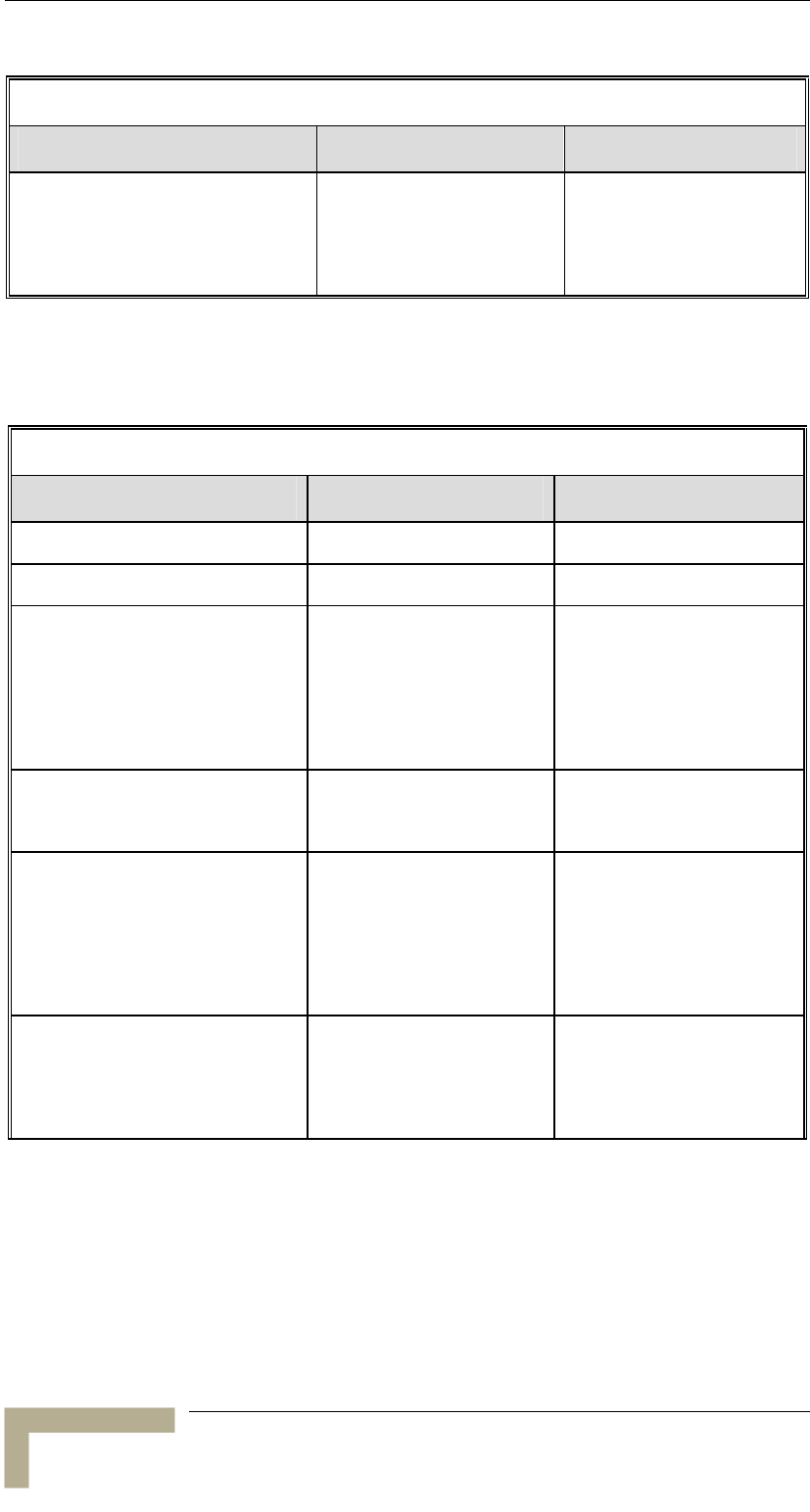
Appendix E - Supported MIBs and Traps
BreezeACCESSS VL System Manual
E-16
Table E-6: Bridge Parameters
MIB Parameter Description Value/Range
*NumberOfMacAddressesInDenyList
(*MacAddressDenyList 4)
Applicable to AU only. Not
applicable to BreezeNET B
units. Read only. The
number of MAC addresses
in the MAC Address Deny
List Table.
Integer
Range: 1 to 100
Air Interface Parameters
Table E-7: Air Interface Parameters
MIB Parameter Description Value/Range
*AirInterface
(breezeAccessVLMib 6)
Applicable to all units. Air
Interface parameters.
*ESSIDParameters
(*AirInterface 1)
Applicable to all units.
ESSID Parameters.
*ESSID
(*ESSIDParameters 1)
Applicable to all units. The
Extended Service Set ID
(ESSID) used to prevent the
merging of collocated
systems. The ESSID is
accessible only with the
write community string
(administrator password).
DisplayString (SIZE(31))
Up to 31 printable case
sensitive ASCII characters.
*OperatorESSIDOption
(*ESSIDParameters 2)
Applicable to AU/BU only.
Enabling/disabling the use
of the Operator ESSID
Integer
disable (1)
enable (2)
na (255)
*OperatorESSID
(*ESSIDParameters 3)
Applicable to AU/BU only. A
secondary ESSID to support
easy installation of SUs as
well as the use of the Best
AU/BU feature. Accessible
only with SNMP Write
Community string
(administrator password).
DisplayString (SIZE(31))
Up to 31 printable case
sensitive ASCII characters.
*RunTimeESSID
(*ESSIDParameters 1)
Applicable to SU/RB only.
The ESSID of the
associated AU/BU.
Accessible only with SNMP
Write Community string
(administrator password).
DisplayString (SIZE(31))
Up to 31 printable case
sensitive ASCII characters.

breezAccessVLMib
Manual Revision 1.0
E-17
Table E-7: Air Interface Parameters
MIB Parameter Description Value/Range
*MaximumCellDistance
(*AirInterface 2)
Applicable to all units. For
AU/BU: read-write. For
SU/RB: read-only. The
distance is learned from the
AU/BU. In units with SW
version 2.0 and up -
applicable only when the
Cell Distance Mode is set to
Manual. The highest
distance from the AU/BU of
any SU/RB served by it.
Affects the maximum time
the units wait for a response
message and the slot size
by taking into account the
round trip propagation
delay.
Integer
Range: For units with SW
version bellow version 2.0
the range is 0 - 50000
Meters.
For units with SW version
2.0 and up the range is 0 to
54 Kilometers.
0 means no compensation
(minimum slot size, maximal
delay timeout).
*AIFS
(*AirInterface 3)
Applicable to AU and SU.
Not applicable to
BreezeNET B products.
Arbitration Inter-Frame
Spacing (AIFS). This is the
number of time slots that
define the DIFS.
(DIFS=SIFS+AIFS). A value
of 1 should be used only in
point-to-point applications to
allow one unit to have
advantage over the other
unit.
Integer
oneSlot (1)
twoSlots (2)
na (255)
*WirelessTrapThreshold
(*AirInterface 4)
Applicable to AU/BU only. A
wireless link quality
threshold, expressed in % of
retransmissions, for sending
the
brzaccVLAUWirelessQuality
TRAP.
This trap indicate whether
the quality has gone below
or above the specified
threshold
Integer
1-100 (%)
*TransmitPowerTable
(*AirInterface 5)
Applicable to all units. Not
accessible. Transmit Power
parameters table.
*TransmitPowerEntry
(*TransmitPowerTable 1)
Applicable to all units. Not
accessible. An entry in the
Transmit Power parameters
table.
*TransmitPowerIdx
(*TransmitPowerEntry 1)
Applicable to all units. Read-
only. An index of an entry in
the Transmit Power
parameters table.
Integer
1-4

Appendix E - Supported MIBs and Traps
BreezeACCESSS VL System Manual
E-18
Table E-7: Air Interface Parameters
MIB Parameter Description Value/Range
*ApplicableModulationLevel
(*TransmitPowerEntry 2)
Applicable to all units. Read-
only. The applicable
modulation level for an entry
in the Transmit Power
parameters table. Level 8 is
not applicable to units with
HW revision A.
Level1to5 (1)
Level6 (2)
Level7 (3)
Level8 (4)
*MaximumTxPowerRange
(*TransmitPowerEntry 3)
Applicable to all units. Read-
only. The allowed range for
the *TxPower parameter at
the applicable modulation
level.
DisplayString
Range: -10 to the maximum
allowed for the applicable
modulation level.
*TxPower
(*TransmitPowerEntry 4)
Applicable to all units.
AU/BU: The transmit power
defined for the applicable
modulation level.
SU/RB: If ATPC is disabled,
this is The transmit power
defined for the applicable
modulation level. If ATPC is
enabled, it serves as the
initial transmit power for the
ATPC algorithm.
DisplayString
Range:
In SU/RB: The range is -10
dBm to the power value
defined by
*MaximumTxPower for the
applicable modulation level.
In AU/BU: The range is -10
dBm to the power value
defined by
*MaximumTxPowerRange
for the applicable modulation
level
*CurrentTxPower
(*TransmitPowerEntry 5)
Applicable to SU/RB.
The actual transmit power in
dBm at the applicable
modulation level.
DisplayString
Range: -17 to the maximum
value defined by
*MaximumTxPowerRange
for the applicable modulation
level.
*MaximumTransmitPowerTable
(*AirInterface 6)
Applicable to SU /RB. Not
accessible. Maximum
Transmit Power parameters
table.
*MaximumTransmitPowerEntry
(*TransmitPowerTable 1)
Applicable to SU/RB. Not
accessible. An entry in the
Maximum Transmit Power
parameters table.
*MaximumTransmitPowerIdx
(*MaximumTransmitPowerEntry 1)
Applicable to SU/RB. Read-
only. An index of an entry in
the Maximum Transmit
Power parameters table.
Integer
1-4
*MaxTxApplicableModulationLevel
(*MaximumTransmitPowerEntry 2)
Applicable to SU/RB. Read-
only. The applicable
modulation level for an entry
in the Maximum Transmit
Power parameters table.
Level 8 is not applicable to
units with HW revision A.
Level1to5 (1)
Level6 (2)
Level7 (3)
Level8 (4)
*DefinedMaximumTxPowerRange
(*MaximumTransmitPowerEntry 3)
Applicable to SU/RB. Read-
only. The allowed range for
the *MaxTxPower
parameter at the applicable
modulation level.
DisplayString
Range: -10 to the maximum
allowed for the applicable
modulation level.

breezAccessVLMib
Manual Revision 1.0
E-19
Table E-7: Air Interface Parameters
MIB Parameter Description Value/Range
*MaxTxPower
(*MaximumTransmitPowerEntry 4)
Applicable to SU/RB.
The maximum transmit
power level that can be
either configured for the
*TxPower parameter or
reached by the ATPC
algorithm.
DisplayString
Range: -10 to the maximum
defined by the
*DefinedMaximumTxPowerR
ange for the applicable
modulation level.
*MaxNumOfAssociations
(*AirInterface 10)
Applicable to AU. Not
applicable to BreezeNET B
products. The upper limit for
the number of Subscriber
Units that can be associated
with the AU
Integer
0-512
na (65535)
*BestAu
(*AirInterface 11)
Best AU/BU parameters.
Applicable to SU/RB.
*BestAuSupport
(*BestAu 1)
Applicable to SU/RB.
Disable/enable the Best
AU/BU selection mechanism
Integer
disable (1)
enable (2)
na (255)
*BestAuNoOfScanningAttempts
(*BestAu 2)
Applicable to SU/RB. The
number of scanning
attempts to collect
information for the Best
AU/BU decision
Integer
1-255
*PreferredAuMacAddress
(*BestAu 3)
Applicable to SU only. The
MAC address of the
preferred AU/BU (overriding
the Best AU/BU selection
process).
Mac Address
000000000000 means no
preferred AU
*NeighborAuTable
(*BestAu 4)
Applicable to SU/RB. Not
accessible. Neighboring
AUs/BUs table.
*NeighborAuEntry
(*NeighborAuTable 1)
Applicable to SU only. Not
accessible. An entry in the
Neighboring AUs table.
*NeighborAuIdx
(*NeighborAuEntry 1)
Applicable to SU/RB. Read-
only. An Index of an entry in
the Neighboring AU/BU
Table
Integer
Range: 1…20
*NeighborAuMacAdd
(*NeighborAuEntry 2)
Applicable to SU/RB. Read-
only. The MAC Address of
the AU/BU associated with
the entry in the Neighboring
AU/BU Table
MAC Address
*NeighborAuESSID
(*NeighborAuEntry 3)
Applicable to SU/RB. Read-
only. The ESSID of the
AU/BU associated with the
entry in the Neighboring
AU/BU Table. Accessible
only with the SNMP Write
community string
(Administrator Password).
DisplayString
*NeighborAuSNR
(*NeighborAuEntry 4)
Applicable to SU/RB. Read-
only. The average SNR at
which the SU/RB receives
the AU/BU associated with
the entry in the Neighboring
AU/BU Table.
Integer
Na (255)

Appendix E - Supported MIBs and Traps
BreezeACCESSS VL System Manual
E-20
Table E-7: Air Interface Parameters
MIB Parameter Description Value/Range
*NeighborAuAssocLoadStatus
(*NeighborAuEntry 5)
Applicable to SU/RB. Read-
only. The load status of the
AU/BU associated with the
entry in the Neighboring
AU/BU Table. Full means
that it has reached its
maximum permitted load,
meaning in AU that the
number of associated SUs
is the Maximum Number Of
Associations (for AU) or in
BU that it is already
associated with an RB.
Integer
full (1)
notFull (2)
na (255)
*NeighborAuMark
(*NeighborAuEntry 6)
Applicable to SU/RB. Read-
only. The overall mark given
by the Best AU/BU
algorithm to the AU/BU
associated with the entry in
the Neighboring AU/BU
Table.
Integer
*FrequencyDefinition
(*AirInterface 12)
Frequency Definition
parameters
*FrequencySubsetTable
(*FrequencyDefinition 4)
Applicable to all units. Not
accessible. The Frequency
Subset table that includes
all frequencies from the
Sub-band Lower Frequency
to the Sub-band Upper
Frequency, using steps as
defined by the Scanning
Step
*FrequencySubsetEntry
(FrequencySubsetTable 1)
Applicable to all units. Not
accessible. An entry in the
Frequency Subset table.
*FrequencySubsetTableIdx
(*FrequencySubsetEntry 1)
Applicable to all units. Read-
only. The index of an entry
in the Frequency Subset
table.
Integer
*FrequencySubsetFrequency
(*FrequencySubsetEntry 2)
Applicable to all units. Read-
only. The frequency of an
entry in the Frequency
Subset table.
Integer
*FrequencySubsetActive
(*FrequencySubsetEntry 3)
Applicable to all units. Read-
only. The status of an entry
in the Frequency subset
Table. Only frequencies of
active entries will be
included in the final list of
frequencies to be used for
scanning.
Integer
active (1)
notActive (2)
*SetSelectedFreqsSubset
(*FrequencyDefinition 5)
Applicable to all units. Apply
the selected subset. After
the next reset the new
subset will be used for
scanning.
Integer
SetSelectedFreqsSubset (1)
cancel (2)

breezAccessVLMib
Manual Revision 1.0
E-21
Table E-7: Air Interface Parameters
MIB Parameter Description Value/Range
*CurrentFrequencySubsetTable
(*FrequencyDefinition 6)
Applicable to all units. Not
accessible. The Current
Frequency Subset table that
includes all frequencies that
are currently used for
scanning.
*CurrentFrequencySubsetEntry
(CurrentFrequencySubsetTable 1)
Applicable to all units. Not
accessible. An entry in the
Current Frequency Subset
table.
*CurrentFrequencySubsetTableIdx
(*CurrentFrequencySubsetEntry 1)
Applicable to all units. Read-
only. The index of an entry
in the Current Frequency
Subset table.
Integer
*CurrentFrequencySubset
Frequency
(*FrequencySubsetEntry 2)
Applicable to all units. Read-
only. The frequency of an
entry in the Current
Frequency Subset table.
Integer
*CurrentAUOperatingFrequency
(*FrequencyDefinition 7)
Applicable to AU/BU. The
operating frequency.
Integer
For 5.8GHz products with
SW version below 2.0 the
range is 5740 to 5830 MHz
using 10MHz resolution.
For units with SW version
2.0 and up the range is as
defined in the selected Sub
Band.
*DefinedAUDefinedFrequency
(*FrequencyDefinition 8)
Applicable to AU/BU. For
5.8GHz products with SW
version below 2.0 this is the
read-only frequency of the
AU/BU after the next reset.
For units with SW version
2.0 and up this is the
frequency to use when the
DFS Option is disabled.
Integer
For 5.8GHz products with
SW version below 2.0 the
range is 5740 to 5830 MHz
using 10MHz resolution.
For units with SW version
2.0 and up the range is as
defined in the selected Sub
Band.
*CurrentSUOperatingFrequency
(*FrequencyDefinition 9)
Applicable to SU/RB. Read
only. The current operating
frequency.
Integer
For 5.8GHz products with
SW version below 2.0 the
range is 5740 to 5830 MHz
using 10MHz resolution.
For units with SW version
2.0 and up the range is as
defined in the selected Sub
Band.
*SubBandSelect
(*FrequencyDefinition 10)
Sub Band Selection
parameters
*SelectSubBandIndex
(*SubBandSelect 1)
Applicable to all units. The
ID of the sub-band used by
the unit.
Integer
*DFSParameters
(*FrequencyDefinition 11)
DFS Parameters. Applicable
to AU/BU.
*DFSOption
(*DFSParameters 1)
Applicable to AU/BU.
Enabling/disabling the DFS
Algorithm. Not applicable if
DFS Option is not supported
by the current Sub Band.
Integer
disable (1)
enable (2)
na (255)

Appendix E - Supported MIBs and Traps
BreezeACCESSS VL System Manual
E-22
Table E-7: Air Interface Parameters
MIB Parameter Description Value/Range
*DFSChannelCheckTime
(*DFSParameters 3)
Applicable to AU/BU.
Defines the time the unit
checks the channel for
presence of radar signals
and does not transmit after
power up or association
or after moving to a new
channel due to detecting
radar in the previously used
channel.
Integer
Range: 1 to 3600 (seconds).
*DFSChannelAvoidancePeriod
(*DFSParameters 4)
Applicable to AU/BU.
Defines the time after
detecting radar signals in a
channel of avoiding using
the channel or adjacent
channels in accordance with
the bandwidth.
Integer
Range: 1 to 60 (minutes).
*DFSSuWaitingOption
(*DFSParameters 5)
Applicable to AU/BU.
Defines whether the
associated SUs may should
wait for this AU/BU after it
stopped transmitting due to
radar detection, before they
starts scanning for other
AUs/BUs.
Integer
disable (1)
enable (2)
na (255)
*DFSClearRadarChannels
(*DFSParameters 6)
Applicable to AU/BU.
Clear Radar Detected and
Adjacent to Radar channels
after unit reset.
Returns the unit to operate
in default frequency
Integer
cancel (1)
clearRadarChannels (2)
na (255)
*DFSRadarDetectionChannelsTabl
e
(*DFSParameters 7)
Applicable to AU/BU.
Applicable only when DFS
option is on. Displays the
current channels defined in
the sub-band and their radar
detection status.
*DFSMinimumPulsesToDetect
(*DFSParameters 8)
Applicable to AU/BU.
Defines the minimum
number of pulses to detect
radar.
Integer
1 - 100
*DFSRadarDetectionChannelsEntr
y
(*DFSRadarDetectionChannelsTa
ble 1)
Applicable to AU/BU.
An entry in the DFS Radar
Detection Channels Table.
*DFSChannelIdx
(*DFSRadarDetectionChannelsEnt
ry 1)
Applicable to AU/BU. Read-
only. The index of the entry
in the DFS Radar Detection
Channels Table.
Integer
*DFSChannelFrequency
(*DFSRadarDetectionChannelsEnt
ry 2)
Applicable to AU/BU. Read-
only. The frequency of a
channel in the DFS Radar
Detection Channels Table.
Integer
*DFSChannelRadarStatus
(*DFSRadarDetectionChannelsEnt
ry 3)
Applicable to AU/BU.
The radar detection status
of a channel in the DFS
Radar Detection Channels
Table.
Integer
radarFree (1)
adjacentToRadar (2)
radarDetected (3)

breezAccessVLMib
Manual Revision 1.0
E-23
Table E-7: Air Interface Parameters
MIB Parameter Description Value/Range
*CountryCodeLearningBySU
(*FrequencyDefinition 12)
Applicable to AU only.
Defines weather the SU
should learn the country
code of the AU.
Integer
disable (1)
enable (2)
na (255)
*ATPC
(*AirInterface 13)
ATPC parameters
*AtpcOption
(*ATPC 1)
Applicable to all units.
Enabling/disabling the
ATPC Algorithm
Integer
disable (1)
enable (2)
na (255)
*DeltaFromMinSNRLevel
(*ATPC 2)
Applicable to AU/BU. The
Minimum SNR Level plus
the value of this parameter
define the maximum desired
level of the average SNR at
the AU/BU. If the ATPC
Option is enabled, than if
the received SNR is above
the maximum desired level,
the AU/BU will transmit
Power-Down messages to
the applicable SU/RB.
Integer
4-20 (dB)
*MinimumSNRLevel
(*ATPC 3)
Applicable to AU/BU.
Defines the minimum
desired level in dB of the
average SNR at the AU/BU.
Below this level, if ATPC
Option is enabled, the
AU/BU will transmit ATPC
Power-Up messages to the
applicable SU/RB.
Integer
4-60 (dB)
*MinimumIntervalBetweenATPC
Messages
(*ATPC 4)
Applicable to AU/BU. The
minimal time between
consecutive power-
up/power-down messages.
Integer
Range: 1 to 3600 (seconds)
*PowerLevelSteps
(*ATPC 6)
Applicable to AU/BU. The
step in dB that the SU/RB
will use when receiving an
ATPC Power-Up/Power-
Down message
Integer
1-20 (dB)
*CellDistanceParameters
(*AirInterface 15)
Cell distance Parameters
*CellDistanceMode
(*CellDistanceParameters 1)
Applicable AU/BU. The
selected mode of deciding
on Cell Distance.
Integer
automatic (1)
manual (2)
na (255)
*FairnessFactor
(*CellDistanceParameters 2)
Applicable AU/BU. The
percentage of the maximum
distance that is taken into
account in the time slot
calculation.
Integer
Range: 0 to 100 (Percent). A
value of 0 means the
minimal slot size (9
microseconds).
*MeasuredMaxCellDistance
(*CellDistanceParameters 3)
Applicable AU/BU. The
Maximum Cell Distance as
calculated by the AU/BU.
Integer
Range: 0 to 54 (Kilometers).
1 means “below 2 km”.

Appendix E - Supported MIBs and Traps
BreezeACCESSS VL System Manual
E-24
Table E-7: Air Interface Parameters
MIB Parameter Description Value/Range
*UnitWithMaxDistance
(*CellDistanceParameters 4)
Applicable AU only. Not
applicable to BreezeNET B
units. The MAC address of
the unit with the maximum
distance from the AU.
MAC Address
*ScanningMode
(*AirInterface 16)
Applicable to SU/RB. The
scanning mode. In cells
where the DFS Option is
enabled Scanning Mode is
forced to Passive.
Integer
passive (1)
active (2)
*Antenna Gain
(*AirInterface 17)
Applicable to all units. Read-
write in units where
*AntennaGainChange is
supported. Read-only in
units where
*AntennaGainChange is not
supported. The net gain
(including cable attenuation
for detached antennas) of
the antenna.
Integer
0-50 (dB)
-1 (not configurable) means
“Not Set Yet”.
-2 (not configurable) means
“Don’t Care”.
Service Parameters
Table E-8: Service Parameters
MIB Parameter Description Value/Range
*ServiceParameters
(breezeAccessVLMib 7)
Applicable to all units.
Service parameters.
*MirDownlink
(*ServiceParameters 2)
Applicable to SU/RB. The
Maximum Information Rate
(MIR) from AU/BU to
SU/RB. MIR must be above
brzaccVLCirDownlink value.
Integer
Range for Set:
SU-3: 128 – 2,048 (Kbps)
SU-6: 128 – 3,968 (Kbps)
SU-54: 128 – 32,896 (Kbps)
RB-14: 128 – 6,912 (Kbps)
RB-28:128 – 22,016 (Kbps)
The actual value (Get) will be
the entered value rounded to
the nearest multiple of 128
(N*128)
*MirUplink
(*ServiceParameters 3)
Applicable to SU/RB. The
Maximum Information Rate
(MIR) from SU/RB to
AU/BU. MIR must be above
brzaccVLCirUplink value.
Integer
Range for Set:
SU-3: 128 – 2,048 (Kbps)
SU-6: 128 – 3,968 (Kbps)
SU-54: 128 – 32,896 (Kbps)
RB-14: 128 – 6,912 (Kbps)
RB-28: 128 – 22,016 (Kbps)
The actual value (Get) will be
the entered value rounded to
the nearest multiple of 128
(N*128)

breezAccessVLMib
Manual Revision 1.0
E-25
Table E-8: Service Parameters
MIB Parameter Description Value/Range
*CirDownlink
(*ServiceParameters 4)
Applicable to SU only. Not
applicable to BreezeNET B
products. The Committed
Information Rate (CIR) from
AU to SU.
CIR must be below
brzaccVLMirDownlink value.
Integer
Range for Set:
SU-3: 0 – 2,048 (Kbps)
SU-6: 0 – 3,968 (Kbps)
SU-54: 0 – 32,896 (Kbps)
The actual value (Get) will be
the entered value rounded to
the nearest multiple of 128
(N*128).
BreezeNET B products will
return 65535 for na.
*CirUplink
(*ServiceParameters 5)
Applicable to SU only. Not
applicable to BreezeNET B
products. The Committed
Information Rate (CIR) from
SU to AU.
CIR must be below
brzaccVLMirUplink value.
Integer
Integer
Range for Set:
SU-3: 0 – 2,048 (Kbps)
SU-6: 0 – 3,968 (Kbps)
SU-54: 0 – 32,896 (Kbps)
The actual value (Get) will be
the entered value rounded to
the nearest multiple of 128
(N*128).
BreezeNET B products will
return 65535 for na.
*MaxDelay
(*ServiceParameters 6)
Applicable to SU only. Not
applicable to BreezeNET B
products. The maximal time
packets may be delayed by
the CIR\MIR mechanism.
Above the configured
maximal period the packets
are discarded.
Integer
Range: 300 - 10000
(milliseconds)
BreezeNET B products will
return 65535 for na.
*MaxBurstDuration
(*ServiceParameters 7)
Applicable to AU and SU.
Not applicable to
BreezeNET B products.
The maximum time during
which inactivity bonus time
can be accumulated for
future burst transmissions.
Integer
Range: 0 – 2000
(milliseconds)
BreezeNET B products will
return 65535 for na.
*GracefulDegradationLimit
(*ServiceParameters 8)
Applicable to AU only. Not
applicable to BreezeNET B
products. The maximum
limit for activating the
graceful degradation
algorithm.
Integer
Range: 0 – 70 (%)
na (255)
*MirOnlyOption
(*ServiceParameters 9)
Applicable only to AU. Not
applicable to BreezeNET B
products. When enabled, it
overrides the CIR/MIR
algorithm for determining
actual information rate and
forces the algorithm to
operate with MIR
parameters’ settings only.
When enabled, the Graceful
Degradation algorithm is
disabled.
Integer
disable (1)
enable (2)
na (255)

Appendix E - Supported MIBs and Traps
BreezeACCESSS VL System Manual
E-26
User Filtering Parameters
Table E-9: User Filtering Parameters
MIB Parameter Description Value/Range
*UserFilterParams
(breezeAccessVLMib 8)
Applicable to SU/RB. User
filtering parameters.
*UserFilterOption
(*UserFilterParams 1)
Applicable to SU only.
Defines user-filtering
options.
disable: No filtering.
iPOnly: Only IP protocol
packets pass.
userDefinedAddrOnly: Only
IP frames from/to user
defined IP addresses pass.
pPPoE Only: Only PPPoE
frames pass.
Integer
disable (1)
ipOnly (2)
userDefinedAddrOnly (3)
pPPoEOnly (4)
na (255)
*IpFilterTable
(*UserFilterParams 2)
Applicable to SU/RB. A
table of up to 8 user defined
addresses, or address
groups, to be used if the
User Filtering Option
(*UserFilterOption) is
userDefinedAddrOnly. Not
accessible.
*IpFilterEntry
(*IpFilterTable 1)
Applicable to SU/RB. An IP
Filter table entry. Not
accessible.
*IpID
(*IpFilterEntry 1)
Applicable to SU/RB. An IP
address in the IP Filter
table.
IP Address
*MaskID
(*IpFilterEntry 2)
Applicable to SU/RB. An IP
mask for the IP Filter entry.
Either a mask or a range,
but not both can be used to
define an address group. If
the range is other than 0,
than the mask is ignored
and only the range value is
used to define the address
group.
IP Address
*IpFilterRange
(*IpFilterEntry 3)
Applicable to SU/RB. An
address range for the IP
Filter entry. The first
address in the range is the
IP address (*iPID). O means
that the range is not used.
Either a mask or a range,
but not both can be used to
define an address group. If
the range is other than 0,
than the mask is ignored
and only the range value is
used to define the address
group.
Integer
0 - 255

breezAccessVLMib
Manual Revision 1.0
E-27
Table E-9: User Filtering Parameters
MIB Parameter Description Value/Range
*IpFilterIdx
(*IpFilterEntry 4)
Applicable to SU/RB.
Read-only. A table index for
the IP Filter entry.
Integer
1-8
*DeleteOneUserFilter
(*UserFilterParams 3)
Applicable to SU only.
Deletes a single selected
entry from the IP Filter table.
Integer
deletefirstEntry (1)
deletesecondEntry (2)
deletethirdEntry (3)
deletefourthEntry (4)
deletefifthEntry (5)
deletesixthEntry (6)
deleteseventhEntry (7)
deleteeighthEntry (8)
cancelOperation (9)
na (255)
*DeleteAllUserFilters
(*UserFilterParams 4)
Applicable to SU/RB.
Deletes all entries from the
IP Filter table.
Integer
deleteAll (1)
cancelOperation (2)
na (255)
Security Parameters
Table E-10: Security Parameters
MIB Parameter Description Value/Range
*SecurityParams
(breezeAccessVLMib 9)
*AuthenticationAlgorithm
(*SecurityParameters 1)
Applicable to all units.
Enables/disables the
authentication encryption
option.
openSystem: Authentication
messages are not encrypted.
sharedKey : Authentication
messages are encrypted.
Integer
openSystem (1)
sharedKey (2)
*DefaultKey
(*SecurityParameters 2)
Applicable to SU/RB. The ID
of the key to be used for
encrypting/decrypting the
authentication messages.
Integer
Range: 1 to 4.
*DataEncryptionOption
(*SecurityParameters 3)
Applicable to all units.
Enables/disables the data
encryption option.
Integer
disable (1)
enable (2)
*DefaultMulticastKey
(*SecurityParameters 4)
Applicable to AU/RB. The ID
of the key to be used for
encrypting/decrypting
multicasts.
Integer
Range: 1 to 4.
*SecurityMode
(*SecurityParameters 5)
Applicable to all units. The
encryption algorithm to be
used for authentication
messages and/or data
encryption
Integer
wep (1)
aes (2)

Appendix E - Supported MIBs and Traps
BreezeACCESSS VL System Manual
E-28
Table E-10: Security Parameters
MIB Parameter Description Value/Range
*PromiscuousAuthenticationMode
(*SecurityParameters 6)
Applicable to AU/RB.
Enabling/disabling the
promiscuous mode, where
any SU can be authenticated
by and communicate with the
AU.
Integer
disable (1)
enable (2)
*Key1
(*SecurityParameters 7)
Applicable to all units. Key
number 1. Accessible only
with SNMP Write Community
String (administrator
password).
DisplayString
32 hexadecimal
digits
*Key2
(*SecurityParameters 8)
Applicable to all units. Key
number 2. Accessible only
with SNMP Write Community
String (administrator
password).
DisplayString
32 hexadecimal
digits
*Key3
(*SecurityParameters 9)
Applicable to all units. Key
number 3. Accessible only
with SNMP Write Community
String (administrator
password).
DisplayString
32 hexadecimal
digits
*Key4
(*SecurityParameters 10)
Applicable to all units. Key
number 4. Accessible only
with SNMP Write Community
String (administrator
password).
DisplayString
32 hexadecimal
digits
Performance Parameters
Table E-11: Performance Parameters
MIB Parameter Description Value/Range
*PerformanceParams
(breezeAccessVLMib 10)
*RTSThreshold
(*PerformanceParams 1)
Applicable to SU and AU. Not
applicable to BreezeNET B
products. The minimum frame
size that requires an
RTS/CTS handshake.
Integer
20-1600 (bytes)
na (65535)
*MinContentionWindow
(*PerformanceParams 3)
Applicable to SU and AU. Not
applicable to BreezeNET B
products. The initial value to
be used by the contention
window calculation algorithm.
A value of 0 disables the
back-off algorithm and should
be used only in point-to-point
applications.
Integer
0, 7, 15, 31, 63,
127, 255, 511,
1023.
na (65535)
*MaxContentionWindow
(*PerformanceParams 4)
Applicable to SU and AU. Not
applicable to BreezeNET B
products. The maximum value
to be used by the contention
window calculation algorithm.
Integer
7, 15, 31, 63, 127,
255, 511, 1023
na (65535)

breezAccessVLMib
Manual Revision 1.0
E-29
Table E-11: Performance Parameters
MIB Parameter Description Value/Range
*MaximumModulationLevel
(*PerformanceParams 5)
Applicable to all units. If the
Adaptive Modulation
algorithm is enabled, it sets
the maximum modulation
level to be used. If The
Adaptive Modulation
algorithm is disabled, it set
the fixed modulation level to
be used.
Integer
Range: 1 to 8*
*Range depends
on HW version
and Min/Max
Modulation Levels
as defined by Sub
Band.
*MulticastModulationLevel
(*PerformanceParams 6)
Applicable to AU/BU. The
modulation level for multicast
and broadcast data frames.
Integer
Range: 1 to 8*
*Range depends
on HW version
and Min/Max
Modulation Levels
as defined by Sub
Band.
*AvgSNRMemoryFactor
(*PerformanceParams 7)
Applicable to all units. The
weight of history in average
RSSI calculation for the ATPC
(AU only) and Adaptive
Modulation algorithm. The
higher is the value, the higher
is the weight of history
DisplayString
-1 (Disregard
History) to 32
*HardwareRetries
(*PerformanceParams 8)
Applicable to all units. The
maximum number of trials to
transmit an unacknowledged
frame in each Hardware
Retrials phase.
Integer
1-15
*AdaptiveModulationParams
(*PerformanceParams 9)
Adaptive Modulation
Parameters
*AdaptiveModulationAlgorithmOption
(*AdaptiveModulationParams 1)
Applicable to all units.
Enabling/disabling the
Adaptive Modulation
algorithm.
Integer
disable (1)
enable (2)
*SoftwareRetrySupport
(*AdaptiveModulationParams 2)
Applicable to all units.
Read-only for units with
version 2.0 and above.
The status of the Software
Retry mechanism.
Enabled when the Adaptive
Modulation algorithm is
enabled and the Burst Mode
Option is disabled. Otherwise
it is disabled.
Integer
disable (1)
enable (2)
na (255)
*NumberOfSoftwareRetries
(*AdaptiveModulationParams 3)
Applicable to all units.
Read-only for units with
version 2.0 and above.
The maximum number of
times to use the Software
Retry mechanism when it is
enabled.
Integer
0-14
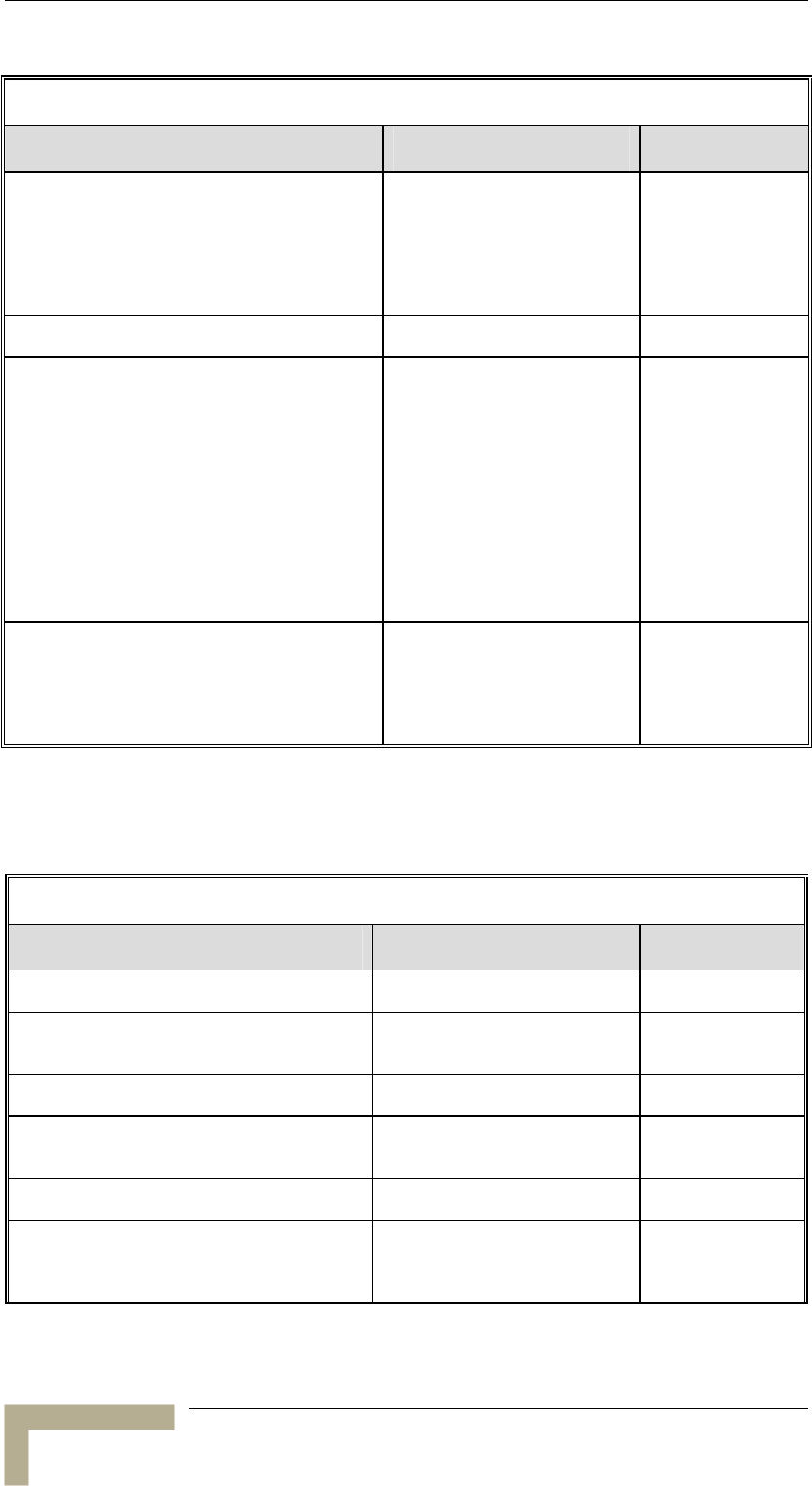
Appendix E - Supported MIBs and Traps
BreezeACCESSS VL System Manual
E-30
Table E-11: Performance Parameters
MIB Parameter Description Value/Range
*MinimumIntervalBetweenAdaptiveModulation
AlgorithmMessages
(*AdaptiveModulationParams 4)
Applicable to all units. The
minimum interval between
two consecutive adaptive
modulation algorithm
messages carrying
information on the SNR of
received signals.
Integer
1-3600 (seconds)
*BurstMode
(*PerformanceParams 10)
Burst Mode Parameters.
Applicable to all units.
*BurstModeOption
(*BurstMode 1)
Applicable to all units.
Applicable only if Burst Mode
Option is supported by the
Sub Band. Enabling/disabling
burst mode operation. In SU
blocked (3) value is returned
when Security Mode is WEP ,
Data Encryption Option is
Enabled and Burst option is
Enabled. In AU blocked(3)
value is returned when DFS
Option is Enabled and Burst
mode Enabled
Integer
disable (1)
enable (2)
blocked (3)
na (255)
*BurstInterval
(*BurstMode 2)
Applicable to all units. The
burst interval in milliseconds.
Integer
1-the maximum
value as defined in
the Sub Band.
(milliseconds)
na (255)
Site Survey Parameters
Table E-12: Site Survey Parameters
MIB Parameter Description Value/Range
*SiteSurvey
(breezeAccessVLMib 11)
*AverageReceiveSNR
(*SiteSurvey 1)
Applicable to SU/RB. Read-
only. The average Signal to
Noise Ratio of received frames.
Integer
*TrafficStatistics
(*SiteSurvey 2)
Applicable to all units. Traffic
statistics parameters.
*ResetTrafficCounters
(*TrafficStatistics 1)
Applicable to all units. Resets
the traffic counters.
Integer
reset (1)
cancel (2)
*EthCounters
(*TrafficStatistics 2)
Applicable to all units. Ethernet
counters.
*TotalRxFramesViaEthernet
(*EthCounters 1)
Applicable to all units.
Read-only. Total number of
frames received via the
Ethernet port.
Counter 32

breezAccessVLMib
Manual Revision 1.0
E-31
Table E-12: Site Survey Parameters
MIB Parameter Description Value/Range
*TxWirelessToEthernet
(*EthCounters 2)
Applicable to all units.
Read-only. Total number of
frames transmitted to the
Ethernet port.
Counter 32
*WirelessLinkCounters
(*TrafficStatistics 3)
Applicable to all units. Wireless
link counters.
*TxFramesToWireless
(*WirelessLinkCounters 1)
Transmitted frames counters
*AUBeaconsToWireless
(*TxFramesToWireless 1)
Applicable to AU/BU. Read-
only. The number of Beacon
frames transmitted to the
wireless media.
Counter 32
*DataAndOtherMngFramesToWireless
(*TxFramesToWireless 3)
Applicable to AU/BU.
Read-only. The number of data
and other management frames
(excluding beacons)
transmitted to the wireless
media. The count includes
multicasts/broadcasts and one
count for each unicast frame
transmitted successfully
(excluding retransmissions).
Counter 32
*TotalTxFramesToWireless
(*TxFramesToWireless 4)
Applicable to all units.
Read-only. The number of
frames transmitted to the
wireless media. The count
includes one count for each
data frame transmitted
successfully (excluding
retransmissions), and the
number of transmitted control
and wireless management
frames.
Counter 32
*TotalTransmitted Unicasts
(*TxFramesToWireless 5)
Applicable to AU. Not
applicable to BreezeNET B
products. Read-only. The total
number of unicast frames
successfully transmitted to the
wireless media, excluding
retransmissions.
Counter 32
*TotalRxFramesFromWireless
(*WirelessLinkCounters 2)
Applicable to all units.
Read-only. The total number of
frames received from the
wireless media. The count
includes data and control and
wireless management frames,
including beacons received
from the AU. The count does
not include frames discarded
internally, bad frames and
duplicate frames.
Counter 32
*TotalRetransmittedFrames
(*WirelessLinkCounters 3)
Applicable to all units.
Read-only. The total number of
retransmissions of data frames
(counts all unsuccessful
transmissions/retransmissions).
Counter 32

Appendix E - Supported MIBs and Traps
BreezeACCESSS VL System Manual
E-32
Table E-12: Site Survey Parameters
MIB Parameter Description Value/Range
*FramesDropped
(*WirelessLinkCounters 4)
Applicable to all units.
Read-only. The number of
dropped frames. The frames
retransmitted to the maximum
allowed number of
retransmissions without being
acknowledged.
Counter 32
*DataFramesSubmittedToBridge
(*WirelessLinkCounters 5)
Submitted frames counters
*DataFramesSubmittedViaHighQueue
(*DataFramesSubmittedToBridge 1)
Applicable to all units.
Read-only. The number of data
frames submitted to the
internal bridge via the high
priority queue for transmission
to the wireless media.
Counter 32
*DataFramesSubmittedViaMidQueue
(*DataFramesSubmittedToBridge 2)
Applicable to all units.
Read-only. The number of data
frames submitted to the
internal bridge via the mid
priority queue for transmission
to the wireless media.
Counter 32
*DataFramesSubmittedViaLowQueue
(*DataFramesSubmittedToBridge 3)
Applicable to all units.
Read-only. The number of data
frames submitted to the
internal bridge via the low
priority queue for transmission
to the wireless media.
Counter 32
*TotalNoOfDataFramesSubmitted
(*DataFramesSubmittedToBridge 4)
Applicable to all units.
Read-only. The total number of
data frames submitted to the
internal bridge for transmission
to the wireless media.
Counter 32
*TotalRecievedDataFrames
(*WirelessLinkCounters 6)
Applicable to all units.
Read-only. The total number of
data frames received from the
wireless media, including
duplicate frames.
Counter 32
*RecievedBadFrames
(*WirelessLinkCounters 7)
Applicable to all units.
Read-only. The number of
frames received from the
wireless media with errors
(CRC errors).
Counter 32
*NoOfDuplicateFramesDiscarded
(*WirelessLinkCounters 8)
Applicable to all units.
Read-only. The number of
frames discarded due to
receiving multiple copies.
Counter 32
*InternallyDiscardedMirCir
(*WirelessLinkCounters 9)
Applicable to all units.
Read-only. The number of data
frames received from the
Ethernet port that were
discarded by the MIR/CIR
mechanism to avoid exceeding
the maximum allowed
information rate
Counter 32
*WirelessLinkEvents
(*TrafficStatistics 4)
Applicable to all units. Wireless
link event counters.
*TxEvents
(*WirelessLinkEvents 1)
Applicable to all units.
Read-only. Tx event counters.

breezAccessVLMib
Manual Revision 1.0
E-33
Table E-12: Site Survey Parameters
MIB Parameter Description Value/Range
*DroppedFrameEvents
(*TxEvents 1)
Applicable to all units. The
number frames that were
dropped because they were
retransmitted to the maximum
allowed number of
retransmissions without being
acknowledged.
Counter 32
*FrameDelayedDueToSwRetry
(*TxEvents 2)
Applicable to all units. The
number of frames that were
delayed because the SW retry
algorithm was activated on a
previous frame designated for
the same recipient.
Counter 32
*Underrun Events
(*TxEvents 3)
Applicable to all units. The
number of frames whose
transmission was aborted
because the rate of submitting
frames for transmission
exceeds the available
transmission capability.
Counter 32
*OtherTxEvents
(*TxEvents 4)
Applicable to all units. The
number of Tx events due to
problems other than those
represented by the other Tx
Events counters.
Counter 32
*TotalTxEvents
(*TxEvents 5)
Applicable to all units. The total
number of Tx events.
Counter 32
*RxEvents
(*WirelessLinkEvents 2)
Applicable to all units.
Read-only. Rx errors counters.
*PhyErrors
(*RxErrors 1)
Applicable to all units. Read-
only. Applicable only when
DFS is enabled. The number of
unidentified signals.
Counter 32
*CRCEvents
(*RxEvents 2)
Applicable to all units. Read-
only. The number of frames
received from the wireless
media containing CRC errors.
Counter 32
*OverrunEvents
(*RxEvents 3)
Applicable to all units. Read-
only. The number of frames
that were discarded because
the receive rate exceeded the
processing capability or the
capacity of the Ethernet port.
Counter 32
*RxDecryptEvents
(*RxEvents 4)
Applicable to all units. Read-
only. The number of frames
that were not received properly
due to a problem in the data
decryption mechanism.
Counter 32
*TotalRxEvents
(*RxEvents 5)
Applicable to all units. Read-
only. The total number of Rx
events.
Counter 32
*PerModulationLevelCounters
(*TrafficStatistics 5)
Per Modulation Level
Counters.
*ResetPerModulationLevelCounters
(*PerModulationLevelCounters 1)
Applicable to all units. Resets
the Per Modulation Level
Counters
Integer
resetCounters (1)
cancel (2)

Appendix E - Supported MIBs and Traps
BreezeACCESSS VL System Manual
E-34
Table E-12: Site Survey Parameters
MIB Parameter Description Value/Range
*SUPerModulationLevelCountersTable
(*PerModulationLevelCounters 2)
Applicable to SU/RB. Not
accessible. The Per Modulation
Level Counters Table.
*SUPerModulationLevelCountersEntry
(*PerModulationLevelCountersTable 1)
Applicable to SU/RB. Not
accessible. An entry in the Per
Modulation Level Counters
Table.
*SUPerModulationLevelCountersTableIdx
(*PerModulationLevelCountersEntry 1)
Applicable to SU/RB. Read-
only. The index of an entry in
the Per Modulation Level
Counters Table.
*SUPerModulationLevelCountersApplicable
ModulationLeve
(*PerModulationLevelCountersEntry 2)
Applicable to SU/RB. Read-
only. The modulation level
applicable for the entry in the
Per Modulation Level Counters
Table.
Integer
Range: 1 to 8*
*Level 8 is not
applicable to
devices with HW
revision A
*SUPerModulationLevelCountersTxSuccess
(*PerModulationLevelCountersEntry 3)
Applicable to SU/RB. Read-
only. The total number of
successfully transmitted
unicasts at the applicable
modulation level.
Counter 32
*SUPerModulationLevelCountersTxFailed
(*PerModulationLevelCountersEntry 4)
Applicable to SU/RB. Read-
only. The total number of
failures to successfully
transmit a unicast frame during
a HW Retry cycle at the
applicable modulation level.
Counter 32
*MacAddressDatabase
(*SiteSurvey 5)
MAC Address Database
*AUMacAddressDatabase
(*MacAddressDatabase 1)
AU MAC Address Database
*AdbResetAllCounters
(*AUMacAddressDatabase 1)
Applicable to AU/BU. Resets
all the counters for all SUs in
the MAC Address Database.
Integer
reset (1)
noReset (2)
*AUAdbTable
(*AUMacAddressDatabase 2)
Applicable to AU/BU. Not
accessible. The AU MAC
Address Database Table.
*AUAdbEntry
(*AUAdbTable 1)
Applicable to AU/BU. Not
accessible. An entry in the AU
MAC Address Database Table.
*AdbIndex
(*AUAdbEntry 1)
Applicable to AU/BU. Read-
only. The Index of an entry in
the AU MAC Address
Database Table.
Integer
*AdbMacAddress
(*AUAdbEntry 2)
Applicable to AU/BU. Read-
only. The MAC Address of an
SU entry in the AU MAC
Address Database Table.
MAC Address
*AdbStatus
(*AUAdbEntry 3)
Applicable to AU/BU. Read-
only. The wireless status of the
relevant SU.
Integer
associated (1)
authenticated (2)
notAuthenticated
(3)

breezAccessVLMib
Manual Revision 1.0
E-35
Table E-12: Site Survey Parameters
MIB Parameter Description Value/Range
*AdbSwVersion
(*AUAdbEntry 4)
Applicable to AU/BU. Read-
only. The SW Version of the
relevant SU.
Display String
*AdbSNR
(*AUAdbEntry 5)
Applicable to AU/BU. Read-
only. The average Signal to
Noise Ratio in dB of frames
received by the AU from the
relevant SU.
Integer
0-60
*AdbMaxModulationLevel
(*AUAdbEntry 6)
Applicable to AU/BU. Read-
only. The value configured in
the relevant SU for the
Maximum Modulation Level
parameter.
Integer
Range: 1 to 8*
*Level 8 is not
applicable to
devices with HW
revision A.
*AdbTxFramesTotal
(*AUAdbEntry 7)
Applicable to AU/BU. Read-
only. Counts the total number
of frames (excluding
retransmissions) that were
transmitted by the AU to the
relevant SU.
Counter 32
*AdbDroppedFramesTotal
(*AUAdbEntry 8)
Applicable to AU/BU. Read-
only. Counts the total number
of intended to the relevant SU
that were dropped because
they were retransmitted by the
AU to the extent of the
maximum allowed number of
retransmissions without being
acknowledged.
Counter 32
*AdbTxSuccessModLevel1
(*AUAdbEntry 9)
Applicable to AU/BU. Read-
only. Counts the total number
of unicast frames (excluding
retransmissions) that were
successfully transmitted to the
SU over the wireless link using
modulation level 1.
Counter 32
*AdbTxSuccess ModLevel2
(*AUAdbEntry 10)
Applicable to AU/BU. Read-
only. Counts the total number
of unicast frames (excluding
retransmissions) that were
successfully transmitted to the
SU over the wireless link using
modulation level 2.
Counter 32
*AdbTxSuccess ModLevel3
(*AUAdbEntry 11)
Applicable to AU/BU. Read-
only. Counts the total number
of unicast frames (excluding
retransmissions) that were
successfully transmitted to the
SU over the wireless link using
modulation level 3.
Counter 32
*AdbTxSuccess ModLevel4
(*AUAdbEntry 12)
Applicable to AU/BU. Read-
only. Counts the total number
of unicast frames (excluding
retransmissions) that were
successfully transmitted to the
SU over the wireless link using
modulation level 4.
Counter 32

Appendix E - Supported MIBs and Traps
BreezeACCESSS VL System Manual
E-36
Table E-12: Site Survey Parameters
MIB Parameter Description Value/Range
*AdbTxSuccess ModLevel5
(*AUAdbEntry 13)
Applicable to AU/BU. Read-
only. Counts the total number
of unicast frames (excluding
retransmissions) that were
successfully transmitted to the
SU over the wireless link using
modulation level 5.
Counter 32
*AdbTxSuccess ModLevel6
(*AUAdbEntry 14)
Applicable to AU/BU. Read-
only. Counts the total number
of unicast frames (excluding
retransmissions) that were
successfully transmitted to the
SU over the wireless link using
modulation level 6.
Counter 32
*AdbTxSuccess ModLevel7
(*AUAdbEntry 15)
Applicable to AU/BU. Read-
only. Counts the total number
of unicast frames (excluding
retransmissions) that were
successfully transmitted to the
SU over the wireless link using
modulation level 7.
Counter 32
*AdbTxSuccess ModLevel8
(*AUAdbEntry 16)
Applicable to AU/BU. Not
applicable to units with HW
revision A. Read-only. Counts
the total number of unicast
frames (excluding
retransmissions) that were
successfully transmitted to the
SU over the wireless link using
modulation level 8.
Counter 32
*AdbTxFailed ModLevel1
(*AUAdbEntry 17)
Applicable to AU/BU. Read-
only. Counts the total number
of failures to successfully
transmit a unicast frame
intended to the SU during a
HW Retry cycle using
modulation level 1.
Counter 32
*AdbTxFailed ModLevel2
(*AUAdbEntry 18)
Applicable to AU/BU. Read-
only. Counts the total number
of failures to successfully
transmit a unicast frame
intended to the SU during a
HW Retry cycle using
modulation level 2.
Counter 32
*AdbTxFailed ModLevel3
(*AUAdbEntry 19)
Applicable to AU/BU. Read-
only. Counts the total number
of failures to successfully
transmit a unicast frame
intended to the SU during a
HW Retry cycle using
modulation level 3.
Counter 32
*AdbTxFailed ModLevel4
(*AUAdbEntry 20)
Applicable to AU/BU. Read-
only. Counts the total number
of failures to successfully
transmit a unicast frame
intended to the SU during a
HW Retry cycle using
modulation level 4.
Counter 32

breezAccessVLMib
Manual Revision 1.0
E-37
Table E-12: Site Survey Parameters
MIB Parameter Description Value/Range
*AdbTxFailed ModLevel5
(*AUAdbEntry 21)
Applicable to AU/BU. Read-
only. Counts the total number
of failures to successfully
transmit a unicast frame
intended to the SU during a
HW Retry cycle using
modulation level 5.
Counter 32
*AdbTxFailed ModLevel6
(*AUAdbEntry 22)
Applicable to AU/BU. Read-
only. Counts the total number
of failures to successfully
transmit a unicast frame
intended to the SU during a
HW Retry cycle using
modulation level 6.
Counter 32
*AdbTxFailed ModLevel7
(*AUAdbEntry 23)
Applicable to AU/BU. Read-
only. Counts the total number
of failures to successfully
transmit a unicast frame
intended to the SU during a
HW Retry cycle using
modulation level 7.
Counter 32
*AdbTxFailed ModLevel8
(*AUAdbEntry 24)
Applicable to AU/BU. Not
applicable to units with HW
revision A. Read-only. Counts
the total number of failures to
successfully transmit a unicast
frame intended to the SU
during a HW Retry cycle using
modulation level 8.
Counter 32
*AdbCirTx
(*AUAdbEntry 25)
Applicable to AU Only. Not
applicable to BreezeNET B
products. Read-only. The value
configured in the relevant SU
for the CIR: Uplink parameter.
Integer
*AdbMirTx
(*AUAdbEntry 26)
Applicable to AU/BU. Read-
only. The value configured in
the relevant SU for the MIR:
Uplink parameter.
Integer
*AdbCirRx
(*AUAdbEntry 27)
Applicable to AU. Not
applicable to BreezeNET B
products. Read-only. The value
configured in the relevant SU
for the CIR: Downlink
parameter.
Integer
*AdbMirRx
(*AUAdbEntry 28)
Applicable to AU/BU. Read-
only. The value configured in
the relevant SU for the MIR:
Downlink parameter.
Integer
*AdbCirMaxDelay
(*AUAdbEntry 29)
Applicable to AU. Not
applicable to BreezeNET B
products. Read-only. The value
configured in the relevant SU
for the Maximum Delay
parameter.
Integer
*AdbDistance
(*AUAdbEntry 30)
Applicable to AU/BU. The
measured distance between
the SU/RB and the AU/BU (In
Kilometers)
Integer
1 means any
distance below
2 km
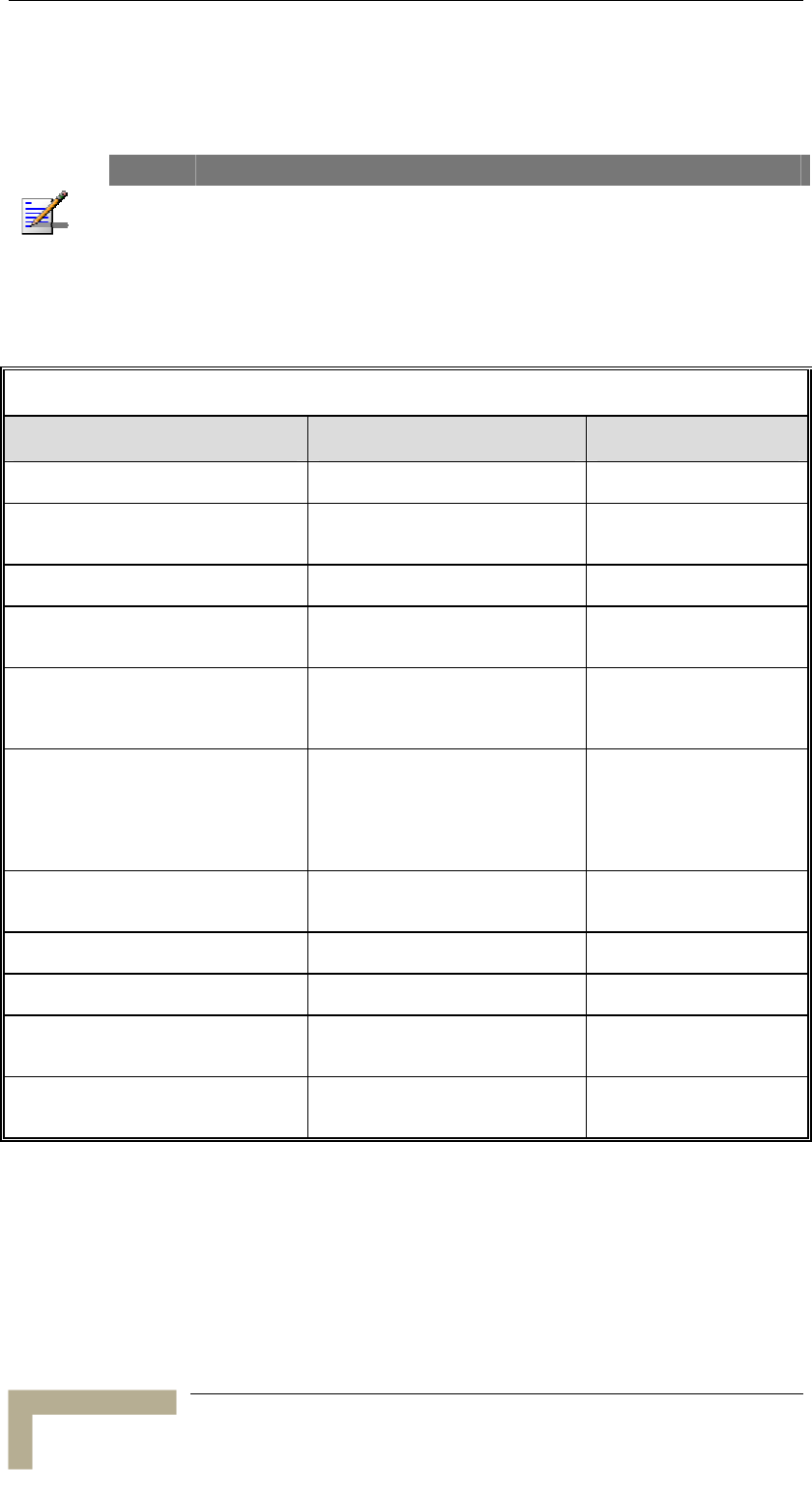
Appendix E - Supported MIBs and Traps
BreezeACCESSS VL System Manual
E-38
Supported Traps
NOTE
An * is used instead of the brzaccVL prefix.
Trap Variables
Table E-13: Trap Variables
MIB Parameter Description Value/Range
*Traps
(breezeAccessVLMib 14)
*TrapSUMacAddr
(*Traps 1)
Applicable to AU/BU. An SU/RB
MAC address.
MAC address
*TrapText
(*Traps 3)
Applicable to all units. Textual
string for future use.
DisplayString
*TrapToggle
(*Traps 4)
Applicable to all units. An On/Off
toggle status.
Integer
on (1)
off (2)
*TrapParameterChanged
(*Traps 5)
Applicable to all units. A
modification to one of the
parameters related to IP
Filtering, MIR/CIR or VLAN.
Integer
cirOrMir (1)
ipFilter (2)
vlan (3)
*TrapAccessRights
(*Traps 6)
Applicable to all units. The
access rights used for login.
Integer
notLoggedIn (1)
readOnly (2)
installer (3)
administrator (4)
factory (5)
*TrapLog
(*Traps 7)
Applicable to all units. Login or
logout to the Monitor program
Telnet.
Integer
telnetLogin (1)
telnetLogout (2)
*TrapTelnetUserIpAddress
(*Traps 8)
Applicable to all units. The IP
address of a Telnet user.
IP address
*TrapRTx
(*Traps 9)
Applicable to AU/BU.
Retransmissions rate.
*TrapFtpOrTftpStatus
(*Traps 10)
Applicable to all units.
The status of the last FTP/TFTP
loading process.
successful (1)
failed (2)
*TrapDFSMoveFreq
(*Traps 11)
Applicable to AU/BU. The new
frequency after detecting radar
on a previous channel.
Integer

Supported Traps
Manual Revision 1.0
E-39
Private BreezeACCESS VL Traps
Table E-14: Private BreezeACCESS VL Traps
Trap (Number) Description Variables
*SUassociatedAUTRAP (2) An AU/BU trap indicating a new
association with an SU/RB.
*TrapSUMacAddr
*AUdisassociatedTRAP (3) An AU/BU trap indicating that an
SU/RB has been disassociated
from the AU/BU. The AU/BU
decides that an SU/RB has been
disassociated from it and remove
it from the ADB after receiving
from another AU/BU a SNAP
frame with the SU/RB MAC
address. The SNAP frame
indicating a network topology
change where the SU/RB has
associated with another AU/BU
will be received if both AUs/BUs
are connected to the same
Ethernet backbone.
*TrapSUMacAddr
*AUagingTRAP (4) An AU/BU trap indicating that an
SU/RB aged out and was
removed from the Associations
database following its failure to
acknowledge a specified number
of consecutive frames.
*TrapSUMacAddr
*SUassociatedTRAP (6) An SU/RB trap indicating
association with an AU/BU. In
addition to the MAC address
information of the AU/BU, the
trap also includes information on
the average SNR of frames
received from the AU/BU.
*AssociatedAU
*AUwirelessQualityTRAP (20) An AU/BU trap, indicating that
the quality of the wireless link
has changed and dropped below
(Off) or increased above (On) a
threshold defined by the
*WirelessTrapThreshold.
*TrapToggle
*TrapRTx
*PowerUpFromReset (101) An AU/BU trap indicating power
up after reset.
*UnitMacAddress
*MonitorStatusTRAP (102) Applicable to all units. A trap
indicating that a log-in or log-out
has been performed via Telnet.
Includes the login access right
and the IP address of the PC
performing Telnet.
*TrapLog
*TrapAccessRights
*TrapTelnetUserIpAddress
*ParameterChangedTRAP(103) Applicable to all units. A trap
indicating a change in CIR/MIR,
IP Filter or VLAN parameter.
*TrapParameterChanged
*LoadingStatusTRAP(104) Applicable to all units. A trap
indicating the results (successful
or failed) of the last FTP/TFTP
loading process.
*TrapFtpOrTftpStatus
*UnitMacAddress
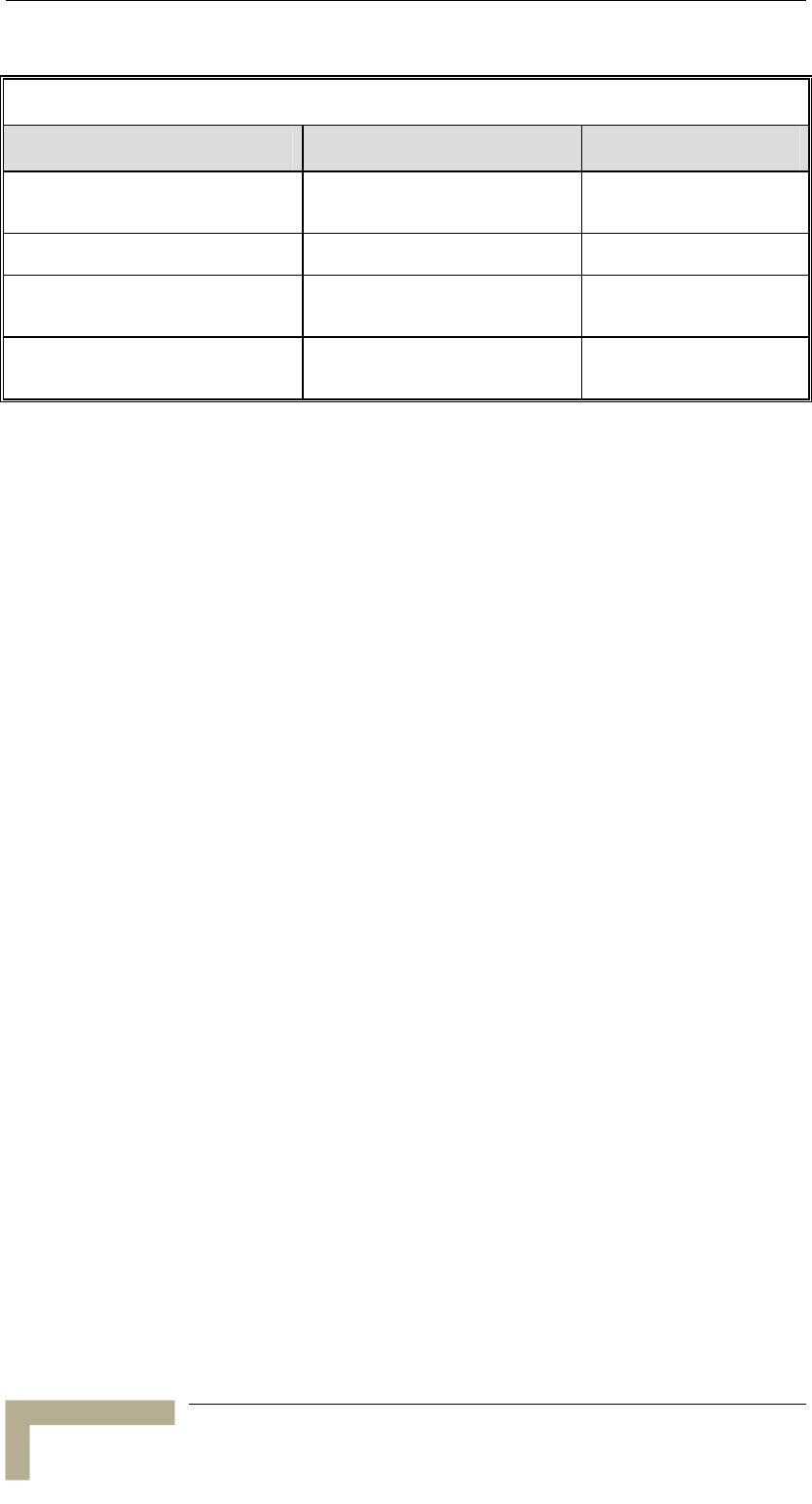
Appendix E - Supported MIBs and Traps
BreezeACCESSS VL System Manual
E-40
Table E-14: Private BreezeACCESS VL Traps
Trap (Number) Description Variables
*PromiscuousModeTRAP (105) An AU/BU trap indicating that
promiscuous mode was enabled
(on) or disabled (off)
*TrapToggle
*UnitMacAddress
*DFSRadarDetectedTRAP (106) An AU/BU trap indicating that
radar was detected
*UnitMacAddress
*DFSFrequencyTRAP (107) An AU/BU trap indicating the
new frequency after radar was
detected.
*UnitMacAddress
*TrapDFSMoveFreq
*DFSNoFreeChannelsExistTRAP
(108)
An AU/BU trap indicating that
radar was detected and there is
free channel.
*UnitMacAddress
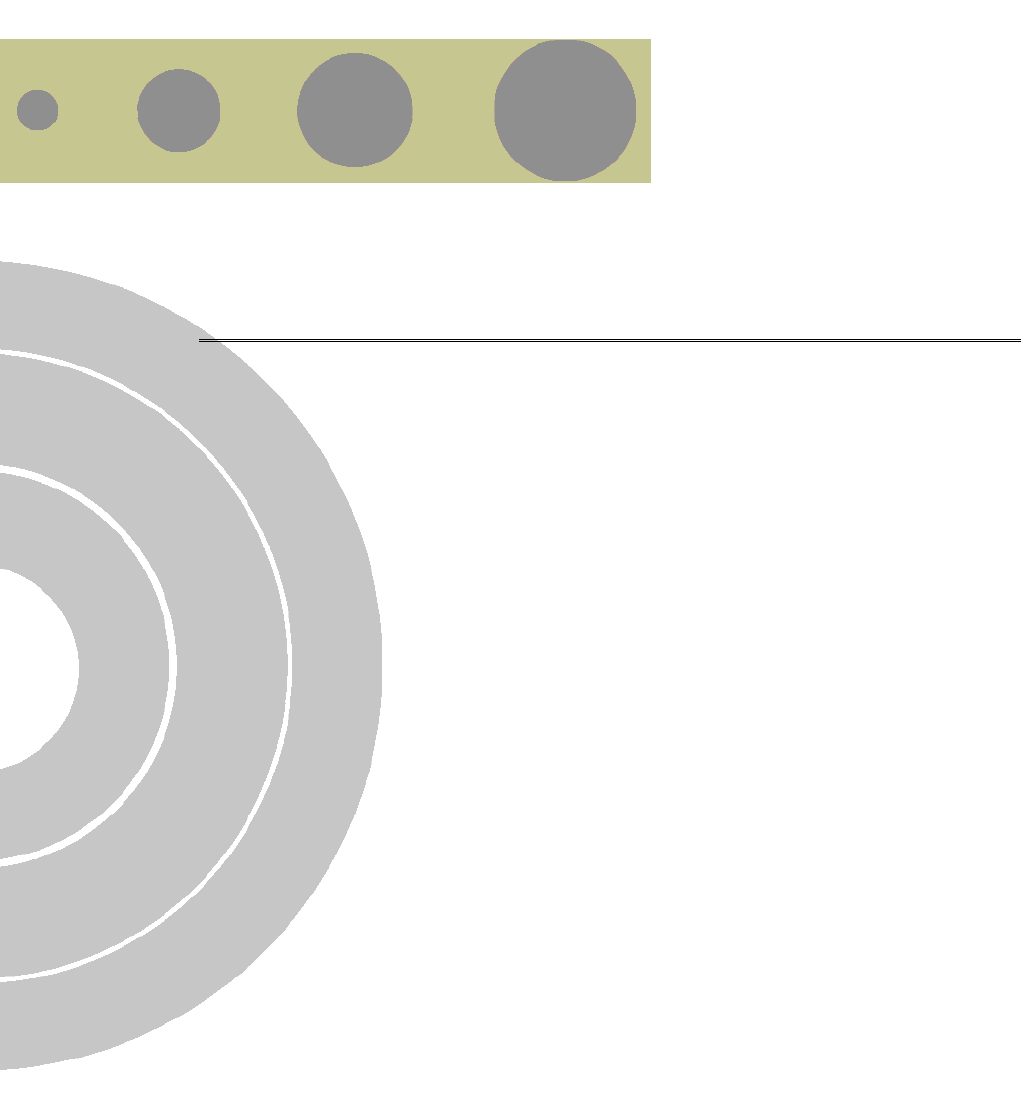
F
F
Appendix F - Parameters Summary
In this Appendix:
! The tables provide an at a glance summary of the configurable
parameters, value ranges, and default values. In addition, each
parameter entry also includes an indication as to whether the
parameter is updated in run-time or whether the unit must be reset
before the modification takes effect.
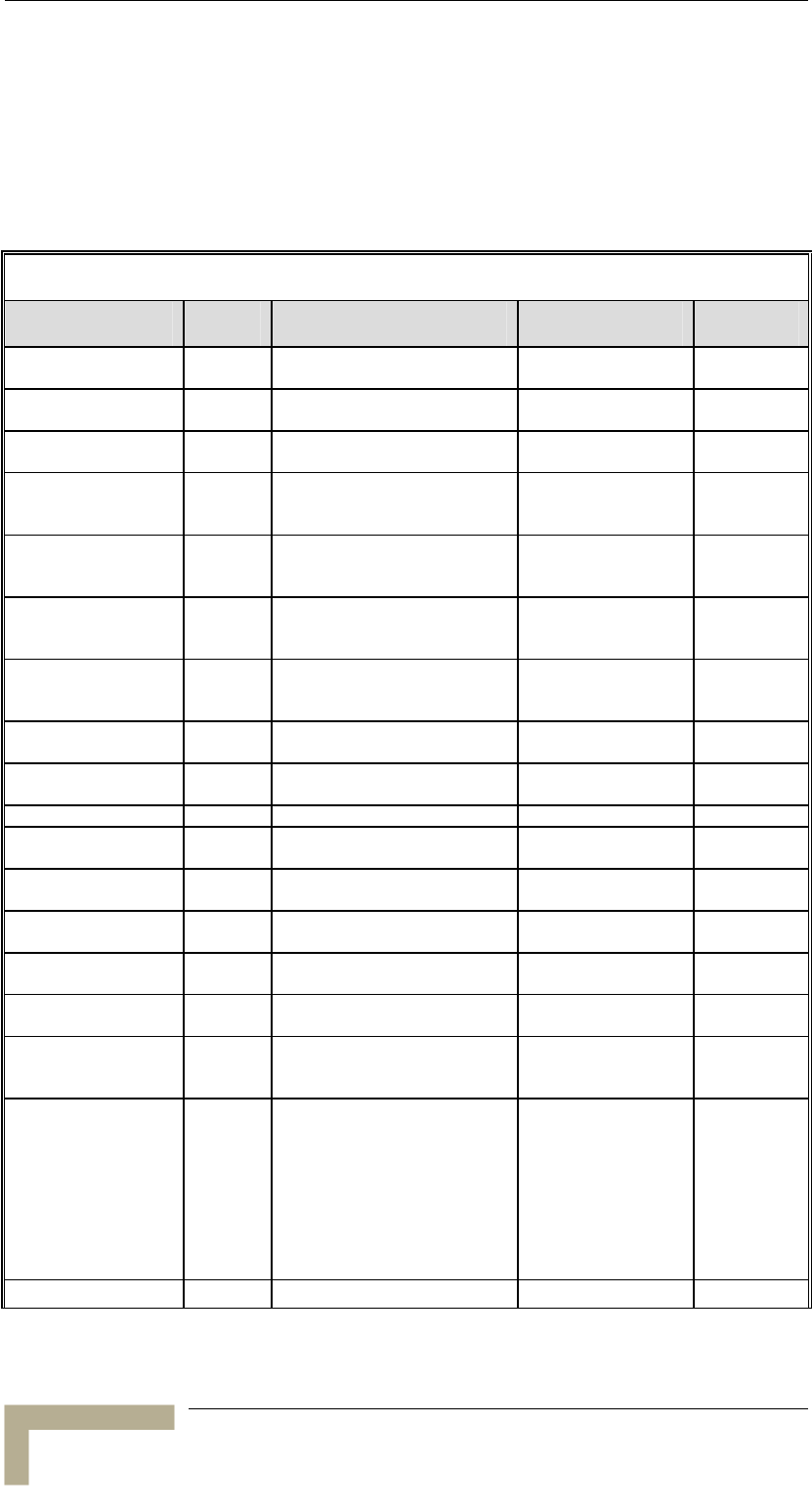
Appendix F - Parameters Summary
BreezeACCESSS VL System Manual
F-2
Parameters Summary
Unit Control Parameters
Table F-1: Unit Control Parameters
Parameter Unit Range Default Run-Time
Change Unit Name AU, SU Up to 32 printable ASCII
characters
None Yes
Change Read Only
Password
AU, SU Up to 8 printable ASCII
characters
public No
Change Installer
Password
AU, SU Up to 8 printable ASCII
characters
user No
Change
Administrator
Password
AU, SU Up to 8 printable ASCII
characters
private No
FTP SW Version
File Name
AU, SU Up to 20 printable ASCII
characters. An empty string
is not allowed.
VxWorks.bz Yes
Configuration File
Name
AU, SU Up to 20 printable ASCII
characters. An empty string
is not allowed.
config.cfg Yes
Operator Defaults
File Name
AU, SU Up to 20 printable ASCII
characters. An empty string
is not allowed.
operator.cmr Yes
FTP Source Dir AU, SU Up to 80 printable ASCII
characters. Use “.” to clear.
None (empty) Yes
FTP Client IP
Address
AU, SU IP address 1.1.1.3 No
FTP Client IP Mask AU, SU IP address 255.255.255.0 No
FTP Server IP
Address
AU, SU IP address 1.1.1.4 No
FTP Gateway IP
Address
AU, SU IP address 0.0.0.0 No
FTP User Name AU, SU Up to 18 printable ASCII
characters
vx No
FTP Password AU, SU Up to 18 printable ASCII
characters
Vx No
FTP Log File Name AU, SU Up to 20 printable ASCII
characters
logfile.log Yes
FTP Log File
Destination
Directory
AU, SU Up to 80 printable ASCII
characters. Use “.” to clear.
None (empty) Yes
Event Log Policy AU, SU ! Message
! Warning
! Error
! Fatal
! Log None
Warning Yes
Log Out Timer AU, SU 1-999 minutes 5 Yes
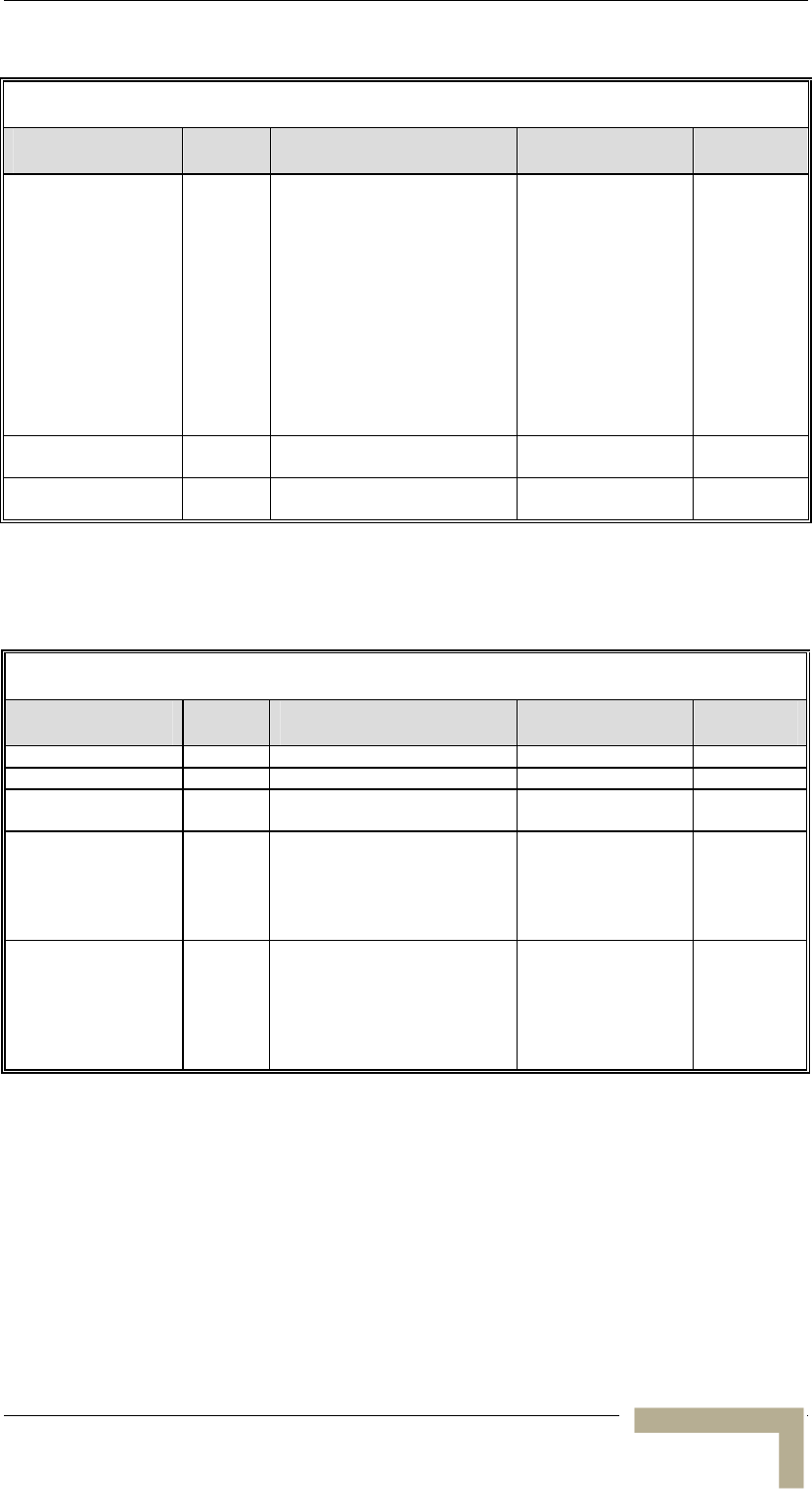
Parameters Summary
Manual Revision 1.0
F-3
Table F-1: Unit Control Parameters
Parameter Unit Range Default Run-Time
Ethernet Port
Negotiation Mode
AU, SU ! Force 10 Mbps and
Half-Duplex
! Force 10 Mbps and
Full-Duplex
! Force 100 Mbps and
Half-Duplex
! Force 100 Mbps and
Full-Duplex
! Auto Negotiation
Auto Negotiation No
Change System
Location
AU, SU Up to 34 printable ASCII
characters
None Yes
Manual Feature
Upgrade
AU, SU License string: 32 to 64
hexadecimal digits
None No
IP Parameters
Table F-2: IP Parameters
Parameter Unit Range Default Run-Time
IP Address AU, SU IP address 10.0.0.1 No
Subnet Mask AU, SU IP address 255.0.0.0 No
Default Gateway
Address
AU, SU IP address 0.0.0.0 No
DHCP Option AU, SU ! Disable
! DHCP Only
! Automatic
Disable No
Access to DHCP AU, SU ! From Wireless Only
! From Ethernet Only
! From Both Wireless and
Ethernet
AU: From Ethernet
Only
SU: From Wireless
Only
No

Appendix F - Parameters Summary
BreezeACCESSS VL System Manual
F-4
Air Interface Parameters
Table F-3: Air Interface Parameters
Parameter Unit Range Default Run-Time
ESSID AU, SU Up to 31 printable ASCII
characters
ESSID1 No
Operator ESSID
Option
AU ! Disable
! Enable
Enable No
Operator ESSID AU Up to 31 printable ASCII
characters
ESSID1 No
Best AU Support SU ! Disable
! Enable
Disable No
Number of
Scanning Attempts
SU 1 – 255 4 No
Preferred AU MAC
Address
SU MAC Address 00-00-00-00-00-00
(no preferred AU)
Yes
Scanning Mode SU Passive, Active Passive No
Cell Distance Mode AU Automatic, Manual Automatic No
Maximum Cell
Distance
AU 0-54 (Km)
0 means no compensation
0 (no
compensation)
Yes
Fairness Factor AU 0 – 100 (%) 100 (%) No
Arbitration Inter-
Frame Spacing
AU, SU ! 1 time slot
! 2 time slots
2 time slots Yes
Wireless Trap
Threshold
AU 1-100 (%) 30 (%) Yes
Maximum Number
of Associations
AU 1 – 512 512 Yes
Sub Band Select* AU, SU According to the Country
Code
1 No
Frequency AU According to the Sub Band The lowest
frequency in the
Sub Band
No
DFS Option** AU ! Disable
! Enable
Dependent on
Country DFS
Support: If DFS is
supported by the
country code then
the default will be
Enable, else it will
be Disable.
No
Frequency Subset
Definition (in AU)**
AU According to the Sub Band. A
list of frequency indexes or A
for all frequencies supported
by the Sub Band
A
No
Frequency Subset
Definition (in SU)
SU According to the Sub Band. A
list of frequency indexes or A
for all frequencies supported
by the Sub Band
A (All)
No

Parameters Summary
Manual Revision 1.0
F-5
Table F-3: Air Interface Parameters
Parameter Unit Range Default Run-Time
Channel Check
Time**
AU 1 – 3600 (seconds) 60 (seconds) No
Channel Avoidance
Period**
AU 1 – 60 (minutes) 30 (minutes) No
SU Waiting
Option**
AU ! Disable
! Enable
Enable No
Minimum Pulses to
Detect**
AU 1-100 6 No
Clear radar
Detected Channels
After Reset**
AU ! Disable
! Enable
Disable Yes
Country Code
Learning by SU
AU ! Disable
! Enable
Enable Yes
Tx Power For
Modulation Levels
1 to 5
AU, SU -10 dBm to a value
determined by the HW,
Country Code and other
parameters
The highest
allowed value
Yes
Tx Power For
Modulation Level 6
AU, SU -10 dBm to a value
determined by the HW,
Country Code and other
parameters
The highest
allowed value
Yes
Tx Power For
Modulation Level 7
AU, SU -10 dBm to a value
determined by the HW,
Country Code and other
parameters
The highest
allowed value
Yes
Tx Power For
Modulation Level 8
(HW rev. B only)
AU, SU -10 dBm to a value
determined by the HW,
Country Code and other
parameters
The highest
allowed value
Yes
Max Tx Power For
Modulation Levels
1 to 5
SU -10 dBm to a value
determined by the HW,
Country Code and other
parameters
The highest
allowed value
Yes
Max Tx Power For
Modulation Level 6
SU -10 dBm to a value
determined by the HW,
Country Code and other
parameters
The highest
allowed value
Yes
Max Tx Power For
Modulation Level 7
SU -10 dBm to a value
determined by the HW,
Country Code and other
parameters
The highest
allowed value
Yes
Max Tx Power For
Modulation Level 8
(HW rev. B only)
SU -10 dBm to a value
determined by the HW,
Country Code and other
parameters
The highest
allowed value
Yes
ATPC Option AU, SU ! Disable
! Enable
Enable Yes
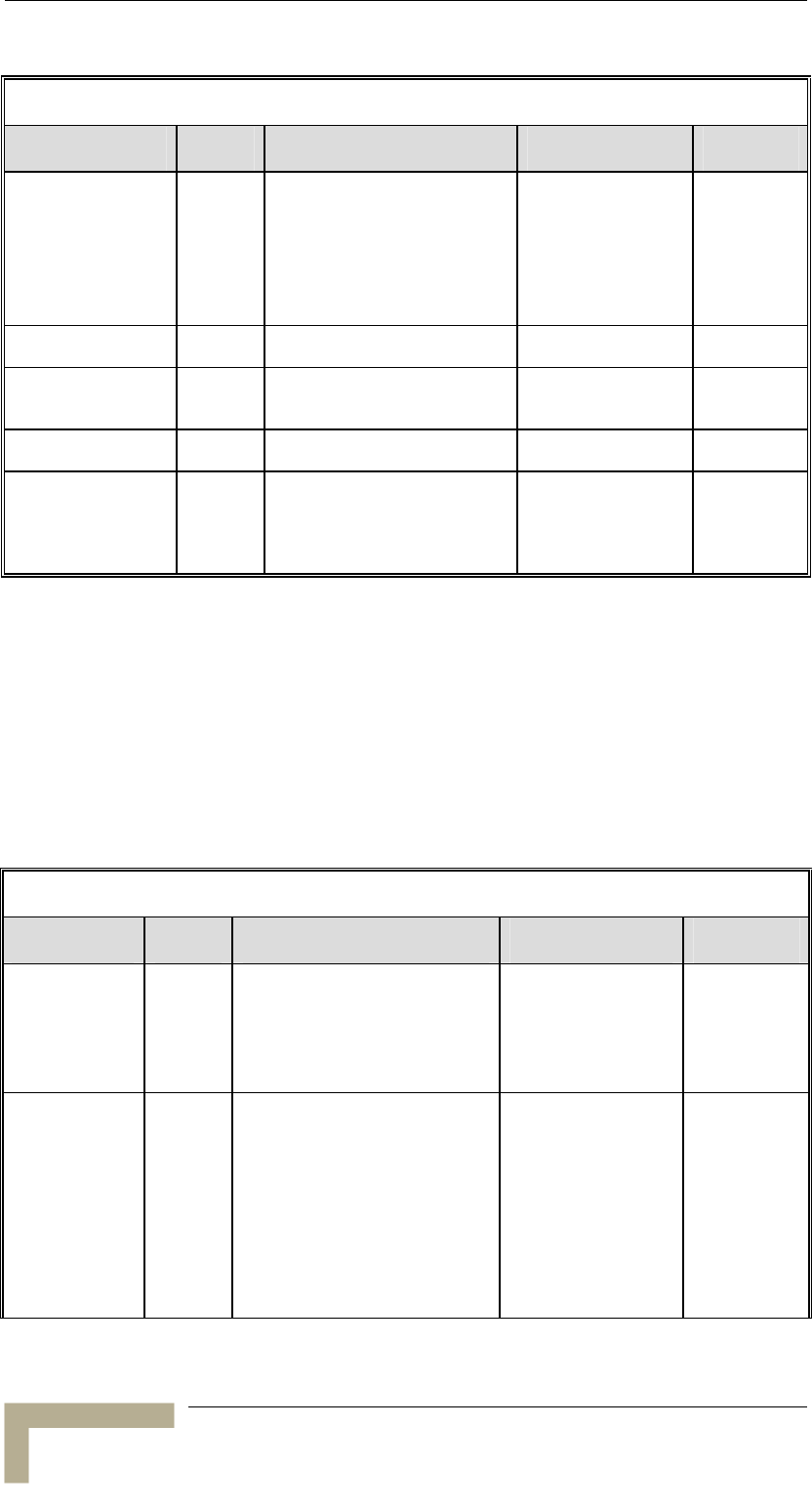
Appendix F - Parameters Summary
BreezeACCESSS VL System Manual
F-6
Table F-3: Air Interface Parameters
Parameter Unit Range Default Run-Time
Delta from
Minimum SNR
Level
AU ! Units in 5.2, 5.4, 5.8 GHz
bands: 4-20 (dB)
! Units in 4.9, 5.3 GHz
bands: 11-20 (dB)
! Units in 5.2,
5.4, 5.8 GHz
bands: 4 (dB)
! Units in 4.9,
5.3 GHz
bands: 11(dB)
Yes
Minimum SNR
Level
AU 4-60 (dB) 28 (dB) Yes
Minimum Interval
Between ATPC
Messages
AU 1-3600 (seconds) 30 (seconds) Yes
ATPC Power Level
Steps
AU 1-20 (dB) 4 Yes
Antenna Gain AU,
SU***
0 – 50 (dB) AU: According to
the antenna
supplied with the
unit.
SU: NA
No
* Not applicable if only one Sub Band is available for the applicable
Country Code
** Applicable only if DFS is supported by the Sub Band
*** Configurable only in units without an integral antenna.
Network Management Parameters
Table F-4: Network Management Parameters
Parameter Unit Range Default Run-Time
Access to
Network
Management
AU, SU ! From Wireless Link Only
! From Ethernet Only
! From Both Ethernet and
Wireless Link
From Both Ethernet
and Wireless Link
No
Network
Management
Filtering
AU, SU ! Disable
! Activate Management IP
Filter On Ethernet Port
! Activate Management IP
Filter On Wireless Port
! Activate Management IP
Filter On Both Ethernet
and Wireless Ports
Disable No

Parameters Summary
Manual Revision 1.0
F-7
Table F-4: Network Management Parameters
Parameter Unit Range Default Run-Time
Set Network
Management
IP Address
AU, SU IP address 0.0.0.0
(all 10 entries)
No
Send SNMP
Traps
AU, SU ! Disable
! Enable
Disable Yes
SNPM Traps
IP Destination
AU, SU IP address 0.0.0.0
(all 10 entries)
No
SNMP Traps
Community
AU, SU Up to 14 printable ASCII
characters
public
(all 10 entries)
No

Appendix F - Parameters Summary
BreezeACCESSS VL System Manual
F-8
Bridge Parameters
Table F-5: Bridge Parameters
Parameter Unit Range Default Run-Time
VLAN ID-Data SU 1 – 4094 1 No
VLAN ID –
Management
AU, SU 1 – 4094, 65535 65535 (no VLAN) No
VLAN Link
Type
AU, SU ! Hybrid Link
! Trunk Link
! Access Link (only in SU)
Hybrid Link No
VLAN
Forwarding
Support
AU, SU Disable, Enable Disable No
VLAN
Forwarding ID
AU, SU 1 – 4094
(up to 20 entries)
Empty list No
VLAN Relaying
Support
AU Disable, Enable Disable No
VLAN Relaying
ID
AU 1 – 4094
(up to 20 entries)
Empty list No
VLAN Priority –
Data
SU 0 – 7 0 No
VLAN Priority –
Management
AU, SU 0 – 7 0 No
VLAN Priority
Threshold
AU, SU 0 – 7 3 Yes
ToS
Precedence
Threshold
AU, SU 0 – 7 3 Yes
Ethernet
Broadcast
Filtering
Options
SU ! Disable,
! On Ethernet Port Only
! On Wireless Port Only
! On Both Wireless and
Ethernet Ports
Disable Yes
DHCP
Broadcast
Override Filter
SU ! Disable
! Enable
Disable Yes
PPPoE
Broadcast
Override Filter
SU ! Disable
! Enable
Disable Yes
ARP Broadcast
Override Filter
SU ! Disable
! Enable
Enable Yes
Bridge Aging
Time
AU, SU 20 – 2000 seconds 300 No
Broadcast
Relaying
AU Disable, Enable Enable No
Unicast
Relaying
AU ! Disable
! Enable
Enable No

Parameters Summary
Manual Revision 1.0
F-9
Table F-5: Bridge Parameters
Parameter Unit Range Default Run-Time
MAC Address
Deny List
AU Up to 100 MAC addresses None (empty) Yes
Roaming
Option
SU ! Disable
! Enable
Disable No
Performance Parameters
Table F-6: Performance Parameters
Parameter Unit Range Default Run-Time
RTS Threshold AU, SU 20 – 1600 (bytes) AU: 1600
SU: 60
Yes
Minimum
Contention
Window
AU, SU 0, 7, 15, 31, 63, 127, 255,
511, 1023
15 Yes
Maximum
Contention
Window
AU, SU 7, 15, 31, 63, 127, 255, 511,
1023
1023 Yes
Maximum
Modulation Level
AU, SU According to the Min/Max
Modulation Level defined for
the Sub Band
The highest available
value
Yes
Multicast
Modulation Level
AU According to the Min/Max
Modulation Level defined for
the Sub Band
The lowest available
value
Yes
Number of HW
Retries
AU, SU 1 - 15 10 Yes
Average SNR
Memory Factor
AU, SU -1 to 32 5 Yes
Burst Mode
Option*
AU, SU ! Disable
! Enable
Enable No
Burst Mode Time
Interval*
AU, SU 1 to the value defined in the
Sub Band for Maximum
Burst Duration (milliseconds)
5 milliseconds or the
value of Maximum
Burst Duration
defined for the Sub
Band (the lower of the
two values).
Yes
Adaptive
Modulation
Option
AU, SU ! Disable
! Enable
Enable No
Minimum Interval
Between
Adaptive
Modulation
Messages
AU, SU 1-3600 (seconds) 4 (seconds) Yes
* Applicable only if Burst Mode is supported by the Sub Band.
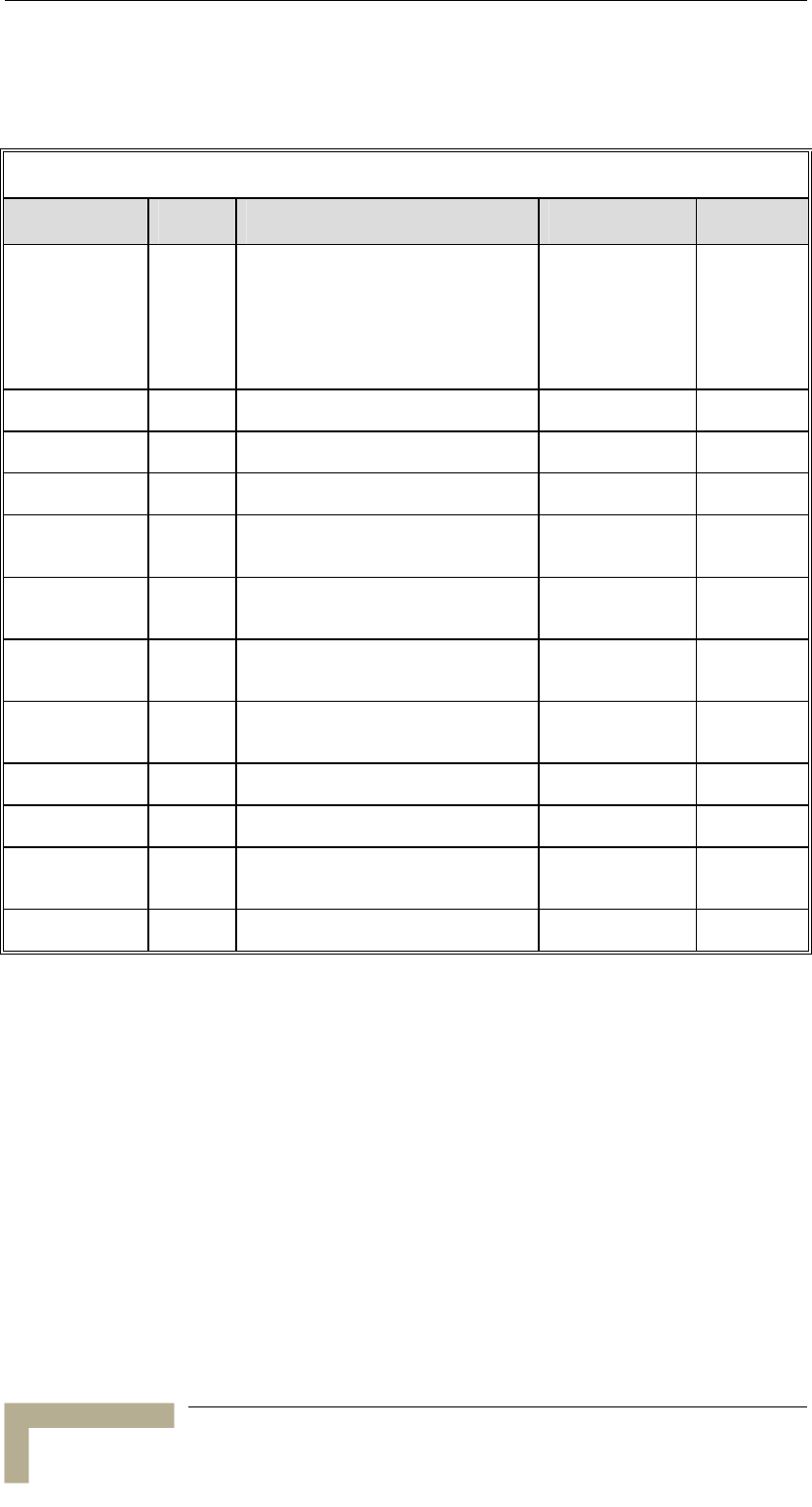
Appendix F - Parameters Summary
BreezeACCESSS VL System Manual
F-10
Service Parameters
Table F-7: Service Parameters
Parameter Unit Range Default Run-Time
User Filtering
Option
SU ! Disable
! IP Protocol Only
! User Defined Addresses Only
! PPPoE Protocol Only
Disable Yes
Set User Filter
Address
SU IP address (8 entries) 0.0.0.0
(all 8 entries)
Yes
Set User Filter
Mask
SU IP address (8 entries) 255.255.255.255
(all 8 entries)
Yes
Set User Filter
Range
SU 0 – 255. 0 means that the range is
not used.
0
(all 8 entries)
Yes
MIR: Downlink SU SU-3: 128-2048 (Kbps)
SU-6: 128-3968 (Kbps)
SU-54: 128-32896 (Kbps)
SU-3: 2048
SU-6: 3968
SU-54: 32896
No
MIR: Uplink SU SU-3: 128-2048 (Kbps)
SU-6: 128-3968 (Kbps)
SU-54: 128-32896 (Kbps)
SU-3: 2048
SU-6: 3968
SU-54: 32896
No
CIR: Downlink SU SU-3: 0-2048 (Kbps)
SU-6: 0-3968 (Kbps)
SU-54: 0-32896 (Kbps)
0 (Kbps No
CIR: Uplink SU SU-3: 0-2048 (Kbps)
SU-6: 0-3968 (Kbps)
SU-54: 0-32896 (Kbps)
0 (Kbps) No
Maximum
Delay
SU 300 – 10,000 (ms) 5,000 (ms) No
Maximum Burst
Duration
AU, SU 0 – 2,000 (ms) 5 (ms) No
Graceful
Degradation
Limit
AU 0 – 70 (%) 70 (%) No
MIR Only
Option
AU Disable, Enable Enable No

Parameters Summary
Manual Revision 1.0
F-11
Security Parameters
Table F-8: Security Parameters
Parameter Unit Range Default Run-Time
Authentication
Algorithm*
AU, SU ! Open system
! Shared Key
Open system No
Data Encryption
Option*
AU, SU ! Disable
! Enable
Disable No
Security Mode* AU, SU ! WEP
! AES
WEP No
Default Key SU 1-4 1 No
Default
Multicast Key
AU 1-4 1 No
Key # 1 to Key
# 4
AU, SU 32 hexadecimal digits 0…0 (all 0=no
key)
No
Promiscuous
Authentication
AU ! Disable
! Enable
Disable Yes
(Disable
after reset)
* Applicable only if supported by the Sub Band.

Appendix F - Parameters Summary
BreezeACCESSS VL System Manual
F-12
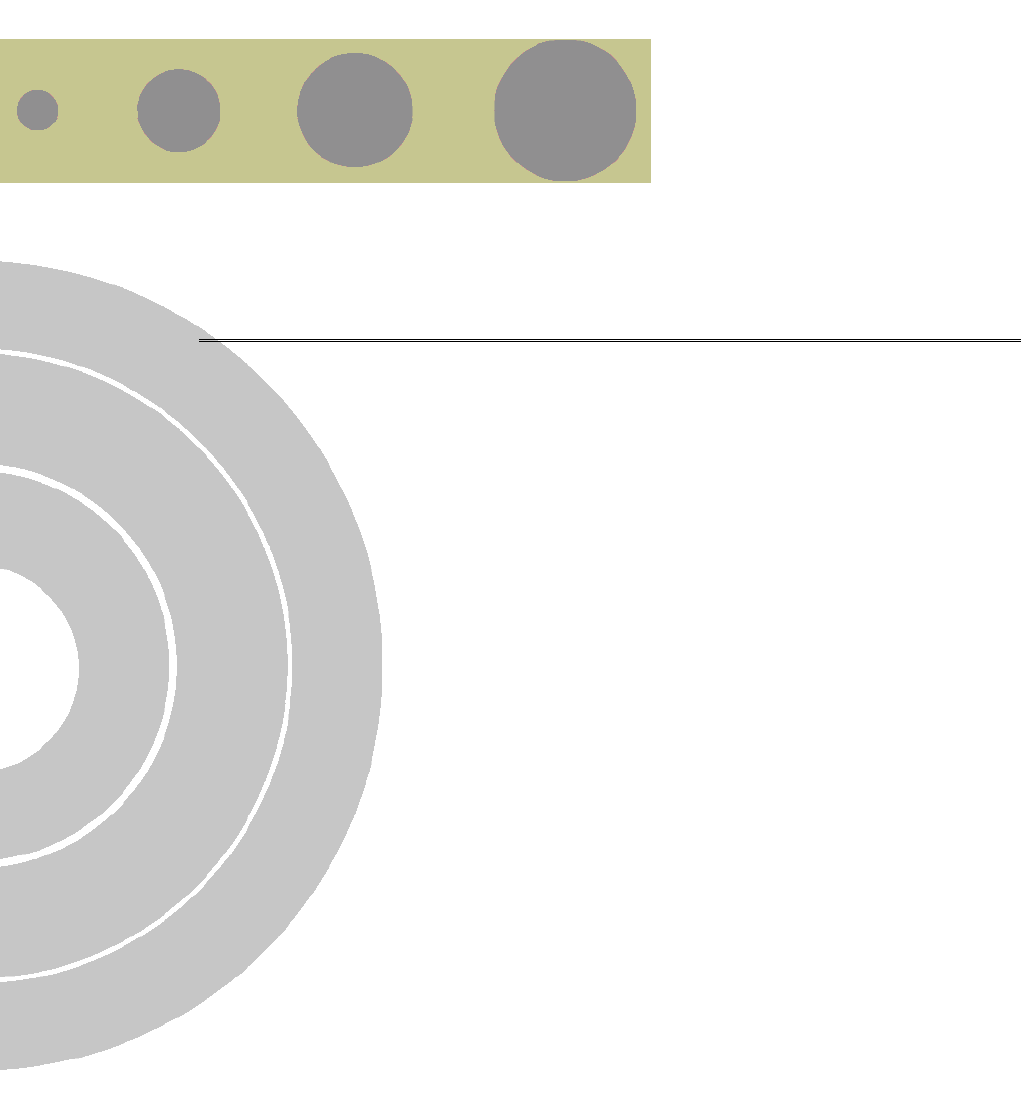
G
G
Appendix G - Using the Feature
License Web Application
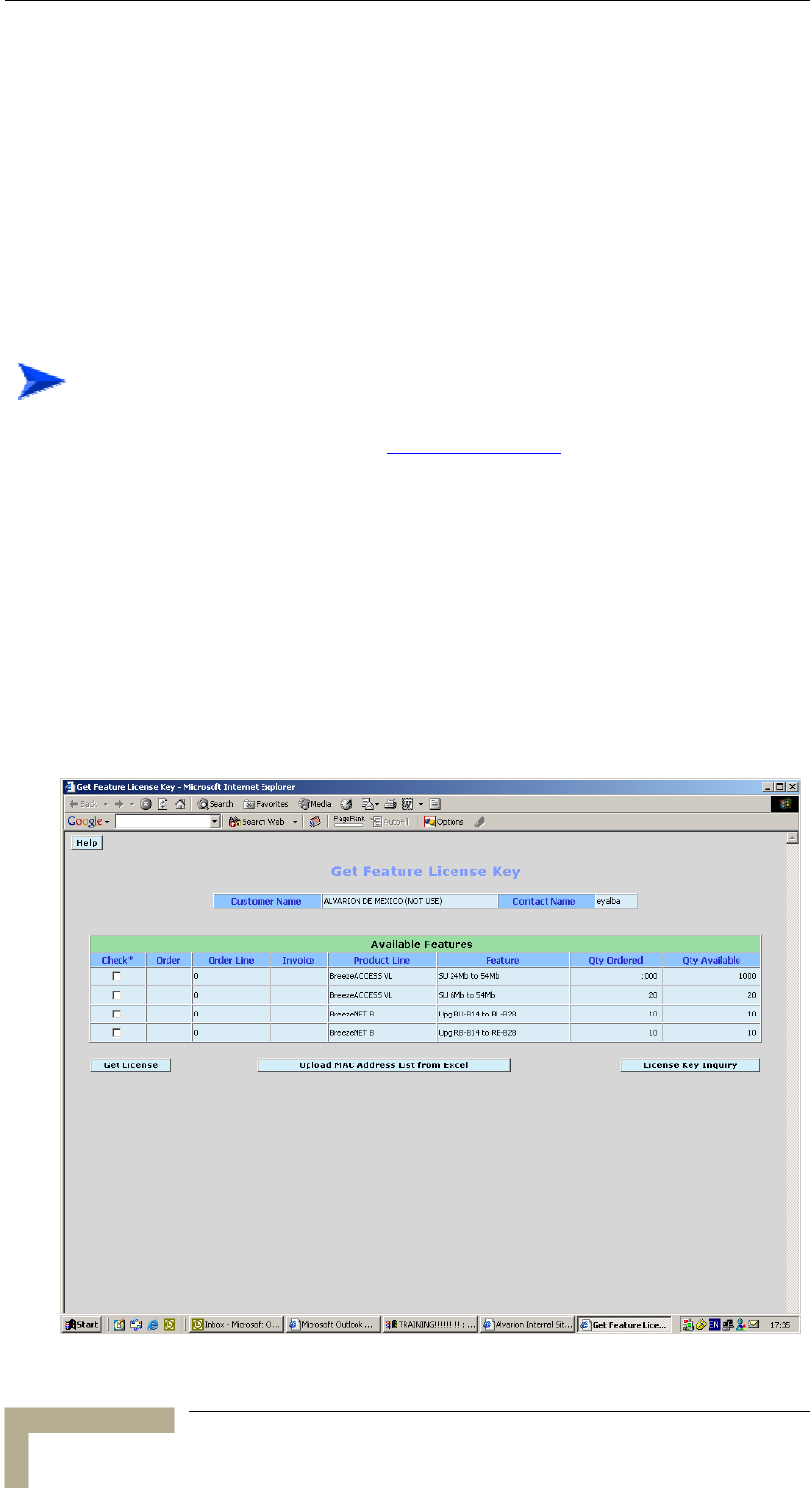
Appendix G - Using the Feature License Web Application
BreezeACCESSS VL System Manual
G-2
The Feature License Web
Application
Certain features of BreezeACCESS VL products may be upgraded
through loading special feature license strings. Once you receive the
invoice for new license(s) purchased, use the Alvarion web site for
getting license strings for specific products.
1. In the Alvarion web site (www.alvarion.com), select the Customer
Service option.
2. In the Customer Service page, select the Service Call Entry option.
3. In the User Login form, enter your User ID and Password and click
Login.
4. Select SSM - Customer Service Area.
5. Select the Feature License option.
The Get Feature License Key form with the current status of your
license(s) is displayed:
To access the Feature License Application:
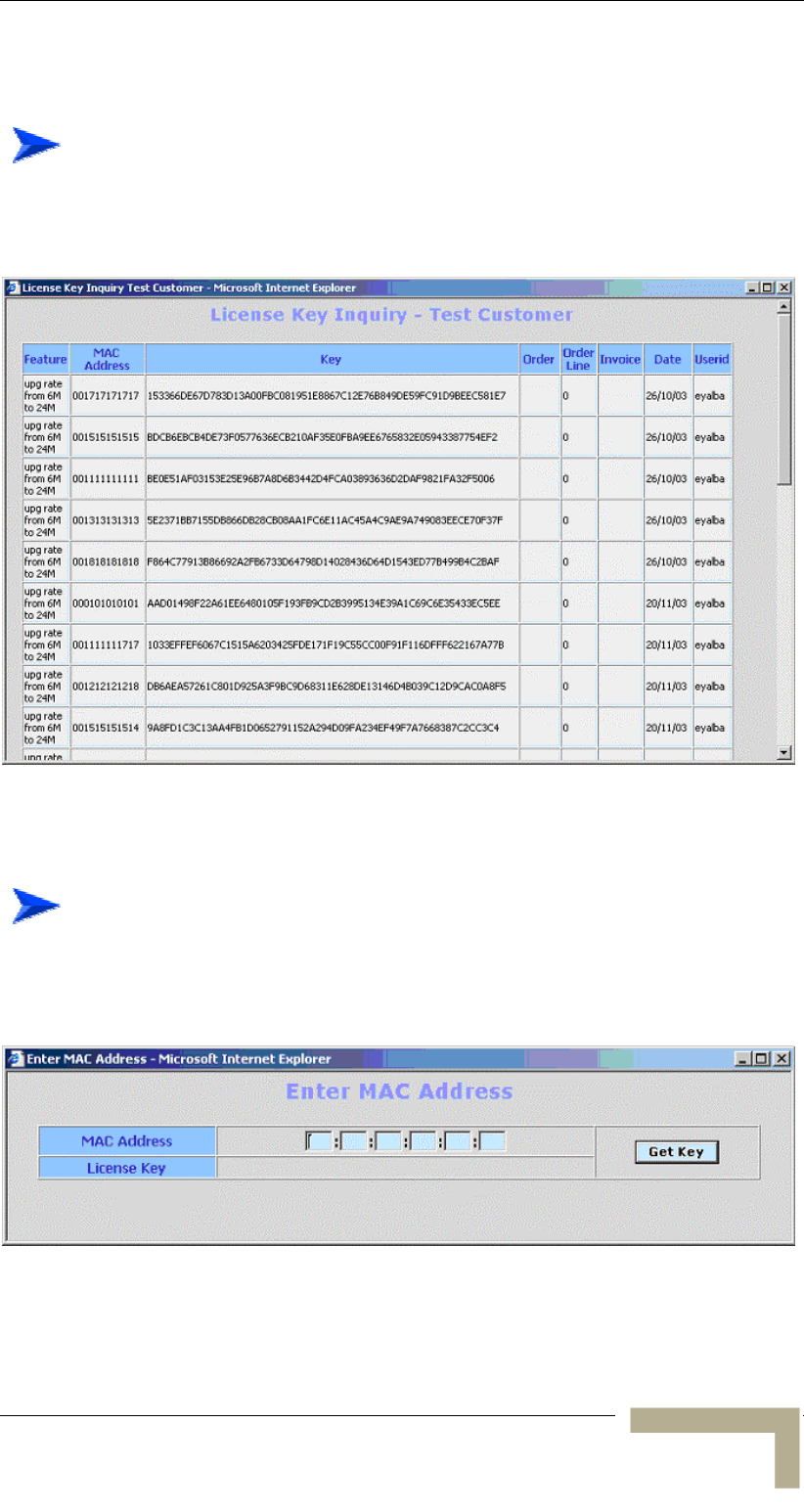
The Feature License Web Application
Manual Revision 1.0
G-3
Check on the License Key Enquiry button to get the updated status of
the licenses:
The displayed information includes account history with details on all
license strings that were provided.
1. Check the required feature license entry and click on the Get Key
button. The Enter MAC Address form will be displayed:
2. Enter the MAC Address of the device you want to upgrade.
3. Click on the Get Key button. The License Key for the device will be
displayed.
To get details on the updated status of your licenses:
To get a License Key for a single device:
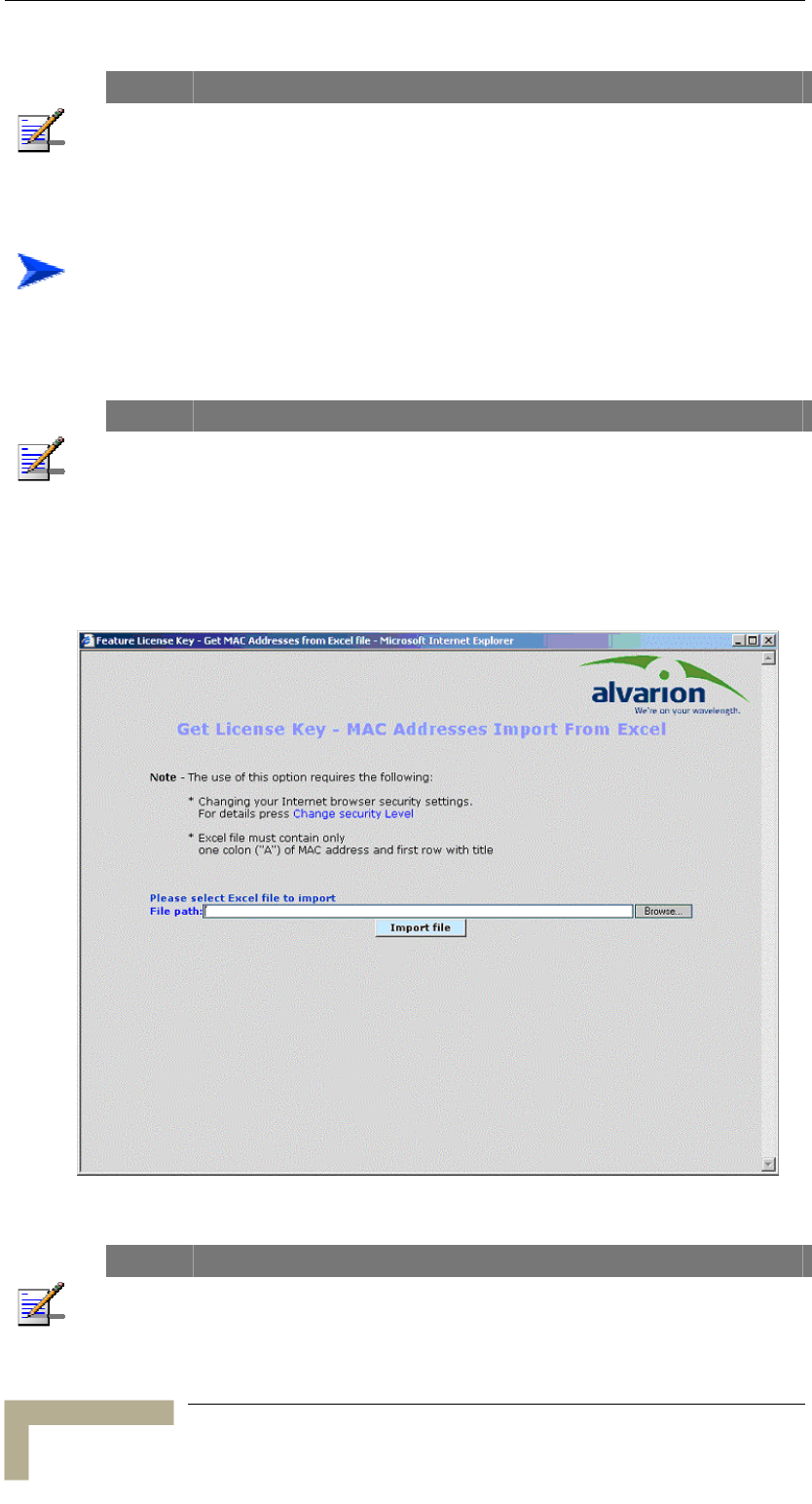
Appendix G - Using the Feature License Web Application
BreezeACCESSS VL System Manual
G-4
NOTE
An error message will be displayed upon requesting a key for a non-valid MAC address.
This feature enables you to load a list of MAC Addresses from a pre-
prepared Excel file.
NOTE
The Excel file should contain a single column of MAC addresses (no empty cells). This
must be column A, starting at row 1, which is the title row.
1. Check the required feature license and click on Upload MAC
Address List from Excel button. The Get MAC Addresses from Excel
File form will be displayed:
NOTE
You may need to change your Browser security settings. For details press the Change
Security Level link in the form.
To get License Keys for multiple devices:
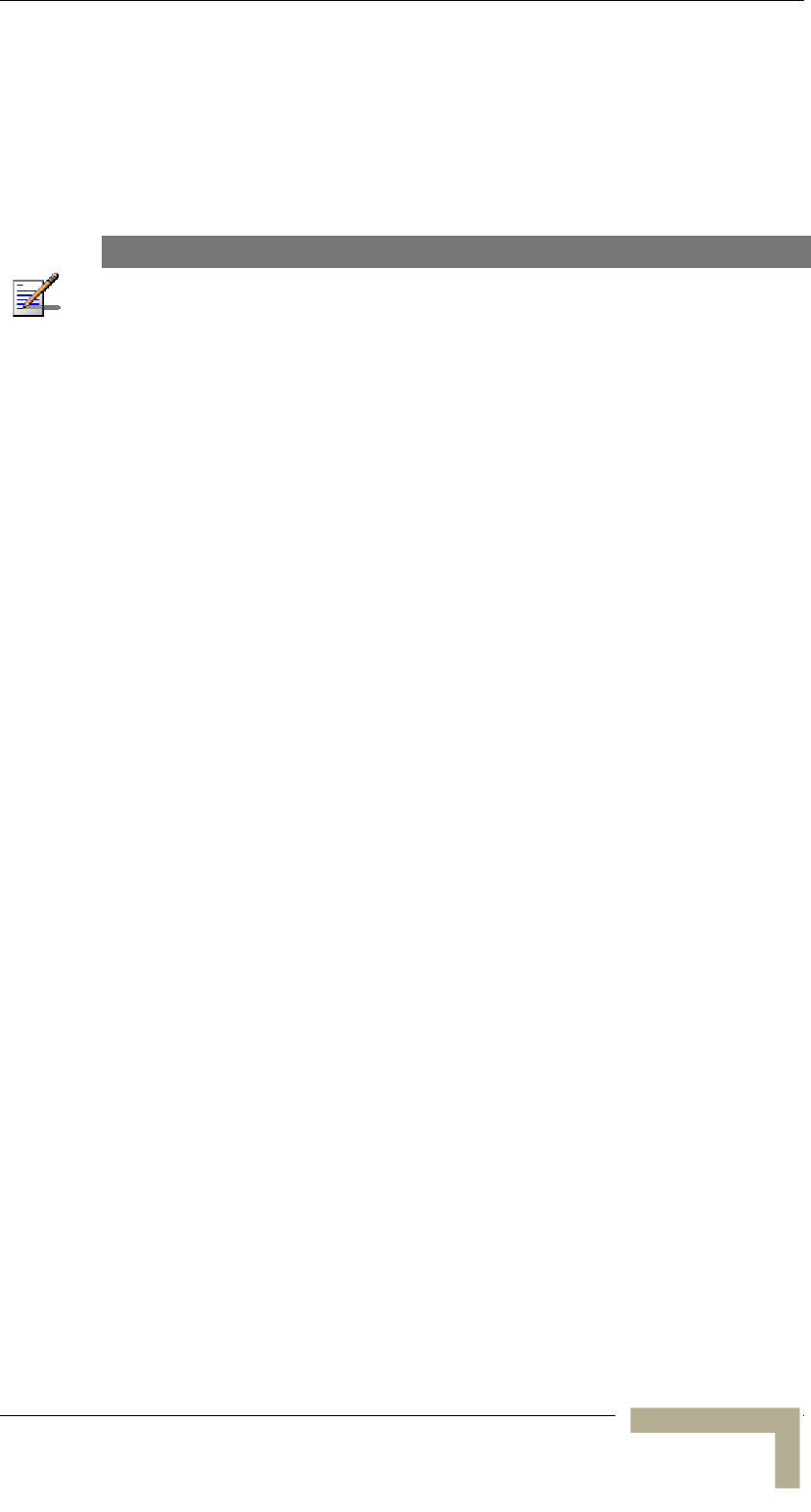
The Feature License Web Application
Manual Revision 1.0
G-5
2. Use the browser or enter the path to the Excel file holding the MAC
Addresses. Enter the MAC Address of the device you want to
upgrade.
3. Click on the Import File button to get a list of License Keys for the
devices included in the Excel file.
NOTE
An error message will be displayed upon requesting a key for a non-valid MAC address.
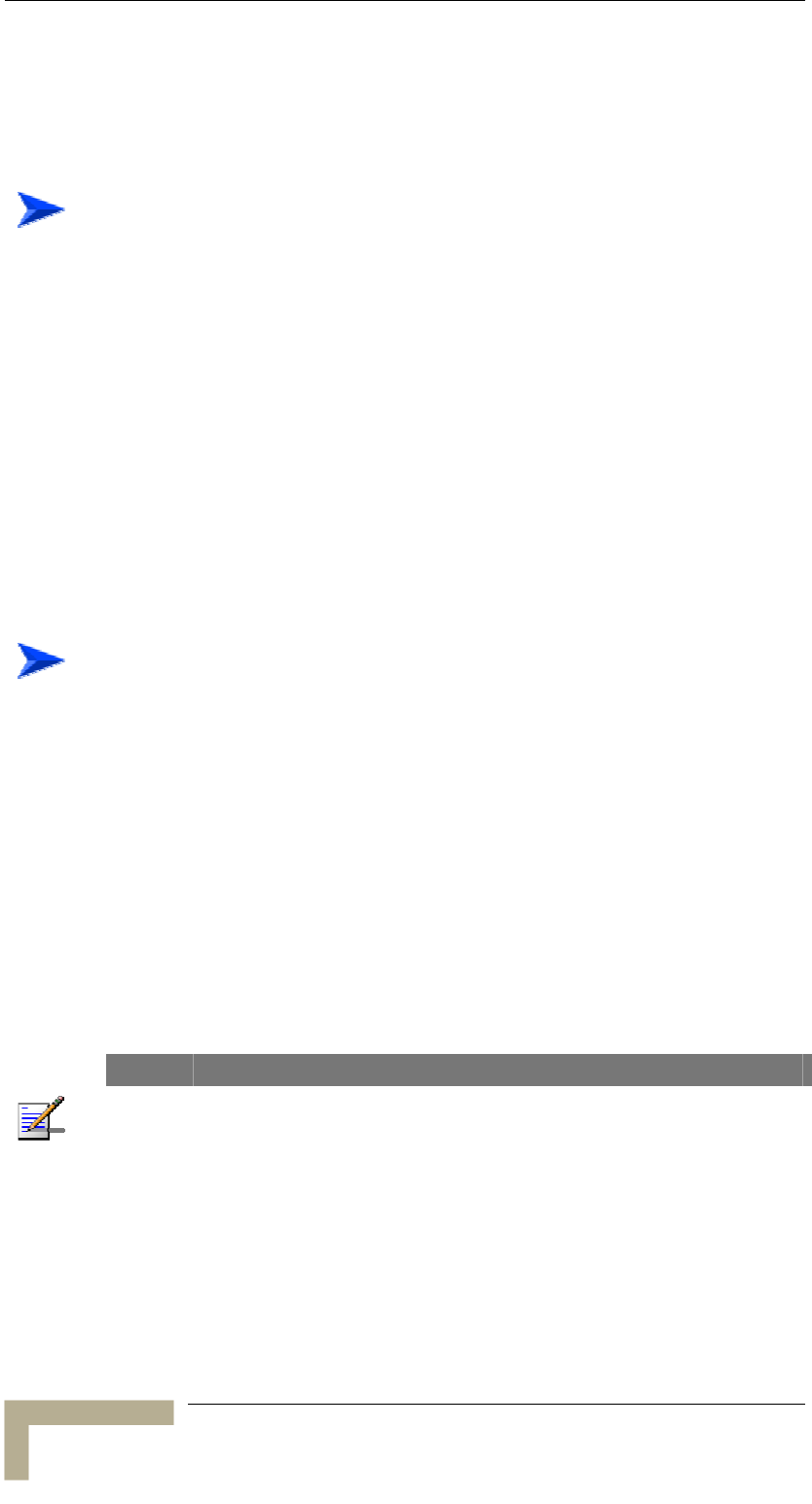
Appendix G - Using the Feature License Web Application
BreezeACCESSS VL System Manual
G-6
Loading License Strings to Devices
There are several options to load a feature license string to a single
device:
! Using Telnet: Use the Feature Upgrade option in the Unit Control
menu.
! Using TFTP: Use the file with the extension “.fln” for feature license
strings. Refer to Appendix B (File Upload and Download Using TFTP)
for more details.
! Using BreezeCONFIG: Enter the license string in the Feature
Upgrade field of the Unit Control window. Refer to the
BreezeCONFIG User’s Guide for more details.
! Using TFTP: Use the file with the extension “.fln” for feature license
strings. Refer to Appendix B (File Upload and Download Using TFTP)
for more details. Note that Feature license files include multiple
strings, where each string is applicable only for a certain unit
identified by its MAC address. When uploading a feature license or a
country code file to multiple units, each unit will accept only the
parts that are applicable for it.
! Using BreezeCONFIG: Use the File Loading Utility. Refer to the
BreezeCONFIG User’s Guide for more details.
NOTE
After completing the license string loading process, reset the unit(s) to apply the change.
Use the Info Screens menu (Show Unit Status) to verify that the unit has been
upgraded.
To upgrade a single device:
To upgrade multiple devices using a feature licenses file: